

25 Things to Know Before You Visit Iran
- Last Updated: February 6, 2024
We’ve been all around the world, spent a lot of time in a lot of different countries, and if there’s one thing we can honestly tell you it’s that we’ve never felt as welcomed, fascinated and humbled as we did when we visited Iran.
Iran is such an incredible country to travel. The architecture will amaze you, the friendliness of the people will leave you speechless, the culture is fascinating and the landscapes are out of this world.
Iran is also very misunderstood, with many people believing whatever propaganda they hear on the media about how dangerous or difficult it is to travel there.
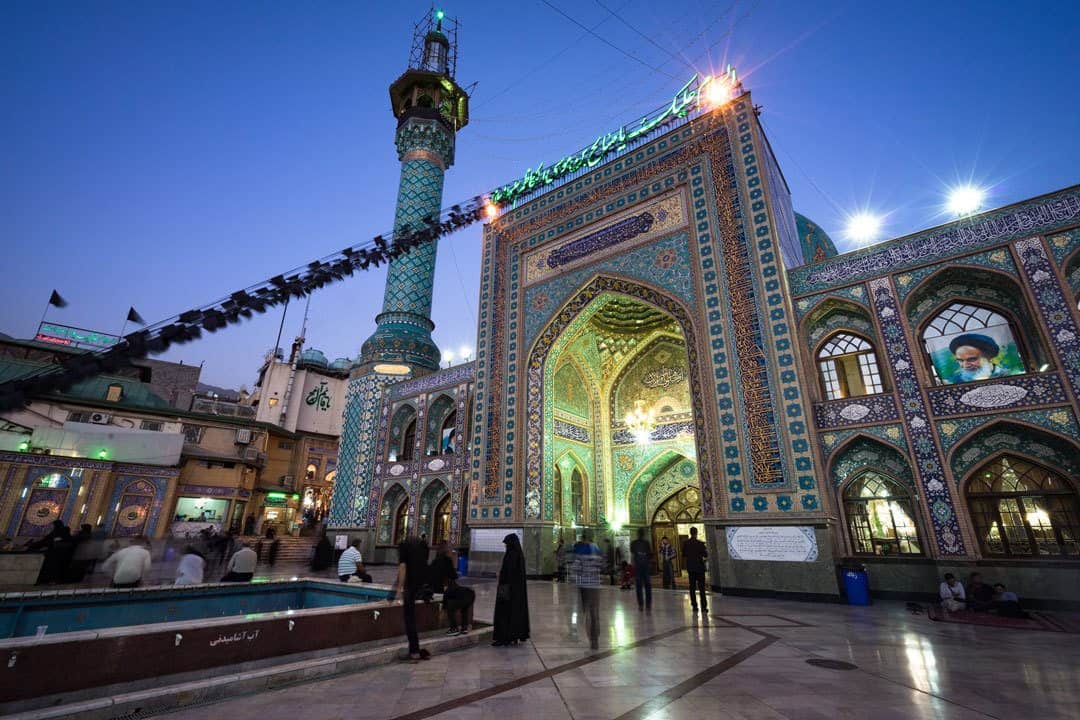
Table of Contents
Iran is Safe!
There’s a lot of customs to follow, you need a visa for iran, have a head scarf in your carry-on luggage before arrival, bring a phrase book or have google translate on your phone, bring a lot of cash, the currency has two names, bring comfortable footwear, research the food and don’t just eat kebabs, bring a backpack rather than a suitcase, draw up an itinerary, but keep it flexible, let your guard down and talk to locals, always ask the price before buying, book domestic flights with your accommodation or travel agent, team up with other travellers and share tours, be on time for your appointments, the traffic is horrible, you need a vpn to access some social media platforms, there is wifi, but be patient with it, pick up a local sim card, iran has its own uber called snapp, you can drink the tap water, good coffee is hard to find, there’s a female-only carriage on the metros, what to know before you visit iran.
The truth is travelling in Iran definitely has its quirks, and being an Islamic country means there’s a few things you need to know about the religion and culture before you go so you can show absolute respect.
Luckily these are easy enough to know before you go if you do a bit of research. We spent one month travelling around Iran and learnt so much during our time there.
To help put your mind at ease about travelling in this incredible country, here’s our list of the most important things to know before you visit Iran.
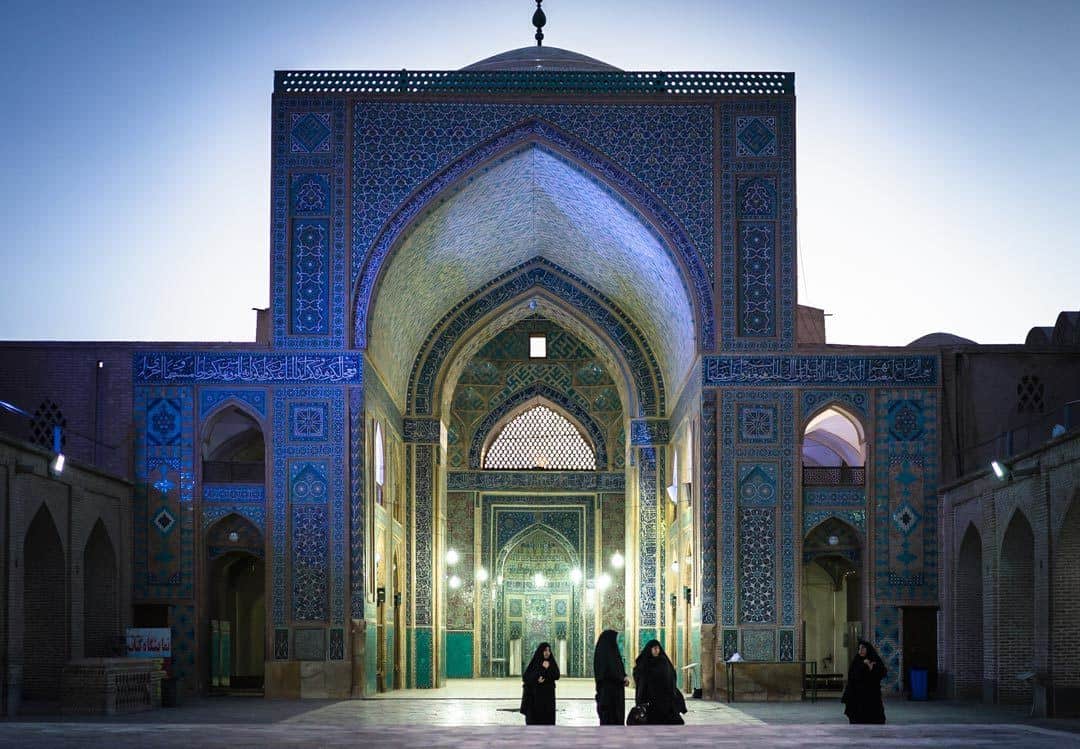
All of the mainstream media outlets portray Iran as an unsafe country, somewhere that you’ll be at risk if you visit.
The mainstream media is wrong.
We did not feel unsafe once through the whole 4 weeks of us backpacking independently in Iran.
We weren’t with a tour group, had no tour guides, don’t speak the local language, took public transport and taxis, wandered the streets on our own – basically everything you shouldn’t do if you’re in a dangerous country.
And guess what? Nothing bad happened to us at all!
The Iranian people are so friendly and helpful. They want you to have a great time and tell your friends so more people will come and visit.
We were walking around one morning on a quiet street when a car passed us and turned around. A group of young people stopped the car, came up to us, and asked if we were ok or if we needed help.
Once we told them we were just looking for a coffee they pulled out their phones and started showing us where the cafes were on a map.
They even offered us a ride, and said if the cafes were closed they had coffee at their home and would love to make us some.
This is just one example of dozens of interactions that happened to us when we were in Iran. Iranians love that tourists are coming to their country and travelling around.
The locals know what the media says about them and what a lot of the world thinks of their country, and the people just want to show that they are nice, generous people.
Theft against tourists is very rare and even the Religion Police (secret police) tend to leave tourists alone.
Just be careful around the bazaars and crowed places for pickpocketing. We didn’t have any issue and didn’t hear of any other travellers having problems, but this is common sense in any busy place in the world.
With all that being said, there is a large military and police presence in Iran. Do not photograph any military areas or government buildings, and stay away from any protests if you see them.
Obviously there are some areas of Iran that are no-go zones, such as the borders of Afghanistan, Pakistan and Iraq, so do your research and talk to locals if you’re thinking about going anywhere near them.
When you travel somewhere you want to take in everything about the country and its people, and that includes the culture and customs.
Iran has quite a few local customs that may take some getting used to, so it’s important to learn about them before you go so you don’t accidentally offend or disrespect anyone.
Some of the most common ones that throw tourists off are:
- Women must wear hijabs (headscarves) at all times in public. They must also wear loose-fitting clothes that don’t show their figure.
- Giving a thumbs-up sign is considered rude, similar to giving the middle finger in Western society.
- Men can wear short-sleeved shirts, but long pants must be worn at all times.
- Men and women who aren’t related shouldn’t touch either. That means no shaking hands or hugging someone of the opposite sex.
- If you are travelling with your significant other, avoid any public displays of affection.
- Always bring a gift if you are invited to someone’s house. Candy, pastries or flowers are fine.
Now we want to give a special mention to ta’arof – This is a hospitality trait where it’s customary for someone to refuse payment for a service, and is probably the most confusing thing for any tourist to get their head around.
Basically what happens is if you make a purchase (a souvenir, taxi ride, etc), the person may refuse your payment out of politeness. It is then up to you to insist despite their refusals that you want to pay. After two or three times they’ll then accept your money.
If they still keep refusing then perhaps you have just experienced some amazing Iranian hospitality! But chances are they’ll accept the payment once the process has been completed. Don’t worry, you’ll get the hang of it.
The locals are so lovely, that if you do something wrong someone will approach you and nicely let you know. For example, if you are a lady and your headscarf falls off without you knowing, a local will kindly let you know.
Don’t stress about getting your outfits beforehand as shopping in Iran is cheap. Just bring one headscarf and set of loose-fitting clothes, and buy more once you get there.
The culture is the best thing about visiting Iran, and after a few days, you’ll start to understand and fall in love with it just like we did.
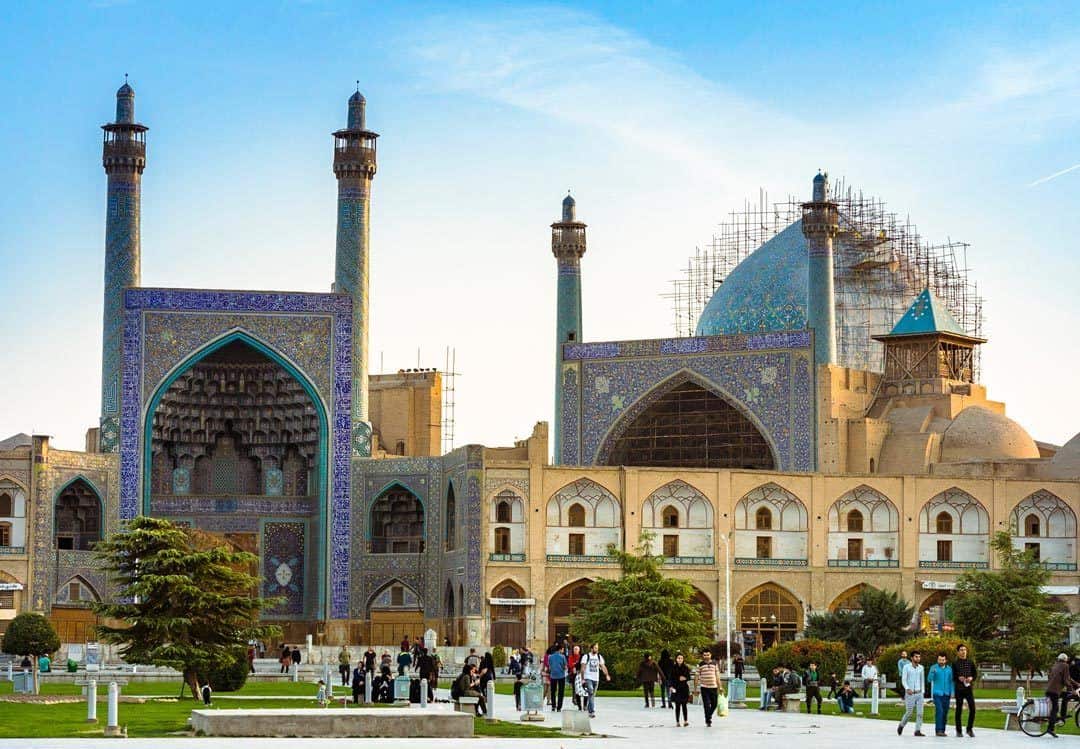
In order to visit Iran, you’re going to need to get a tourist visa. This used to be a very difficult process, but luckily things have gotten easier with the introduction of visa on arrivals in 2016
On the 14th February 2016, the Ministry of Iran announced that citizens of 180 countries can now apply for VOA of 30-days at most international airports, including Tehran, Shiraz, Mashad, Tabriz and Isfahan.
There’s an exception to this rule though, and if you are from Canada, the UK or the USA, we have some bad news for you…You can only visit Iran if you join a guided tour, so no chance of getting a VOA and travelling independently.
Your tour company will help organise your visa for you.
Check out our article on how to apply for a Visa On Arrival in Iran.
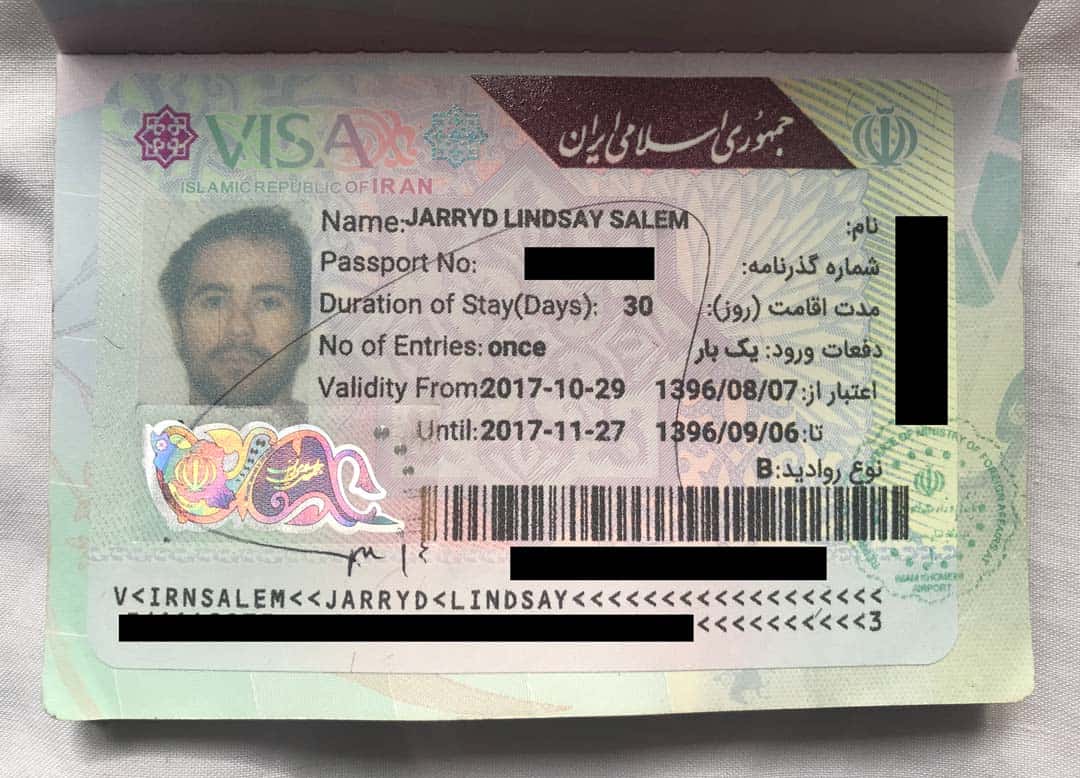
You Need to Dress Appropriately
This follows on from the customs section above, but in a bit more detail.
Iran is an Islamic country, and as such you need to follow the Islamic dress code. Here are some things to keep in mind.
Women need to cover their arms, legs and head. This including a Hijab, loose long length shirt with long sleeves and pants.
Leggings or tight jeans are ok as long as your top is long and covers your bottom. When wearing pants, you need to be covered down to your ankles.
The most common way to cover your head is with a scarf. The local women wear bright colours and are very stylish with their clothing, so don’t think you need to wear all black.
Black is still worn a lot but not so much among the younger generation.
You can wear sandals. Some guesthouses and hostels will allow you to take your headscarf off on their premises but do check first.
Men aren’t allowed to wear shorts in public, so bring long, lightweight pants as the best option. T-shirts are fine to wear in public. Men can wear sandals too.
If you do wear inappropriate clothing it’s not the end of the world, and besides some angry looks from some of the older generation, you’ll probably just end up having a friendly local let you know what’s best to wear.
In Tehran, the locals push the limits in terms of what they wear in public. At the end of 2017, an uprising occurred and supposedly women were no longer required to wear the Hijab in public in Tehran, but wait until you are in the country to find out for certain.
When you land at the airport, it is respectful to put a scarf straight on your head ladies. This will cause no trouble for you by locals or the officials at the airport.
Once you’re in the air on an international flight you’ll see most young ladies take their hijab as soon as the plane leaves the ground. Just follow what the locals do.
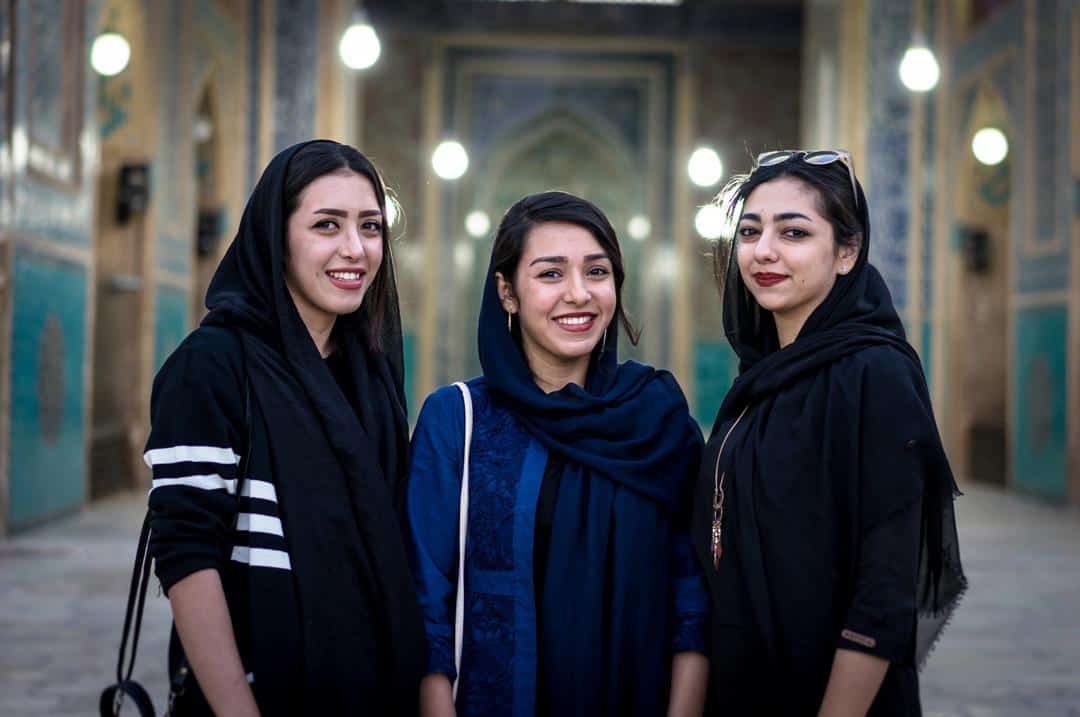
We were quite surprised to discover that a lot of Iranians could speak a little bit of English, but that wasn’t always the case, so do yourself a favour and bring along something that can help translate English to Persian.
We always travel with Google Translate and offline languages saved on our phones, but at times having a phrasebook is the best (and most social) way to interact with people who don’t speak any English.
Remember, you are in a country that doesn’t have English as an official language, so don’t be that rude tourist that gets upset if people aren’t understanding you.
Persian (Farsi) is difficult, and no locals expect you to learn much beyond hello and thank you while you are there, but do your best anyway as a few extra words will go a long way in showing respect.
Also don’t be surprised if you are constantly invited out for tea with people so they can practice their English. If the opportunity comes up, make time for it, as it’s an amazing experience for both the local and yourself.
Don’t forget your cash when visiting Iran, as none of the ATMs in the country accepts foreign credit or debit cards thanks to the embargo. So if you forget to bring all of your cash for your entire trip, you’re out of luck.
Figure out what your usual budget is for a trip ($50 a day, $100 a day, etc), then bring a bit extra just in case. USD is best for all around the country but Euros and British Pounds are also accepted in Tehran.
There’s two exchange rates in the country – official rate and black market rate – and the black market rate is of course much better.
We actually found an exchange booth at Tehran airport that gave pretty close to the black market rate, so we traded some cash there.
As a tip don’t exchange all of your foreign cash into Rials at once, because you’ll either get ripped off on the exchange rate back if you have any left over, or you’ll be unable to trade it outside of the country.
Also don’t be too concerned about travelling around with thousands of dollars in your backpacks. As we mentioned earlier theft is rare. Do keep your money stashed in different spots though just in case.
UPDATE: If you’d prefer not to carry all your cash with you, can actually pre-order a local Iranian debit card from the company, Mah Card . It works just like a normal debit card in your home country.
You order it on their website and they’ll deliver it to your hotel in Tehran when you arrive. They have an online system too where you can top up the funds if you’re running low.
Use the code ‘ NOMADASAURUS ‘ at check-out to get a 40% discount on the card when ordering. Instead of a 19 Euro issue fee, our code brings it down to 11 Euro.
“Toman or Rial?” Get used to asking that question, because if you don’t it could end up being a costly mistake.
The currency in Iran is officially known as the Rial, and is valued at roughly 30’000 IRL to USD$1. That’s a lot of zeros, so what the locals have started doing is dropping a zero and calling the new value a Toman.
1 Toman = 10 Rial
When you hear prices quoted in Tomans you need to add a zero on the end and pay the amount in Rials. It sounds confusing, but you’ll pick it up pretty quickly.
That’s why it’s important to always ask Toman or Rial, so you don’t accidentally pay too much on an item. Most vendors quote in Tomans anyway, so chances are if the price seems too good to be true, you need to multiply it by 10.
Rumour has it that Iran will officially introduce Toman as a currency in the coming years, but that hasn’t come into effect yet.
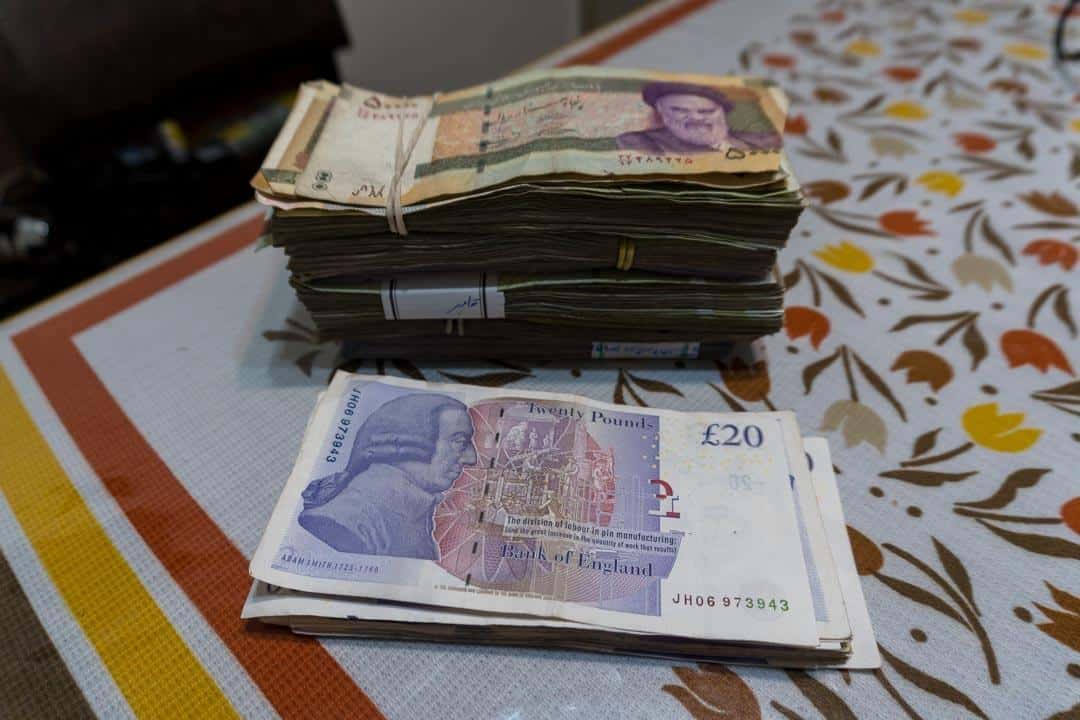
You are going to do a lot of walking in Iran, so bring comfortable footwear. The towns here are so amazing that you’ll probably end up walking at least 10km every day, so look after your feet.
These don’t necessarily have to be hiking boots (unless you’re planning on doing some treks). Just make sure you have some flat shoes that you can wear all day without a problem.
Don’t bring heels. You don’t need them, and you won’t wear them. We had a pair of hiking shoes each and a pair of sandals. That was perfect.
Persian food is varied and delicious, and there’s plenty of different styles to try, so be adventurous!
Most people travelling on a budget will end up eating falafel sandwiches when they’re in Iran because they are cheap ($1 !), filling and delicious, but there’s plenty more to Iranian cuisine then just kebabs.
We don’t consider ourselves to be foodies, but luckily we were travelling with our good friends Dan and John and they are all about culinary travel, so they had a huge list of food they wanted to try. And boy were we thankful they did!
They had looked up the different types of food they wanted to try, so we basically followed their advice and tried it all. Of course, it was super delicious too.
One particular dish we all loved was dizi. It’s quite confusing how to eat the first time, so we had the restaurant owner show us how to mix and grind all the ingredients. If she didn’t show us, we wouldn’t have a clue how to eat it.
If you are a vegetarian, there are food options but they can be limited. There is a lot of eggplant, lentil and chickpea dishes. There are simple salads and rice also.
Try to get away from the popular tourist areas as well, as the prices are going to be a lot higher than the average place.
Move away and you will be surprised how much the price drops, and the portions are larger. If you are passing a local restaurant and it is packed with locals, that is going to be a winner.
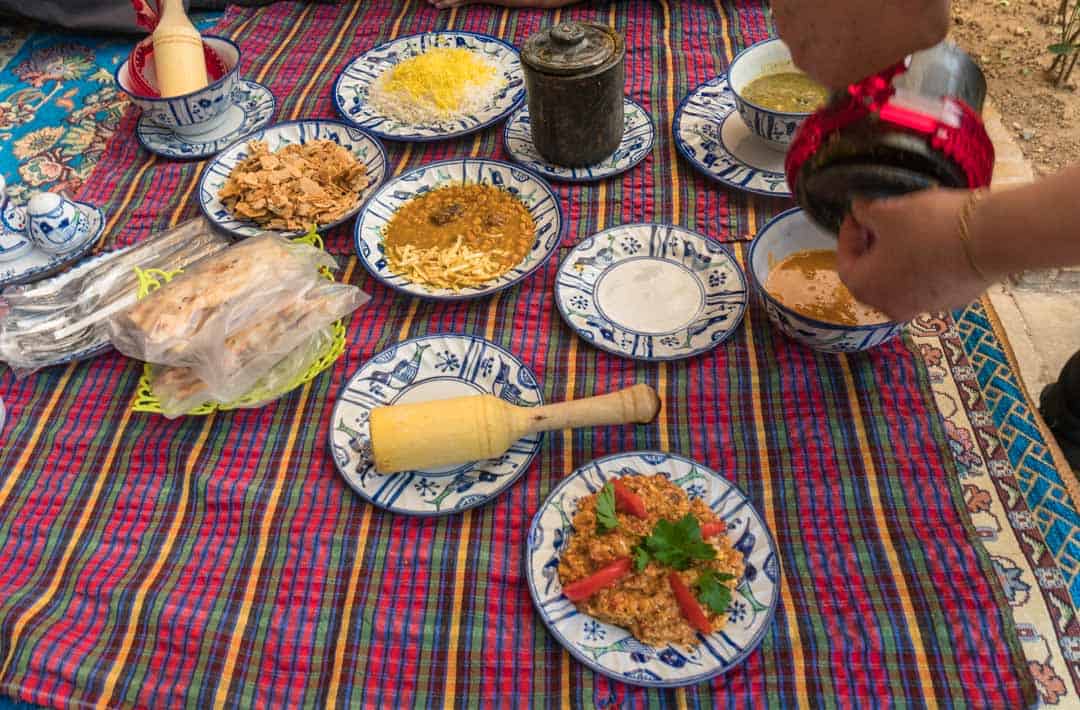
We always recommend people travel with a backpack rather than a suitcase, but this is especially useful when you visit Iran.
The road and paths are uneven, and wheeling a suitcase would be a nightmare. A lot of hotels don’t have lifts, so unless you’re feeling strong it’s going to be hard to carry your suitcase up a lot of flights of stairs.
Always choose a lightweight backpack that fits you perfectly for the best support.
There are also hybrid backpacks, that have harnesses and wheels on the bottom for the times where you just don’t want to carry it.
Unless you are on a whirlwind 7-day trip of the country we recommend you design an itinerary of what you want to see and do, but don’t book anything until you are in the country.
Iran is one of those countries that is best to research beforehand so you can make the most of your time and you don’t miss anything, but don’t be surprised if some places you end up liking more than others.
Be willing to change your plans if you get somewhere that you want to stay an extra day, or if you meet a backpacker that raves about one town you hadn’t considered before.
Don’t stress about booking buses, flights or trains before you arrive. Everything can be booked in-country, for a much cheaper price than you’ll find online.
By not locking in your travel plans, you can change and swap your itinerary easy enough.
Disclaimer: The one time that you may need to book everything ahead of time is during Nowruz, which is the Persian New Year. If you’re planning on travelling to Iran during this time (it happens around the spring equinox in March) you’ll find things are extremely busy with millions of locals travelling around the country to spend time with their families too.
Looking for somewhere else to check out when you visit Iran? Don’t miss our article on the best things to do in Shiraz!
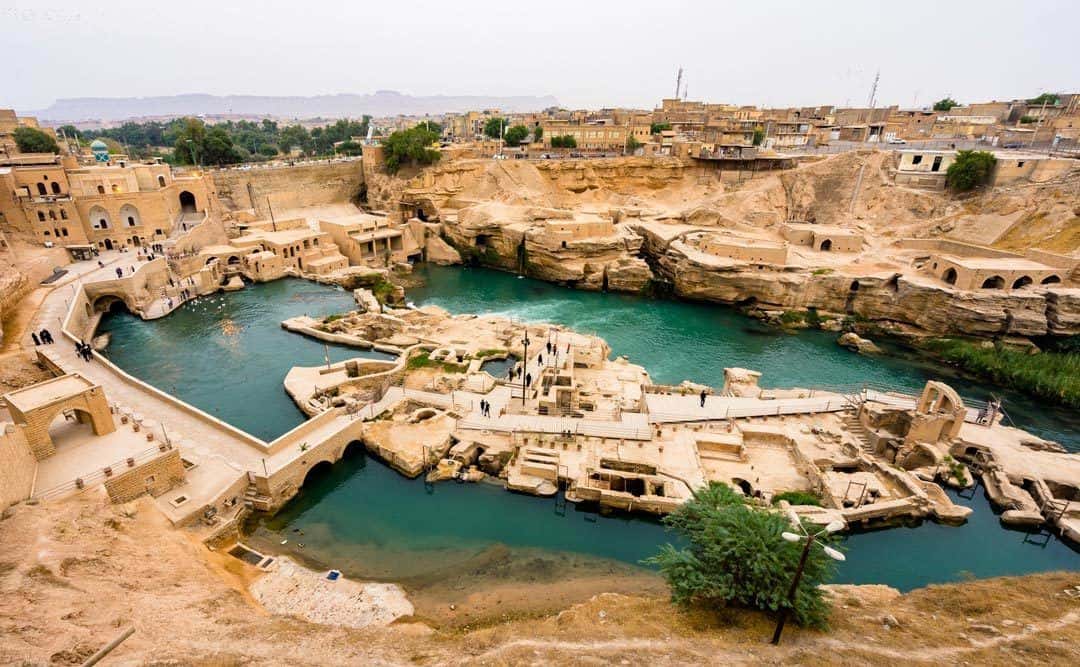
One of the best experiences you will have in Iran is spending time with all the friendly locals. And trust us, you’ll get plenty of opportunities if you are open to it.
The city squares are usually where locals will approach you to welcome you to their country, have a chat and practice their English.
Don’t shy away from this, even if you are a solo traveller. We found out so much information about Iran and how the locals live simply by chatting away.
Most people asked us questions about where we are from and were very happy to answer our questions. It was a true insight to Iran and we made some beautiful friends from it (many of whom we still keep in contact with).
Don’t be surprised if you get a lot of invitations to people’s homes as well, and this may be one of the few countries where we’d say hanging out with strangers is highly encouraged. The Couchsurfing scene is huge here too if you’re into that.
Do be wary of some people who will take you to an expensive tea house though. They are nice people, you will have great conversations, but they can be a little cheeky.
Also always look at the menu before you start ordering to make sure they haven’t taken you somewhere that has crazy prices.
Some will invite you out and try to sell carpets to you. If you are not interested just be firm and move on with the conversation.
We only had this happen to us once out of more than a dozen great experiences, and once we made it clear we weren’t buying a carpet we still had a great chat with him.
There is only one thing with all this – Expect to be stopped every few minutes by people wanting to chat! Make sure you’re mentally prepared when you go out around town to have a million friendly conversations.
You shouldn’t just do this in Iran, you should do this everywhere you travel, but it’s important to keep in mind.
In some countries, there are tourist prices and local prices. To be honest, we almost never felt ripped off here, but it did happen occasionally.
Before you buy anything, whether it’s a souvenir, a meal, a pot of tea, a tour, a taxi ride or whatever, ask to see the menu or how much it will cost to avoid any unpleasant surprises.
Get out of the tourist squares too. Chances are if you walk a couple of blocks outside of those popular areas, the prices will drop dramatically.
When buying survivors, ask the price at a few places, get the vibe from the person/place and then buy. Try your bartering skills, but don’t be offensive.
We always try to settle in the middle so both parties are happy. This is their business and they need the money more than you do.
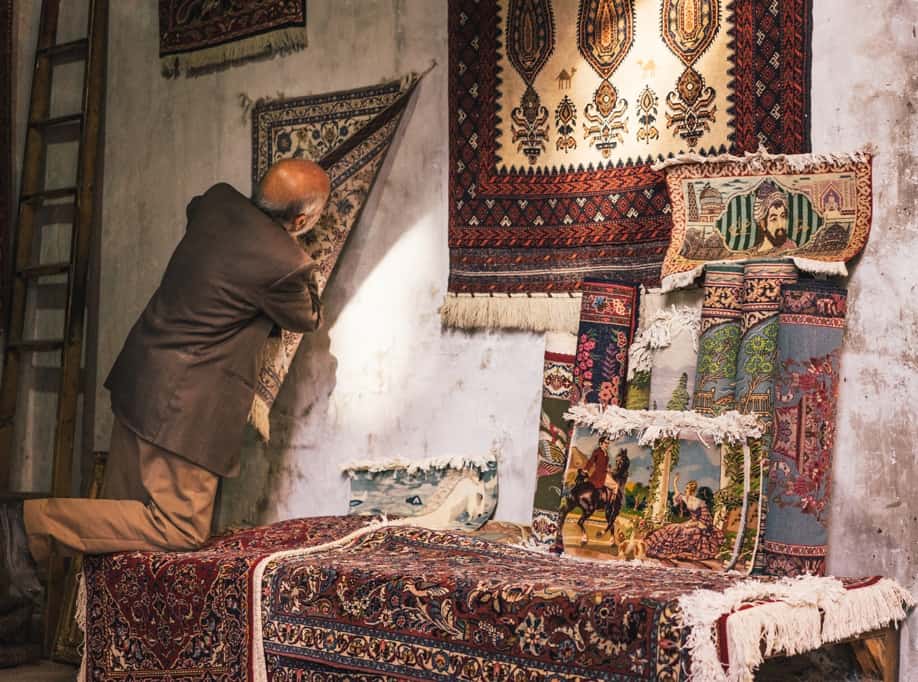
If you are flying domestic, book through an agent or your local guesthouse in the country. All the local airline pages are in Persian, and these are where the best deals are.
Online booking agencies like Skyscanner and Momondo will not bring up these flights. We were in the west near the Iraqi border and wanted to fly to Tehran. Our local guesthouse helped us out and we booked it for $50 USD including snack and bags.
They were charging $200 USD on one of those online booking agencies above. We never were questioned at the airport about the local price and everything went smoothly.
If you’re not travelling in a group of four, ask at your guesthouse or talk to other travellers to see if you can share the cost of a driver with them.
Sometimes hiring a driver between towns as private transport would work out to be the same price as 4 bus tickets. You get there faster and can stop when you like along the way.
This will save you money and you might even make some awesome friends out of it.
Iranians are very punctual. If you plan to leave for a tour at 8am be in reception at 7:45am, and the driver will most likely already be there.
Buses and trains also won’t wait for you if you aren’t there. The last thing you want to do is miss your tour because you slept in or hadn’t packed yet.
If you’re heading to the airport, bus or train station make sure you leave plenty of time in case of bad traffic.
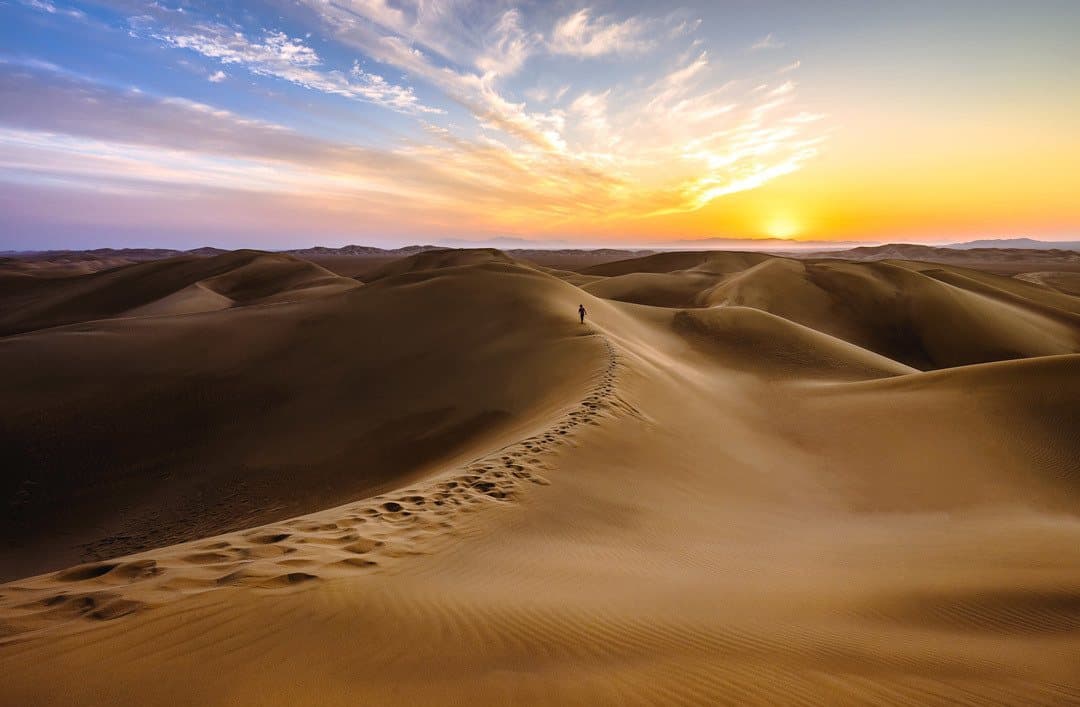
When we say horrible, we’re being polite. The traffic in Iran is actually insane.
If you’re exploring Tehran don’t be surprised if you have plenty of “Holy s**t!” moments as you go to cross the street or you get around in taxi.
It’s not that Iranians are bad drivers…they just don’t have a concept of space when driving around. In one way it’s almost as entertaining as it is scary.
No one is actively trying to run pedestrians down, but if you do try to run the gauntlet of crossing a busy road it’s best to wait for a local to join them on their hell-bent journey to the other side.
Some social media platforms are banned in Iran and you cannot access them without a VPN (Virtual Private Network).
You cannot access Facebook, Facebook Messenger, Twitter, YouTube or Pinterest. You can access Instagram , but the rest only with a VPN.
We used ExpressVPN and had no issues. Here is a link to get your first 30 days for free .
Make sure you download your VPN before you arrive in Iran, because a lot of the VPN sites are blocked by the government.
If you can, we also recommend having access to a few different VPNs, because every now and then one might be blocked in Iran.
ExpressVPN worked for us during our trip, but some people have reported that it didn’t work during their own trip. Last we heard it’s back up and running properly now though.
Most of the guesthouses we stayed at had free wifi, but don’t expect it to be fast.
Some hotels had wifi available in the rooms, while others were only in the reception area or dining rooms. It all depends on how upmarket your place is. In popular cities, tea and coffee houses had wifi also.
One thing to keep in mind though is that just because there is wifi at your hotel, be respectful on how much you use it.
There are no unlimited data plans in Iran, so the hotels have to pre-purchase data in small packets.
Please don’t be that person that streams Netflix or tries to download the new season of Game of Thrones, because all that will happen is you’ll end up using all the net for everybody else in the hotel, and cost the owner more money.
Yep, we met a guy that did just that in Varzaneh, and because it was a weekend it meant nobody in the hostel could get internet until Monday. Thanks, mate.
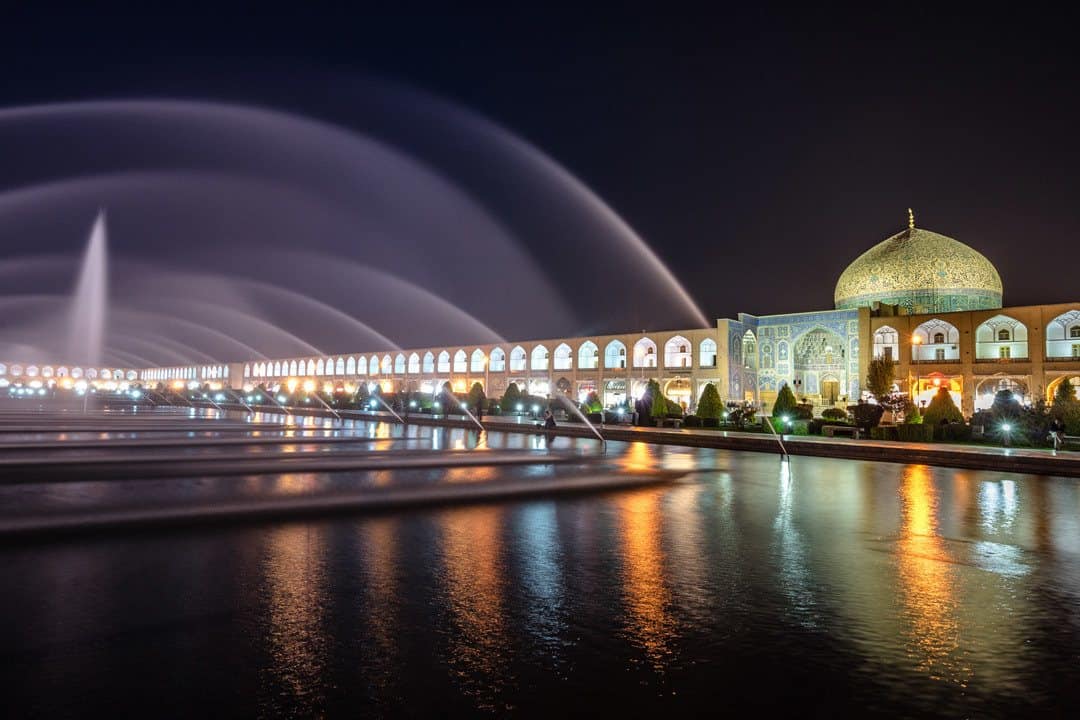
Despite what you may have been told, you can buy a local sim card in Iran as a foreigner, and it’s a great idea to do so.
This way you can call hotels to make bookings use WhatsApp and Snap (more on that below) on the go, and keep in touch with friends and family back home.
We bought up a sim card with the telecommunications company IranCel through our hostel in Tehran, however, they marked the price up by double.
We found out later that you can buy sim cards at the airport or at any store, so our suggestion is to do this yourself.
When going into the phone store bring your phrasebook or a local friend. You will not need to show any ID, just pay in cash, but it helps to have your passport with you just in case.
You can top up at little general stores that display the IranCel sign. They will do it all on your phone and charge a small fee for their time. Please don’t argue with that, it’s maybe 25c USD.
We were getting 5GB of data for about $10 USD.
There is an app in Iran called Snapp, and it is similar to Uber. It’s a rideshare app where drivers register and customers can order cars to get around town.
This was a lifesaver for us!
What makes Snapp so great is that a price is determined by the app and you pay in cash once you get to your destination. There’s no metre, so the driver will take the most direct way possible.
When you book it you’ll get the driver’s name, their car model and their registration number, so you know you’re getting in the right vehicle.
Yo drop a pin on a map for where you want to go, so there’s no need to try and explain it to the driver in case he doesn’t speak English (or your pronunciation is crap).
The other added benefit is you can rate the drivers afterwards, so they are more likely to be honest rather than a taxi driver.
The only thing is you cannot easily download it onto an iPhone, as Apple is an American company and does not support Iran. It doesn’t show up in the App Store.
If you go to the Snapp website you can download it to your Apple phone through a special link there. Downloading it on an Android phone is easy with no issues.

This one was a big surprise to us, but you can drink the tap water just about everywhere in Iran.
It’s totally safe to drink, even if you’re new to the country, so don’t worry about buying plastic water bottles everywhere you go.
Bring a reusable water bottle instead and simply fill up as you go.
Don’t drink river water tough if you are out hiking.
Iran is a nation of tea drinkers, so it’s no surprise that you’ll get delicious fresh tea for cheap (or free) just about everywhere.
But what about us coffee drinkers??
The bad news is that getting good coffee is very hard in Iran. Despite their close proximity to places like Turkey, the coffee culture phased out years ago and so now the best you’ll find is usually those horrible instant packets.
There is a silver lining though, and some entrepreneurial locals have discovered that coffee is basically the second greatest thing on earth (after a delicious IPA, which you also can’t get in Iran), and some Western-style coffee shops are popping up in major towns.
They’re not cheap, but when you need that caffeine hit in the morning it’s totally worth it.
When you catch the metro around Tehran or Esfahan, there are carriages designated just for women, which is great if you’re a solo female traveller.
These are basically sections that males aren’t allowed in to stop accidental touching of non-related mixed genders, but it also adds a sense of security for women taking public transport.
Occasionally if the mixed carriages are full you’ll see one or two men in the female ones, but they tend to stand next to the door away from everyone.
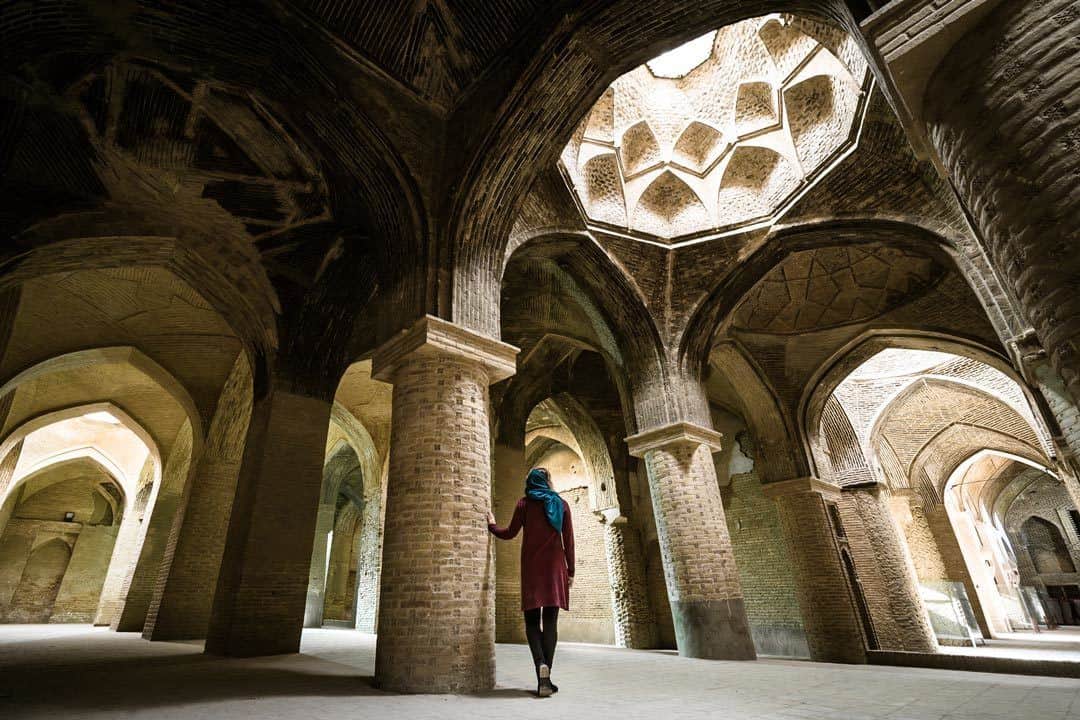
[box] Those were just some of the things you need to know before you visit Iran. Has the article helped you? Do you have anything else to add? Leave a comment below and let us know![/box]
Alesha and Jarryd
Hi, We’re Alesha and Jarryd!

We’ve been traveling the world together since 2008, searching for the planet’s best destinations and adventures.
Love Travel?
Sign up for our free weekly newsletter for the best travel tips, ideas and deals!
We respect your privacy. Unsubscribe at any time.
READ MORE...
Jacis Lodges Review – A Luxury Safari in Madikwe, South Africa
Cape Kudu Hotel Review – Best Place to Stay on Koh Yao Noi
The Ultimate 3 Days in New York City Itinerary (2024 Guide)
Related Posts
Life on the indian pacific – australia’s ultimate rail journey, koh yao noi, thailand – the ultimate travel guide [2024], 2020 recap – a year of change and challenges, the land of spears and smiles – wogasia spear festival on the solomon islands, 105 thoughts on “25 things to know before you visit iran”.
Hello friends, I read your comments and I wish I could say that I am happy that you think so naively about the Iranian regime, but the truth of Iran and its people is not what these friends say, and unfortunately the bitter truth is that all those media that They present this regime and the leaders of the Islamic Republic as terrorists and a bunch of dishonorable and inhuman people, they are telling the truth and only the oppressed people of Iran understand this! you can ask them. But for you tourist friends, yes, this country can be a paradise because your money is worth many times more than ours, and not you tourist friends, but the unfortunate people of this cursed country feel the pressure. Our only wish was to have normal rights and a normal life like you, but this regime stole that life from the people of Iran and blackened the lives of the people of this country. Hoping for a day when this terrorist regime, which has made the Middle East and the whole world insecure, will be destroyed and we Iranian people have good and sincere relations with the people of other countries of the world . That day we will have at least a normal life and the world will not recognize this country as a criminal terrorist country. Written by a 27 young Iranian.
hi I want to just say now ( 2023-15-11 ) that the US dollar is 510000 Rials and here is heaven for people of countries where the currency is the dollar and Iran just is Hell for local people thanks to the Iran government for this situation!!!!!!
Hi dear Alisha and Jerry My name is Raziyeh. As an Iranian, I wanted to express my sincere gratitude for your kind words and appreciation of our beautiful country. Contrary to media propaganda, Iran is safe, and Contrary to media statements, we are hospitable and genial people who do everything to ensure you have a fun time in Iran. Please do not believe the lies that social media tells about our country. We’ll be happy to see tourists and give information to them. I hope you revisit our country. Best regards, Raziyeh.
Hi everyone I’m from Iran. I’m happy that you liked your trip to Iran. Iran has a lot of museums and attractive places if you’ll come you should visit them. And we’ll be happy to see tourists and give informations to them.
Iran is an extremely lovely place to travel. Thank you for the trip advice. I adore your article.
For foreigners especially Westerners Iran is a very dangerous country. There is a high risk of being arrested on fake charges. Atleast 50 foreigners have been arrested recently and sentenced without a fair trail. The “friendly” citizens of Iran will not help you out unless you pay them witg Euro or Dollars…..
Well! I accidentally found this while surfing the net, and it’s a bit sad that each dollar is 450000 Rials… People are still friendly to tourists though, no matter how hard our lives are. I hope you visit our country again, after all these sad events, of course.
22 days later and its 510000. when will these evil leaders leave us alone
We are glad that you were satisfied with your trip.You pointed out great points like someone who has lived inside for years… Our people believed, but the government has crushed the people so much under the economic pressure that they have become a little unfair to each other. Be sure to use SNAP inside Iran.. Be sure to check the price before buying.. Our common currency is Toman and Rial is nominal. For example, now every 1 dollar is equivalent to 33000 Tomans.. To eat a pizza, you need 6 or 7 dollars.3 cents are required for 1.5 liter of taqriya water.. If you have an acquaintance in Iran, you can be much easier.. Don’t pay too much attention to the capital because it has very beautiful cities with a very old history. Thank you for choosing which country for your trip. Good luck
Thank you for the excellent information and for taking an interest in the lovely country. really nice tips for visiting Iran.
I’m glad you liked Iran. Unfortunately, due to the difficulty in managing economic affairs, the Iranian people suffer from the high cost of goods. Now each dollar is equivalent to 277,000 rials, which is really terrible, of course for our people! Of course, Iran is still full of beautiful places and amazing places! I hope you have good trips …❤
Hi guys I am Ava. I am from Iran/ Isfahan. If you want to come to Iran I would be happy to help you. I have a beautiful Iranian old house.
Can you please write about traveling in Iran at the moment. I would be traveling on a New Zealand passport. Thank you. Evan.
Iran holds many surprises for visitors; like the climate which can fluctuate greatly, depending on the area and time of year, dispelling the long-held myth that Iran is nothing more than a vast, sweltering desert. But Iran is a historical place and i like to visit this type of places that is why few days ago i read this type of article on another site it contain huge information. While some surprises are nice when travelling, it’s important to be as well prepared as possible.
Is $1000 for 7 days visiting 5 cities everything included except airline tickets a reasonable price? Please let me know what you think! Cities included are Tehran, Yazd, Esfahan, Shiraz, and the desert side with Caspian sea. Thanks,
Definitely if you stay at budget accommodation, take public buses as transport and not eat at fancy restaurants. Have a good trip
it’s very good
Indeed it is 🙂
I am Iranian. You described Iran very well. I am glad that you visited Iran
Thank you for your comment Masoud. We really enjoyed travelling around Iran. 🙂
Hi Thank you for your essay about Iran. As an Iranian I do hope you have good memories generally from Iran. No country is perfectly free of any trouble but please do not believe propaganda against Iran unless you travel to Iran and live with Iranian for a couple of weeks (at least) and then judge.
Hi there! I’m an Iranian, and i’m REALLY happy that you loved our country! I hope other tourists enjoy their travel to Iran, and I wanted to say, that Pinterest doesn’t need VPN! 🙂 And also about hijab, if you’re thinking that it’s gonna make you struggle, well, it definitely isn’t. I mean, it’s not such a big deal, and you’ll get used to it and continue enjoying! Anyways, hope you like our country
Reasons for a Group Visit to Iran Experienced travelers may want to look away. Guided tours can really be the best option for some travelers going abroad. Of course, they limit you a little and lose a little freedom. You will not have enough time to fall in love with a place and you will not have enough time to stay there, and other companions may not be with you. But no matter what the veterans might say, there are good reasons to tour for those who want to.
Salaam All, I’ve travelled extensively in the Middle East (Egypt, Palestine, Lybia, Qatar, Dubai, Saudi Arabia, Iran and India. My wife, daughter and myself went on holiday to Iran in 2012 and 2015 (for my 60th birthday). An Iranian couple came to sing happy bithday to me in farsi. It was an inexplicable experience, no crime on the street, no fighting, very, very safe, people very friendly and warm, food and confectionary very good, not expensive to shop but hotel accommodation could be expensive, public transport (bus and metro rail) very good and effecient, metro stations very clean and very easy for foreigners to use. Although we were based in Northern Tehran (Eliheyah), we once drove by luxury coach to Ishfahan to spend one week there (2012), the other trip we flew to Shiraz to spend one week there (2015). I fell in love with this country, it’s absolutely beautiful. In Tehran, we even went in the cable cars on the Azborg mountains. O, I just cannot stop raving about IRAN. I’ll visit there anytime. Please don’t believe the media with their negative reports, go see for yourself and discover this amazing country. Salaam from Riedwaan Salie (Cape Town, South Africa.
That is so nice. What a great birthday trip. We are so glad you had a wonderful time with you family. We found the country very welcoming and friendly also. Thank you for your comment. 🙂
Your itinerary was perfect! I hope you come back again very soon! I heard now you should ask for visa only from agencies. Also now for your money matters you can use a local debit card like Daricpay to charge and transfer money online
We hope to visit again one day. Take care
Hi Im am an iranian person and your information was totally correct about iran I am very glad to see you were anjoyed traveling to iran If you come to iran again you can visit other cities like shiraz,Tabriz,Isfahan,Hamedan they are as beautiful as Tehran
Thank you so much for your comment. 🙂
Hi all, I have been 2 weeks in Iran the last month, my friends and I were travelling the west part of this huge country touring the famous cities and recommended places over the countryside. I could never thought how beautiful were every little point that we stopped by: landscapes, restaurants, seacoast, food… persian landmarks will remind forever in my mind. As we were travelling by car we trusted (company removed, you can message below if interested), a notorious iranian company which offers a wide variety of car for rent. The service was excelent and they provided us whatever we need in order to make our trip easer. I would definetely recommend this company If you are thinking about renting a car to shuttle from a place to another, they are serious and reliable. Thanks persian people and the company for making our dreamt trip happen!!
We love Iran!!!!
Sounds like you had a great trip. We are so glad so had a great time.
Hi Alesha and Jarryd, Thank you for the useful info and your interest in my beautiful country. I’m Zahra Mazaheri an English – Farsi translator. I would be more than happy to help the tourist to Iran in having a pleasant journey.
Glad you liked our article. All the best
Iran is a wonderful country for all nations to visit. Whether you’re interested in going to cultural and historical places, try local food, shopping, or visiting new people, the country is one of the best places for all of these.
Thank you for your comment. It is a magnificent country
thanks so much for your tips, and i want to add this there is something that we call it “Taarof” This is a polite exchange that takes place in all aspects of life in Iran, in shops, in streets, in businesses, at homes. Simply stated, it is a form of one person making an offering and the other, refusing it. This ritual may repeat itself several times before the individuals finally determine whether the offer and refusal are real or simply polite. Be very careful how and with whom you taarof so that it does not interfere with your stay. Use common sense as to when to do it and when not to.
Thank you so much for this. After travelling the country for 3 weeks, we only experienced this once in Tehran on the outskirts of the city, We ate locally, bought locally, stayed locally, bought a lot of items on the street but only experienced it once. We were shocked. We had read about it and was waiting every time but it never came. Maybe if you are a foreigner they don’t do it as much. Thank you the explanation.
I really appreciate for your thoughts on this topic. Thanks for sharing this information with us.
Hi Alesha and Jarryd, this was so helpful. We’re off to Iran in a couple of weeks and great to get some tips re luggage, local currency cards and communication options. thanks david
Hi David, We are so happy the article was helpful. You will have a great time in Iran. Do not over pack. Woman have to be covered. Loose clothing is a must and a long top/dress is best as it covers the figure. Her arms and legs have to be covered. Sandels can be wore. A hijab is a must so bring scarfs. For the men, your arms do not have to be covered. Do bring pants as you need it for mosques. Our advice is to bring zip off pants. They are great. We did not use local currency cards. We bought all our cash in euros and exchanged it in Tehran on day 1. We did it with our guesthouse. They gave us a great rate. As for communication, do download Farsi offline before you go so communication can be easier. Surprisingly a lot of people do speak broken English. have a great trip.
Hi guys. Im so glad you had a good time over here. I believe Iran is the most misunderstood nation (thanks to media!) and articles like this may help people see Iran for what it is. One thing i need to point out is the currency exchange rate. the rate of 30,000 to 1 USD is no longer valid. 1 USD would be exchanged to about 110,000 rials now (11,000 Toman). Hope to see you back here soon! cheers
i promise to passengers ( our guess ❤) that we can make nice memory for you , and hope you enjoy that
Hi guys, great article! Just wanted to suggest that you include information about the Pocket WiFi and Travel Debit card services offered by MahCard (www.mahcard.com) as well… We travelled from Amsterdam to Iran during January this year and we used both services from MahCard and they really made our trip much easier…
Thank you for your tip Lotte. We have never heard of these guy. Definitely would be helpful. We strongly encourage travellers to do their on research on companies and make their own judgements. All the best
Hello! Very useful info about Iran. I am preparing a trip with car from UAE to ROMANI so it will be Bandar Abbas to Turkey Border. Any info and advices are welcomme! Thx
Hi Als, not too sure about that border. We flew in to Tehran. All the best.
Hello Dear Guys, I’m really glad to find your blog. It’s really interesting to me. I should say thank you to you for giving this good information about my country to people. It would be our honor to be host in your next travels to Iran.
I have been to a lot countries. I have been to super cold areas like Norway and have lived in the snowy Switzerland, and have also been to warm countries such as Bali, Sri Lanka, etc… What I love about Iran is that whenever and in whatever season you go, there are always 4 seasons. The southern part (Persian Gulf) is known for its golden beaches and hot climates, other areas such as Shemshak, Darbandsar, etc… are known for their snow and mountains. I recommend going to ski resorts in winter, and as a person who has lived in Switzerland I can tell that they are better. At the same time where you find snow in Iran, you can also travel to the other side where there are hot deserts. I recommend you go to these desert areas with a local tour called RONATURE, which is an ecofriendly tour and provides vegan and vegetarian food, furthermore supports locals and the environment. The Persian Gulf is unimaginably beautiful. Qeshm island in the south is probably the most beautiful place in the world, unfortunately there are not many photos of this island online because not many people know about it yet, but I do recommend taking diving courses there. The water park in Kish island is the best I’ve ever seen, much better than the ones in Dubai. I could go on for forever but you go to Iran once and experience all the four seasons. You get snowy mountains and sunny beaches. You go skiing and after a short flight you are tanning on the beach. This is a miracle and not something other countries dont have to offer. I can say nothing more but to recommend this marvellous country. Do not listen to the media, Iran is safer than Europe and Im not even slightly exaggerating.
Thank you for helping people to travel to Iran, I believe everyone should visit Iran beyond the media portrayal.
We totally agree with you Vahid. Never listen to the media about a destination, we don’t. We really enjoyed our time in Iran and encourage people to experience this country for themselves. 🙂
Sorry, I won’t support Iran. The government is evil. They imprison and torture their own citizens and they execute gay people. How can you support a government like that? Oh, and if you have an Israeli stamp on your passport, they won’t let you in. That’s ok with you?
We don’t support the government, we support the people of the country, who are among the friendliest, most genuine and hospitable people we have ever encountered. If we were to boycott countries with corrupt and evil governments, we’d start with the US.
I recently moved to Iran, as I am Iranian-American (well, now mainly just Iranian). I really appreciate all of the sweet and insightful comments and your wonderful website. Since the last time I lived here I was a child and have only visited every few years, when I arrived I was definitely feeling like a Persian that came back from a lost time warp of sorts, and had to learn the deeper levels of what you all already thoughtfully mentioned like tarof and the culture. Iran is a BEAUTIFUL & AMAZING country and I am lucky to be here. Just to let people know, everything I read here is true and helpful. 🙂 Even riding a bus from Iran into Armenia (to access my american bank for my final paycheck), I started out feeling slightly awkward as the 99% Persian only passenger peers around me were playing cute little games with each other laughing, with LOTS of incredible Persian music… I started getting many happy flashbacks of American-Iranian dance parties… but this was the REAL thing! Within minutes I joined in after being invited to clap my hands and a few girls were doing little hand dances in their seats… within about 10 minutes half the people on the bus were all SINGING together, it was precious. I felt like I was home, with my (native) Iranian people, and I got little happy tears in my eyes. YOU CANNOT FIND THESE MOMENTS IN AMERICA or EUROPE where nearly everyone around you surrounds you with welcoming bright eyes all at the same time. It’s like they are making you part of their family. I recommend visiting Iran for ANYONE… You will see that Iranians are good hearted and loving, even with all the sanctions. Give them a genuine smile, and you will get 100 smiles back, with tea and poetry. 😀
What a beautiful moment. That is great you are going back to your roots. We hear you. Iranians are good hearted and so generous. It is a beautiful country. Have a great time and hope you settle in quickly. All the best
Thanks for visiting my country. Hope tourism breaks all the wall of this global village.
We hope so too. It is a beautiful country with many beautiful people. We loved our time there
Thank you so much for this amazing article! I am going to visit Iran, but just for one week, so I need to take everything that I can from this short trip. I didn’t know that I need a VPN, that is a surprise! I have Surfshark subscription. Maybe you know how it works in Iran?
Not too sure if it will work or not. We used VPN Express and had no issues. There are free VPNs if you get suck and find yours does not work. Have a great trip.
So disappointing to learn that Canada is not one of the countries included on the Visa on Arrival program…I really want to spend a week in Tehran but it looks as though that won’t be possible. That’s really too bad 🙁
I know. It is a little more of a hassle but worth it. I know Canadians, UK and USA citizens have to go on a tour but there are many great tours within the country. If you want a tour that is not a tour, check out Yomadic. He’s tours are informative but relaxed and have great reviews. All the best.
I was 10 days in Iran (Teerah, Esfahan, Yazd and Siraz) and … is a great country, good food, culture and fantastic people. Thank you Iran!
Glad you had a wonderful time Vitor. 🙂
hi im ghazal from kermanshah iran! a offer all to come here and feel how friendly people are
Yourwellcom
I’m sorry for this government rule.
Your welcome. I hope you back soon in my country.
hello,im shahzad from iran. thank you so much for your excelent content about Iran. all of the sentences are true about my country and u knew it very well.im so happy that you had good times here. As the other iranian people said,now 1 USD is equal with 141,000 Rials :).so Iran is a very cheap country for tourists,too:). come to my country and enjoy,it would be your best trip with no debt:)
Hi Shahzad, We had a wonderful time there. Thank you for the update with the exchange rate. We recommend all travellers to visit Iran. 🙂
Thanks for this guys! I am super excited leaving for Tehran on Monday I booked a small tour as I felt anxious about travelling independently first time ever in Iran. If I like it -and I am sure I will – I shall go back. I was advised to take a day travel backpack and a medium sized wheely which I hope to fill up with things bought locally. Of course I shall take essentials. Is a long skirt allowed? It might be cooler than trousers. What do you think?
Hi Alex, I hope you are having a wonderful trip, That great you booked a small tour. Sometimes it is the best way to see the country and learn about the people and culture. There is so many great souvenirs to buy. Unfortunately my bag wasn’t big enough. 🙂 Absolutely a long shirt is allowed but not a tight body fitting one. Long sleeve and maxi dresses are perfect. Trousers are great just make sure you top is loose and long past your bottom. Have a great trip.
Wow, Thanks for this. I’am glad, that I found your page. I’ll travel in october alone to isfahan. I’m already so excited
That’s amazing. You will have a great time. The Iranians are so friendly and welcoming. There is so much to do there. Here is a video we made about Isfahan if you want to check it out. https://youtu.be/XDYJ44CutT4
Great points!
Regarding bringing a load of cash though, I found a solution. In my last trip to Iran, I got a DaricPay card. It made everything easier!
Thank you for your suggestion and information. Glad that worked for you. We still recommend visitors to take cash as not everywhere will accept cards.
Hello everyone. This is Ali, an Iranian. This page is a good guidance; LIKE ! Iran is a country of different climates and has very beautiful historical monuments and natural areas. Contrary to propaganda, Iran is safe and a good choice for travel. Come to Iran and have nice time here.
Thank you Ali. 🙂
This is great ! Thank you! I’m preparing to go there in June and your article answered a lot of questions! I will come back to it just to remember everything. Thanks again.
Glad the article could help. Have a wonderful trip Joanna.
Great i read your experiences you had great fun in Iran. Everyone should need to aware about your guidelines before visit.
Hi Eric, thank you. We had a great time in Iran. Definitely everyone should read up on the guidelines, not just what we have written but from other also. It is important to do your research before travelling to a country. 🙂
Hey, great article on Iran tourism. What should I plan in terms of budget, if I want to plan a 7-day trip to Iran and cover major tourist/historical destination.
How would you rate food for just vegetarians. Thanks!
We budgeted $80 USD a day for a couple. We came home with a little bit of money but we rather have more than less as there is no ATMs that work for foreigners. As for vegetarian food, there are many options.
This is awesome article, I’ve read a ton of articles online these past couple of months as I’m traveling to Iran in May. I’ve already bought a NordVPN subscription regarding the social media access, I hope it will work fine too, saw some recommendations for it too. Other than that I really cannot wait for the trip, so I keep reading about it. Thanks 🙂
Awesome Steve. Have a great time. The people there are so friendly. It is an amazing country.
hi steve, i recommend, first travel to iran then try free vpn then buy subscription.because some vpn in iran dose not work. instagram and what up don’t need vpn.have a nice trip!
Hi I am very pleased to be pleased with your trip to Iran I hope that one day we will be able to travel to other countries as well These days, people in my country are very sad.
Hi Mostafa, thank you for your message. We did enjoy visiting your country but did hear this from many locals. We hope that one day it all changes and travel will be a lot easier for Iranians. We saw nothing but friendly and welcoming people. The most friendliest country we have visited. We hope happiness comes soon.
Glad to hear that you had good trip in Iran guys. However things get worse and now 110,000 rials = 1 USD which is good for tourists. Lol.
Thanks for that Mohammad. Not good for the locals. We thought it was cheap when we visited last year. Sorry to hear that
I glad to read this site My country has very beautiful natural scenery and tourism, as well as very caring and kind people… I hope to see you in my city, Isfahan, the city of culture and art, and we can spend good times together^_^ I hope that there will always be in all countries, including my country
Hello I am Iranian I am very pleased that you have been satisfied with traveling to Iran I wish you success
Thank you for stopping by. We loved travelling Iran. The people were so welcoming and we had a lot of great chats with many. We are looking forward to returning one day.
You were ok travelling without a guide? Is it easy to travel around without one? And is it possible to hire guides to specific places, such as Persefone of some mosque? My wife and I are planning to visit Iran on April or October? What’d say? Thanks a lot.
Absolutely. We met so many local people and had so much fun. It is an easy country to get around in. Their transport system within the cities were easy and great. Their bus system across the country was comfortable and faster than the train. You can hire guides at main attractions as you go. The hotels can help with that also. Have a great trip.
If you are from the USA, Canada or UK you need to go on a tour.
Hi We are older Australians and are wanting to go to Iran. We usually plan our holiday booking accommodation and transport before we go so are a little hesitate going without anything booked. We have not been on a tour before and they don’t appeal to us.
Thank you so much for this valuable information. My mother and I are trying to book an organized trip with Intrepid Travel. They told us that we were not allowed to be out and about without the accompaniment of a male. Which they say we would have to stay in our hotel during our free time unless we go with a male. Have you heard of this before?
I am Mehdi and I am from, Shiraz Iran. I welcome your arrival to Iran in advance. Staying you in your hotel during your free time in Iran is not right. You can go out without a male. I can help you if you have any question. please don’t hesitate to ask me. you can contact me at [email protected] . I hope you have a nice trip in Iran. Regards; Mehdi
Hi Cathy, that is so strange they would tell you this. That is wrong on Intrepid Travel to tell you this and if they are concerned about this for their guests they should provide tours for you free of charge as staying in the hotel room is not a very good experience at all. I hope you wrote to them to express your disappointment with this.
As Mehdi said above, that is not right. When we were travelling throughout Iran there were many woman travelling on their own that out and about by them selves. We did not hear of any issues. Obviously have your wits about yourself. The people of Iran are so friendly. The friendliest we have come across in our travels. I hope you got to experience this and see a lot of the beautiful country.
Hi Cathy, I’m an Iranian person, this is not right, you can go out without a male. Iran is full of friendly people and I’m sure you will enjoy your time and this would be one of the most unforgettable trips.
Hello kathy I’m very surprised by your talk I am from Iran and I assure you that it is not
Hey guys! This is one of the *very* few articles about Iran that I completely agree with. Oh, apart from one sentence: “Iranians are very punctual”… I actually laughed out loud. You must have got lucky. In any case, I’m glad you enjoyed your time, and hope we cross paths one day.
(also, feel free to edit this out: the photo of Alesha at Friday mosque in Yazd is actually Friday mosque in Esfahan)
Thanks so much Nate! Glad the piece got the seal of approval from the Iran expert himself! And I guess we did get super lucky with the locals being punctual. For the whole month we were there we were never left waiting. Will count our lucky stars, and make a note that perhaps it’s not always the case.
And thanks for the correction on the Friday mosque! Have amended it now. Happy travels mate.
Hi dears! I’m an iranian girl & I love my country… Actually my father is a tour guide & I’ve heared such lovely words from so many tourists… they mostly say they had heard many bad things about iran and they have experienced the bests when they came here… I’m so glad to here such nice words by many travelers and i really appreciate you cause you ‘re telling the truth about my amazing country!!!! I love you all dears!!
Leave a comment Cancel reply
Save my name, email, and website in this browser for the next time I comment.

Why you should travel to Iran as an American (and what to expect)
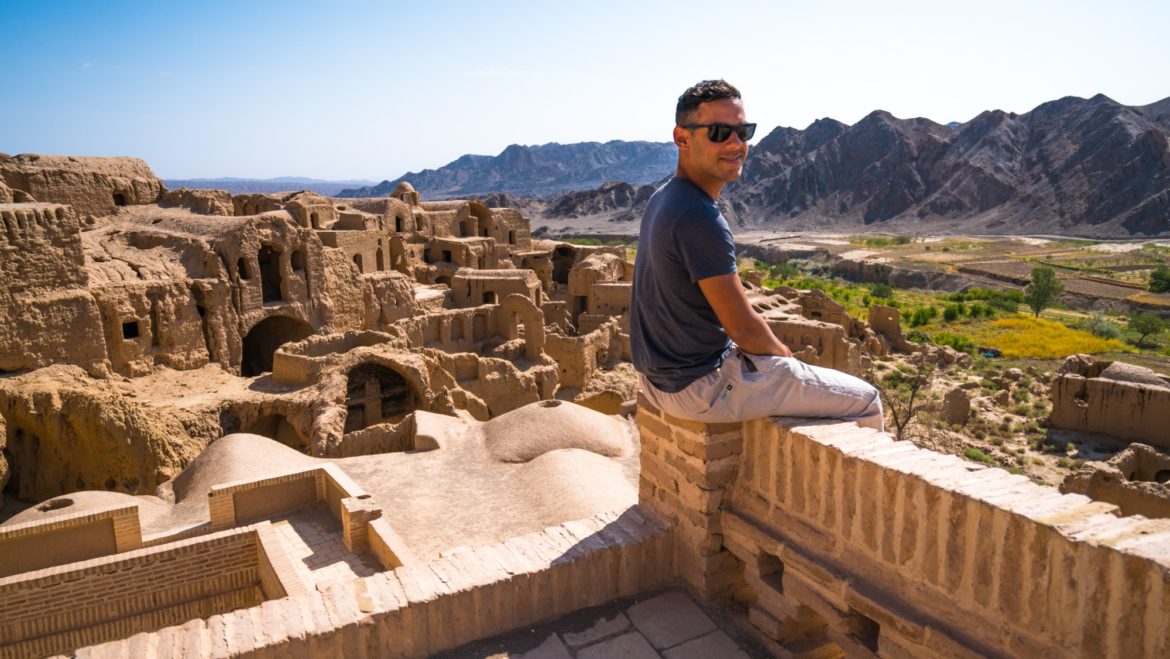
Packed with over 5,000 years of history, Iran is a destination everyone must experience at least once in their lifetime. From the ancient Persian Empire to the Zoroastrians temples, the countless mosques, and even the modern cities like Tehran, there is so much to see that one visit will not be enough.
After traveling to Iran on Intrepid Travel’s 14-day Iran Adventure trip, I shared my experience with many of my friends. Most of them replied with a similar response, “I’d love to go to Iran!”
This is a common response among travelers, yet not many actually plan a trip to the country due to misinformation, lack of information, or fear.
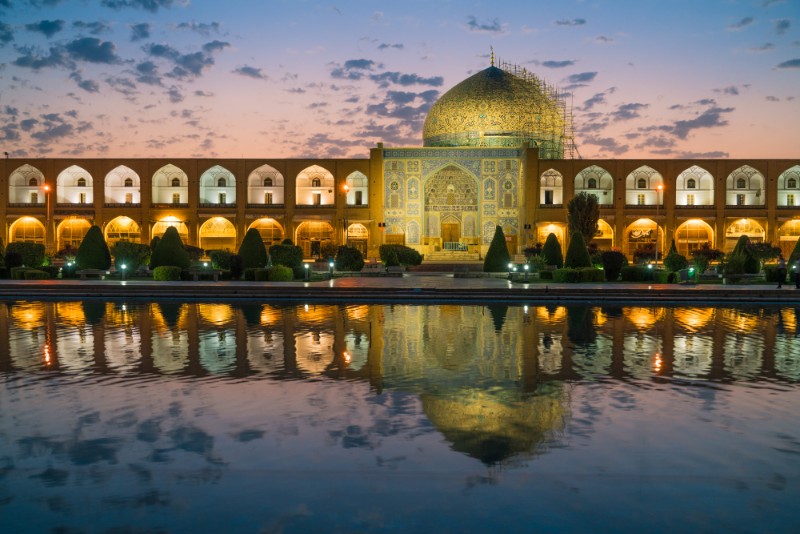
Sunrise at Naqsh-e Jahan Square, Esfahan
To encourage you to plan a trip to this wonderful destination, I’ll share with you a few reasons why you should travel to Iran as an American, debunk a few myths, and tell you what to expect there.
No, they don’t hate Americans
Contrary to what you see in the media, Iran is one of the friendliest and culturally-rich countries you’ll ever visit. And no, they do not hate Americans or any other Western nation. That’s just fear-mongering and it is far from reality.
READ MORE: 6 COMMON MISCONCEPTIONS ABOUT TRAVEL IN IRAN
When I arrived, I debated how open I wanted to be about my nationality. But as soon as I met Nadia, our Intrepid Travel guide, she put to rest any mild concerns I had about sharing openly that I’m American. No one has an issue with it.
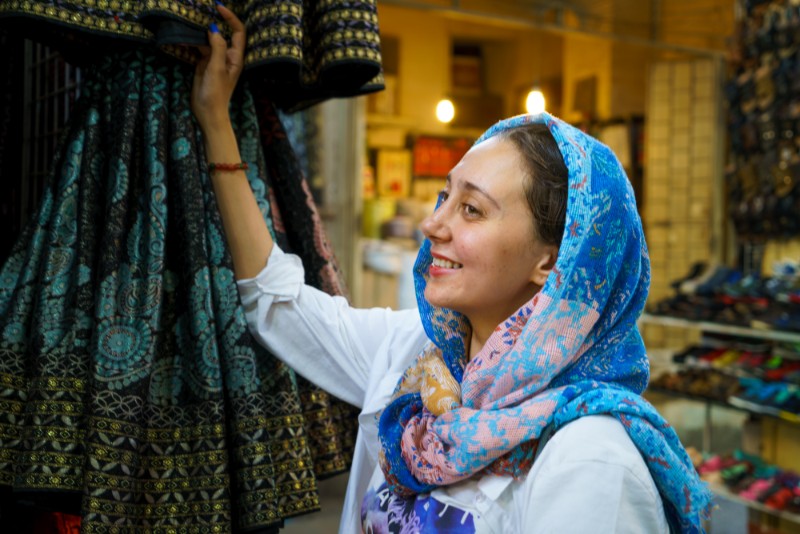
Intrepid leader, Nadia
MEET NADIA, THE INTREPID LEADER WHO WILL CHALLENGE YOUR PRECONCEIVED NOTIONS ABOUT IRAN
As we traveled the country, countless locals approached me and my other tour companions to chat with us. They were all curious to know about us, our life in our respective countries, and how we were enjoying Iran. On our part, we were just as curious to learn about them, so we fed each other’s curiosities over tea and casual chatting.
One of my favorite random encounters happened just before leaving Iran. I spent my last few hours in the country visiting the Azadi Tower, where I met a few early 20-something local guys. As soon as one of them learned I was American, he expressed with joy how much he’d love to visit the US and shared his vast knowledge of the country. In fact, he was wearing an American flag bandana.
Everywhere you go, you always feel that warm welcome Iranians are known for.
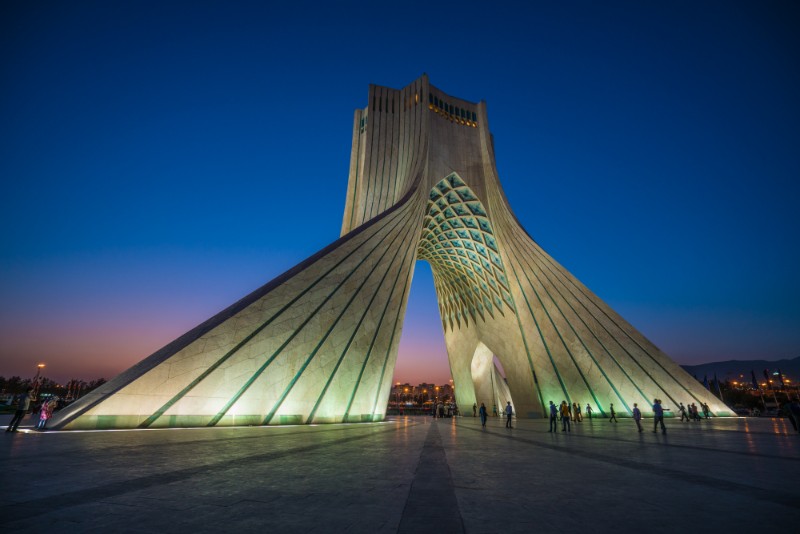
Azadi Tower in Tehran
The visa process is extensive, but worth it in the end
Yes, the visa process is more complicated than in many other countries, but it should not be a deterrent to visiting Iran. Due to the current political environment, Americans are having a tougher time to get their tourist visas approved, but still, it is possible to get them. Thankfully, Intrepid Travel helps you get your visa by guiding you every step of the way with their visa application form.
HERE’S EVERYTHING YOU NEED TO KNOW ABOUT THE VISA SITUATION
Once you get the visa, set foot in the country, and experience everything it has to offer, you’ll see that that the extra process was all worth it.
There’s so much history to be learned and experienced
As the host to one of the oldest civilizations in history, Iran has no lack of ancient ruins and historical sites. Everywhere you go, you’ll be surrounded in hundreds, if not thousands of years of history.
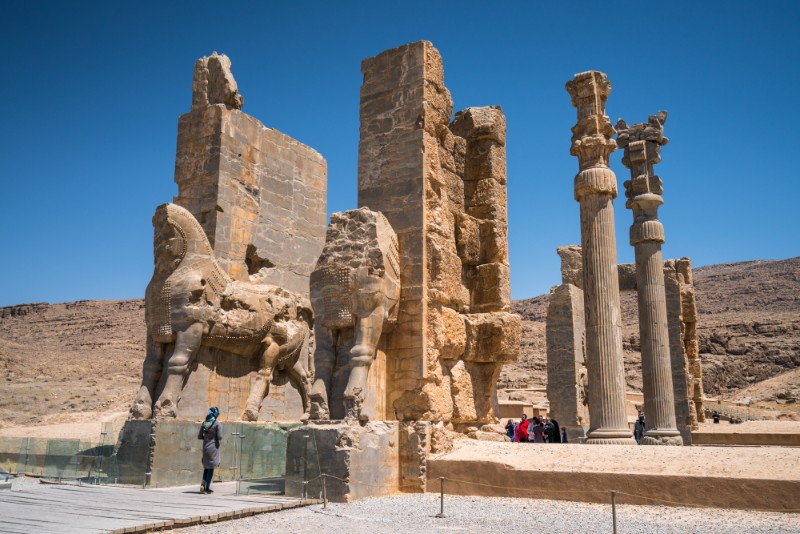
Gate of All Nations in Persepolis
From the Elamite Kingdoms, to the Persian Empire, Alexander the Great’s conquest, the Arab invasion, and even the 1979 revolution, each city you visit will show you a piece of the historical puzzle and how they played a part in the development of Iran as we know it, its neighboring countries, and even the rest of the world.
One of my favorite experiences on this trip was spending a night at the Zein-o-din Caravanserai. A caravanserai is an ancient fortress-like facility used by merchants traveling along the silk road around 450 years ago. They would spend the night there to rest, feed their camels, and trade goods before continuing their journey. Today, this one caravanserai is open for us to spend the night right where merchants used to sleep.
BROWSE INTREPID TRAVEL’S RANGE OF TRIPS TO IRAN
You’ll experience a positive culture shock
I think some of the best travel destinations are the ones that teach you something new through experiences, and Iran has no shortage of that. The level of culture shock in the country is significant, but in a positive way. You’ll see how, despite their current economic and political status, Iranians still welcome you with a smile and the warmest hospitality you could hope for.

You’ll be welcomed with an abundance of food, too!
You’ll see how women are proud of their trendy fashion, how their carpet artistry is among the finest in the world, how the nomadic culture is still alive, how their local markets are the center of activity, and how families gather at parks and squares to picnic at night until well past midnight (it can get too hot to picnic during the day).
You’ll also see how religion is deeply tied to their society and the many intricate details that make their culture unique. You’ll see all kinds of people, from the most conservative to the most liberal, and the beauty of all of them coexisting in one place.
SUBSCRIBE TO INTREPID’S NEWSLETTER FOR TRAVEL TIPS, STORIES, GIVEAWAYS & MORE
It’s good to be ambassadors of our country
As I mentioned previously, locals will talk to you and ask you about life in the US or your country. This is our opportunity to show them who we really are not only as a Western nation but also as humans. There is no better way to learn about a country than by talking firsthand with locals, the people who live and breathe their country every day. They will share with you their proudest moments, their struggles, and their desires.
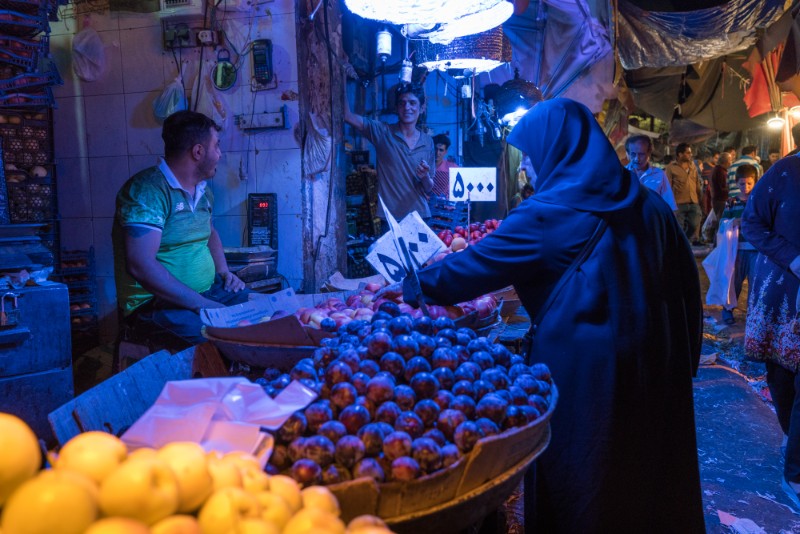
Locals in the vegetable market in Shiraz
Another fear-mongering myth is that Iran is not safe. But again, it is the opposite. Locals aren’t looking to harm, kidnap, or threaten Americans. I never felt in danger, not even when I walked on my own in the city of Esfahan past midnight.
Traveling solo is safe, but as Americans, you will be traveling on a tour (since it is required), so that’s even another safety layer.
TRAVEL STORY: “I’VE CYCLED THROUGH OVER 40 COUNTRIES; HERE’S WHY IRAN STANDS OUT”
There’s no alcohol, pork, and no American/Western chains
For good or for bad, alcohol has been banned in the country since the revolution in 1979. Pork isn’t found either, but this is more because of Islamic customs. American and Western chains are not found in the country due to economic sanctions and the complicated political relationship Iran has had with the Western world for decades now.
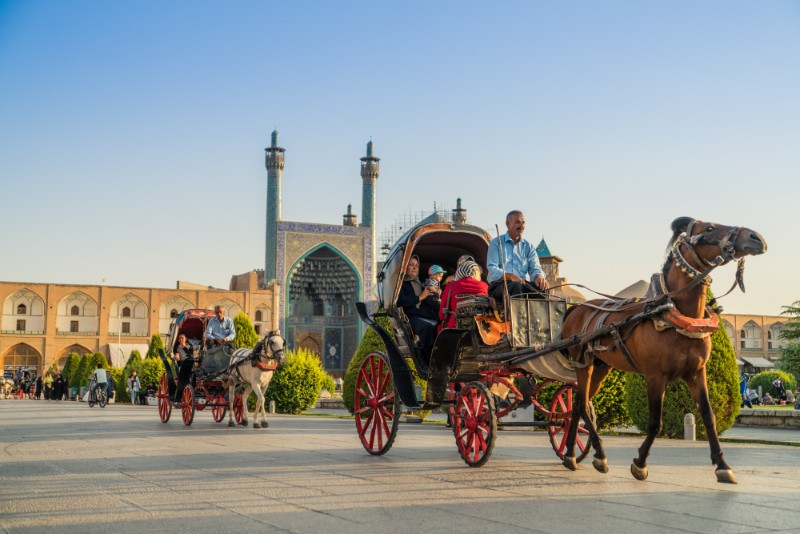
Esfahan – one of Iran’s many unique and compelling destinations
What you will find, though, are knock-off versions of popular fast foods like McFood, a different KFC, Burger Queen, and so on. It’s fun to see how they reinterpret and adopt the Western culture not only on their food but also on their fashion and entertainment too.
There is so much more to be discovered and experienced in Iran and no post will compare to the beauty of seeing it all firsthand. If you are as intrigued by the country as I was before I went there, I’ll tell you, it will impress you and possibly even surpass your expectations. At least, it surpassed mine.
Ready to visit this incredible destination for yourself? Check out Intrepid’s small group tours in Iran.
Further reading
- Travel to Iran: a 2019 visa update for US, UK and Canadian citizens
- Everything you need to know before visiting Iran
- Why you should visit Iran now, more than ever
- 5 unique experiences you shouldn’t miss in Iran
- What to wear in Iran: a packing guide
(All images courtesy of the writer, Norbert, and taken on Intrepid Travel’s Iran Adventure trip.)
Feeling inspired?

Norbert Figueroa
Norbert Figueroa is an architect from Puerto Rico who hit pause on his career in 2011 to travel the world long-term. So far he’s traveled to over 125 countries in hopes of achieving his goal of visiting all 195 UN-recognized countries. You can follow his adventures at globotreks.com and on Facebook and Instagram @globotreks.
You might also like
5 places to escape the crowds in italy..., the 7 best places to go on a..., 10 surprising facts about ethiopia, from delhi to udaipur, here are the five..., galapagos or madagascar which unique destination should be..., travelling to chile here’s the best time to..., 10 reasons to visit samoa, travel globally and think locally with intrepid leader..., follow the leader: tu vu will never stop..., turkey’s most underrated experience: mountain biking in cappadocia, the 10 antarctica questions you want answered.

Borders Of Adventure
Leading Culture and Adventure Travel Blog by Becki Enright. Looking at the world with a different angle to change perceptions of misunderstood places, for the best in travel.
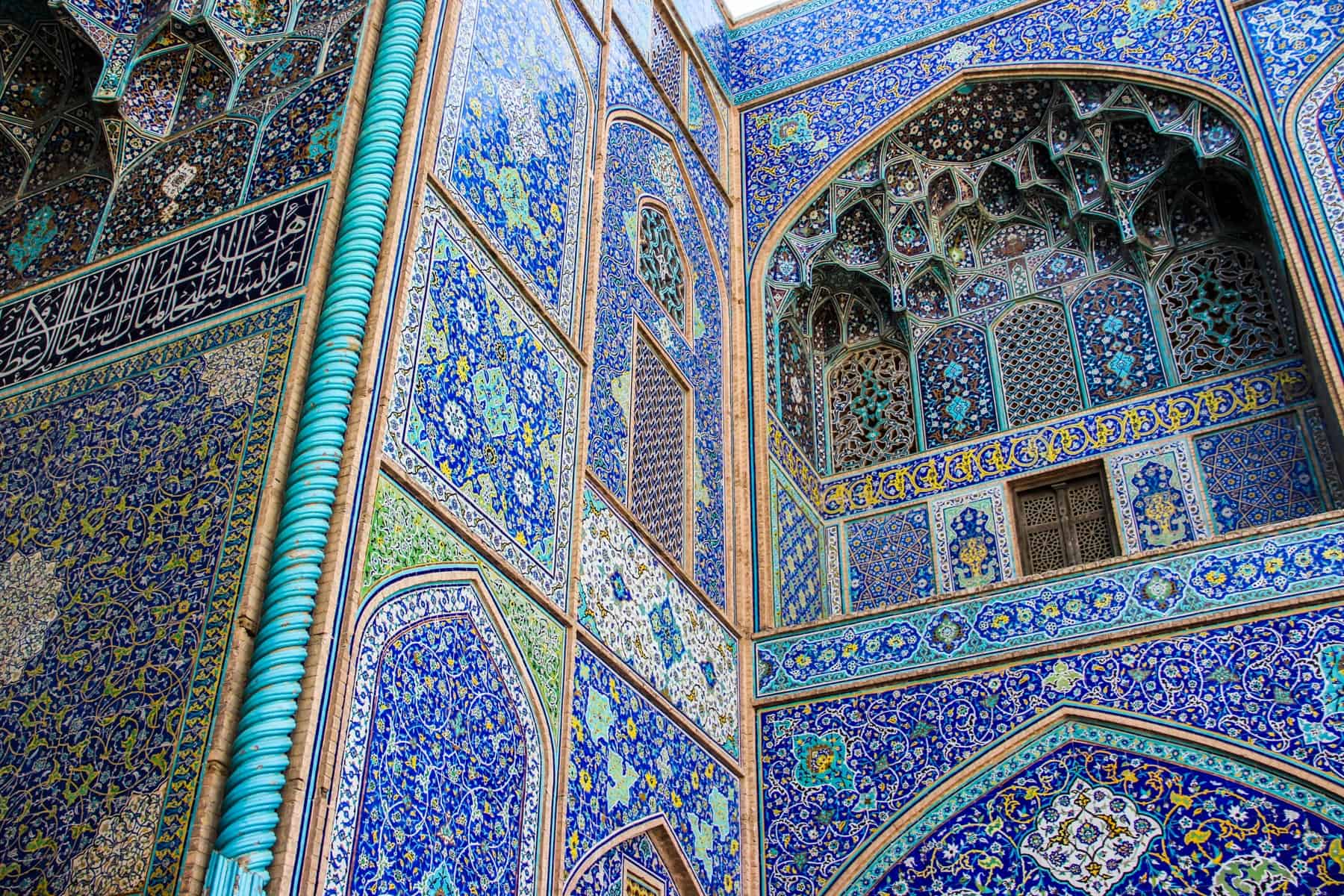
Iran , Misunderstood Destinations
This Is How to Travel to Iran – Everything You Need to Know
Disclaimer: This post contains affiliate links to handpicked partners, including tours, gear and booking sites. If you click through or buy something via one of them, I may receive a small commission. This is at no extra cost to you and allows this site to keep running.
Many travel to Iran to experience the delights of the ancient Persian Empire yet are unaware of the limitations faced by the rules and regulations of what is now the strict Islamic Republic.
As travel warnings persist and diplomatic relations with other countries continue with varying degrees of existence, many are confused about how to go about entering Iran and travelling in Iran safely, efficiently, and within the boundaries set by the current regime.
However, an Iran trip doesn’t have to be difficult at all – tourism is growing as relations develop; hatred of the western world is not as rife as the media likes you to think, and travel in the country is safe. Ancient Persia is within easy grasp, most notably in the central region where key sites have been maintained and the infrastructure linking them is growing, and tourists are not subjected to as heavily enforced rules as the locals.
With enough pre-planning and prior research, you can easily avoid the limitations and stresses of travelling in what is perceived as a closed and tricky country to traverse.
Use this checklist and list of tips for when you visit Iran as a comprehensive guide to help get you started. This Iran travel guide shows you how and is constantly revised with the help of an authorised tour guide on the ground in Tehran, alongside access to regular Iran tourism updates via tourism business partners.
Travel Warning: Due to the volatile security in the region and the recent developments in April 2024, check your government and official advisories before visiting Iran.
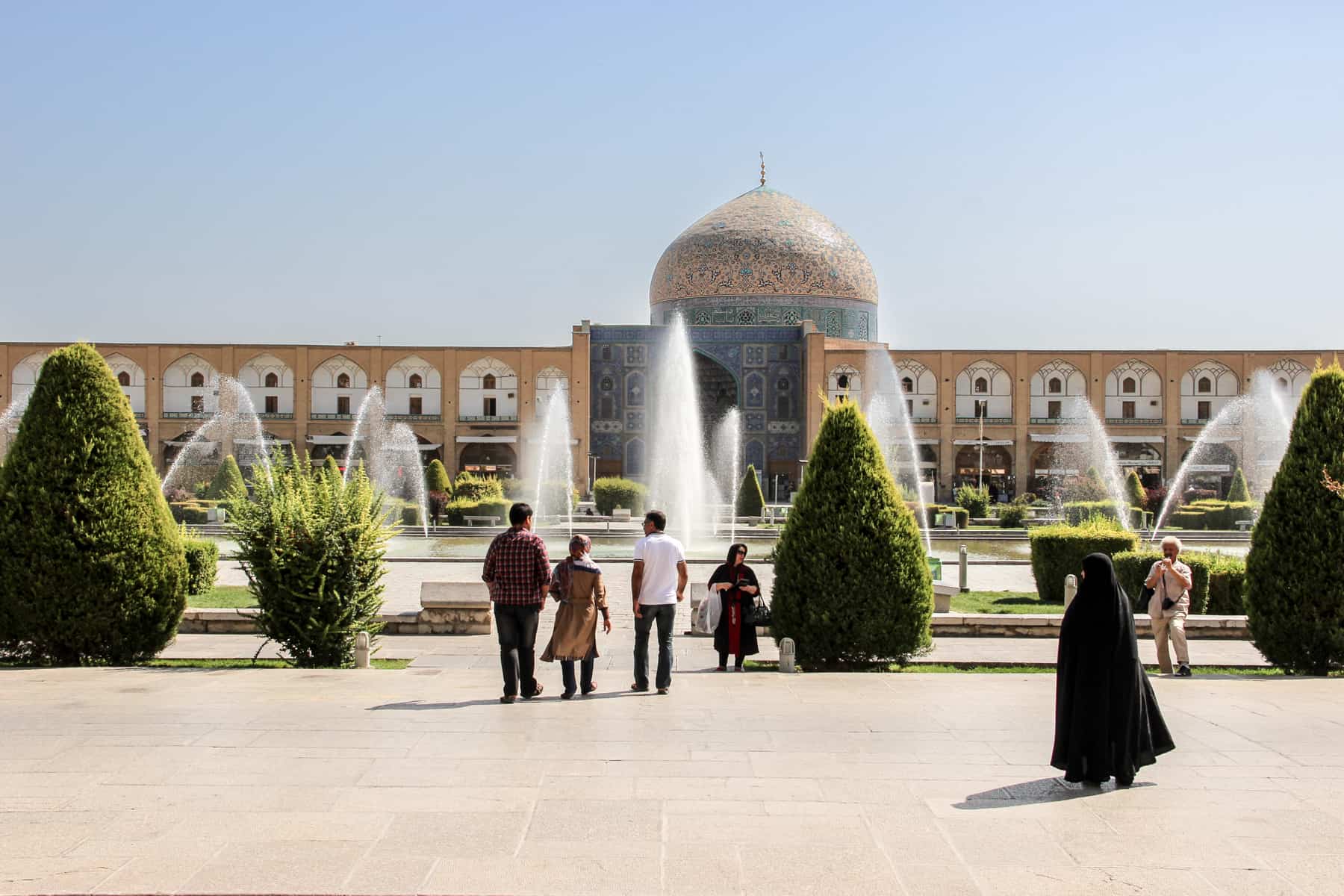
Check Before you Visit Iran
Persia and iran – are they the same, how to get an iran visa on arrival – 180 countries, cost of visas for iran and cost for visa on arrival in iran, you must have travel insurance for an iran visa application, iran tourist visa and authorisation code costs, iran visa timings with authorisation code, proof of travel to israel, current diplomatic relations, nationality restrictions – americans traveling to iran, nationality restrictions – british and canadians travelling to iran, nationality restrictions – israelis travelling to iran, booking the best iran tour, private guided tours of iran, travelling independently in iran, couchsurfing in iran, solo female travel in iran, when is the best time to visit iran, unesco world heritage sites in iran, what should i pack for iran, you are safe in iran, and iranian people are very welcoming, is it safe to travel to iran right now, rules in iran, is iran an arab country, currency in iran – two names, one currency, credit and debit cards in iran, inner-city transport, intercity transport, separate men’s and women’s carriages on iran public transport, pre-register with your country’s foreign office, which sim cards to use in iran, which vpn to use in iran, finding traditional food amongst the fast food, drinking in iran, etiquette in iran, understand the concept of ‘persian time’, read more on the history of iran and iran travel, want to travel iran – pin it.
Inbound bookings for Iran usually change when something has severed particular diplomatic ties, which then reverberates to tourism apprehension and a halt to tourism altogether. Always check the news and the political landscape before travelling to Iran to see if you (and your nationality/country) are affected by visas and entry to Iran. It’s always a matter of time and patiently waiting to see how the political landscape plays out following these events. Here are some of the more recent ones.
On 3rd January 2020, it was announced that the Iranian Major-General Qasem Soleimani was killed in a US airstrike, with Iran calling for ‘severe revenge’. While the outcome is not yet known, this does ignite fears of a conflict in the Middle East , and it pays to be more aware of travel warnings at this time. American citizens, in particular, may face more restrictions.
Following the Ukrainian Airlines plane crash near Tehran, several flights routes to Iran have been cancelled following the news that the Ukrainian jet was ‘unintentionally’ shot down . If you have any Iran travel planned, check your airline to see if the service is still running.
The arrest of the UK Ambassador to Iran in Tehran as part of government protests have further sparked an international row between the two countries. UK travellers should be on alert for developments.
Both Iran and Persia are used interchangeably about the country and also while you are on the ground. Reference to Persia is more so in the context of the history and legacy of the ancient kingdom of the Persian Empire; Iran is about the modern-day Islamic Republic of Iran in the Middle East.
READ MORE: Best Places to Visit in Iran to See Ancient Persia
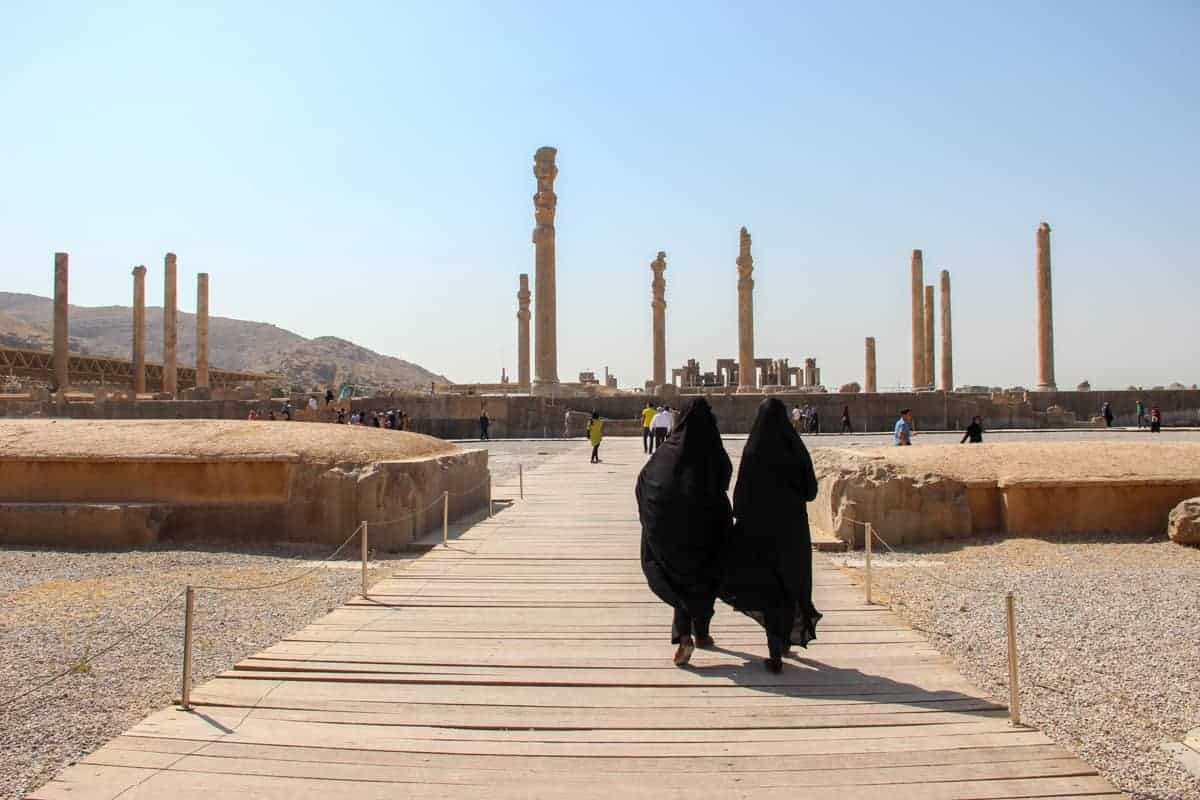
You’ll stumble between modern-day cities and the sights of ancient Persia, like the Persepolis, on any Iran trip.
Can Everyone Travel to Iran? Iran Visas and Authorisation Codes
Getting a visa for Iran is quite possibly the most stressful and challenging part of your entire trip. You first need to know if you are eligible and what limitations you may face.
For countries like the UK, which have strained and little to no diplomatic relations with Iran, you may find that you cannot even get an Iran visa in your country because there is no Iranian embassy. British travel to Iran means a little more legwork, where you may also have to travel elsewhere, like Dublin or Paris for example, to obtain the visa since there is no Iran embassy in the UK.
Most airlines flying to Iran will not allow you on a flight unless you show you have an Iran visa, but you can get a visa on arrival. However, sanctions have been lifted, most notably in 2016, with up to 900 Iran visas daily on average granted on arrival, according to the Office of Foreign Affairs. Tourism numbers annually have increased year on year, with 5.2 million foreign visitors entering Iran in 2015, in comparison to 4.7 million in 2013.
On the 14th February 2016, the Ministry of Iran announced that airports could issue 30-day visas for Iran, for nationals of 180 countries.
Non-eligible nationalities for Iran Visa On Arrival:
Afghanistan, Bangladesh, Canada, Colombia, India, Iraq, Jordan, Pakistan, Somalia, USA, UK
A 30-day Tourist Visa Upon Arrival, for those of eligible nationality , can be obtained at the following Iran airports:
IKA: Tehran Imam Khomeini Airport THR: Tehran Mehrabad Airport MHD: Mashad Airport SYZ: Shiraz Airport TBZ: Tabriz Airport ISF: Isfahan Airport
Follow the signs that say ‘Visa on Arrival’ where you will be asked questions about your trip to Iran and asked to present:
- Details about your confirmed first night’s accommodation in Iran, including the address and phone number (you may also be asked about your travel plans on-going).
- Proof of a confirmed return flight ticket.
- A copy of your travel insurance policy document and policy number.
- Those people I met who were granted an Iran tourist visa on arrival as part of the tour were given a special letter from the company that they could present to both the airline and passport control on arrival.
You can be waiting up to 30 minutes before your visa is granted and you can proceed to immigration. You will need:
- A passport with at least six months validity
- Two passport photos, in which women should be wearing a headscarf
- The completed visa form. You can also fill out the form online before arrival in Iran, from which you will receive a visa application reference number, print it off and take it with you.
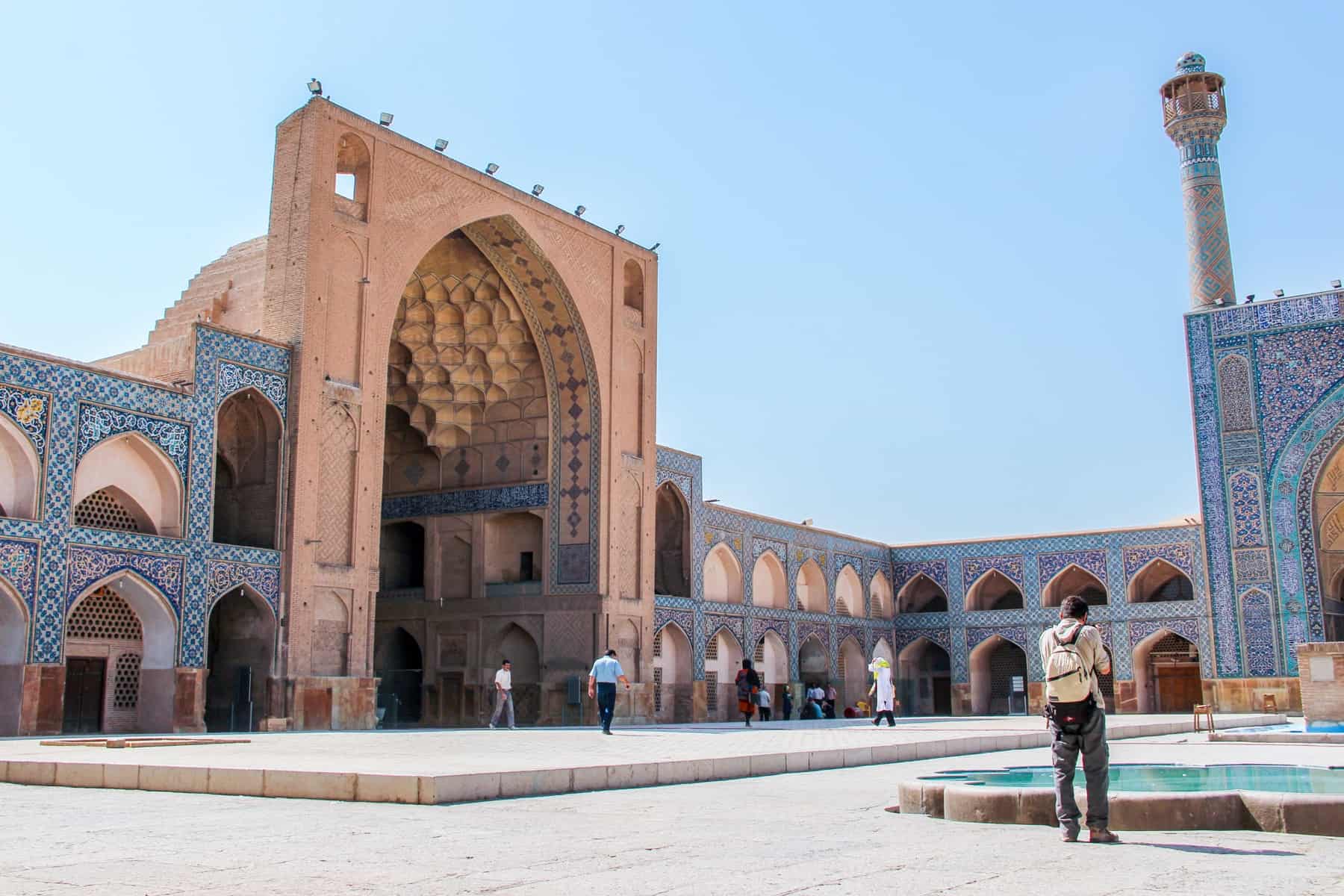
One of the many beautiful places in Iran to visit – The UNESCO World Heritage site of The Great Mosque (Masjid-e Jameh) of Isfahan.
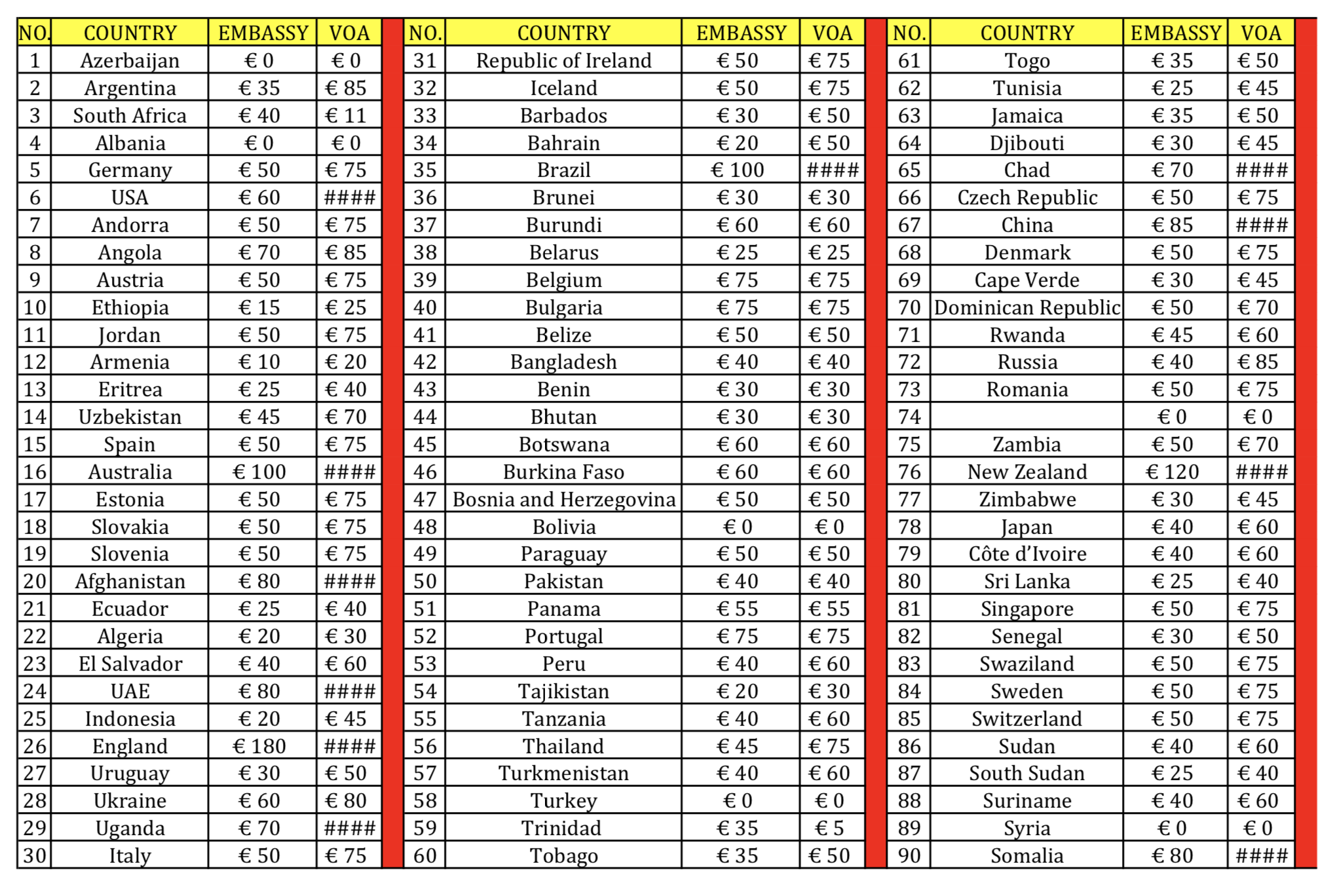
The costs for a visa in Iran and visa on arrival in Iran – each country is different.
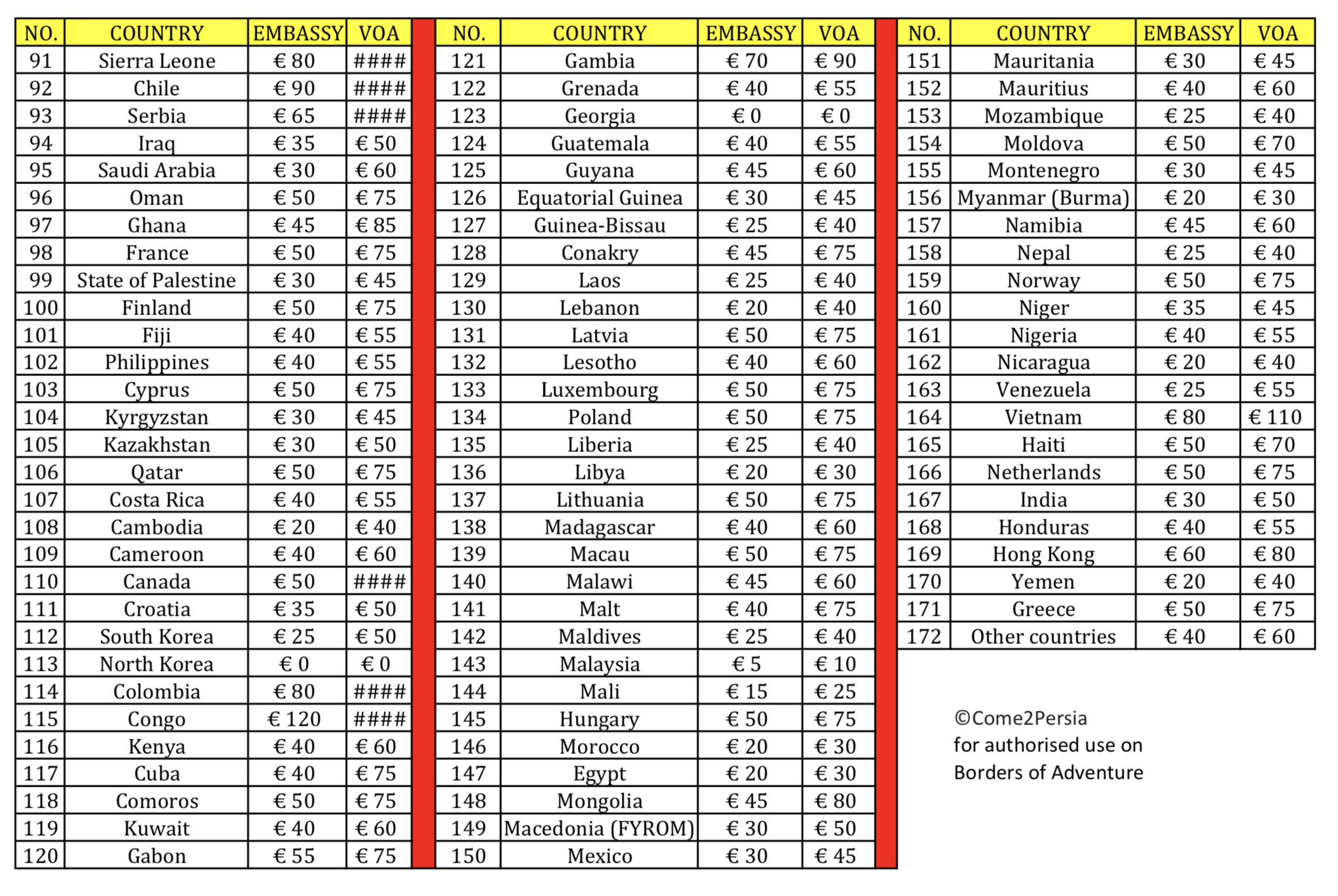
Iran Travel insurance is a requirement to obtain your visa for Iran. Without proof of purchase and printed documentation, you cannot pick up your visa from the embassy or secure your visa on arrival at the airport.
Aside from it being a stupid idea not to have travel insurance coverage, check that your current policy (or the one you are thinking of getting) covers Iran. Some do not provide travel insurance for Iran or only cover limited regions of the country and activities.
Getting Your Iran Authorisation Code – Non-Eligible Nationalities
For those not eligible for a visa on arrival, and those wanting to apply for a visa for peace of mind before they arrive, you have to apply for an Authorisation Code. EVERYONE has to have one of these, which will determine if you are granted an application for a visa.
- For those who HAVE to travel in a group (see below), this code will generally be processed by your tour company.
- For everyone else, you can use 1stQuest which offers essential travel services for Iran travel. Otherwise, source an Iranian travel agency local to you at the time of planning or seek direction from the embassy you wish to get a visa from about where to apply for it.
- When applying for the authorisation code, you will need to specify which embassy you will be processing your visa at – a pain for those travelling around with no solid plans. Once the code is released, you cannot change the embassy choice. It’s wise to choose an embassy in a city you are likely to fly to Iran from (see also timings below).
Authorisation codes (if not booking with tour) come with an administration cost of around 35 Euro, which is dependent on the agency you are working with. There is no set price for an Iran Tourist Visa since it is determined by nationality and where you process your visa.
I paid €180 for mine in Tbilisi, Georgia and a British guy on my tour paid a little more to process his in Paris. The Australians in my tour group paid differing amounts between €50-€100, as did the Germans. There’s no hard and fast rule – it’s more about luck.
If all that wasn’t enough, it is highly likely that
1. Your authorisation code will take WEEKS to process
2. It will most likely arrive with only a matter of DAYS to spare before your planned arrival in Iran or tour start date.
This means that before any trip to Iran, especially when travelling on a tour, you will be rushing to the embassy in the hope of getting your authorisation code for Iran processed quickly. You may have to pay extra for fast-tracking and organise your flight ticket to Iran very last minute. This doesn’t always guarantee the best price and the idea of getting a cheap ticket to Iran has to be pushed aside.
DON’T book your flights to Iran or any travel arrangements until you know your Iran visa will be processed. Many people travel to Turkey beforehand to process their visas and fly to Iran from there, using the country as a cost-effective flight or train route for entry.
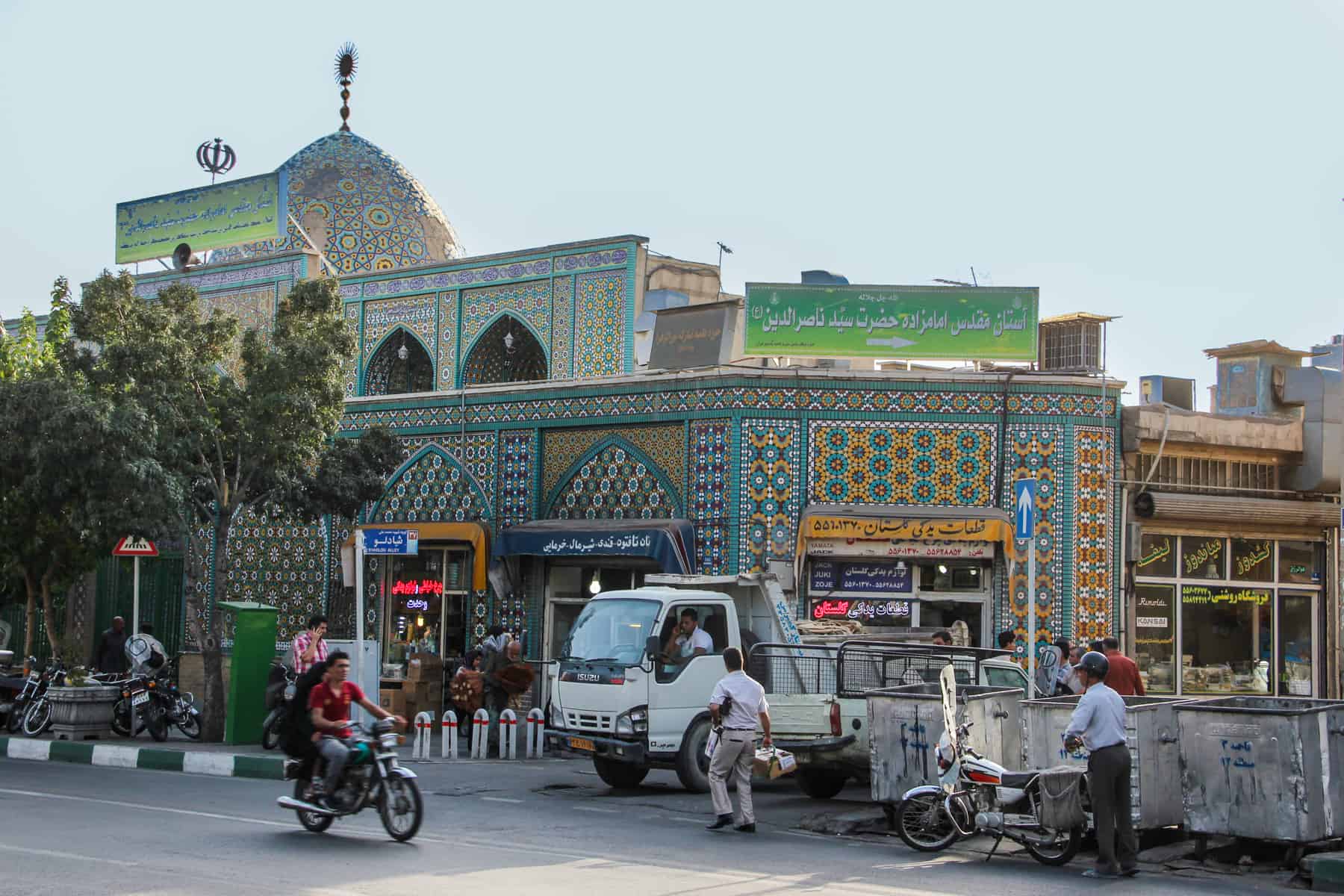
Everybody needs to get an Authorisation Code before travelling in Iran.
Refusal of Entry to Iran
The main reason for Iranian visa refusal is when there is proof you have travelled to Israel and the government’s paranoia based on your career (think journalists, media workers and similar).
Iran tourism issues are not linear, and while anything can happen at any time that would affect a particular nationality entry, the majority of the problems are political-based and beyond our control. Diplomatic relations and any political actions for/against Iran based on historical or current affairs at the time of applying may affect your refusal of entry into the country, or an Iran travel ban put in place.
On 4th January 2020, it was announced that the Iranian Major-General Qasem Soleimani was killed in a US airstrike, with Iran calling for ‘severe revenge’. While the outcome is not yet known, this does ignite fears of a conflict in the Middle East , and it pays to be more aware of travel warnings at this time.
On 6th October 2019, it was reported that the two Australians imprisoned in Iran for flying a drone were freed in a political swap. It is suggested that strained relations between the UK and Iran after Britain seized an Iranian oil tanker in Gibraltar are inciting such political moves to detain people breaking the rules.
On 29th August 2018, France informed diplomats to postpone all but non-essential travel to Iran after a foiled bomb plot near Paris. The following day, Iran dismissed such restrictions , proving that it is best to stay aware of any sudden changes.
Solo Travel in Iran vs Tours in Iran
One of the biggest questions I hear is: Can US citizens / Americans travel to Iran? They absolutely can, but because of the long-standing history of coups, espionage, nuclear sanctions and everything else in between (outside of the control of the average American citizen unconnected to the historical actions of their government), all US passport holders are only allowed into Iran if part of Iran tour packages (or with a tour guide).
Despite restrictions, it is safe for Americans to travel to Iran, so don’t be put off by the bureaucracy needed to get there. US travel tips to Iran focus on this red tape. For example, it still stands that Americans must also be escorted from the airport to the hotel, and cannot make their arrangements. This all has to be pre-organised pick-up (a simple addition via the tour company) so do check this before you leave.
READ MORE: Inside The Den of Espionage – Former US Embassy in Tehran Turned Museum
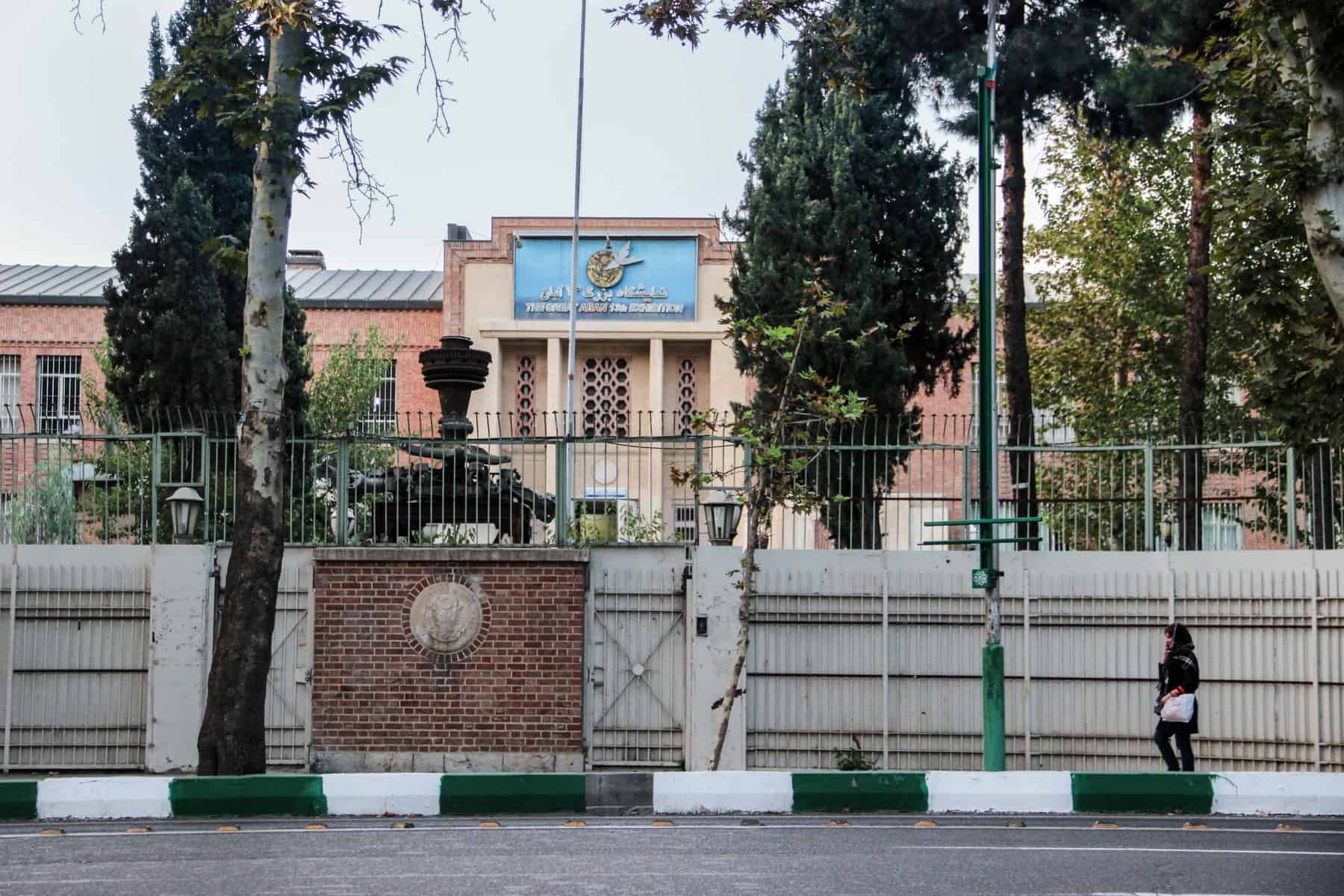
The former US Embassy in Tehran, Iran
As of February 2014, British and Canadian citizens going to Iran became subjected to the same ‘tour only’ sanction (official Iran tour operator or private Iran guide). As a result, your visa is usually only granted for the exact number of days of your tour, with a couple of days on either side if you list this as part of the arrival and departure options.
British passports holders should also pay attention to Foreign Office updates following strained relations between the two countries after the oil tanker seizure, as listed above in ‘Current Diplomatic Relations’.
Unfortunately, Israeli citizens cannot enter Iran at all, and this is unlikely to change anytime soon.
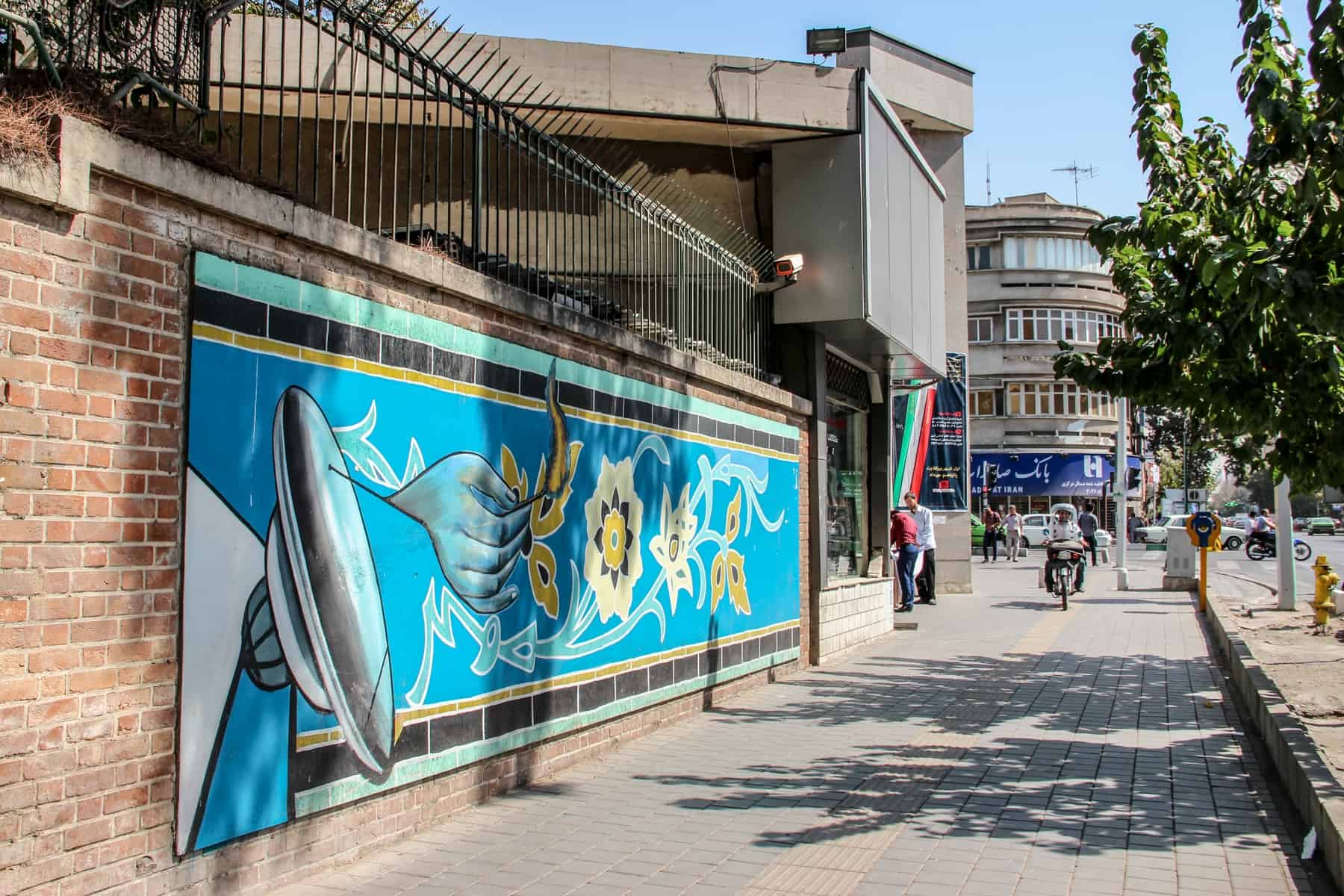
Check on any nationality restrictions before you visit Iran. It may mean having to join a tour and hire a guide.
While those booking up Iran holidays might choose a tour package for the fact that everything is taken care of on the ground and for ease of travel, I had no choice since I had a British passport.
There’s an overwhelming amount of Iran tour packages, and it can often be hard to know where to start. At the time, I travelled with G Adventures on a Discover Persia tour which operated through the revered Iranian agency AITO. I allowed myself free time to visit Tehran on either side of my trip, so I had a taste of both worlds, albeit on a small scale. Currently this trip is not running.
The upside to a tour, however nomadic and sporadic you usually are, is that these trips pack a real punch in getting you to many sites in 14 days. On the G Adventures Iran tour, I saw places I would not have been able to access easily on my own or with public transport. Plus, my local guide to Iran was the bundle of knowledge that a history and sociology geek like me needed for an ancient civilisation such as Persia. The downside of such holidays in Iran is a lack of free time and lazy resting for an itinerary that would normally, on my terms, take about three weeks, not two.
Being in a tour group when visiting Iran does not mean being chaperoned and watched 24-7. ven while on a small group tour, we were allowed time to ourselves in each destination.
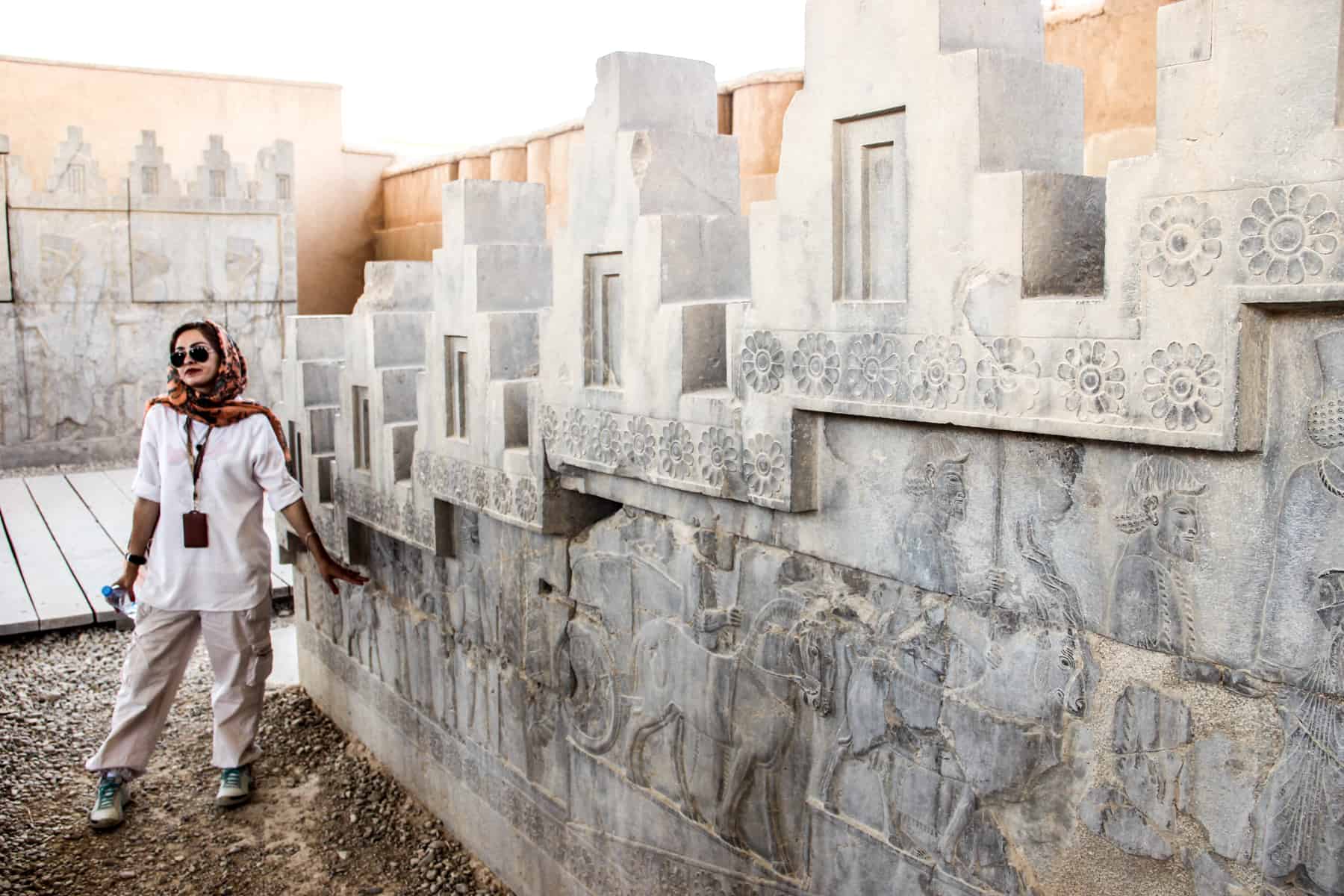
Choosing between and small group tour and a private guide – with a local who will show you all the historical places in Iran.
Generally, under the condition that you must have two people minimum, hiring a private tour guide in Iran is also an option. This is a viable option for those with visa restrictions who do not want to travel in slightly larger groups.
Come2Persia is a certified and reliable Iran travel agency run by a trusted Iranian friend of mine, Ali Reza Nokhostin, who I met and travelled with when in Georgia. He is both passionate about showing off his country and in changing perceptions of Iran. Specialising in incoming tours to Iran, Come2Persia also provides other travel services needed to complete the private tour package, including hotel bookings, visa application, transportation and access to various guides, not just Ali.
Note that while solo / independent travel is moderately easy in Iran (if of a free nationality), Iran is not that well-trodden on the independent travel path. There’s little to no hostels and guesthouses, and a dominance of big, expensive hotels (especially in Tehran) and even then it is rare to stumble upon a bunch of solo travellers to join.
However, solo travel in Iran is happening, and it is safe, it’s just a little more challenging than usual, which can, in itself, be pretty exhilarating.
Note that Couchsurfing in Iran is officially illegal, but it happens anyway. Nearly all independent travellers I have spoken to have mentioned that they have travelled here via this resource with your local hosts, of course, being the best guides. However, travellers looking to Couchsurf in Iran must be aware that they can not hold the Couchsurfing host responsible if anything goes wrong because there is no official ‘filter’ in place when it comes to the hosts listed online.
In a society where women are much more restricted than their male counterparts, to travel Iran as a solo female is a little harder and viewed with surprise/suspicion depending on where you go.
Also in Iran, since public displays of affection between males and females are not allowed, any harassment or inappropriate contact by an Iranian male to a female traveller would be frowned upon and draw attention.
Iran is one of the safest countries in the world based on tourists’ feedback. There have been many solo female travellers who have experienced Iranian hospitality and kindness.
However, it is vital to bear in mind that Iran is an Islamic country with traditional values and of course, some types of outfits would send the wrong message, especially in smaller and more conservative cities, such as Yazd, Kashan and Qom.
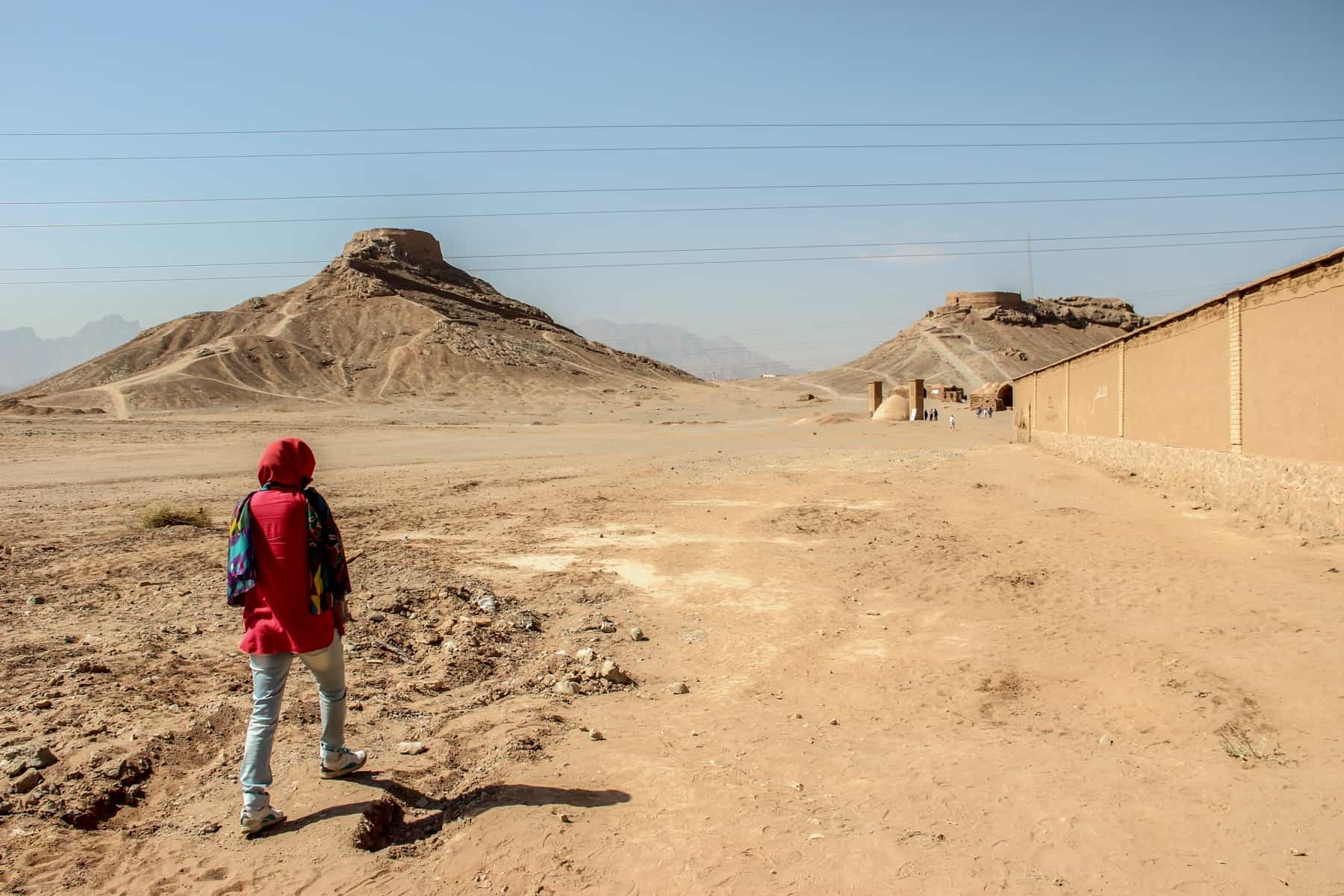
Solo female travel in Iran is safe, but with awareness of the conservative values of this Islamic country.
Iran is a four-season country, which means in different corners of the country, you can experience various climates at the same time. So, when is the best time to go to Iran, based on the different climates in the country? As a quick guide to Iran and its geographical mix, we can divide the country into three regions:
- From early March until late May
- From early September until late November
- There is one high season, from mid-April until mid-November
- Only one high season, from late November until late March
In between the high seasons from July to September is marked by high temperatures rendering travel on the classic route potentially uncomfortable.
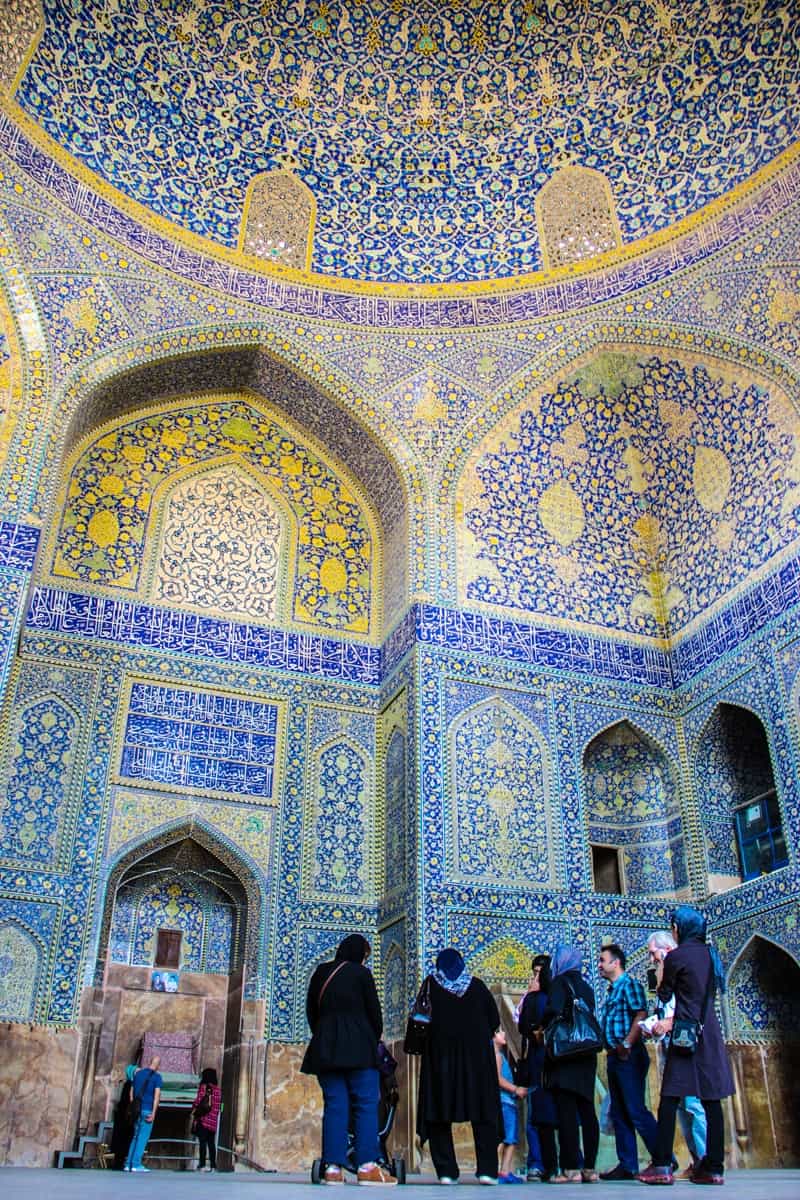
The stunning Sheikh Lotfollah Mosque is Isfahan is one of the must-see sites.
Iranians love to shout about the abundance of UNESCO World Heritage Sites. As my local friend stated, “It gives Iranians a lot of pride to possess such ancient lineage”.
Iran has 24 UNESCO World Heritage Sites – 22 cultural and two natural. Each of which is the result of years of investigation and presentation of evidence as to why they should be regarded as world heritage sites. It would take more than one trip to traverse them all.
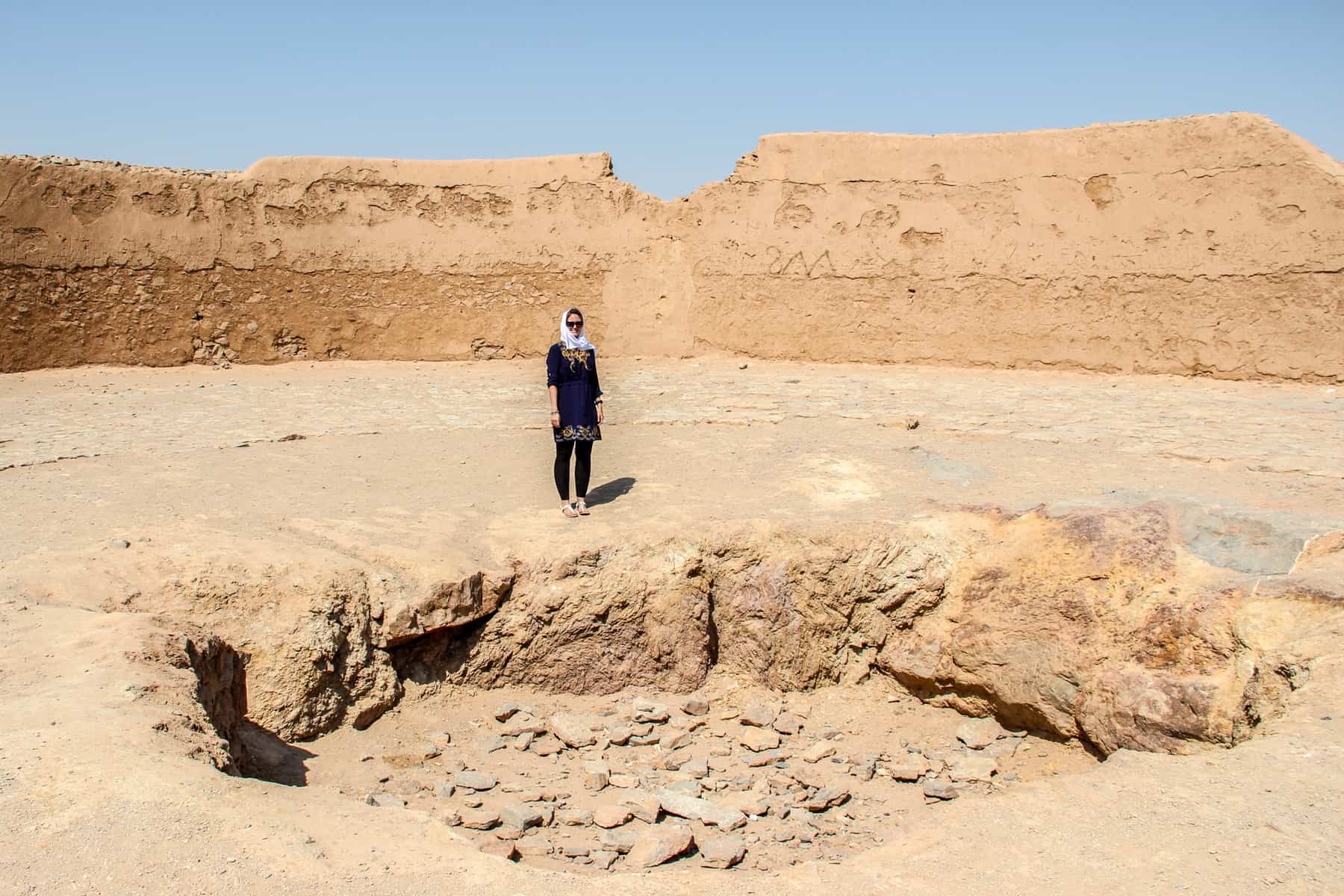
The Zoroastrian Towers of Silence in Yazd – one of the 24 UNESCO World Heritage Sites in Iran.
Dress Code in Iran – Headscarves and Hijabs
Iran does have a strict dress code, and this is one of the biggest concerns for female travellers to Iran. Most importantly – PACK A HEADSCARF IN YOUR HAND LUGGAGE. It’s called ‘Roosari’ in Farsi, and you MUST be wearing it the moment you exit the plane and are officially in Iran.
You must wear a headscarf the entire time you are in Iran (except when in your hotel room), as well as loose clothing that covers your body. But let’s get one thing straight – you don’t have to wear a burka or anything that completely hides you.
When you arrive, you will soon see that reality is far removed from the stereotype. Iranian women are super stylish and proud of their appearance – fashion being a means to stand out and make a statement.
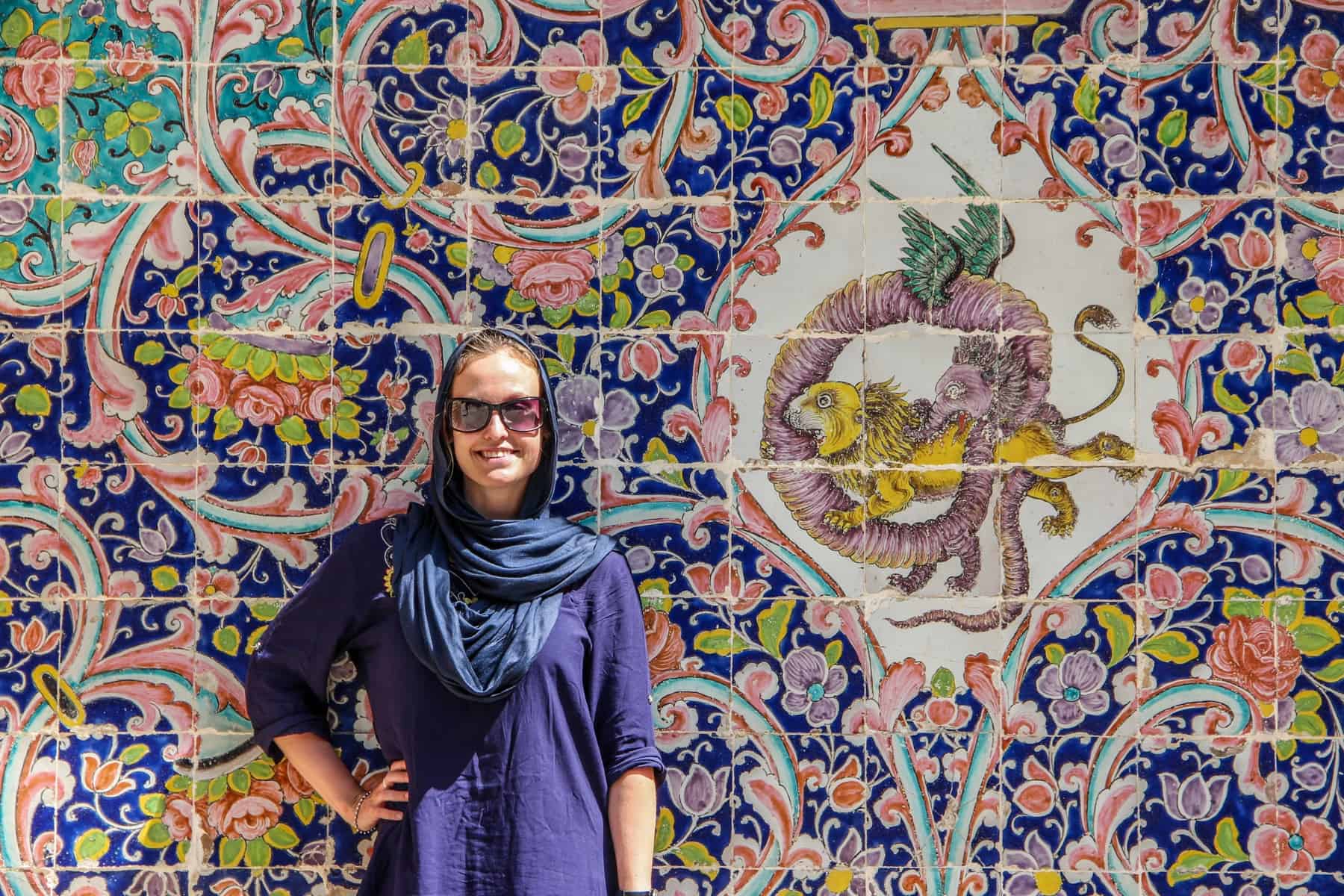
The dress code for women in Iran doesn’t have to be complicated.
The ‘Morality Police’ you hear of do exist in Iran but are not spending their time chasing down foreign visitors, so do not worry too much with that. If anything, you will get a polite mention. Visitors have a bit more flexibility when it comes to the rules.
- A headscarf is the most immediate essential item, and you can buy more when you are there) . If your headscarf falls, don’t worry – quickly put it back on again. You won’t be in trouble for this, but pay attention at all times. Wearing your hair in a high bun or ponytail helps keep the scarf in place. Many Iranian women wear it a little loose and halfway back on their head, since showing a little hair is granted.
- Tops must be loose-fitting, and three-quarter length sleeves are ok – a little more comfortable in the heat. The general rule of thumb is that the body should be covered and arms should not be bare.
- It is said that trousers must be baggy, but some local women wear tight, brightly coloured leggings. As long as your legs are covered down to the ankles, it is fine. For tourists, leggings worn with a long, loose-fitting top are acceptable. However, in the more conservative areas such as Isfahan, Mashad and Qum, respect the values and revert to looser fitting trousers.
- Colour of clothing. It’s a myth that you need to dress in dark colours or black tunics. Embrace fashion the ways the locals do and bring some colour into your Iran packing list!
- Open toes sandals are OK. Pack some sports shoes for longer day trips where you might be walking a lot (such as at the Persepolis). You’ll soon see how sports shoes are fashionable in Iran, especially in bright colours!
- Worried you do not have enough appropriate attire? Fear not, as soon as you arrive in Tehran or even Shiraz (if you fly into the city), hit the bazaars and the local markets . There’s plenty to be sought out. Other people on my trip stuck with two outfits and alternately hand-washed them every night.
- Strict dress codes do not apply in the same manner when travelling with children . Young boys can wear shorts and t-shirts and girls under ten are not required to wear a headscarf.
For men it’s more straightforward – you will be dressing much the same as you do in western countries, except no short shorts, no super short sleeves and no extreme tight-fitting clothing.
READ MORE: Iran Dress Code for Women (What to Wear in Iran)
Is Iran Safe? Is it Safe to Travel to Iran?
Iran’s image of being a terrorist-driven, American bashing, nuclear weapon holding, burka-clad society is something that has been highly driven mainly by western media. “Is Iran safe?” “Isn’t it dangerous in Iran?” are likely to be some of the first questions you encounter from others when you announce you are travelling here.
In short: Iran is a safe place to visit.
Since the election of the more moderate President, Hassan Rouhani in August 2013 and his re-election in 2017 , both international relations and internal rules have become less severe and slightly more open. It won’t take long before Iranians give you a warm welcome, ask where you are from or even invite you to dinner or tea.
It is a part of Iranian culture to go out of their way to help you, and it’s not uncommon to be given a phone number on a piece of paper or a business card in case you need to call upon someone.
The people of Iran are just as keen to show you they are the opposite of how they are portrayed, just as you should be teaching them that the western world doesn’t hate them.
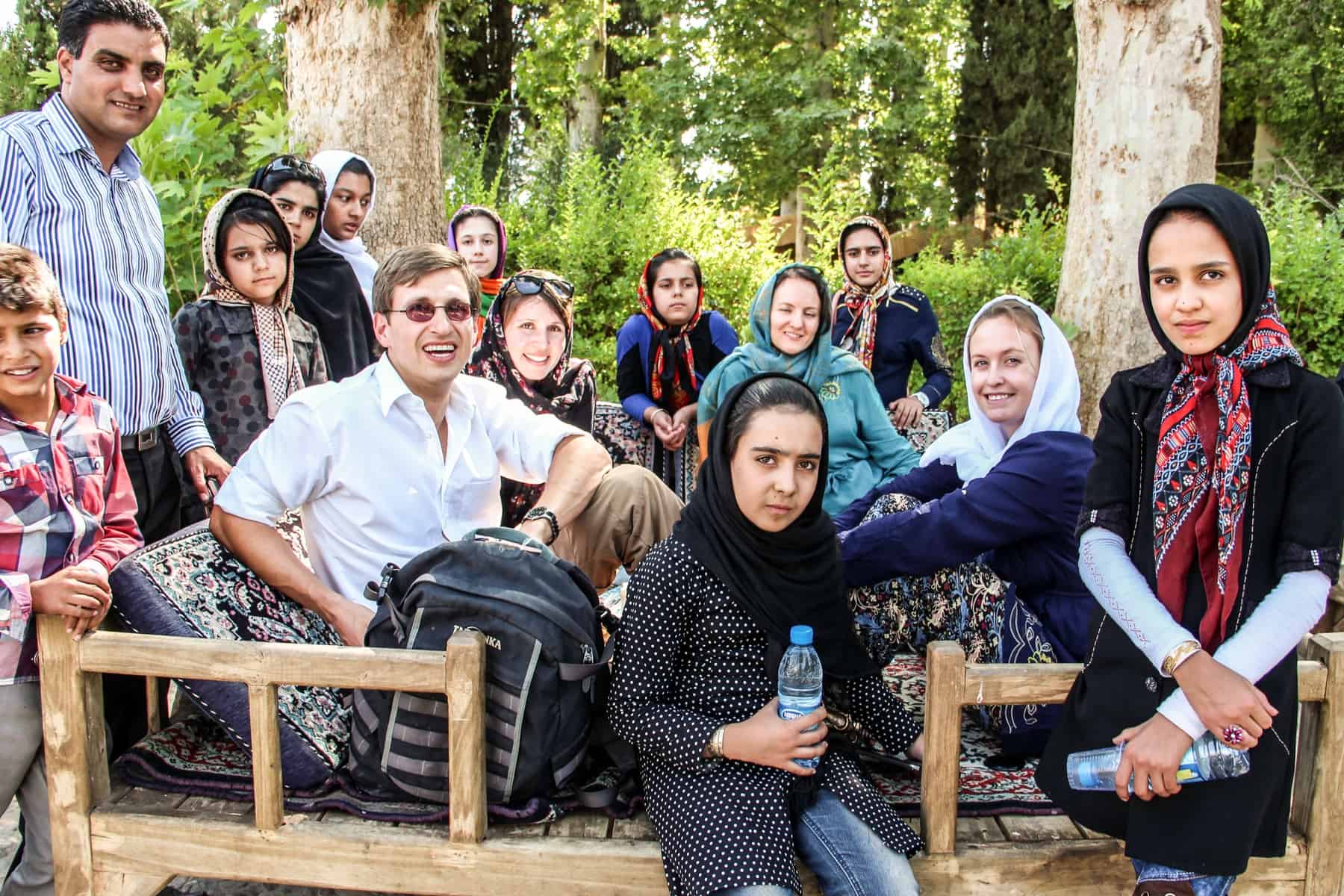
Is it safe to travel in Iran? Absoluely. Locals are very welcoming.
There’s never a right time for those who are worried, anxious or scared. Of course, you need to keep up to date with any significant political changes and your country’s diplomatic ties, but avoid listening to the hive of scaremongering out there and those who say don’t travel in Iran.
For example, in June 2018, there were protests about the economic situation in Iran, and these took place inside and around the Grand Bazaar in Tehran. It means being aware of any internal demonstrations and staying away from those areas, as you would in any country.
Iran remains as one of the most stable countries in the Middle East. While breaking the rules of Islamic society (including drinking alcohol, taking drugs and engaging in sexual activity with locals) can result in deportation, arrest or worse, general travel here is entirely safe.
Don’t assume you can break any rules in Iran, play the dumb tourist and get away with it. Iran is a Muslim country where Islamic law is strictly enforced.
An example of harsh punishment is with the case of the two Australians imprisoned in Iran for illegally flying a drone near a military installation, freed in October 2019, but as part of a political swap. It might seem that the punishment doesn’t fit the crime, but what is justified in your country can have harsher consequences elsewhere.
This is an Islamic State with a strict system, and if you can’t play by Iran rules, don’t go.
Given the location of Iran in the Middle East, the Muslim religion and some similarities in culture and language, the scaremongering of Iran can often revolve around the ‘it’s Arab’ misconception.
Iran is not an Arab country. Iranians are not Arabs. The language spoken is Persian (also known as Farsi) and not Arabic (although there are many languages spoken within Iran including Kurdish and forms of Turkish, Indo-European languages and Khuzi Arabic for example, due to the many ethnic groups that exist within the country).
Not only is the Arab misconception a source of contention generally, but Persians can take offence at these preconceived ideas.
Take US Dollars or Euros with you to Iran and change them up into Iranian Rial at the local exchange offices (not the dodgy guys on the street or at the hotels which have the lower government exchange rate). Before you know it, you have millions of Rials, and it all looks easy.
However, while ALL notes state ‘Rial’ there is another ‘currency’ or ‘super unit’ that is used – Toman – which is not listed on any note or coin.
Toman is used by locals and is one-tenth of the Rial total. 1 Toman = 10 Rial.
When I was first presented with a dinner bill of “37,000”, I was quietly happy that my food had cost the equivalent of $1.5, but this was, in fact, the price in Toman.
To convert to Rial, you simply add a zero – therefore my dinner was 370,000 Rial.
Lost? It takes a couple of days to get used to, but in the majority of cases, unless stated clearly, all prices are in Toman and not Rial. Hence, the basic equation anywhere in Iran is to add a zero onto printed prices (if ‘Rial’ is not listed), or ask market vendors and others which ‘currency’ they are operating in to save the confusion.
A big question is if you can use your credit or debit card in Iran. Sadly not, since there is no network in Iran for the use of international cards. It’s always been the best option to carry enough cash with you for your trip to convert to Iranian Rial on the ground.
However, there is now an Iranian prepaid debit card for tourists and temporary visitors called the Mah Card. Like most travel cards, you can instantly add funds to your card in your preferred or home currency, and it will convert it to Iranian Rial. It is more convenient than carrying cash, protects you from unauthorised purchases and is accepted country-wide.
To get 40% off the price of a Mah Card (Full price €19) enter BECKI at the checkout.
Public Transport in Iran – Options, Usage and Cost
When traveling in Iran, you have various options for public transport:
Intercity transport:
Private car
- Domestic flight
The Metro is available in several cities in Iran, mainly in Tehran; alongside Shiraz, Tabriz, Mashhad and Isfahan. It is the best option to get around in Tehran, and the stations are also easily accessible by taxi and buses. The ticket price for one trip is 1000 Tomans (approximately 25 cents). You can also buy a card to pay for the metro trips and even the buses in Tehran. The rush hours are mainly 7-9 a.m. and 5-7 p.m.
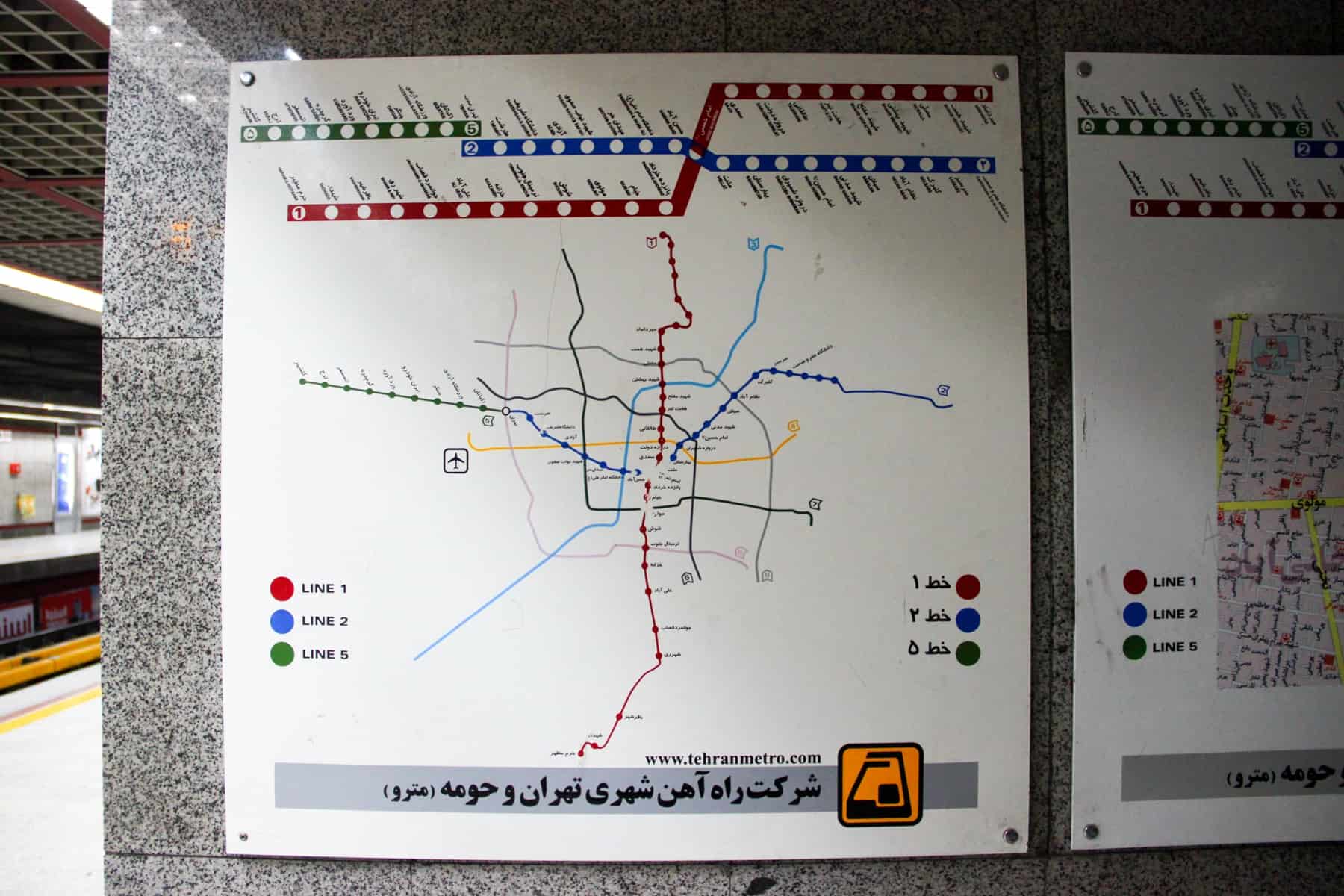
Tehran metro map and the three lines that cover the city.
You can find buses in every corner of the country. There are two main types of buses in big cities: regular and BRT. BRT buses are red, and because they have designated stations and paths, they are express buses. You can pay for the buses by your Metro card, and the fares would vary between 500 to 1000 Tomans (12 to 25 cents) per trip. You can find all the bus and BRT stations on Google Maps.
There are different types of taxis inside the cities:
- Shuttle/shared taxis (khatti): It is a way cheaper way to get around the cities. The two downsides are that they are for fixed destinations and you will have to wait for the taxi to be filled. The fares are also fixed, and you cannot negotiate.
- Private taxis (darbast): You can easily hail a taxi and say ‘darbast’. It means the driver will not pick any other passengers up and you must negotiate the price before getting on.
- Non-registered taxis (shakhsi): These are non-taxi drivers who you would easily spot from the yellow and green cabs. These are people who try to earn some money by giving people a ride. Again you must negotiate the price before getting on.
- Uber-like apps: Tap30 and Snapp are the two leading apps that you can easily use on your phone. Unfortunately, they’re not available on App Store and Google Play, but you can ask a local to help you with downloading them on your phone. Tap30 is available in many cities including Tehran, Karaj, Isfahan, Shiraz, Tabriz and Mashhad. Snapp is available in the same cities and also in Ahwaz and Qom.
- Bisim Taxi: You can also call the numbers 133, 1828 and 1833 in major cities in Iran to call a taxi wherever you are.
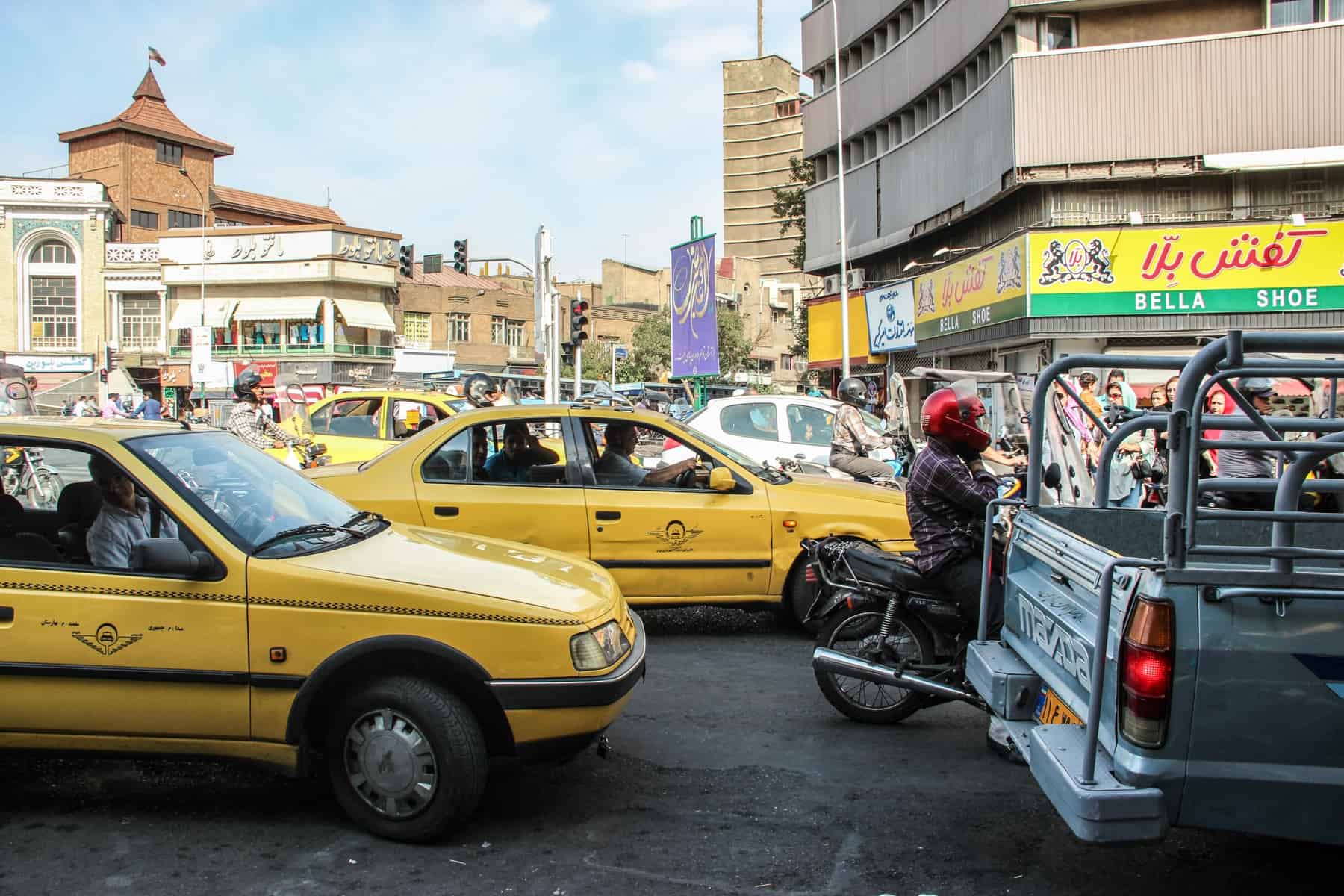
There are plenty of taxi options in Iran.
There are two types of buses between the cities in Iran: regular buses (44 people on board) and VIP buses (25 to 35 people on board). You have more legroom on VIP buses, and you can almost lie down on the seats. You can ask a receptionist at the front desk of the hotel, go to a local travel agency or go directly to the bus terminal to buy a bus ticket in Iran. The prices vary according to the type of bus and the distance. For example, the price for a VIP ticket from Tehran to Shiraz is around 70,000 Tomans ($16).
Using trains is the best and safest option to get around the cities in Iran. There are different types of trains: 4-bed, 6-bed and the so-called ‘bus’ trains. You can also ask if the train you are trying to take is an express train or a regular train. You can book trains through the hotels, local agencies or go directly to the train station. The price for a ticket from Tehran to Yazd, for example, is between 30,000 to 70,000 Tomans ($8 to $15).
You have two options to travel in Iran by a private car. You can hire a driver or a licensed driver-guide who can not only drive you from one city to another but show you the sites en route and give you all the information you need in English and other languages. You can find a driver-guide in Iran through TourHQ . You can either go to a taxi company or a local travel agency to hire a driver or a guide. Beware a killing machine in Iran named ‘Pride’ it’s a very low-quality car produced by Saipa company. It’s the worst car in Iran. Recommended cars in Iran are Peugeots and Samand by Iran Khodro Co.
Domestic flights
If you do not have much time on your hands and you want to visit the classic route (Tehran, Qom, Kashan, Isfahan, Yazd and Shiraz), it is recommended to take a domestic flight from Tehran to Shiraz. From there, you can continue your journey by other means of public transportation eventually back to Tehran. You can buy flight tickets from local travel agencies. The price of the flight ticket is approximately 180,000 Tomans ($40), and it takes around 80 minutes.
On the Metro: Generally, the cars are mixed gender, but if women need more privacy, they can get on the first and the last car on both sides.
On the Buses: In some buses, the women sit in the back and the men in front. Other times it is the opposite. However, a couple can sit together in the men’s section and not vice versa.
Different countries have different specifications, rules and warnings about travel to Iran – some way more dramatic than others. If you can, register or alert your foreign office about your whereabouts for safety and as a piece of mind measure. As a British citizen, with no embassy representation in Iran, this is more so a good idea.
Not that some travellers cannot secure travel insurance until they have alerted the relevant authorities of their travel plans. Hence, it is worth checking precisely who you need to inform before you depart, to be comprehensively covered.
Internet Access in Iran
Be prepared to take a forced ‘Digital Detox’ during your time in Iran. Internet in Iran is slow, all social media (except Instagram and What’s App) is blocked, and you usually are paying per hour for the privilege of a sluggish connection. While I sporadically got decent internet, which allowed my VPN to work, it was never superb. Want to look up sites in Iran? Super quick. Want to find some decent news in the outside world? Good luck.
Tell your family and friends that they may not hear from you that often, and be prepared to do without the connection, however hard it may be.
Irancell is the best phone operator in Iran which offers temporary SIM-cards designed for tourists. They offer a pre-paid 4G internet and credit balance, and when it is used up you can put in a new credit code sold at any supermarket all around Iran to increase your credit and buy internet packages.
You can only have only one VPN app on your phone, so you will need to test which one works best. For Android users, Hi VPN, Psiphon, Hotspot Shield are recommended, and for IOS users Psiphon, Free VPN, VPNProxyMaster and X-VPN are deemed to be the best VPN in Iran that work well at the moment.
Food in Iran (and Vegetarian Difficulties)
I had built up incredible visions of Persian cuisine in my mind before I got to Iran. I thought it would be everywhere – easily accessible and in abundance. Wrong.
Traditional Persian food is available, but you have to do some digging on where to go and find it. Try delicious vegetable and pomegranate stews, traditional Dizi (a lamb based strew where the broth is separated from the solids which are then mashed together and eaten separately) or Ash (a thick and tasty soup of lentils, beans, starch noodles, vegetables, fried mint, fried onion and yoghurt).
Other than that, you will realise that Iran’s streets are paved with fast food outlets, whose neon lights advertise the norm – kebabs, burgers and pizzas. Try and seek out the falafel places, since these are usually the best choice for a cheap and tasty fix.
Vegetarians have more of an issue. I travelled with a vegetarian and whether at a big buffet or a local teahouse or restaurant, what appeared to be the vegetarian option still had meat in it. It may mean living on aubergine/eggplant-based dishes, which are your safest bet, or begging for meat to be left out of your meal if not already pre-prepared.
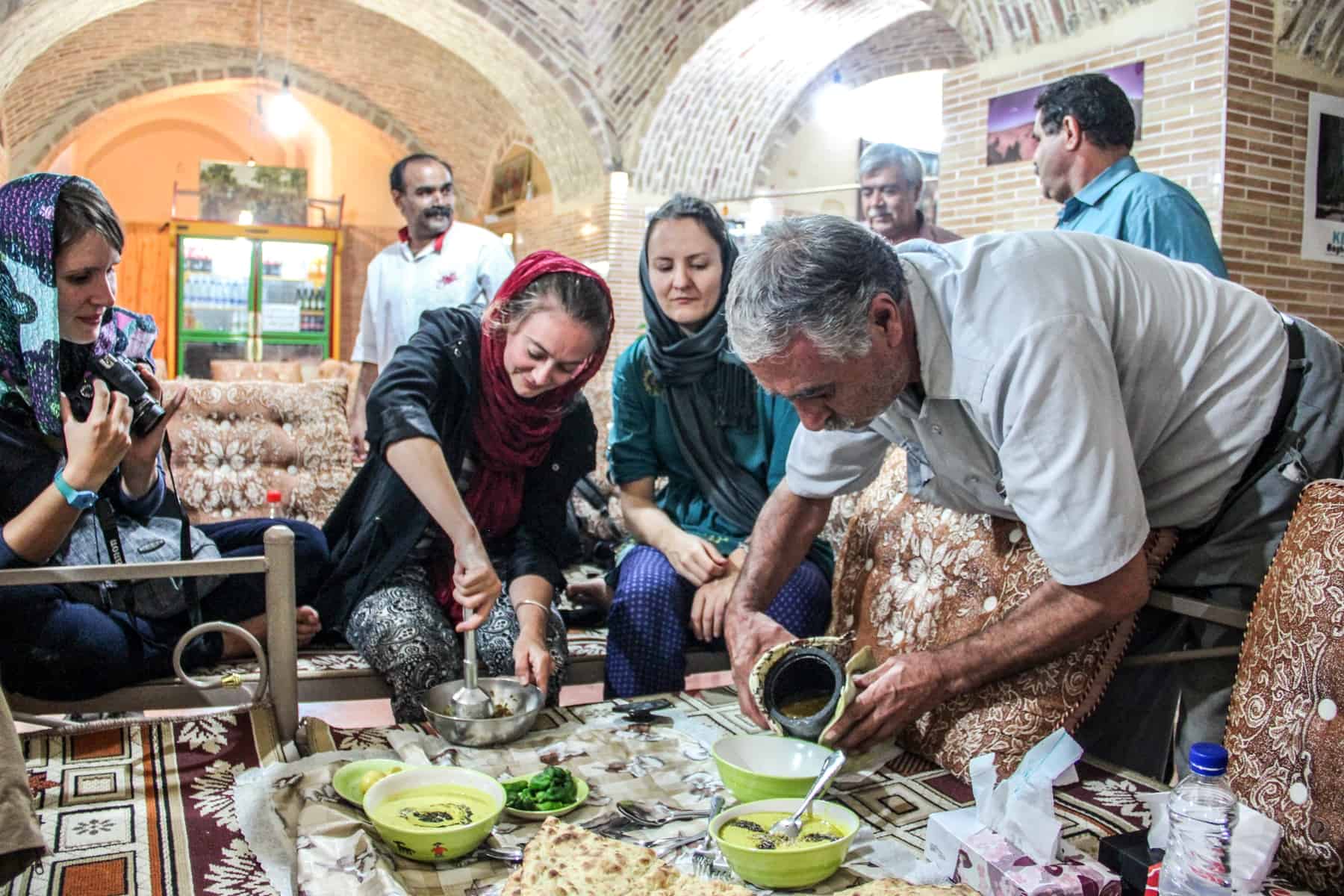
Food in Iran is better when locals show you real Persian cuisine.
There’s no alcohol in Iran. No bars, no clubs. Nothing. The best you get is non-alcoholic beer in a variety of fruity flavours like peach, lemon and strawberry which grace most menus.
There’s no set of different rules for travellers in Iran and those visiting. A local might be being kind in offering to find you the real deal at some underground gathering, but really, don’t take the chance. They might be able to waver the punishment; you won’t.
Like any country, it is crucial to know, understand and adhere to cultural and religious customs and rules that can often be very different from those at home. Here are the main rules for etiquette in Iran and interesting Iranian culture facts:
- One of the primary forms of social etiquette is TAROF, which is where Iranians usually insist on offering things to people and sometimes they do not mean it. However, you should not accept the first time.
- In Muharram month (the mourning month of Imam Hossein) people DO NOT usually wear bright colours (especially red) to respect the religious values.
- In Ramadan month , in which the majority of people keep fast during the day, it is disrespectful to eat and drink in public.
- In restaurants in Iran , it is incredibly unpleasant to see anyone clear their nose, especially loudly. In general, restaurant or not, it is also unusual to see somebody break wind.
- Shaking hands between men and women is a complicated topic. Generally speaking, it is not okay for men and women who are not related to shake hands. However, it is entirely relative. Usually, it is not advised for female tourists to extend their hand towards men, and it’s best to wait and see if the men do so first.
- The thumbs-up hand signal a derogatory sign in Iran, and it is best not to use it, especially in the presence of older people.
- When it comes to public displays of affection , you’ll see that affectionate touching, kissing, and shaking hands between men and women who are relatives are very normal. Iranian dating customs are more complex. You can kiss your significant other on the cheek, but french kissing strictly goes beyond the line. Holding hands is not something one would raise an eyebrow about at all, whereas hugging, on the other hand, would seem to be crossing the line a little. It is relative as to what extent the public display of affection is tolerated. For example, inside holy places and religious cities, it would not be easily tolerated.
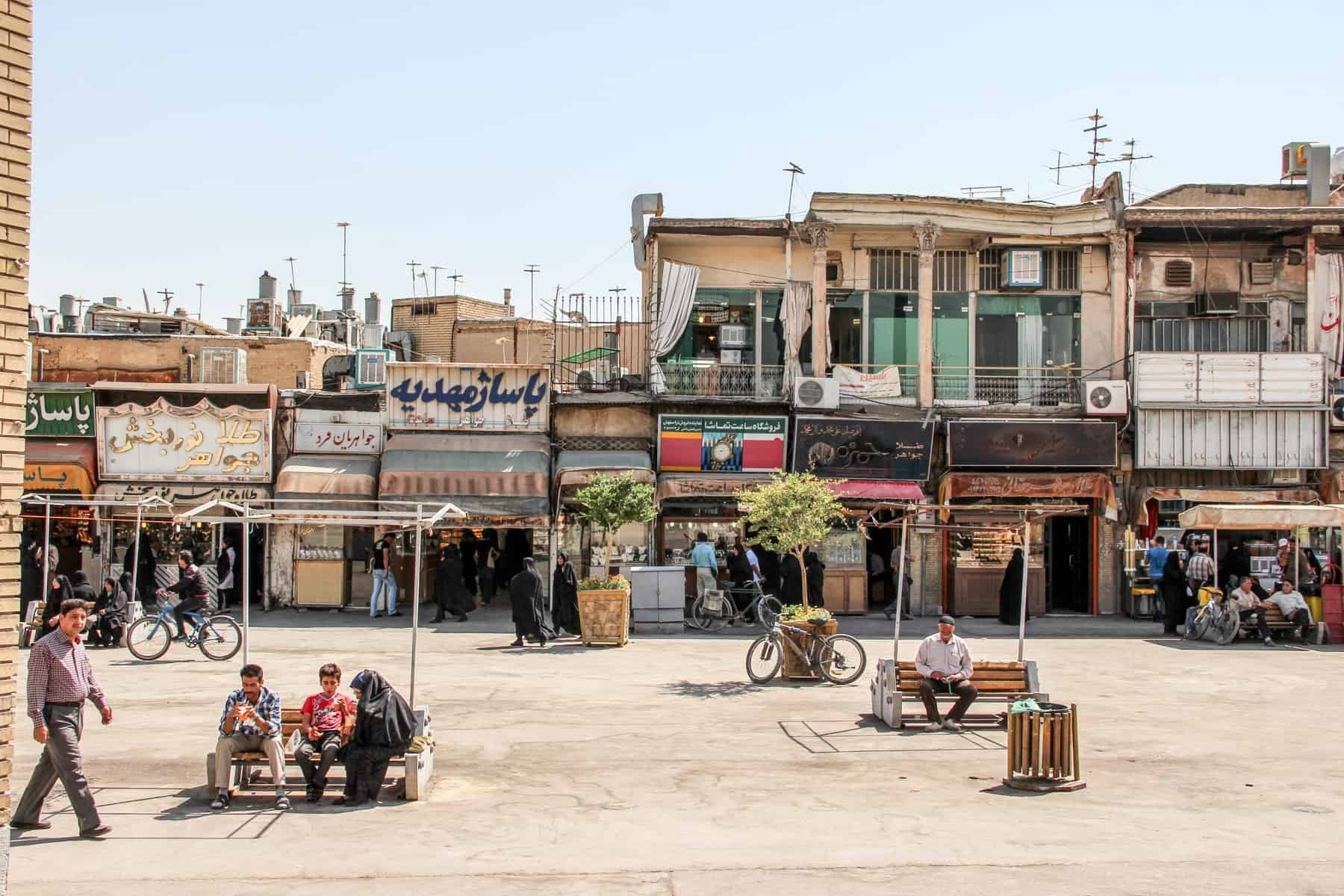
Wherever you are in Iran, it is important to adhere to cultural and religious customs and rules.
‘Persian Time’ is much like ‘Asian Time’ – things take much longer than you expect. When you travel Iran you’ll soon see that service is slower and the times you are given for things, like an arrival at a destination, are not always clear or roundabout correct, like this example:
Guide: “It takes four or five hours. So if we leave at 8 am, we will get there around 4 pm.”
Me: “But that’s eight hours, not four.”
Guide: “Yes, it takes about eight hours. We will stop at x, y and z on the way and arrive around 2 pm.”
In short, don’t rely on or worry about time, and pack a bit more patience than you would at home, especially when it comes to food, service and paying.
Ancient Persia isn’t an easily absorbed history lesson. While your guide (if you choose to have one or if you are a part of a tour group) will spout a level of information that will blow your mind, it is worth reading up on the history of Persia, as well as details on the lead-up to the Iranian Revolution in 1979. This will give a valuable understanding of the basic makeup of the country.
It will mean names like Zoroastrian, Cyrus the Great, the Achaemenid Empire, Reza Shah, Ayatollah Khomeini and Ayatollah Khamenei won’t be lost on you when you go to Iran.
Great books to read before you arrive include:
- Revolutionary Iran: A History of the Islamic Republic for a guide on the more recent history
Iran: What Everyone Needs to Know is by the same author, Michael Axworthy, and tries to explain how there’s more to Iran than its foreign relations, with part of the book also unravelling Iran’s economy, politics, culture and people.
Daughter of Persia: A Woman’s Journey from Her Father’s Harem Through the Islamic Revolution is about a woman who was born in Iran, left to study in the States and returned to a country in the grip of profound change.
- The Wind in My Hair: My Fight for Freedom in Modern Iran about a journalist in exile after being arrested for political activism
Best for when on the road:
- Easy reference for most of us came from the Lonely Planet Iran guide book . While it shouldn’t be your sole source of information, this particular Lonely Planet is a quick fix Iran travel guide, especially for historical hotspots. Having this paper guide was a handy resource for the entire trip, especially since quick access to the internet in Iran both at the hotels and while on the road is very limited.
Have you been to Iran? Are there any other pre-departure tips you would add? And if planning a trip there, and what difficulties are you facing, if any?
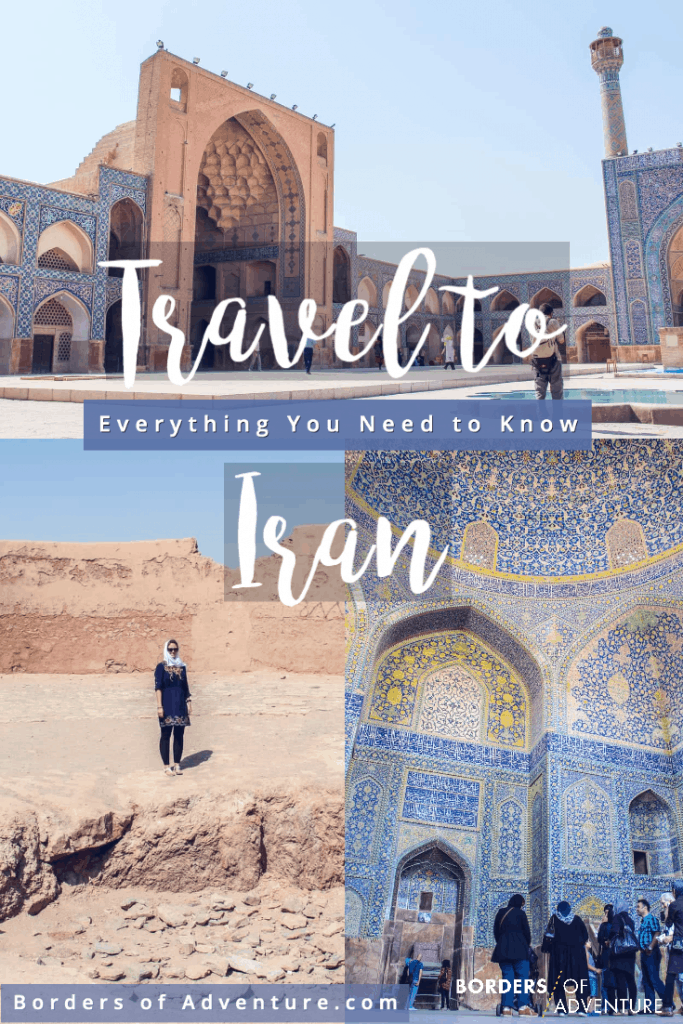
Any plagiarism of this Iran travel blog or any of its descriptions used on other sites and blogs without attribution is not information authorised by myself for use. Know your source.
About Becki
Becki Enright is a British Travel Press Award-winning writer whose work focuses on changing perceptions about misunderstood aspects of destinations. Her writing combines storytelling with insight into the social, historical, political and economic factors that shape the country or place in relation to tourism. Becki has appeared live on Sky News and CNN and has contributed to high profile media including National Geographic, Time.com, Guardian online, New York Times, Grazia and Buzzfeed.
Marcela says
19 April 2022 at 7:42 pm
Hi, is it possible to rent a car without a driver in Iran? Thanks, I loved your post!
28 April 2022 at 11:39 am
I think you can, yes! However, it isn’t something I know much about.
Hanieh says
28 March 2022 at 8:19 pm
Iran and Tehran are great🤩
7 August 2021 at 4:02 pm
Hello. I want to thank for this text. It is completely true about Iran and I as an Iranian approciate that describe Iran and Iranians truly. I really enjoy it. Most of Iranians think people of world consider us as a terrorist country while people of Iran differ from Republic Islamic Iran.
Miranda says
24 October 2019 at 8:53 am
I really like to travel to Iran, but I don’t know when is the best time to travel there, what is your recommendation?
24 October 2019 at 10:52 am
Hi Miranda. All the details are in the article. You can find an overview of the best time to visit Iran here: https://www.bordersofadventure.com/travel-to-iran-things-to-know/#When_is_the_Best_Time_to_Visit_Iran
- Article Archives
- Work with me
- Privacy Policy


Getty Images/Lonely Planet Images
Welcome to what could be the friendliest country on earth. Iran is the jewel in Islam's crown, combining glorious architecture with a warm-hearted welcome.
Attractions
Must-see attractions.
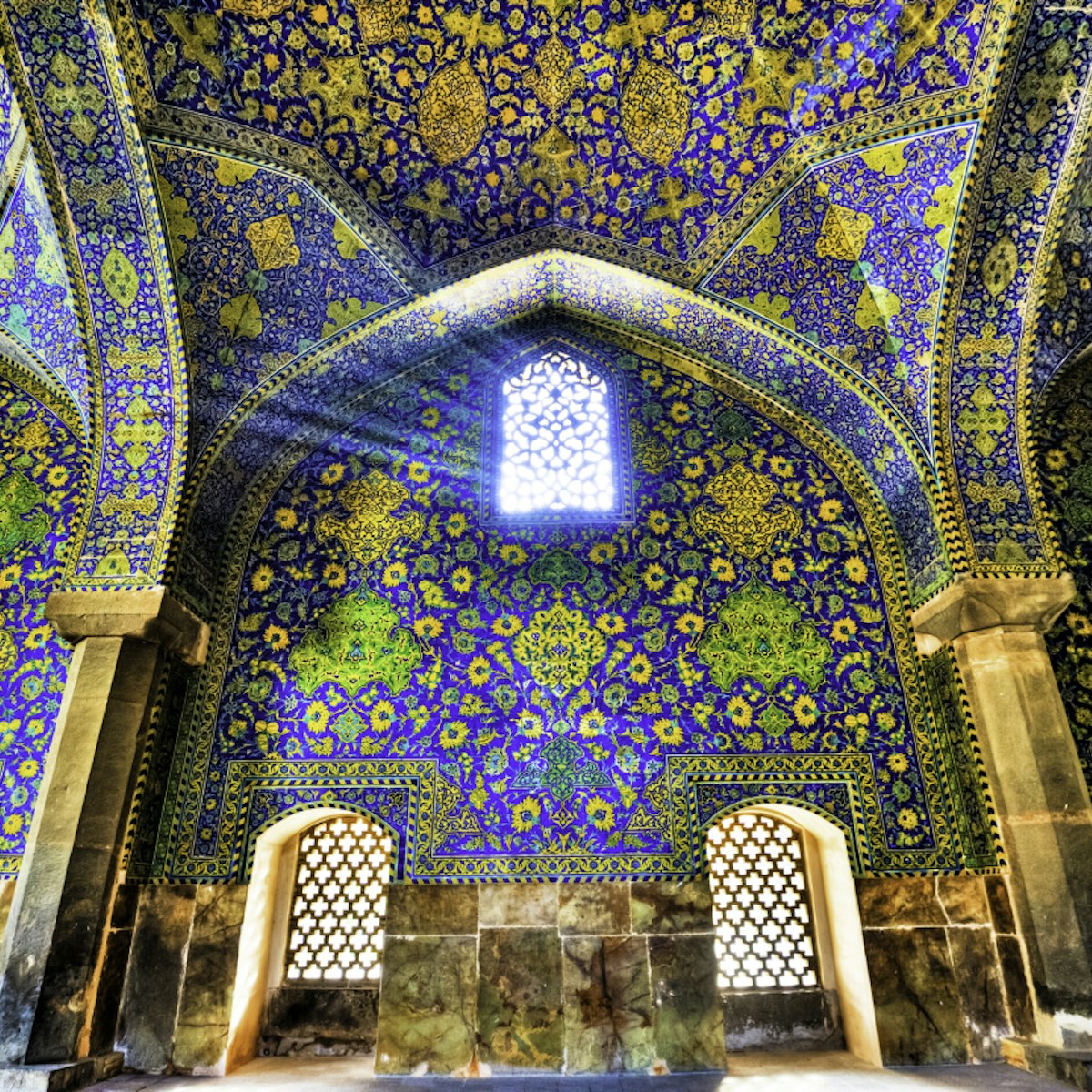
Masjed-e Shah
This elegant mosque, with its iconic blue-tiled mosaics and its perfect proportions, forms a visually stunning monument at the head of Esfahan's main…
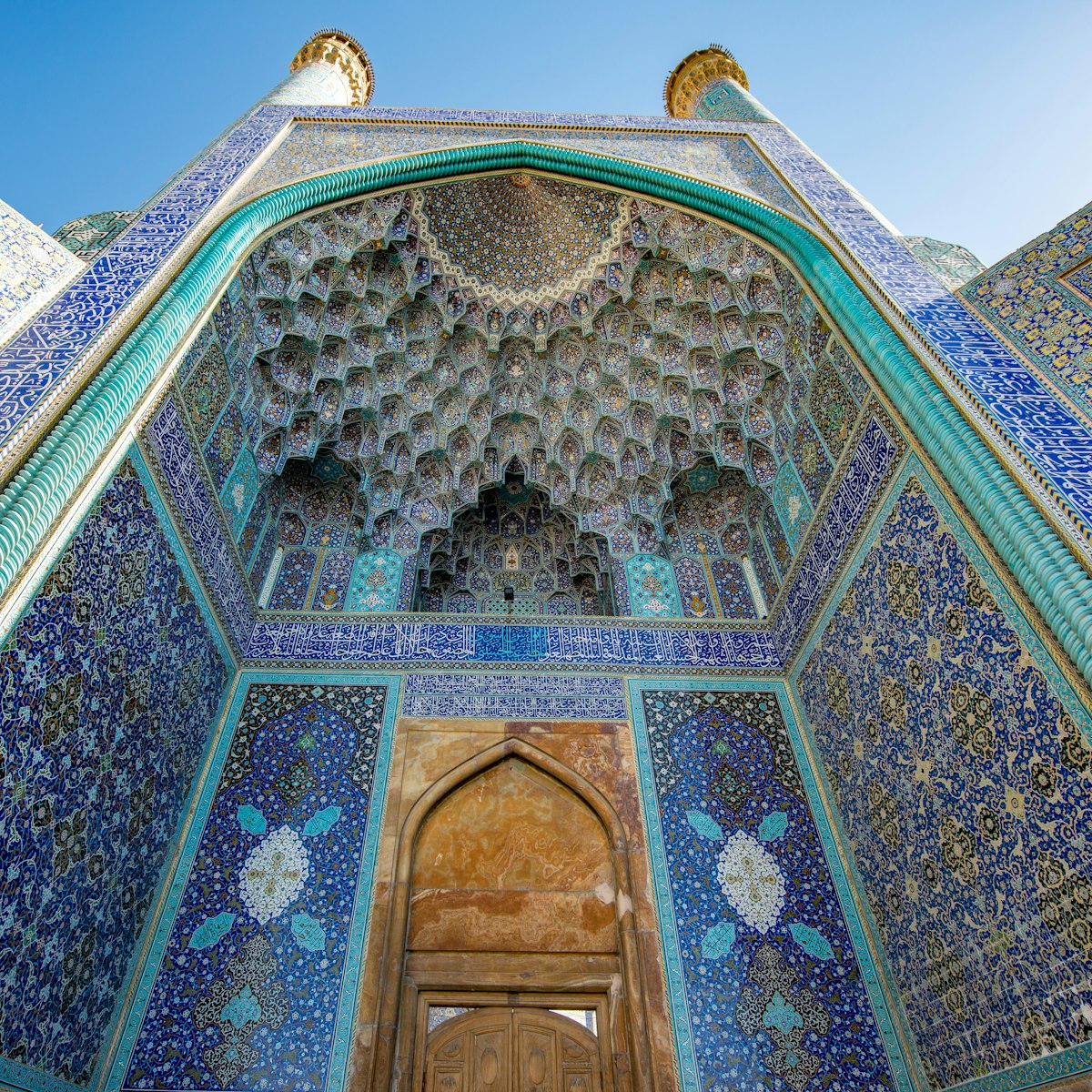
Masjed-e Jameh
The Jameh complex is a veritable museum of Islamic architecture while still functioning as a busy place of worship. Showcasing the best that nine…
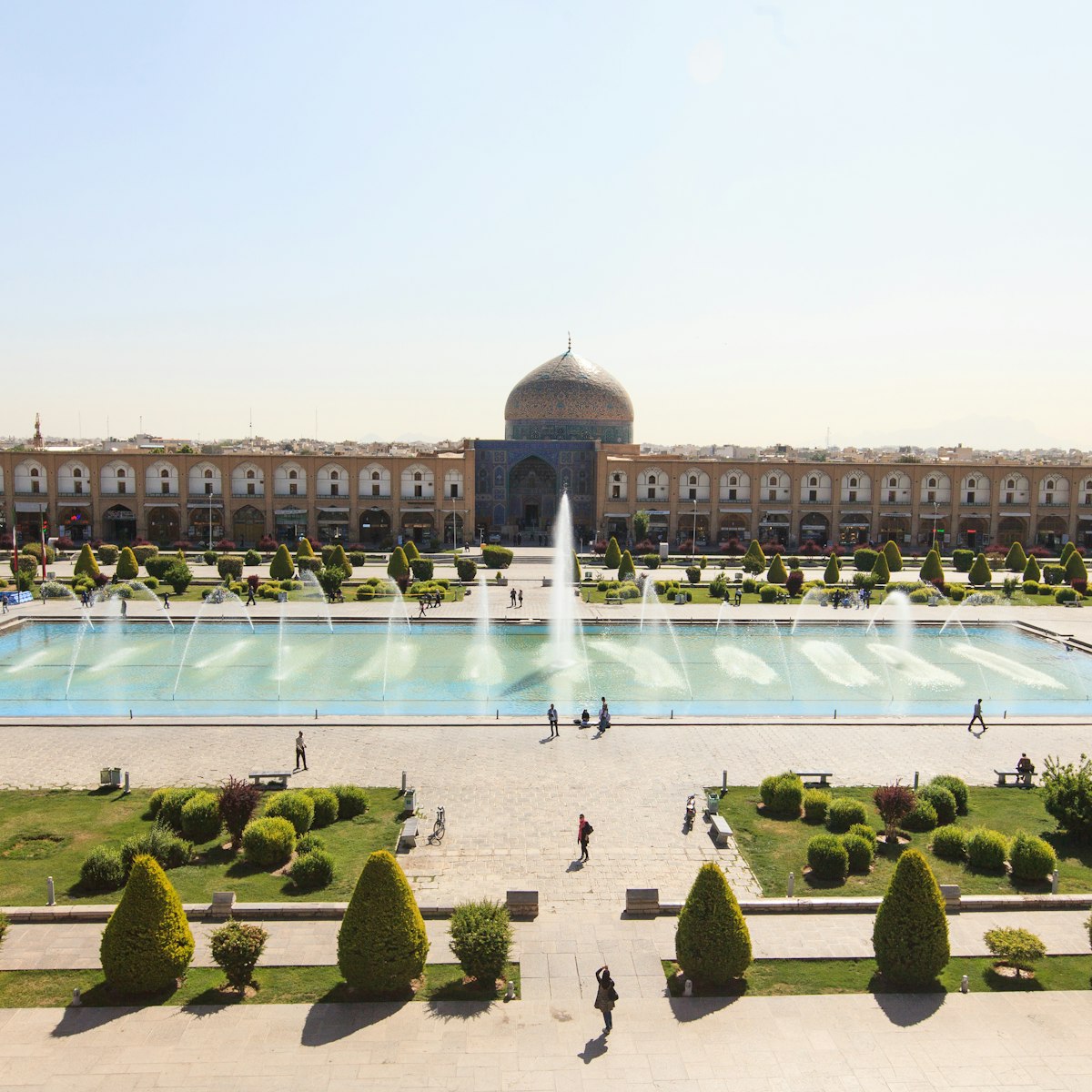
Naqsh-e Jahan (Imam) Square
Hemmed on four sides by architectural gems and embracing the formal fountains and gardens at its centre, this wondrous space is a spectacle in its own…
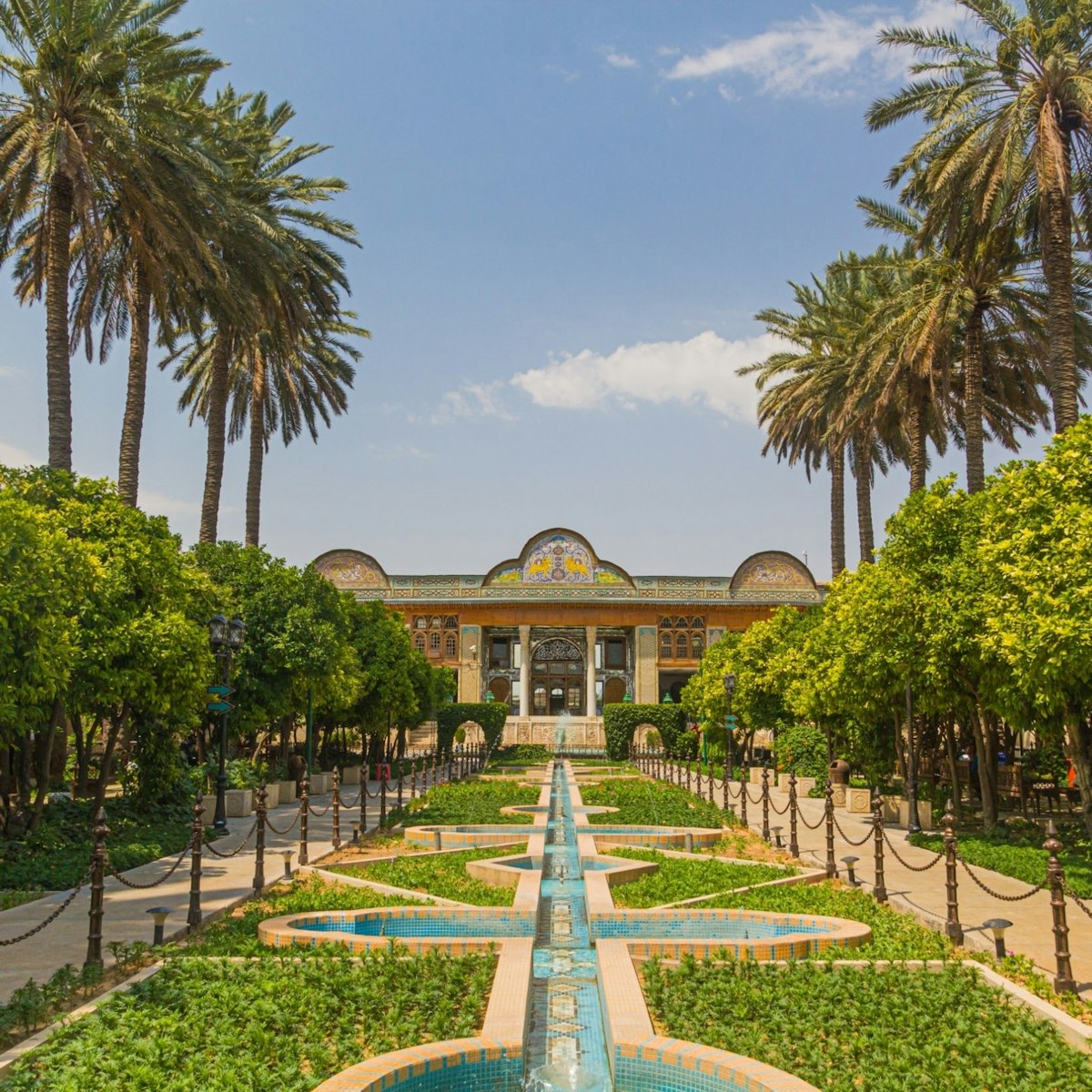
Bagh-e Naranjestan
Named after the bitter oranges that line the central courtyard, this is Shiraz’s smallest but most lovely garden. Enclosing the delightful Naranjestan-e…
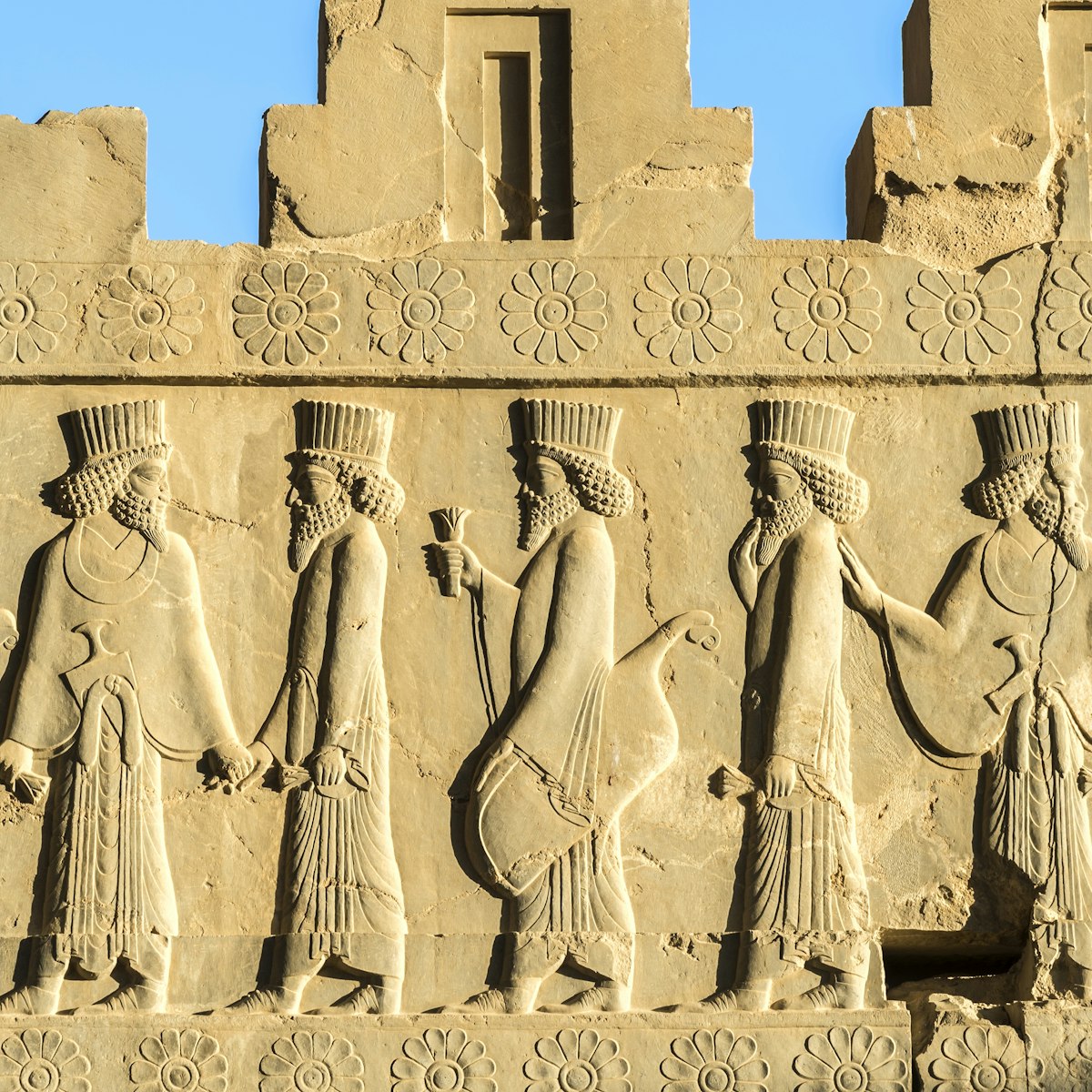
Apadana Staircase
The stairs, which are guarded by stone soldiers, are decorated by an exceptionally finely crafted frieze in three panels. Each panel is divided into…
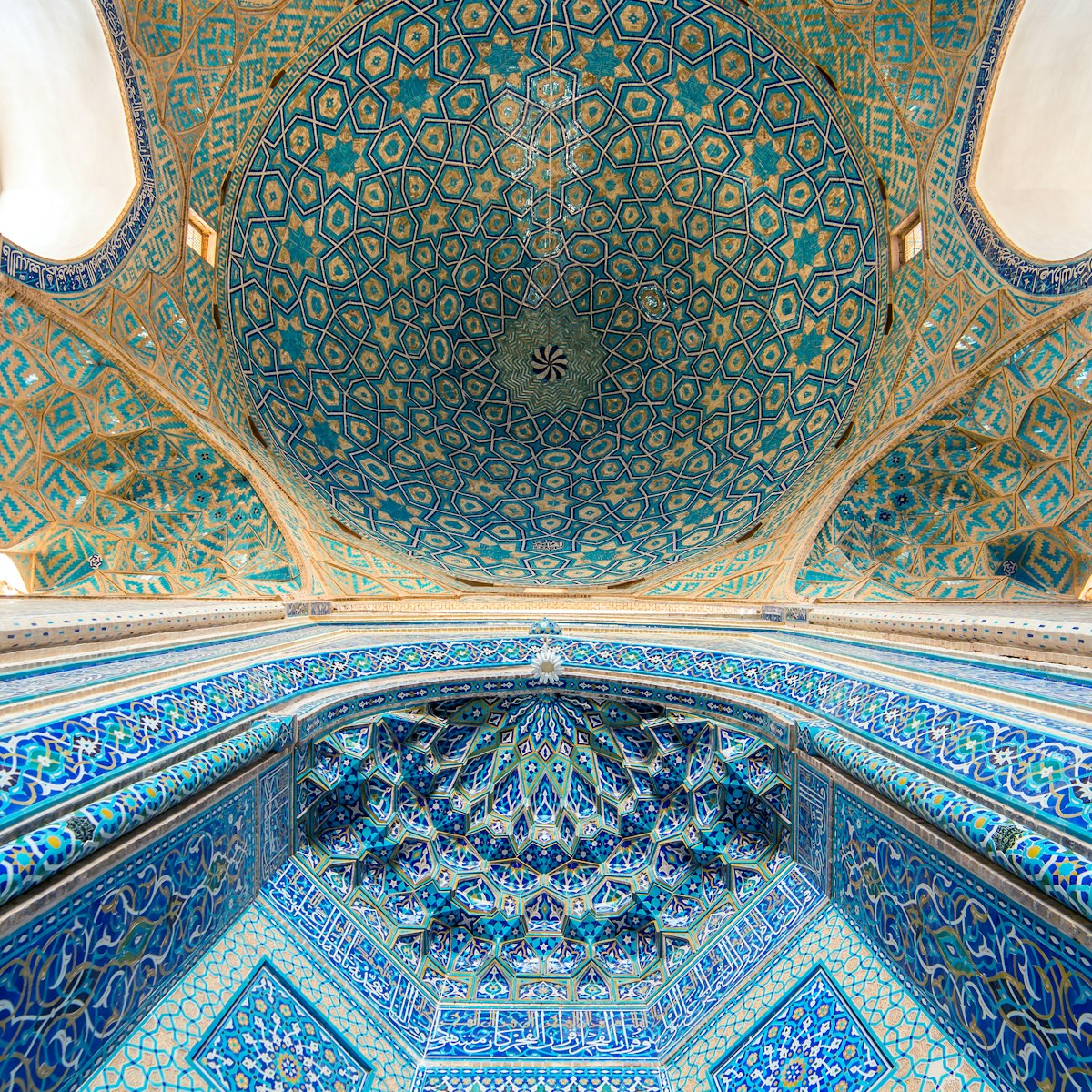
Soaring above the old city, this magnificent building is graced with a tiled entrance portal (one of the tallest in Iran), flanked by two 48m-high…

Tabriz Bazaar
The magnificent, labyrinthine, Unesco-listed Tabriz bazaar covers some 7 sq km, with 24 caravanserais (sets of rooms arrranged around a courtyard) and 22…
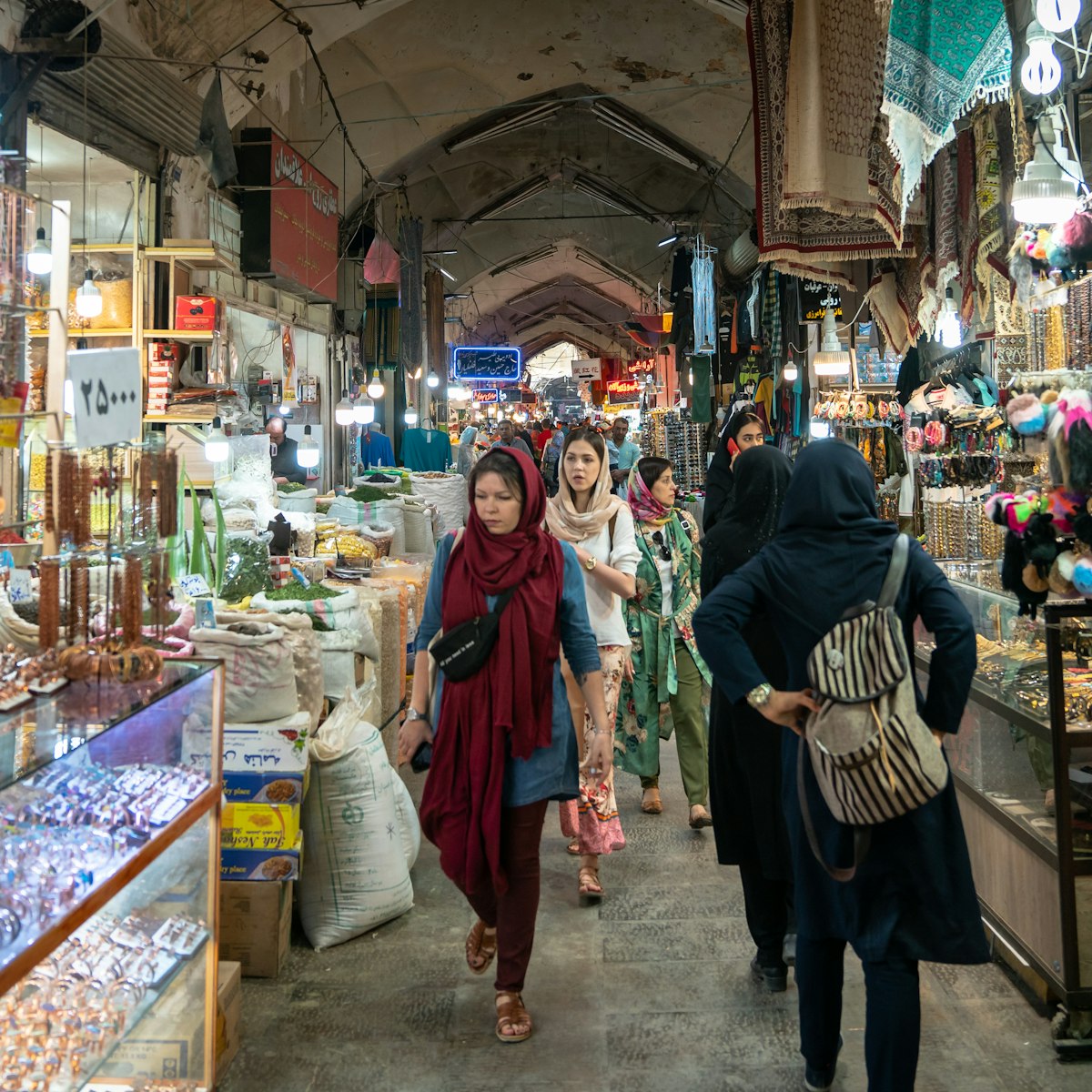
Bazar-e Bozorg
One of Iran’s most historic and fascinating bazaars, this sprawling covered market links Naqsh-e Jahan (Imam) Sq with the Masjed-e Jameh. At its busiest…
Latest stories from Iran
Filter by interest:
- All Interests
- Adventure Travel
- Art & Culture
- Beaches, Coasts & Islands
- Food & Drink
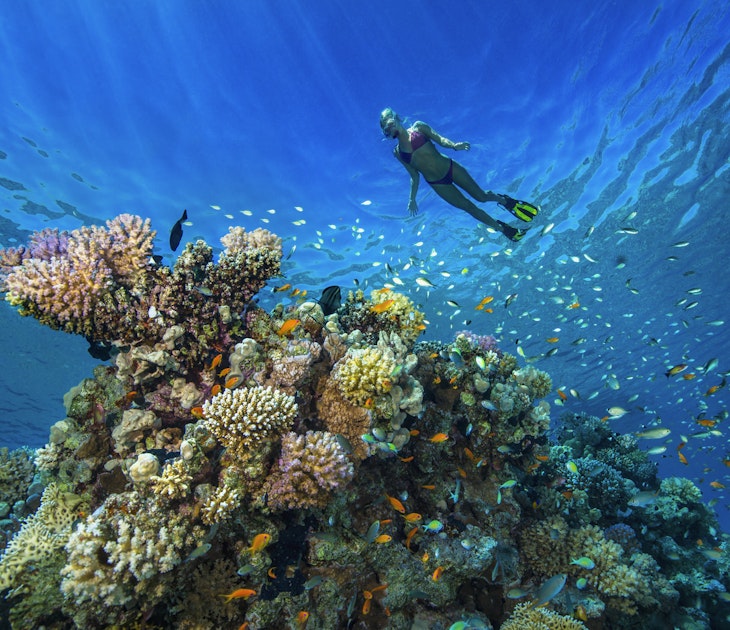
Apr 17, 2019 • 5 min read
With a dazzling bounty of underwater attractions to explore and improved access to key diving hubs, there has arguably never been a better time to strap…
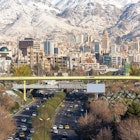
Aug 11, 2018 • 2 min read
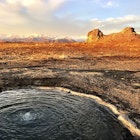
Apr 3, 2018 • 7 min read
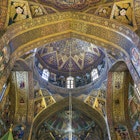
Oct 10, 2017 • 5 min read

Nov 24, 2016 • 2 min read
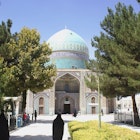
Jul 17, 2015 • 2 min read
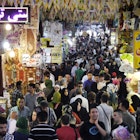
Aug 6, 2014 • 5 min read
in partnership with getyourguide
Book popular activities in Iran
Purchase our award-winning guidebooks.
Get to the heart of Iran with one of our in-depth, award-winning guidebooks, covering maps, itineraries, and expert guidance.
Iran and beyond
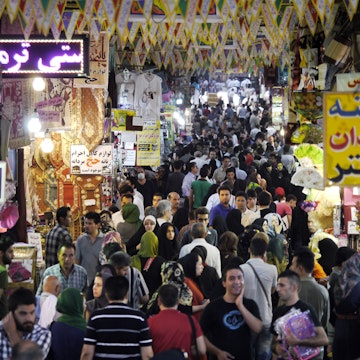
Top Things to Do in Iran
Places to visit in iran, explore popular experiences, popular cities in iran.
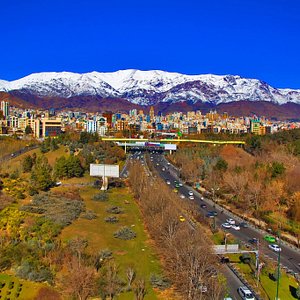
Top Attractions in Iran

What travellers are saying
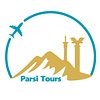

ISFAHAN (ESFAHAN)

KISH ISLAND

- Top 10 Cities
- UNESCO Intangible Cultural Heritage In Iran
- UNESCO World Heritage Sites In Iran
- Historical Tourism
- Religious Tourism
- Recreational Tourism
- Sport Tourism
- Handicrafts
- World Craft Cities
- Art & Culture
- Tourism Map
- Festivals & ceremonies
- Iran-Russia Visa-Waiver Authorised Agencies
- 360° Gallery
- Video Gallery
- Image Gallery
- Type to search Not result Loading
Regulations on International Travel to Islamic Republic of Iran in COVID Times
- within the framework of Instructions on Passengers Traffic, declared by the Ministry of Foreign Affairs, the issuance of tourist visas for those who travel across international borders is unobstructed.
- Traffic of public and private vehicles is unobstructed in compliance with the health protocols of the Ministry of Health and medical education.
- The Negative PCR test for the age group over 12 years should be valid for 96 hours.
- Preventing the entry of foreign tourists who, despite having a vaccine card and a negative PCR test, have symptoms at the land borders, and returning them to their own country with the cooperation of The Border Guard Command.
- If the PCR diagnostic tests are positive after entering the country, tourists are required to quarantine at his own expense in accommodation centers and their traffic in the country is subject to receiving a negative PCR test result.
- Completion of a self-declaration form by tourists before entering Iran.
- Obtaining a valid insurance policy (with Covid-19 coverage) by tourists before issuing a visa.
- Providing the conditions for the return to their own country for those tourists who get Covid-19 during their stay in the Islamic Republic of Iran and are not able to go through the 14-day quarantine period, in coordination with the Ministry of Tourism.
- All costs of PCR COVID testing and quarantine measures in Iran are borne by the tourist, through insurance coverage.
- Cooperation and coordination with health centers in border areas in case of encountering any of the following issues and preventing foreign tourists from entering across land borders:
- If foreign people who enter across land borders are symptomatic, despite presenting a vaccine card and a negative PCR test.
- Failure to provide a self-declaration form by the tourist.
- Failure to provide valid international travel insurance or purchase travel insurance from Iranian insurance companies.

Home » Travel Guides » Iran » 15 Best Places to Visit in Iran
15 Best Places to Visit in Iran
Iran might not seem like your usual tourist destination, and it’s certainly true that theocratic juntas, a fervor for all things nuclear, and tales of autocratic shahs from decades gone by don’t make for the most enticing of travel cocktails. But Iran isn’t like most Middle Eastern countries.
Millennia of rising and falling civilizations – the Persians, the Parthians, the Safavids – have all gone before the modern nation, and their glory and richness have done something to instill today’s country with a pride and stability that’s the envy of many neighbors (even if they won’t admit it). Today, that means Iran is hurtling headlong into the future whilst still clinging steadfastly to its dazzling past – it’s a curious dichotomy that really informs the whole place.
You can flit between boho coffee shops and avant-garde art galleries in Tehran, or seek out majestic madrassahs in cities like Esfahan and Yazd. You can carve the pistes at Dizin or trace the footsteps of Xerxes and Darius at Persepolis.
Lets explore the best places to visit in Iran :

Gilded with the riches of more kings and sultans and Muslim caliphs than you can shake a cobalt-blue ceramic pot from a Zagros Mountain village at, the glorious city of Esfahan is unquestionably one of the most beautiful in all of Iran.
Its heart is dominated by the colossal Naqsh-e Jahan Square; a UNESCO World Heritage Site that’s ringed by ceramic-fronted mosques and gorgeous Safavid palaces.
Elsewhere and babbling fountains give way to tree-dotted avenues, legendary madrassahs pop up on the streets, and arabesque souks burst with multi-coloured stacks of spices and tassel-fringed carpets from the east.
In short: Esfahan is the Iran you really have to see.

Eulogized and eulogized over and over again by romantic poets and travelers, and revered as the birthplace of the great Persian wordsmiths Hafez and Sa’di, Shiraz is a city steeped in heritage and culture.
Visitors will be able to spot the great tombs of those writers nestled between the palm-dotted, flower-sprouting gardens of Afif abad and Eram, along with the intricate arabesque interiors of the Nasir al-Mulk Mosque and the 1,000-year-old Qor’an Gate.
Rather surprisingly, the town also lends its name to a popular strain of wine, and, despite the cascading vineyards of the Fars Province long since having dried up, it’s thought that some of the world’s earliest white tipples were produced here nearly seven millennia ago!

One’s thing’s for sure: Tehran certainly isn’t a looker like Shiraz or Esfahan.
Apart from the rugged wall of snow-tipped Alborz Mountains that rise like a phalanx on the northern edge of town, the place is largely dominated by concrete and packed with smog-creating traffic jams aplenty.
However, like it or loathe it, this sprawling metropolis is the epicentre of the country’s politics and economy, and that surely counts for something, right? Well, a lot actually.
Great monuments like the Azadi Tower have been raised here, while the glimmering wonders of the Treasury of the National Jewels and the mummified princes of the National Museum of Iran are just some of the awesome relics to see.
Add to that a clutch of stylish teahouses and coffee shops, frantic bazaars and youthful student energy, and Tehran really isn’t all that bad!

Perched nearly 3,000 meters up in the snowy heights of the Alborz Mountains, where the European Caucuses crash into the Asian ranges, the small hill station of Dizin has firmly established itself as one of Iran’s top winter sports destinations.
With a clutch of good groomed pistes ranging from moderate difficulty to challenging runs, and a selection of cableways and chairlifts that were first installed in the 1960s, the soaring resort is one of the top places to don the skis and salopettes here.
There are also some alpine-style hotels, and awesome views of the cone of massive Mount Damavand in the distance.

The adobe warren of the Yazd old town is like something out of Arabian Nights.
Here and there, turrets gilded in intricate geometric designs loft above the mosque domes; the scents of incense and mint tea twist and turn from the cafes.
Meanwhile, the middle of the city is dominated by mysterious Zoroastrian fire temples and the spiked minarets of the Shia hussainia that is the Amir Chakhmakh complex.
And then there are the souks, where dust devils twirl between the cotton and silk emporiums, and shisha pipes puff in the background.
Yep, it’s precisely the sort of place you’d expect to trace the footsteps of one Marco Polo!
6. Persepolis

Great kings by the name of Cyrus, Darius and Xerxes all set foot between the sun-scorched streets of Persepolis once upon a time, for it was here, amidst the arid erstwhile vineyards of Shiraz and the babbling Pulvar River, that the mighty Persian Empire made its home from the 5th century to the 3rd century BC. Today, only traces of this once feared power in the east remain, with a clutch of looming marble columns and a couple of stele all that’s left to mark the great compound out amongst the rising hills of Rahmet Mountain.
Travelers can immerse themselves in the history, and even see the tomb of the revered king Darius I.

With a history of more than 4,500 years, there’s evidence to show that Tabriz is one of the oldest continuously inhabited cities in the entire world.
That deep past now reveals itself in the layers of architectural majesty the place is known for, at spots like the colossal Blue Mosque of 1465, which comes gutted with shimmering ceramics of a deep cobalt blue.
Another real must see is the sprawling Bazaar of Tabriz, which is known as one of the great trading outposts of the old Silk Road.
Today, the vaulted ceilings and alcoves of this ancient merchant centre still burst with shimmering gold jewellery and blood-red carpets, sweet-smelling Turkic pastries and oodles of spice from the east.

Mashhad is hallowed ground for many Iranians. It houses the revered tomb of the eighth Imam of Shia Islam: Ali al-Ridha (or Imam Reza). It’s a seriously holy place, and is appropriately marked by the colossal Imam Reza shrine, which sprawls over nearly 600,000 square meters in the middle of the city; a glimmering mass of gold-clad minarets that go over 30 meters into the ski and great domes inlayed with precious metal (it’s definitely one of the country’s most breath-taking pieces of architecture).
Away from that must-see and Mashhad also has clean streets and curious sculpture art, not to mention some saffron-infused curries that are sure to set the taste buds a-tingling!

For Iranians, Rasht represents the gateway to the Shomal – a region of verdant hills and high rainfall that’s really unlike anywhere else in the country.
The unique climactic conditions of the high ridges that surround the town are made possible by its enviable location on the edge of the Caspian Sea, which also happens to imbue it was an array of other curious attractions.
We’re talking about the USSR-themed relics relating to the Soviet sympathiser Mirza Kouchak, and the leafy European-style facades of the Shahrdari in the center.
However, it’s trips out to see the gorgeous Golestan National Park, where the misty forests house Persian leopards, that usually come up trumps!

Encompassed by the sweeping deserts of the Iranian south, the old trading outpost of Kerman still clings to the bustling mercantile character it has had since the days when major trading routes between Arabia and India passed this way.
Check out the sprawling bazaar in the heart of the city, where five spice mixes with chilli and coriander powder between the vaulted emporiums.
There are also earthy Turkic hamams to bathe in, and a warren of mud-brick streets to wander.
And once the city’s done and dusted, be sure to strap on the boots and go intrepid into the ochre-hued hills of greater Kerman Province.

Kashan sprouts from the deserts of northern Iran midway between Esfahan and the capital at Tehran.
An oasis town, it’s packed with blooming pockets of date palms and green gardens that are fed with babbling irrigation streams.
The buildings are distinctly adobe and brown though, except – of course – for the elegant mansions of the Tabatabaie Residence, the Ameri House and the domes of Aqabozorg.
These are remnants of the Qajari royals, who came here and raised magnificent residential structures in the 18th and 19th centuries.
There’s also a throbbing bazaar and beautiful views of the mountains on the horizon.

Just 19 kilometres south of Iran’s coast, in the sparkling waters of the Persian Gulf, more than one million people discover the island of Kish each year.
They come to wallow in a place that’s quite unlike its mother country in many ways; a place where huge casinos converge on the palm-dotted gardens of opulent resort hotels.
However, there are two other attractions that ensure a steady stream of visitors on Kish: shopping and beaches.
The first of these comes with the duty-free malls that ring the main town, and the latter comes in the form of sparkling white sands, coral reefs, and awesome SCUBA diving to boot.
13. Hamadan

Forged by the Medes and the Assyrians, the Persians and the Parthians, this once great city might not be the legendary metropolis it was in antiquity, but it still comes steeped in all the culture you’d expect of a place with so many thousands of years of history behind it.
It’s perhaps most famed as the home of the Tomb of Avicenna, which chronicles and honors the life of arguably the most totemic scientific thinker in the Islamic world.
And there are other awesome sights to see too, like the Ali Sadr Cave, which is the largest in-cave lake on the planet, and the inscriptions of the Ganjnameh, made by the ancient Persian kings Darius and Xerxes.

Qom is considered one of Iran’s most holy cities.
It’s packed with soaring minaret spires and the turquoise-hued domes of totemic mosques (don’t miss the uber-handsome Ahlulbayt Mosque). One of the country’s cultural and religious centers, it’s also got some acclaimed madrassahs and draws massive crowds of pilgrims throughout the year.
Most come to wonder at the filigrees and pay their respects at the Shrine of Fatima-al-Massumeh, which is the resting place of the sister of the eighth Imam of Shia Islam.

Ramsar sits neatly sandwiched between the rugged rises of the Alborz Mountains and the lapping waters of the Caspian Sea.
It’s a truly enviable location; one that imbues this town of neo-classical hotel fronts and palm-peppered avenues with a wealth of good beaches and some seriously jaw-dropping panoramas of the hills that rise to form the Caucasian chains of Azerbaijan to the north.
The place has long been one of the top seaside retreats for Iranian luminaries, and continues to draw with its bubbling hot springs and fabled healing waters.
15 Best Places to Visit in Iran:
- Skip to primary navigation
- Skip to main content
- Skip to primary sidebar
Travel & Food, Itineraries & Guides, Hotel Reviews
The Perfect Itinerary for Iran – Essential Persia in 9 Days
December 2, 2019 by Bino 1 Comment
For a country of its size, Iran offers a plehora of things to see and do – especially if you love architecture as well as the great outdoors – that it’s probably hard to compartmentalize the country into a short one or two week stretch. Boasting some of the most beautiful cities, atmospheric desert towns, intricately constructed buildings as well as unreal landscapes, Iran is an eye-opening place and definitely has something for everyone.
The classic travel route for Iran is the one that stretches from Tehran to Shiraz, covering other cities such as Kashan, Esfahan and Yazd in between. Given that these cities are well connected, there’s little need to back track so you can either start in the north in Tehran or down south in Shiraz. This itinerary aims to show how you can cover these cities in Iran, starting from Tehran, but you can easily reverse this.
Table of Contents
Day 1 – Tehran (Azadi and Milad Towers, Golestan Palace, Grand Bazaar)

skyline of tehran
Tehran, the sprawling capital of Iran, is the largest city in Western Asia. For most travelers, the introduction to Iran, is one of congested roads and air pollution. If you happen to visit during a public holiday, it’s a totally different story and you’ll find highways almost empty.
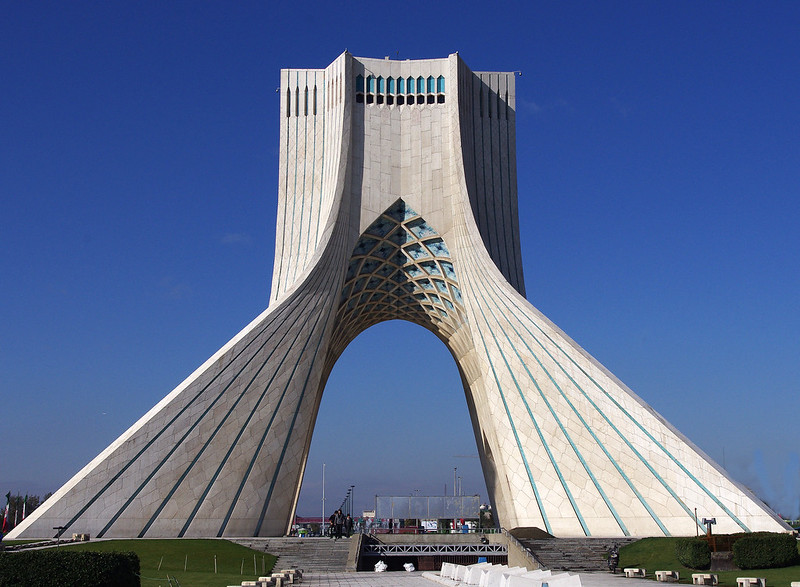
azadi tower
Tehran has quite a number of sights worth visiting and you can easily get around by taxi or hired car. The city also has a metro and is a great alternative for getting around, especially considering the traffic jams. A must visit when in Tehran is the Azadi Tower , an architectural gem that was built to commemorate 2,500 years of the Persian empire. The tower is surrounded by a park which is encircled by a roundabout. It is possible to enter the tower for a fee but in my opinion, you’re better off admiring the curves from the park itself than to be inside the tower.
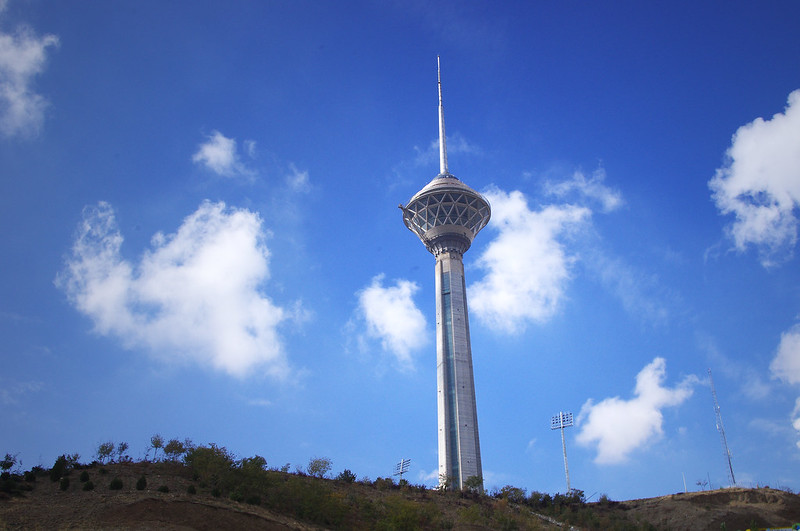
milad tower
Another tower you can check out is the Milad Tower , which offers fantastic views of the city as well as the Alborz Mountains in the distance. Compared to Azadi, Milad Tower is a thoroughly modern construct.
Aside from Azadi Tower and Milad Tower, most of the other sights in Tehran are conveniently located near the stations of the original (red) metro line so it would be practical to group these places together. These attractions include: Saadabad Palace , the former US embassy in Iran , Golestan Palace as well as the Grand Bazaar . Depending on how much time you have left after visiting the towers, you can visit around 1 or 2 other sights along the red metro line before calling it a day. A personal recommendation for an afternoon visit would be the Golestan Palace . This used to be the royal palace when Iran was still a monarchy. Some of the rooms here, including the Mirror Hall, Brilliant Hall and Karim Khani Nook, showcase impressive Persian symmetrical designs. Note that you’d need to purchase separate tickets to enter some of these halls.
Tip: All over Iran, you will get looks walking around as a tourist. The overwhelming majority of these have no malice in them and are just indications of curiosity. A common gesture is to say hello back which in some cases, lead to conversations and even invitations for dinner. It is up to you whether to accept or not. I have accepted one such invitation and some travelers I spoke to did the same. But that doesn’t mean that Iran is scam-free. In a separate incident, a local offered to show me around town as a goodwill gesture and later tried to extort me money for it.
Directly outside the Golestan Palace is Tehran’s Grand Bazaar . You can practically find everything here, from spices to handicrafts, apparel and of course, carpets. While Tehran is still not a touristy place, it’s useful to haggle if you intend to bring a rug back home.
Day 2 – Tehran (Tajrish, Den of Espionage)

autumn colors in tajrish
Your second day in Tehran can be spent venturing to the sights at the farther reaches of Tehran’s red metro line. A personal favorite spot is Tajrish , where the line ends. The air here is cooler and fresher, and the higher altitude makes for a refreshing change to the grit of downtown Tehran. In autumn, you can visit places such as the Saadabad Royal Complex for a burst of red and yellow foliage. Tajrish also serves as a gateway to the Darband and Tochal mountains, where one could ski during winter.
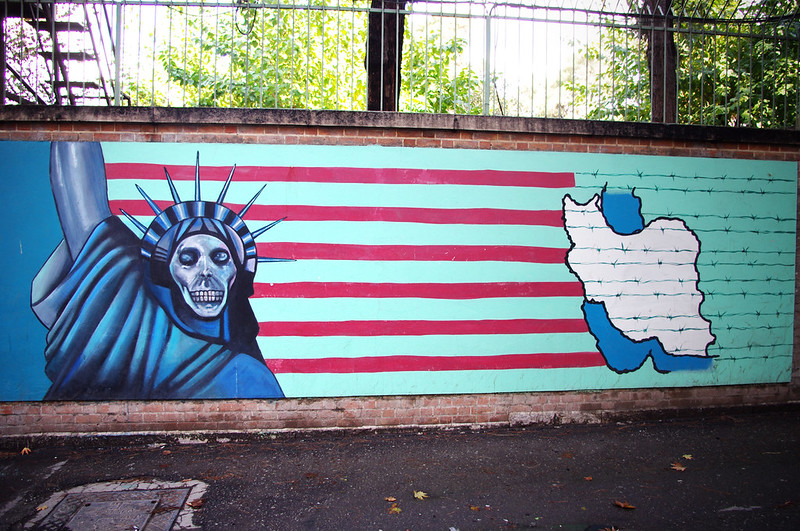
den of espionage, former us embassy in tehran
Further down near Taleghani Station is the former US Embassy in Iran, now called the Den of Espionage and converted into a museum. The site played a particular significance during Iran’s 1979 revolution when students held American diplomats hostage in the embassy for more than a year. The museum grounds offers a colorful throwback to diplomatic life from 40 years ago while the frontage has plenty of colorful anti-American murals, the most famous one depicting the Statue of Liberty with the face of a skull.
After having your fill of Tehran, you can catch a late afternoon or evening bus to the next destination – Kashan, which is around a 3-hour drive. There are plenty of departures each day from the bus terminals and there is no need to book in advance, with the exception of major holidays like Nowruz.
Day 3 – Kashan
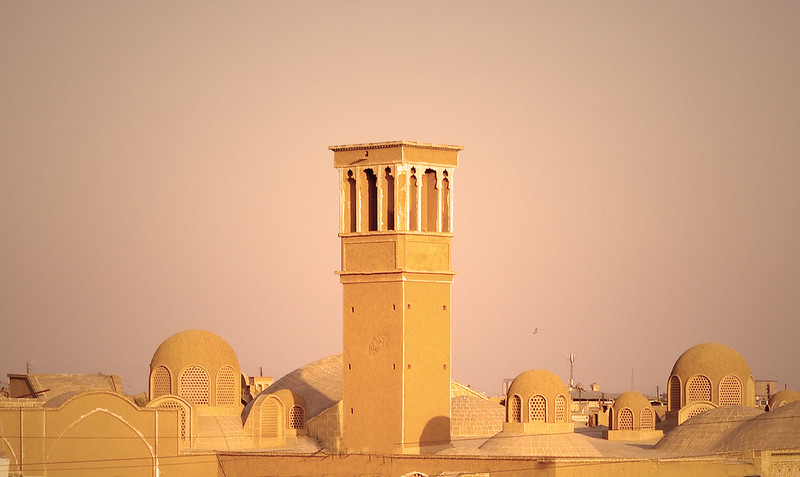
rooftops of kashan
A relatively small town, Kashan, is a must visit especially for architecture lovers. The town has plenty of mansions that were built by rich merchant families and gardens offering a calming perspective to Iranian life – a wonderful contrast from the frenetic pace of Tehran.

historic houses in kashan
There are 4 old houses you need to visit in Kashan and these are the Boroujerdi House , Ameriha House , Tabatabaie House and the Abbasian House . All these houses boast of intricate facades but it is the Boroujerdi House which has the more stunning carvings and interiors of four while the Tabatabaie House is probably the biggest. Note that the Ameri House has been converted into a hotel as of late.
Located in the same area as the old houses is the Sultan Amir Ahmad Hammam , also known as Qasemi Hammam. Bathing was an elaborate ritual in old Persia and this is manifested in no small part in the elaborate design of the bathing pool. Covered in turquoise and gold tilework, floral patterns as well as utter symmetry that will delight architectural buffs, the bathhouse is an interesting place to visit even though it is no longer used. You can also check out the rooftop for a view of the hammam’s bulbous domes as well as the windcatchers from the mansions in the distance.
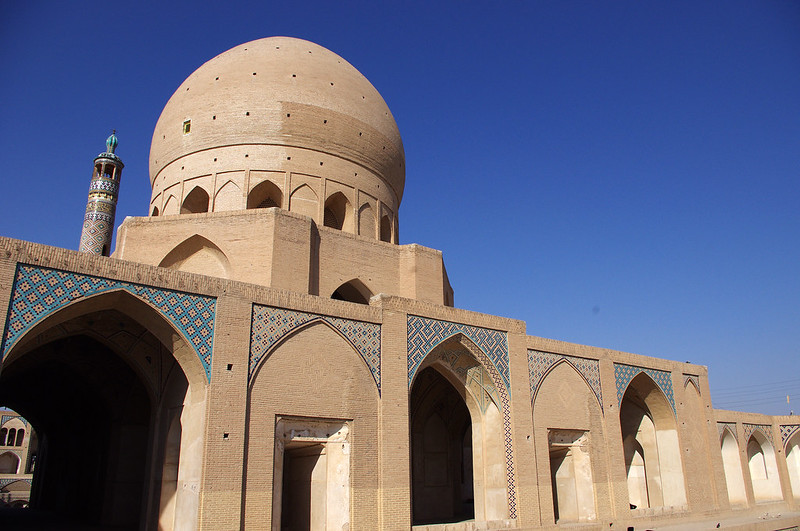
agha bozorg mosque
On the way to the bazaar of Kashan, the 18th century Agha Bozorg Mosque is a recommended stop for its symmetrical design and layered courtyard that extends underground.

Optional: If you have a half-day to spare in your Iran trip, an excursion to the village of Abyaneh is recommended. The town is known for its reddish hue which permeates all the buildings. Visiting here is all about soaking the charming ambiance and interacting with friendly villagers. There is no specific must-see here except for the panorama of the reddish village from afar.
With the exception of Fin Garden , the bulk of Kashan’s tourist spots are within walking distance of each other so my suggestion is to visit the Fin Garden as a stop if you are going on a day trip or excursion to Abyaneh. Otherwise, you can hire a taxi or private car to get you there and back to town. Fin Garden is a typical example of a Persian style garden – characterized by a long water feature that leads to a central structure – and is a UNESCO World Heritage Site.
Day 4 – Isfahan
Catch a morning bus to the city of Isfahan. From Kashan, the trip to Isfahan takes just a little under 3 hours.
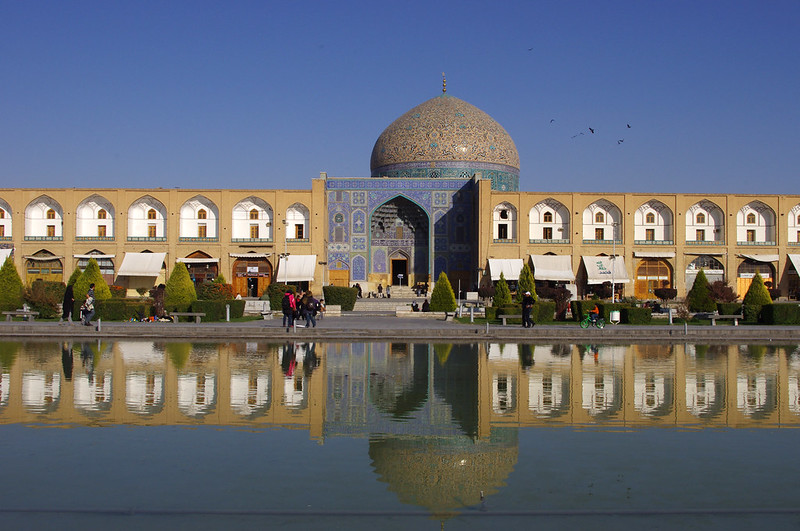
sheikh lotfollah mosque
Called half the world by Iranians, Isfahan is easily the most touristy city in Iran, and with good reason. Its humongous and spectacular public square – the Imam Square – is one of the highlights of any visit to Iran. Flanked by the Sheikh Lotfollah Mosque on one side and the Imam Mosque on the other, as well as well-manicured lawns and horse-drawn carriages going around, this public square is the second largest in the world after Tiananmen Square in Beijing.
Located at the opposite side of the square, the Ali Qapu Palace is another place worth visiting. The highlight here is the music room which have deliberate and attractive holes on the walls to help with the acoustics.
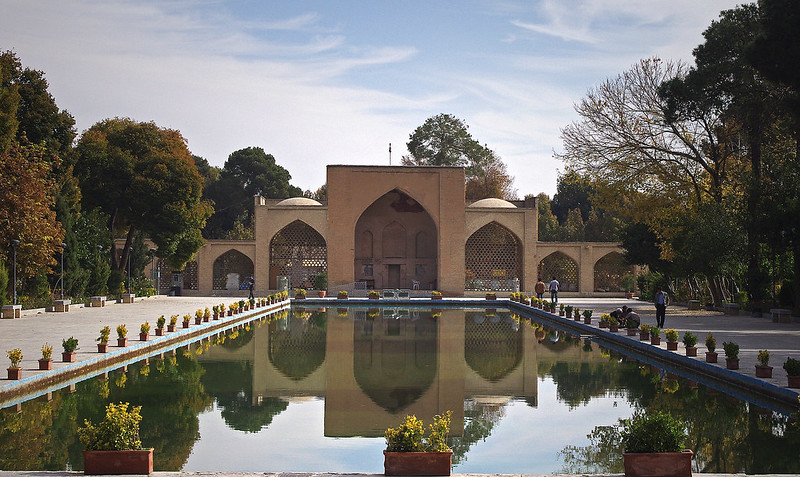
chehel sotun palace
Around a 5 to 10 minute walk to the west of the square is Chehel Sotoun , also called the Palace of 40 Columns. Located in the middle of a park, the interiors of this palace is marked by grand frescoes depicting ancient battles (the Battle of Chaldiran in particular) while the exterior has 20 columns supporting it. Despite only having 20 columns, the 40 columns in the name is brought about by the reflection from the elongated pool in front of the palace, which when reflected shows 40 columns.
Another palace to check out in the area, to the south of Chehel Sotoun, is Hasht Behesht . This is another palace surrounded by a park and is notable for its elaborate ceilings.
If you still have time after this, a walk back to Imam Square is highly suggested. The square takes on a different scene at nightfall, with families out and about and many of the buildings floodlit. The sound of the Islamic call to prayer with the square as backdrop is perhaps one of the most exotic moments one can experience in Iran.
Day 5 – Isfahan
There are plenty of things to see in Isfahan so 2 full days is just about the bare minimum. For the second day, you can check out the attractions farther out from the square – including the Jameh Mosque, Vank Cathedral as well as Sio-se-pol Bridge and Khaju Bridge. The bridges are best visited towards sunset when they’re lighted up so I would suggest starting at the Jameh Mosque.
The Jameh Mosque of Isfahan is the main mosque of the city and became a UNESCO World Heritage Site in its own right in 2012. It is the oldest mosque in Iran that still stands to the present day, dating back from the 8th century. Adjacent to the mosque is Isfahan’s own Grand Bazaar. While not as charming as the bazaar around Imam Square, the former presents a more authentic side to local life.
A nice change from the mosques is the Vank Cathedral , a church located in the neighborhood of Jolfa south of the river. The cathedral is a stunning mix of Islamic and Christian architecture, with all the hallmarks of Persian-style symmetry. From the outside, the church actually looks like a mosque with its bulbous dome but once you’re in, you’ll see frescoes depicting Biblical stories such as Adam & Eve as well as events from the life of Jesus Christ. The area surrounding Vank Cathedral in particular, is brimming with cafes, and is a nice place for an afternoon rest especially when it gets very hot.
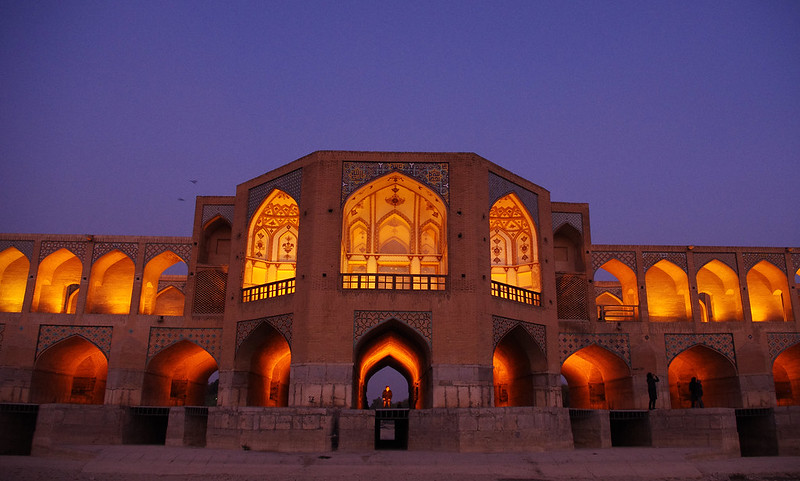
khaju bridge
As night falls, head over to check out the two beautiful bridges – Sio-se-pol as well as Khaju Bridge which are both lit up. Even during the dry months when you can barely see the river, these 17th century bridges still function to transport people between the north and south side of the city.
Day 6 – Yazd
Many travelers tend to bypass Yazd in their Iran trip due to its slightly out-of-the way location from the main north to south route. To do that would be a mistake, in my opinion. Yazd is different from the other cities. There is a romantic, fairy-tale like quality to this town that brings to mind stories such as Aladdin. Think: maze-like alleyways made of clay, bumping into random mansions or historic houses turned hotels and being invited to rooftops to appreciate the windcatcher-dominated skyline of the old town.
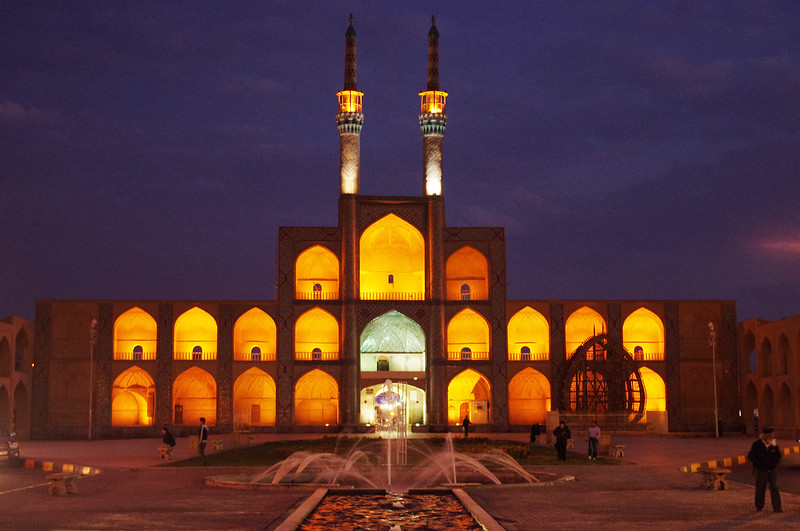
amir chakmaq mosque
Although there are quite a few sights in town, wandering and getting lost inside the old town is perhaps the biggest draw of the city. The most recognized building in town, the Amir Chakmaq Mosque , is worth a visit. The structure is noted for its arched alcoves which get lighted up at night. I visited twice – once during the day, and another time to appreciate it at night. Just next to the Amir Chakmaq complex is a zurkaneh or a house of strength. The Saheb-al-Zaman Zurkaneh (workouts occur Saturday to Thursday from 7 to 8PM) is the place to go to witness men working out using traditional wooden clubs – in sync to the tune of local music and trance-like chanting.
Another interesting place to visit in Yazd is the Atashkadeh or the Zoroastian fire temple. A nice break from Islamic architecture, this is the place to visit to understand more about one of the world’s oldest religions. The temple also contains what is said to be the oldest continuously burning flame.
Day 7 – Yazd
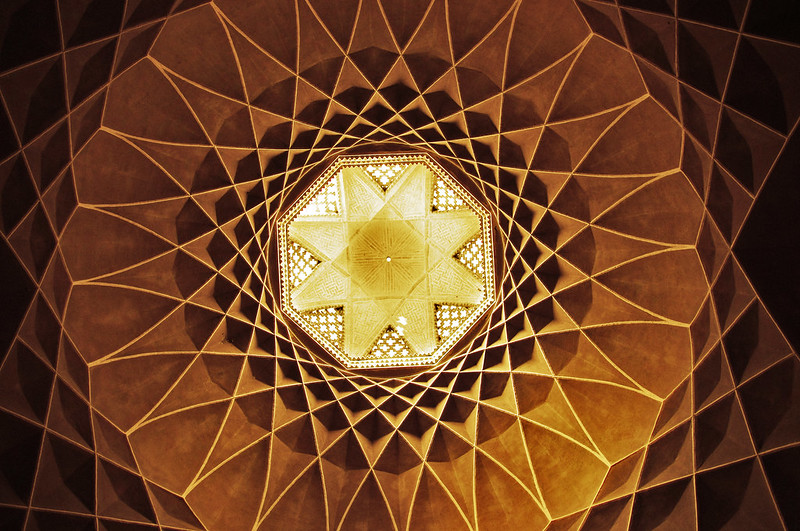
ceiling of dolatabad gardens
Your second day in Yazd can be spent visiting attractions you did not manage to cover the previous day. While there are still more to see in Yazd such as the Dowlatabad Gardens (a UNESCO World Heritage Site), the Water Museum for a fascinating peek of how water is distributed in this desert city and Yazd’s own Friday Mosque , I would recommend spending a couple of hours just getting lost in the old town. Perhaps you can stumble upon a nice-looking old house or two. Compared to the ones in Kashan, some of the traditional houses in Yazd have been converted into restaurants and cafes. It’s a highly atmospheric affair sipping on a cup of tea (or two) and downing a hot stew especially on a cold day.
The afternoon can be spent catching a bus to the next destination – Shiraz. The Yazd to Shiraz bus ride is the longest in this trip and takes over 5 hours. It will be well into the evening once you arrive in Shiraz.
Day 8 – Shiraz
There is probably no other city in Iran that conjures romantic images as much as the city of Shiraz. The city of poets as well as wine. This city is undoubtedly the premier city in the southern part of Iran and the well-developed infrastructure attests to this. Despite the city’s size, many of the sights are actually within walking distance from the main street – Zand Boulevard.
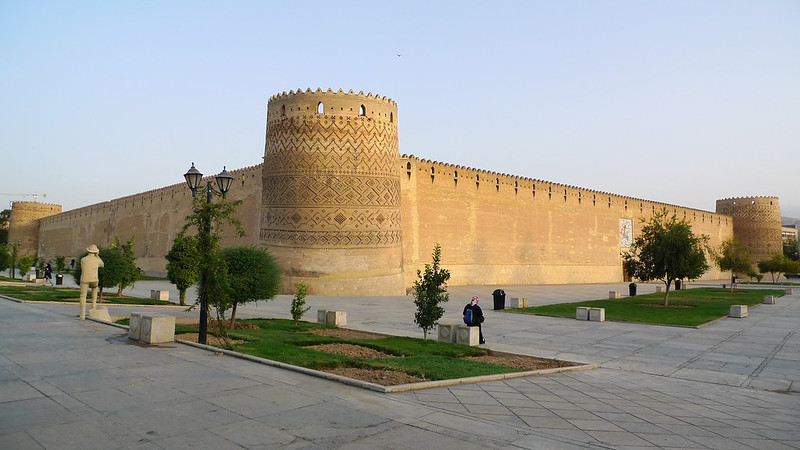
arg of karim khan
Start your day at the Arg of Karim Khan , an 18th century brick citadel typical in the Middle East. Its location and traditional appearance near a busy roundabout in downtown Shiraz makes for an interesting contrast.
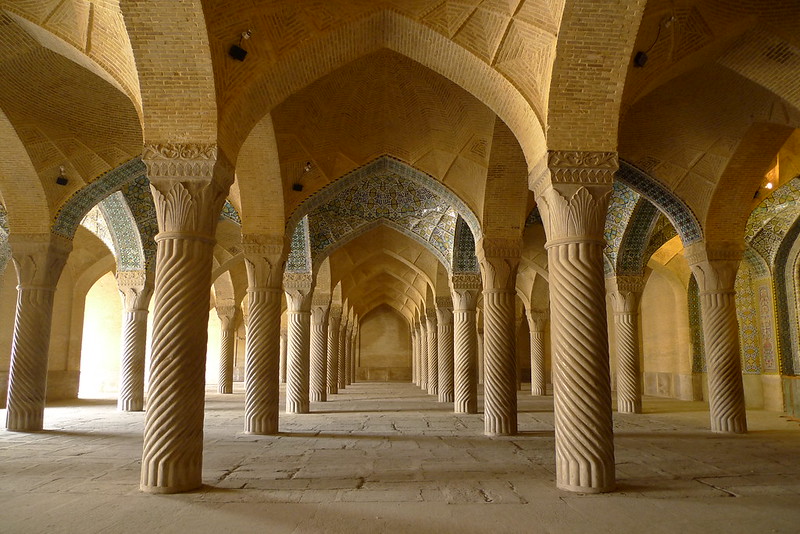
vakil mosque
Turn right and walk through Vakil Bazaar where you can make a stop at the Vakil Mosque with its spectacular columns. Next, make your way to Lotf Ali Khan Zand Street which is parallel to Zand Boulevard. Your priority in the morning should be to visit Nasir-ol-Molk Mosque . Just another mosque you say? If you are active in social media, especially instagram, this is one place you must check out in Shiraz. Within walking distance from the mosque is the Narenjestan Garden , the first of many gardens you will encounter in Shiraz. The gardens and the house within the compound were built by the wealthy Qavam family in the 1800s. The gardens are known for its tile work depicting 3 figures from the Qajar Dynasty.
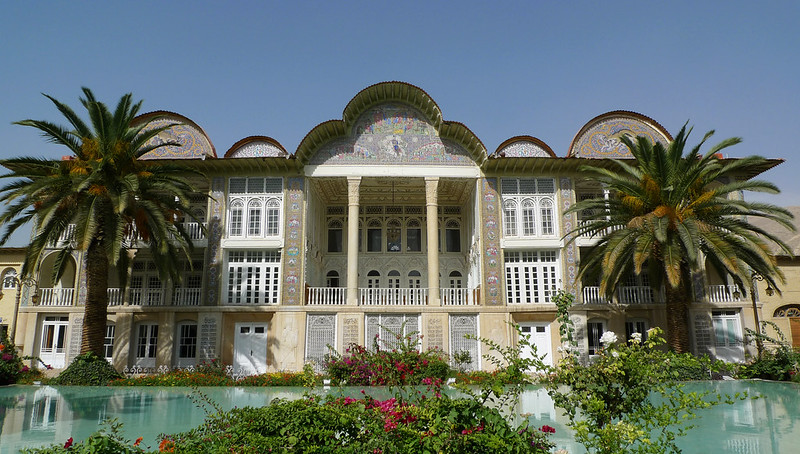
eram gardens
The rest of the day should be spent visiting sights that are further afield. The Eram Garden , is in my view, the most impressive among Iran’s gardens. The building fronting it, is painted in a soothing white and is decked with numerous paintings. From Narenjestan, allow around 15 minutes drive.
Day 9 – Persepolis

Allow around half a day to venture out of Shiraz to visit the biblical city of Persepolis. One of the great wonders of the world, ranking up there with Angkor Wat, Machu Picchu, the Forbidden City and Taj Mahal; this ancient city embodies Persian heritage so much so that the last Shah of Iran used it as a site for his coronation in the 1970s.
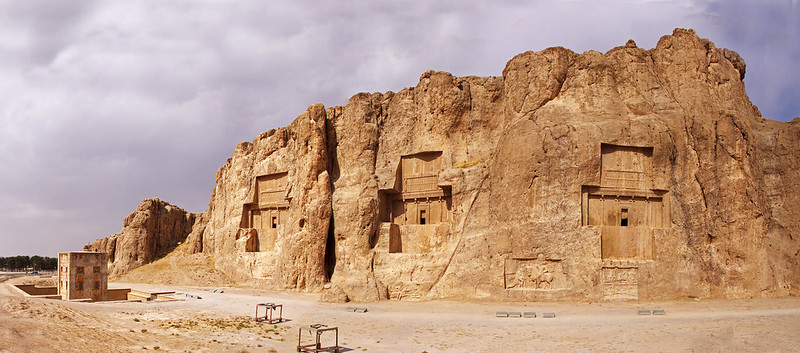
naqsh-e-rustam
Although laying in ruins, there is still quite a bit of structure left to allow visitors to imagine what it must have looked like back in the day. Bas reliefs on the walls show how various civilizations paid tribute to the Persian empire, bringing gifts to the king. To reach Persepolis, you can book a private tour which includes a visit to Naqsh-e-Rustam as well.
With a morning departure, you can expect to be back in Shiraz by earl afternoon, after which you can spend the rest of the day doing some last minute souvenir shopping or catching your flight out of Iran.
Tips for Visiting Iran
- Many nationalities can obtain a visa-on-arrival for Iran, but there are cases where having a pre-arranged visa or visa authorization code makes sense such as for avoiding long waits at the airport for getting the visa. You can get a pre-arranged visa authorization code if you prefer to avoid that risk.
- Iran is still mainly a cash society. You’ll find that your Visa, Mastercard and American Express credit cards don’t work. Euros and US Dollars work best for changing money. Many merchants even accept direct payment in these currencies over the ever-depreciating Iranian Rial.
- Many merchants have the habit of quoting prices in tomans rather than Rial, which is the official currency. As a rule of thumb, 1 toman = 10 Rial.
Where to Stay in Iran
Tehran – Pretty much a budget option, Firouzeh Hotel has been a favorite among intrepid travelers particularly due to its very helpful receptionist/s who can give plenty of tips on Tehran.
Kashan – One of the city’s tourist attractions, the Ameriha House, has been turned into a hotel called Saraye Ameriha Boutique Hotel and is currently the top-ranked hotel in Kashan. I personally stayed at the Ehsan House just a few blocks down the road. It’s clean, adequate and also presented in the Persian style, though with less character than its top-ranked rival.
Yazd – Hidden within the snaking alleys of the old town, Kohan Hotel is a charming option with its traditional courtyard typical of houses in Yazd as well as Persian style rooms. If the caretaker is feeling extra friendly, you might be invited up to the rooftop to check out the hotel’s windcatcher as well as admire the ones from the neighboring houses.
Esfahan – For unabashed Persian splendor, the palatial Abbasi Hotel is generally considered the most luxurious hotel in Esfahan though newer boutique options such as Ghasr Monshi Hotel are taking market share away from the Abbasi.
Shiraz – Darbe Shazdeh is a beautiful boutique hotel located not far from Vakil Mosque. Some rooms come with glass stained windows similar to the ones in Nasir ol Molk Mosque. For a more budget option, Sasan Hotel is a reliable hotel just off Zand Boulevard
You May Also Like

Hi, my name is Bino and I started I Wander around 15 years ago with the aim of sharing about some of my personal journeys and experiences, hoping that the information may benefit readers like yourselves. Let me know your thoughts by leaving a comment below. Alternatively, you can also email me at b i n o (at) iwandered.net. You can follow I Wander on Facebook , Telegram , or Instagram . Also, if you liked this article, please feel free to SHARE or RETWEET
More Posts - Website
Reader Interactions
Older posts.
December 3, 2019 at 5:42 pm
I have been thinking of a trip to Iran for a while now and your post is a great starting point for a tour of the country. I wasn’t aware of the beautiful Kashan, thank you!
Leave a Reply Cancel reply
Your email address will not be published. Required fields are marked *
Save my name, email, and website in this browser for the next time I comment.
Notify me of follow-up comments by email.
Notify me of new posts by email.
Security Alert May 17, 2024
Worldwide caution, update may 10, 2024, information for u.s. citizens in the middle east.
- Travel Advisories |
- Contact Us |
- MyTravelGov |
Find U.S. Embassies & Consulates
Travel.state.gov, congressional liaison, special issuance agency, u.s. passports, international travel, intercountry adoption, international parental child abduction, records and authentications, popular links, travel advisories, mytravelgov, stay connected, legal resources, legal information, info for u.s. law enforcement, replace or certify documents.
Share this page:
Iran Travel Advisory
Travel advisory january 11, 2024, iran - level 4: do not travel.
Updated to add the Terrorism Risk Indicator and risk of surrogacy tourism.
Do not travel to Iran due to the risk of terrorism, civil unrest, kidnapping and the arbitrary arrest of U.S. citizens . Exercise increased caution due to wrongful detentions .
Country Summary: U.S. citizens should not travel to Iran for any reason. U.S. citizens visiting or residing in Iran have been kidnapped, arrested, and detained on spurious charges.
Iranian authorities continue to unjustly detain and imprison U.S. nationals, particularly dual national U.S.-Iranian nationals--including students, journalists, business travelers, and academics--on charges including espionage and posing a threat to national security. Iranian authorities routinely delay consular access to detained U.S. nationals and consistently deny consular access to dual U.S.-Iranian nationals.
Violent extremist groups, including U.S. government-designated terrorist organizations, operate in Iran. ISIS and affiliated groups have claimed responsibility for bombings and other attacks in Iran. The threat of terrorist activity persists, as does the risk of death or injury to bystanders.
The U.S. government does not have diplomatic or consular relations with the Islamic Republic of Iran. The U.S. government is unable to provide routine or emergency consular services to U.S. citizens in Iran.
Companies offering surrogacy services in Iran are misrepresenting the security situation in Iran and the risks of the unregulated surrogacy tourism industry. Private companies that arrange such visits and services put U.S. citizens in danger.
Due to the risks of operating civilian aircraft within or in the vicinity of Iran, the Federal Aviation Administration (FAA) has issued a Notice to Air Missions (NOTAM) and/or a Special Federal Aviation Regulation (SFAR). For more information U.S. citizens should consult the Federal Aviation Administration’s Prohibitions, Restrictions and Notices .
Read the country information page for additional information on travel to Iran.
If you are currently in Iran:
- Consider the risks involved in possessing dual U.S. Iranian nationality .
- Review your personal security plan and visit our website for Travel to High-Risk Areas .
- Draft a will and designate appropriate insurance beneficiaries and/or power of attorney.
- Discuss a plan with loved ones regarding care/custody of children, pets, property, belongings, non-liquid assets (collections, artwork, etc.), funeral wishes, etc.
- Establish your own personal security plan in coordination with your employer or host organization or consider consulting with a professional security organization.
- Leave DNA samples with your medical provider.
- Have a plan for departing Iran that does not rely on U.S. government assistance.
- Enroll in the Smart Traveler Enrollment Program (STEP) to receive Alerts and make it easier to locate you in an emergency.
- Follow the Department of State on Facebook and Twitter/X .
- Visit the CDC page for the latest Travel Health Information related to your travel.
- Prepare a contingency plan for emergency situations. Review the Traveler’s Checklist .
Travel Advisory Levels
Assistance for u.s. citizens, search for travel advisories, external link.
You are about to leave travel.state.gov for an external website that is not maintained by the U.S. Department of State.
Links to external websites are provided as a convenience and should not be construed as an endorsement by the U.S. Department of State of the views or products contained therein. If you wish to remain on travel.state.gov, click the "cancel" message.
You are about to visit:
Plan Your Trip to Iran: Best of Iran Tourism

Watch The Wanderer
Trending in the forums.
Iran Is Great For
Eat & drink.

Art & history
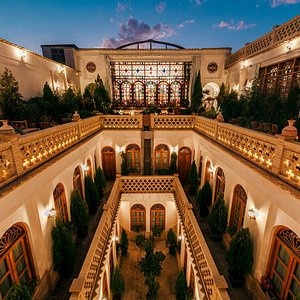
Historic sites
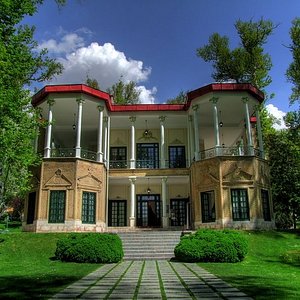
The great outdoors

Tips and how to travel to Iran in 2024
By Joan Torres 99 Comments Last updated on April 11, 2024

Defeat censorship when traveling in Iran
Get access to Facebook and all Google services with ExpressVPN
What used to be a country that everybody believed was filled with danger and nuclear weapon lovers is, today, becoming the destination with the most exponential tourism growth in the world.
From the most hospitable people to the oldest history, stunning architecture, the most desolate deserts, green mountains, islands, and many other things, slowly, travelers are realizing that Iran is the ultimate destination.
However, since it has opened to tourism very recently, traveling in Iran is not that easy, as it presents several difficulties and peculiarities, ranging from strict Islamic rules to credit card issues and even the need to get special travel insurance.
But don’t worry.
After visiting this country twice for more than 2 months, on this blog, I have compiled loads of travel tips for traveling to Iran which will help you to plan your trip easily.

In this travel guide to Iran you will find:
Table of Contents
- Best time to visit
- Accommodation
- Access blocked site s
- Travel Insurance
- Useful books
- Money costs & budget
- Solo female travel
- The people and culture
- Religion and Islamic Law
- Transportation
- Internet & SIM Card
- Food and alcohol
- Other curiosities
- More information
How to book hotels, flights and tours in Iran
Because of the sanctions, foreign cards or popular sites such as booking.com can’t be used in Iran, but now you can thanks to 1stQuest .
1stQuest is a local company that offers services such as visa LOI, hotel booking, tours, domestic flights, and travel insurance for Iran.
5% discount on ALL bookings with voucher code:
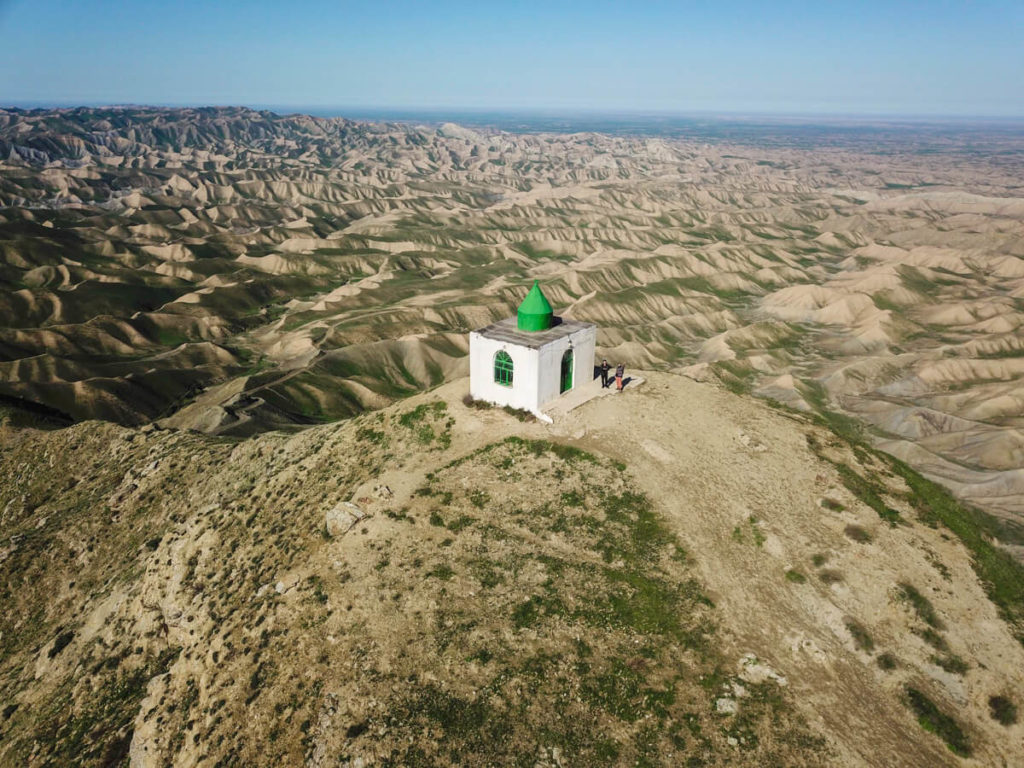
🪪 Visa for traveling to Iran
Visa on arrival (voa) for iran.
Everybody, except for citizens of Canada, UK, US, Afghanistan , Bangladesh, Colombia, Iraq , Jordan, Nepal, Pakistan, Somalia and Sri Lanka, can get a visa on arrival at any of Iran’s international airports.
The only real requirement is to have a valid host contact
During the process of getting your VOA, the authorities may contact your host, whether they are a hotel or a friend. If they can’t contact them, they may make you wait at the airport for a very long time.
Waiting time ranges from 2 to 6 hours
At the very least, you will have to wait for 2 hours at the airport.
On my second visit, I had to wait for more than 5 hours, as I had a brand-new passport and didn’t have a return flight ticket.
How much does the tourist visa for Iran costs?
Prices range from 40€ to 150€, depending on nationality.
I hold a Spanish passport and paid 75€ and I believe that that is the price for the other European nationalities.
You can’t get a VOA if you enter Iran overland
If you travel to Iran by land, you will need to arrange your visa in advance.
How to get your visa in advance
If you don’t want to wait at the airport, want to secure your visa or enter overland, you should get the visa in advance.
For this, you need to get an authorization code from an authorized company, which you will use to easily collect your visa at the airport or embassy (if you enter by land).
I strongly recommend the guys from 1st Quest , a very reliable company that offers plenty of different services for traveling in Iran.
The visa authorization code only costs 29€ but remember that with my voucher code, you can get an additional 5% discount.
My voucher code: ATC-QST
Typically, they give you up to 30 days
A one-month visa is the standard number of days they give for traveling in Iran.
But you can easily extend your visa
You can extend it twice for 30 days. This means that you can be in Iran for up to 90 days. Extensions can be arranged in all provincial capitals.
Iran and Israel
For more details regarding the Israeli stamp, read: Avoid the Israeli stamp – FAQ
Iran doesn’t stamp passports anymore – An Iranian stamp on your passport can be an issue, especially if you are traveling to the USA. That’s why they are now giving your visa on a separate piece of paper.
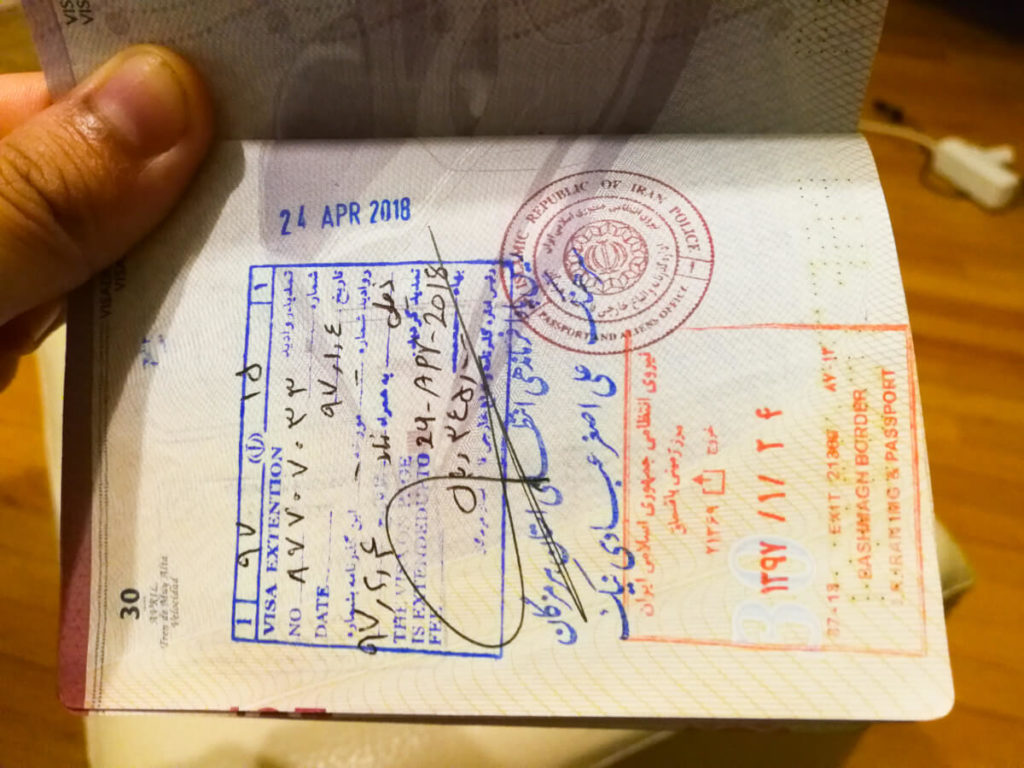
⛅ Best time to travel to Iran
Iran is a massive country with many climatic zones, which range from the dry regions of the Persian Gulf to the wetlands of the north-western provinces.
Ideally, the northern mountains should be visited during late spring, summer and early autumn. On the other hand, the classic Persian cities of Esfahan, Yazd, Kashan, and Shiraz can get utterly hot in summer, so winter, spring, and autumn are the optimum months for visiting them.
Moreover, the southern provinces, which include Qeshm Island , Bandar Abbas, etc. should be avoided during the summer months, as temperatures may reach up to 50ºC and the air is extremely humid.
Last, Tehran has extremely cold winters and overwhelmingly hot summers. Therefore, spring and autumn are the ideal months for traveling to Iran.
You can also visit the Persian cities during the summer months, no problem, but just be prepared for the heavy heat!
What to actually do in Iran From following the classic Persian historical trail to contemplating the magnificent Islamic architecture, trekking, visiting the Persian Gulf Islands, meeting Iranian nomads , making local friends or even making a pilgrimage trip to the city of Mashhad, Iran can be a destination for all types of travelers, both history and adventure lovers.
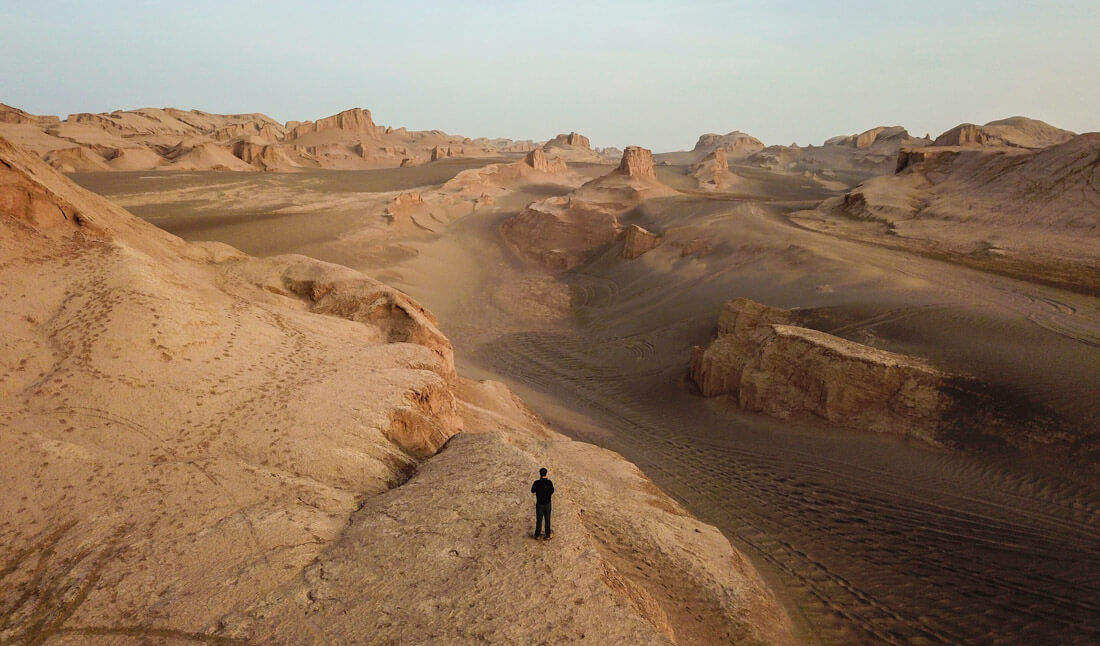
🏨 Travel tips for accommodation in Iran
Because of the sanctions, websites like Booking.com don’t have hotels listed in Iran.
How to book a hotel in Iran?
- Via a phone call
- You just show up at the hotel and try your luck
- Via a travel agency (if you go on a tour)
- Via 1stQuest
Yes, a good alternative would be booking your hotels via 1stQuest because, from luxury hotels to backpacker hostels, they have hotels listed in all the main cities in Iran.
You can get a 5% discount in ALL your hotels bookings.
Use my promotional code: ATC-QST
By the way, keep in mind that the Government of Iran tends to block this kind of travel sites, so 1stQuest may not work when you try to connect from Iran. If this is the case, there are 2 possible solutions:
- Book all your hotels in advance, before traveling to Iran.
- Get a VPN to access all blocked sites. For more information, read how to find the right VPN for Iran .
For more options, check: Best areas to stay in Tehran .
Couchsurfing in Iran
If you are on a budget, you should know that Couchsurfing is very popular in Iran and a great way to get immersed in the local culture, as Iranians are particularly hospitable and you are likely to be treated like a royal guest.
However, bear in mind that some hosts may be extremely intense and may want to be with you at all times.
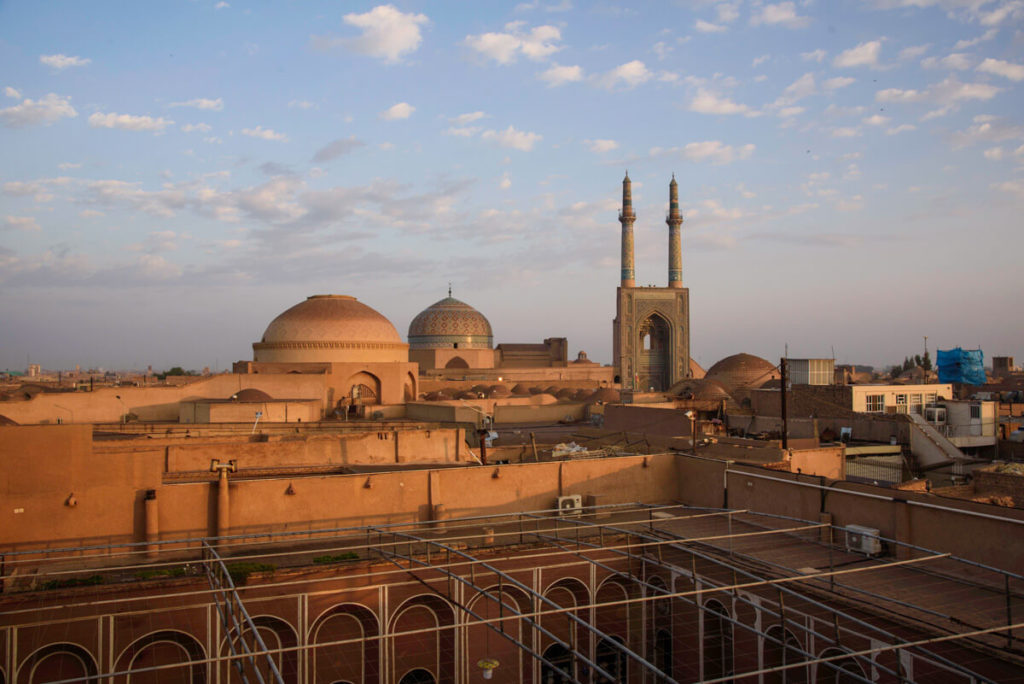
🔓 How to access blocked sites in Iran
Fact: in Iran, many websites are censored, and that includes:
- Some Google services
- Pornography sites
- Against the Compass (Yes, my website)
If you wanna post Facebook updates or just check the international news, you must get a VPN and the one I recommend is ExpressVPN
If you have no clue about VPNs, you should read my tutorial: How to find the right VPN for Iran .
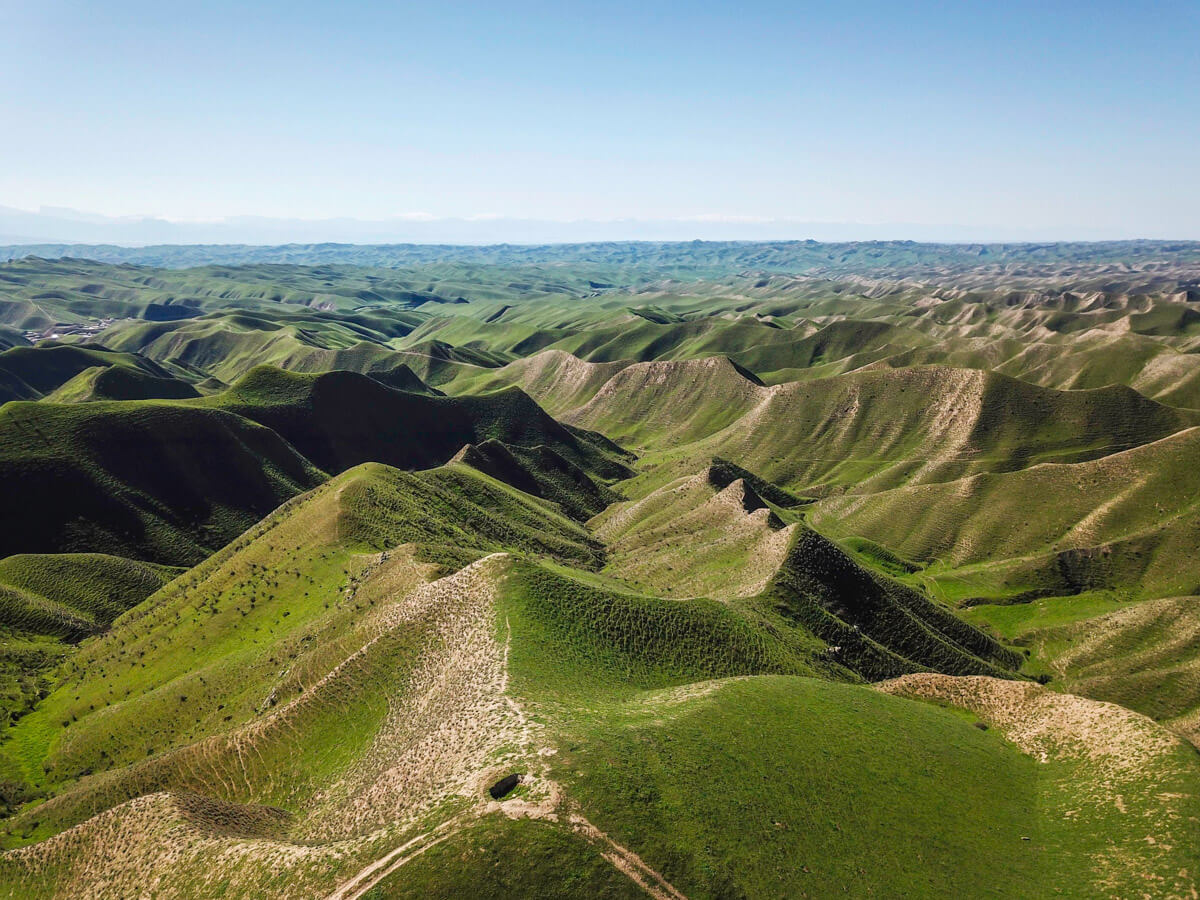
🚑 Travel insurance for Iran
Because of the sanctions, few insurance providers cover travel in Iran. The one which does, however, is IATI Insurance .
Moreover, travel insurance is a must requirement for anyone trying to get a visa on arrival at the airport.
I strongly recommend IATI Insurance for these reasons:
- They have loads of different plans for all travelers: from families to budget backpackers
- Covers for up to 1 year trips
- Readers of this blog can get an exclusive 5% discount .
For more options, read How to find the right travel insurance for Iran

📚 Useful books to plan your trip to Iran
This is just a selection of a few books but since Iran is such a complex country with so much going on, I have compiled this list containing the best books on Iran , classified into history, novels, and politics.
Iran travel guide by Bradt
Bradt has always the most comprehensive guides to the most off-beat countries. I love Bradt because they give plenty of tips for the independent traveler, as well as loads of cultural insights.
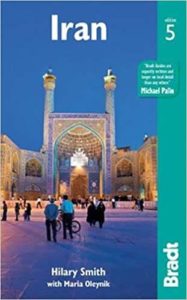
Iran travel guide by Lonely Planet
I personally prefer Bradt but, if you are a Lonely Planet fan, they have just released their latest edition for Iran.

Best political novel – The Cypress Tree
The story of a writer and his family (currently a BBC journalist) who had to live in exile in the UK after the 1979 Revolution. The book is not only a critique of the dictatorial regime but also, he explains, in a very nostalgic way, all the things he misses from Iran.
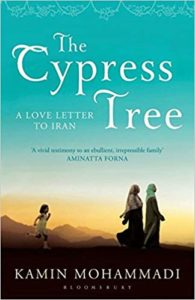
🛫 How to get in Iran
It’s mandatory to have a travel insurance to get your visa on arrival in Iran. Because of the sanctions, most insurance companies don’t provide coverage for Iran, but IATI Insurance does Get your exclusive 5% discount if purchasing via this link.
How to travel to Iran by air
If you come by flight, Tehran would be the most obvious destination, as it has a large number of connections from Europe, especially Germany and Turkey.
Read: Things to do in Tehran in 2 days
Shiraz has also an international airport and there are daily, very cheap flights from Dubai.
Read: Things to do in Shiraz
How to travel to Iran by land
Iran shares a border with many countries but remember that, if overlanding, a visa is not available on arrival, so you will have to get it in advance.
Iraq – Surprisingly easy (the one I used). See here the full report .
Turkey – Another surprisingly easy border to cross.
Armenia – An easy, friendly border. See here the full report .
Azerbaijan – Also pretty easy. Check Caravanistan for more information .
Pakistan – A real adventure. See here the full report .
Afghanistan – Apparently, coming from Herat is relatively easy. Warning! In 2021, this border was taken over by the Taliban. For more information, read my Afghanistan safety guide
Turkmenistan – I am really jealous because you managed to get a Turkmen visa.
United Arab Emirates – You can take a ferry from Sharjah to Bandar Abbas.
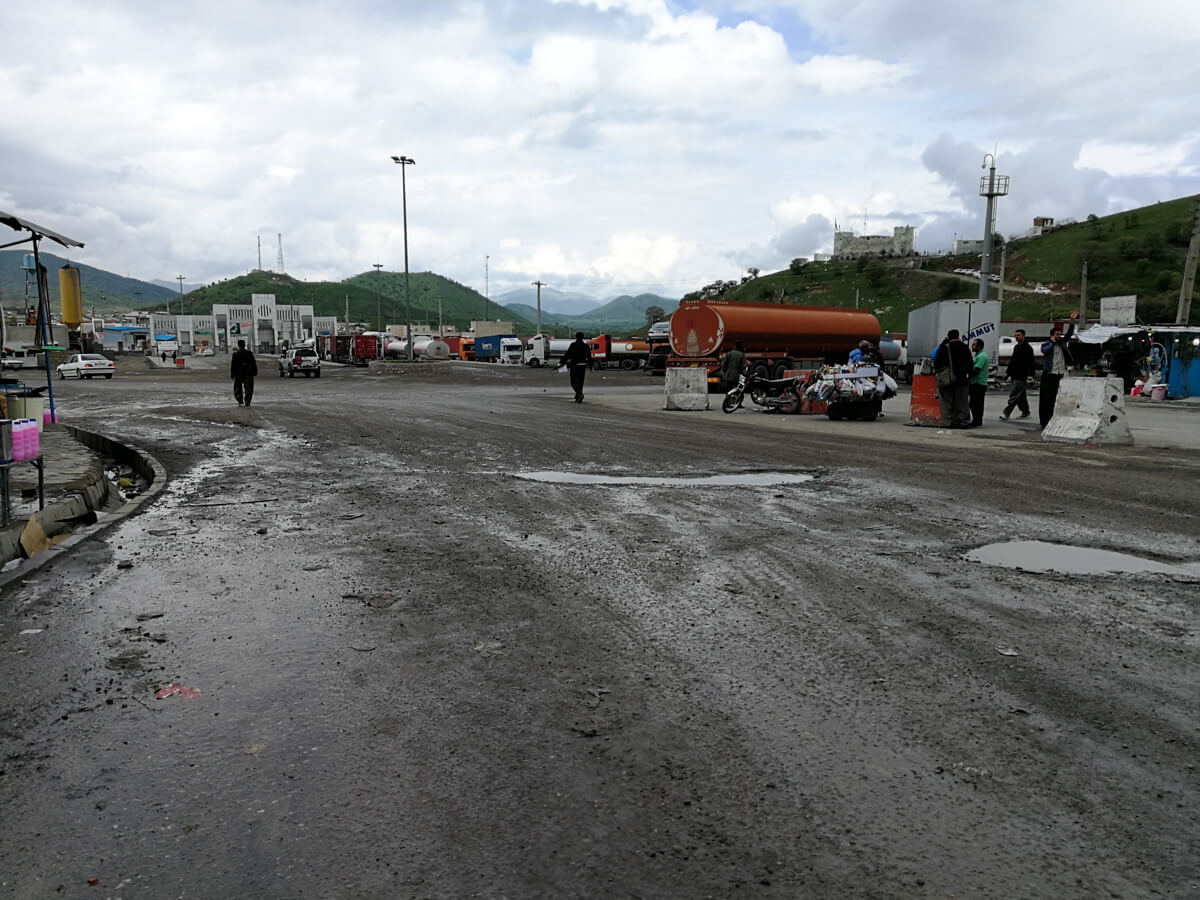
💰 Iran Travel Guide – What you need to know about money
In Iran, they use the Iranian Rial (IRR) and approximately:
1 USD = 42,350 IRR
The Iranian Rial fluctuation is massive
Make sure to check the current rate just before leaving for Iran because the value is so unstable.
Exchanging money in Iran
Exchange offices are available everywhere and €, USD and GBP are always accepted.
Moreover, there is also the black market, which means that, in all cities, you will always find random people willing to buy your currency.
It is fine to exchange with them but just make sure to count your money twice, as some of them may try to trick you.
Wait, Rials or Tomans?
Since their currency is extremely low, in order to simplify things, most places will tell you the prices in Tomans, which is the same value divided by 10.
In the beginning, it is a bit confusing but you will quickly get used to it.
Foreign credit cards don’t work
Because of the sanctions, you can’t use your international credit card when you travel in Iran, so bring cash.
However, you can buy a local credit card
For people who don’t want to be carrying lots the cash, you can buy a local credit card and top it up. There are quite a few companies, for example, Mah Card Iran Travel .
(Note that I have never tried it but was recommended by a friend).
The way it works is that you sign up on their website, give your passport details and they will bring your credit card once you arrive at your hotel in Tehran .
You will give them your cash and pay the 20€ service after receiving your card. I didn’t use it but I’ve been told it is a reliable company.
And you can pay by credit card absolutely everywhere
You will be surprised to know that local credit cards are accepted all across the country, including at street food stalls and grocery shops from rural areas.
Entrance fees
Most touristic sites, including mosques, gardens, and archaeological sites, charge between 100,000 and 150,000IR, which is 5 to 10 more times than what the locals pay.
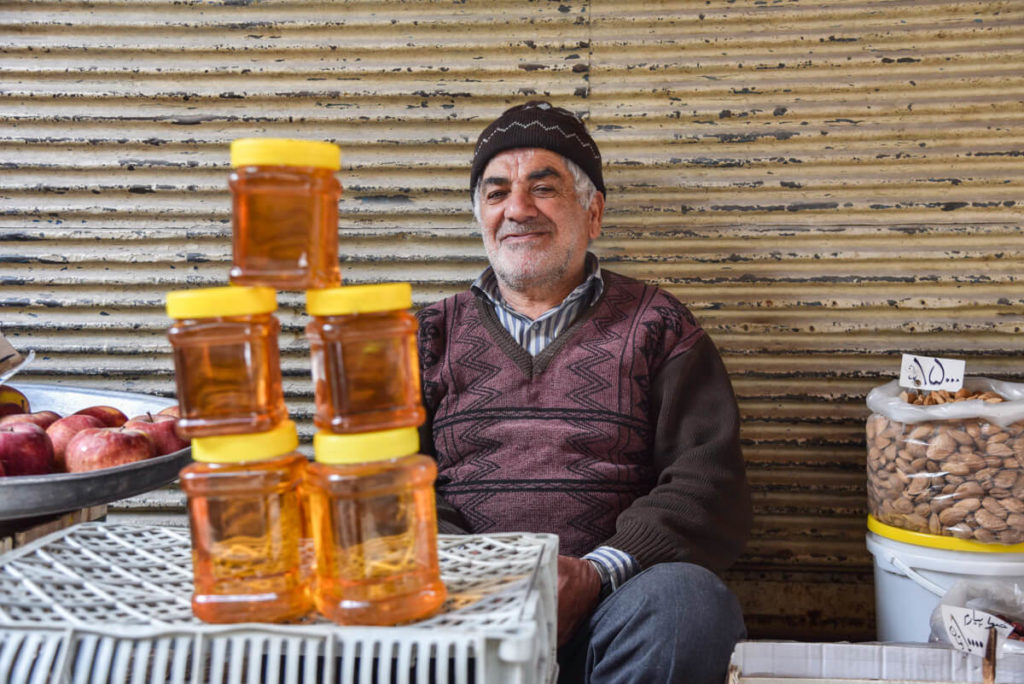
⚠️ Is it safe to travel to Iran?
Iran is it safe to visit iran.
That’s it. It is a safe destination with no terrorism and a very low crime rate.
The UK Foreign advice says that you should avoid traveling to Balochistan and the area bordering Iraq. However, I think that this information is totally biased. You should be fine.
In Iran there is no Islamic State
On many occasions, my friends from back home told me: Be careful with ISIS in Iran! I love my friends but this is a very naive comment because, first of all, Iranians are Shia, hence there are no Iranian linked to ISIS. And second of all, ISIS never made it to Iran.
If you aren’t convinced yet, I urge you to read this comprehensive analysis about safety in Iran .
Iran travel tip – Consider getting off the beaten track I traveled to Iran in 2015 and 2018 and, in only 3 years, things had changed significantly. The classic Persian cities of Yazd, Esfahan, Shiraz, and Kashan are filled with tour groups, overpriced restaurants, and souvenir shops. Local interactions, which usually involve house invitations, are less frequent and rip-offs are common. However, if you just step slightly out of your comfort zone, experiences with the locals can be totally different. Therefore, I strongly recommend visiting other places near the cities, as well as discovering other provinces, such as Golestan, Kurdistan , or the cities of Tabriz and Mashhad.
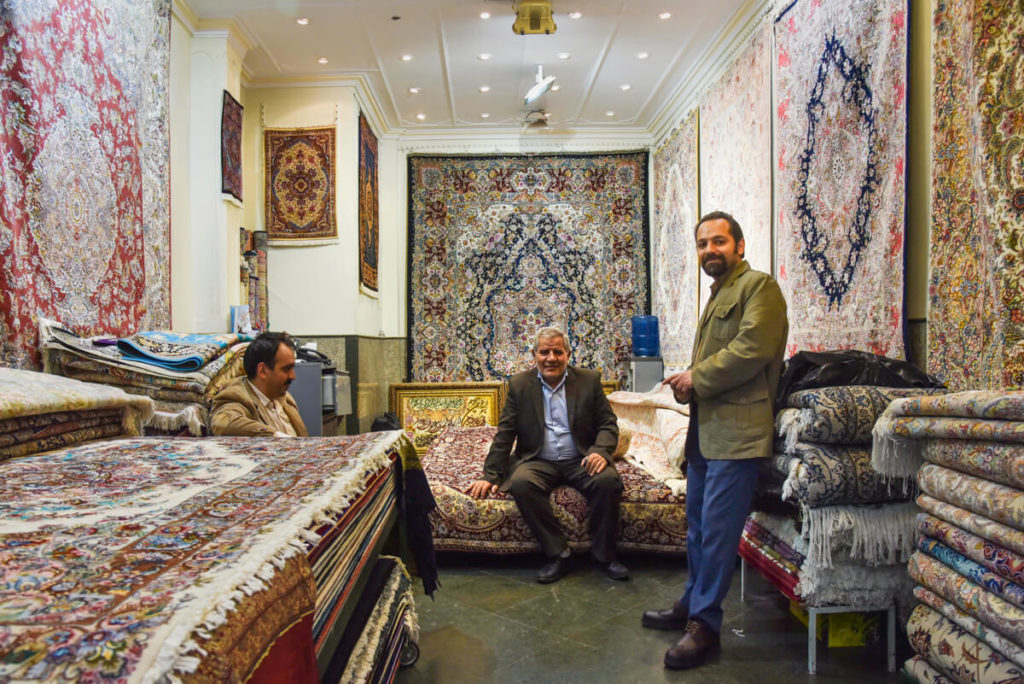
💃 Solo female travel in Iran
Iran is an Islamic dictatorship and, at the same time a day-by-day growing tourism destination, so it is not surprising at all that, every day, this Middle Eastern country is attracting more and more travelers, including many solo females.
Many women have come to me asking for my opinion towards traveling to Iran as a solo female. Well, despite the fact that I am a man and tend to get a very different experience than most women, I don’t know a single lady who hasn’t had a wonderful experience in Iran so, based on their opinions, I can certainly tell that Iran is, definitely, a safe destination for women.
If you want to know more details about it, I recently interviewed Eveline from Earth Wanderess , who shares her travel expertise about solo female travel in Iran .

🕌 The people and culture
Remember that, in Iran, the internet is censored – including Facebook or WhatsApp. If you want to access them and navigate safely, you must get a VPN (Virtual Private Network) and I strongly recommend ExpressVPN , the one I personally use. CLICK HERE TO LEARN MORE ABOUT ExpressVPN
Iran is a highly educated society
Iran is the developing country with the largest number of highly educated people I’ve ever traveled to. Even in very rural, remote areas, such as Golestan, I met people who had Ph.D. degrees from Barcelona and Cambridge.
Iranians are not Arabs
People in Iran are not Arabs but Persians, which is a completely different ethnicity.
Nevertheless, it is ethnically diverse
From the Kurds in Iranian Kurdistan to the Turkmens of Golestan and the Arabs from the Persian Gulf shores, in Iran, there are several ethnic minorities.
Hospitality in Iran
Iranians are famous for their hospitality.
Don’t be surprised if someone who you just met 5 minutes ago invites you to his house, a random dude who you never talked to pays for your meal and, basically, everybody treats you like a king.
They love foreigners and are striving for the world to realize that they are a very peaceful society.
Do accept house invitations
You can’t say you have entirely traveled to Iran if you didn’t have a meal or stay at someone’s home.
Just say yes. If you get slightly off the beaten track and having a meal at a stranger’s house is 100% guaranteed.
Wait, what is tarof ?
If you are traveling in Iran for long enough and have experienced strong local interactions, the locals will tell you about something called tarof .
Basically, tarof is when a local tries to pay for your meal (or anything else) just because it is in their cultural code but they don’t really want to.
Say no and, if they insist more than 3 times, it means that it was a real invitation.
However, if they back off, it means that it was a bluff, so this is called tarof .
Farsi is the official language
Farsi (or Persian), which has nothing to do with Arabic, is the country’s language.
They also use the Arab alphabet.
Educated people speak English
In major cities, most educated people speak impeccable English and, in rural areas, they will speak the basic stuff.
Officially, the weekend is on Thursday and Friday
Iran follows the official Muslim calendar, so Friday is the official day off and, for most companies and the public sector, Thursday and Friday is the weekend.
Read: Things you need to know before traveling to Kyrgyzstan
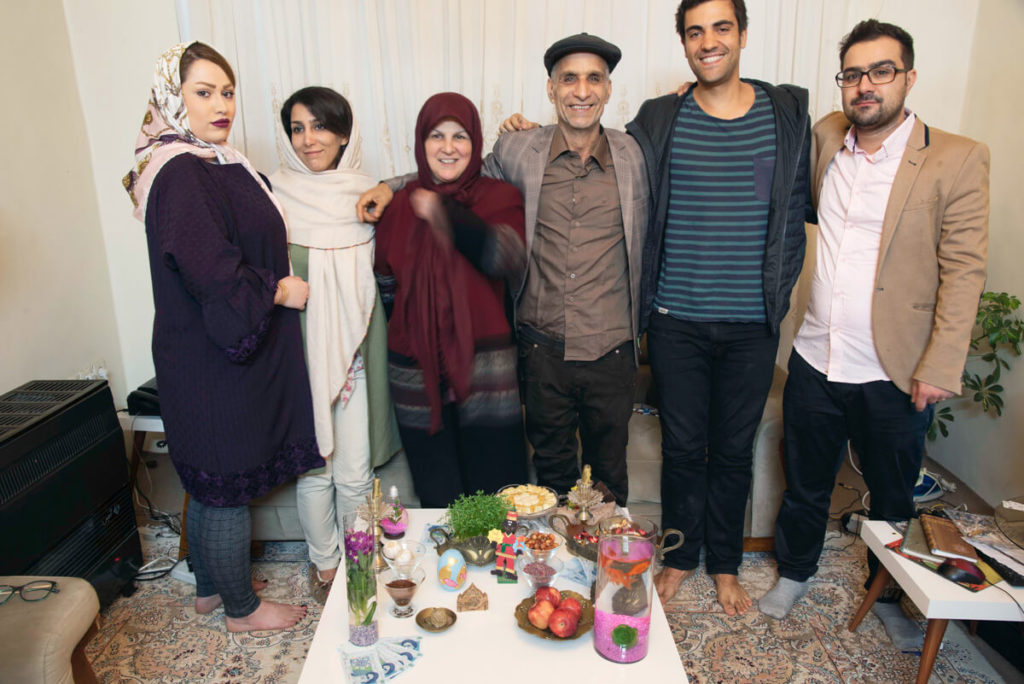
🕌 Religion and Islamic law in Iran
Most iranians are shia.
Iran is the country with the largest Shia population.
However, there are Sunni minorities
In Balochistan, Golestan and the Persian Gulf, there are significant Sunni communities.
Iran is an Islamic Republic
Prior to 1979, Iran was ruled by a Shah who was a puppet of the USA and was leading the country to poverty. This led to a massive revolution, the Shah was overthrown and the clerics came to power, founding the Islamic Republic of Iran.
It’s also a religious dictatorship
In Iran, freedom of speech, demonstration, and protest is extremely limited and several rules based on Sharia law apply to everybody, including tourists.
Dressing code for men
You can’t dress in short pants, even when it is 40ºC. Other than that, you will be fine.
Dressing code for women
Women need to wear a headscarf and can’t show either their shoulders nor their curves. This means that you must wear a long, loose dress or skirt over your pants.
And of course, alcohol is illegal
In Iran, alcohol is forbidden and only available on the black market.
For more details, check the Food & Alcohol section.
Even in this situation, many Iranians are not religious at all
Across your journey, you will meet many Iranians from all ages who don’t care about religion at all, more than in any other Middle Eastern country.
This is because, before the 1979 Revolution, Iran was quite secular.
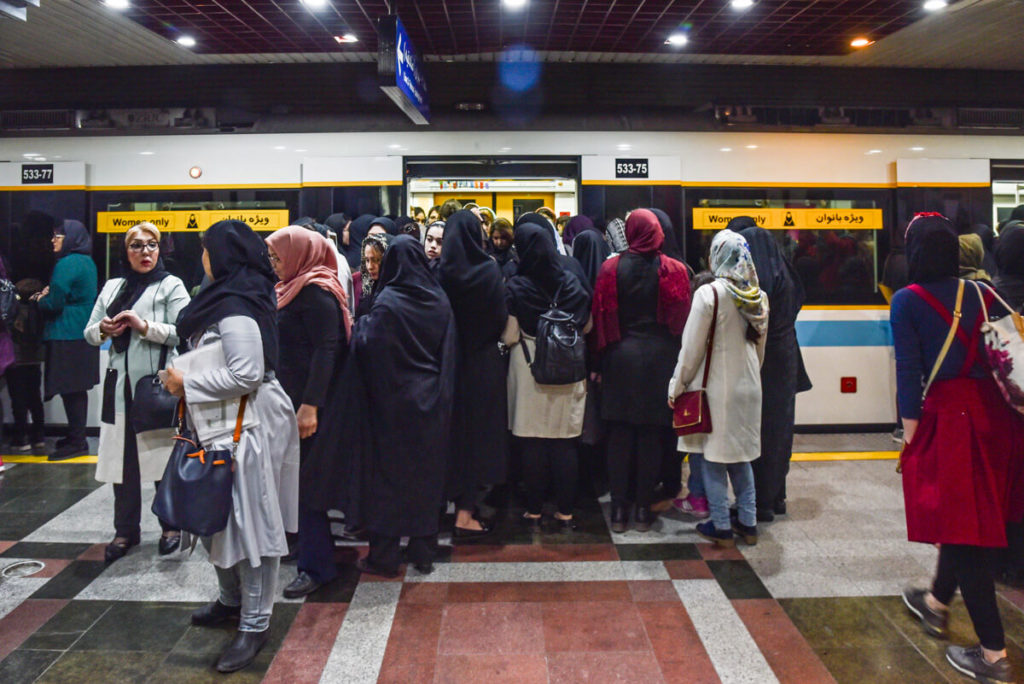
🛺 Travel tips for transportation in Iran
Traveling around iran by public transportation.
They go absolutely everywhere and are the preferred choice for locals.
There are two kinds of buses, the budget one and the VIP, which is around 70% more expensive.
Trust me, get the VIP bus
Seriously, the difference between VIP and non-VIP is so huge. VIP buses are extremely more comfortable, have AC and don’t smell. The cheap buses are horrible and, since they only cost a few USD, paying a 70% extra is not a big deal.
Where to buy your bus tickets
It was kind of a pain in the ass to buy them, as local sites don’t accept foreign cards, so you had to ask your hotel (who charges a high commission) or go to the bus station, which is always far away from downtown.
Because of the sanctions, in Iran, most booking sites don’t accept international foreign cards. Before you could book them via 1stQuest but they are not offering this particular service anymore. However, you may still use 1stQuest for visa services, hotels, flights, travel insurance and tours.
Traveling around Iran by domestic flight
For those who are short on time, there are a lot of domestic flights, connecting most cities in the country.
You can check flight schedules and book your tickets through 1stQuest, and you can get a 5% discount on ALL flights:
With voucher code: ATC-QST
Train is also an option
Some cities have train stations. I personally took a train from Tehran to Gorgan and a 23-hour train from Mashhad to Bandar Abbas. It was pretty cool but not all cities have train stations plus they run less frequently than buses.
Get Snapp for taxis
Snapp is like the Iranian Uber and, as far as I know, it works in Tehran, Esfahan and, perhaps, in other big cities, as well. By default, it is cheaper than regular taxis plus you save all the negotiation hassle.
Tehran, Esfahan, Shiraz, and Mashhad have metro lines. They are cheap, fast and reliable!
Driving in Iran
You can self-drive in Iran, no problem, but just be aware that, like in all the Middle East , people drive like crazy.
Crossing the streets in Iran
For me, the worst thing about Iran is that nobody gives a s*** about pedestrians.
You should know that, when you cross the street, even if you go over a pedestrian crossing, cars will never slow down but will just dodge you. It’s crazy. You should always cross sticking close to a local.
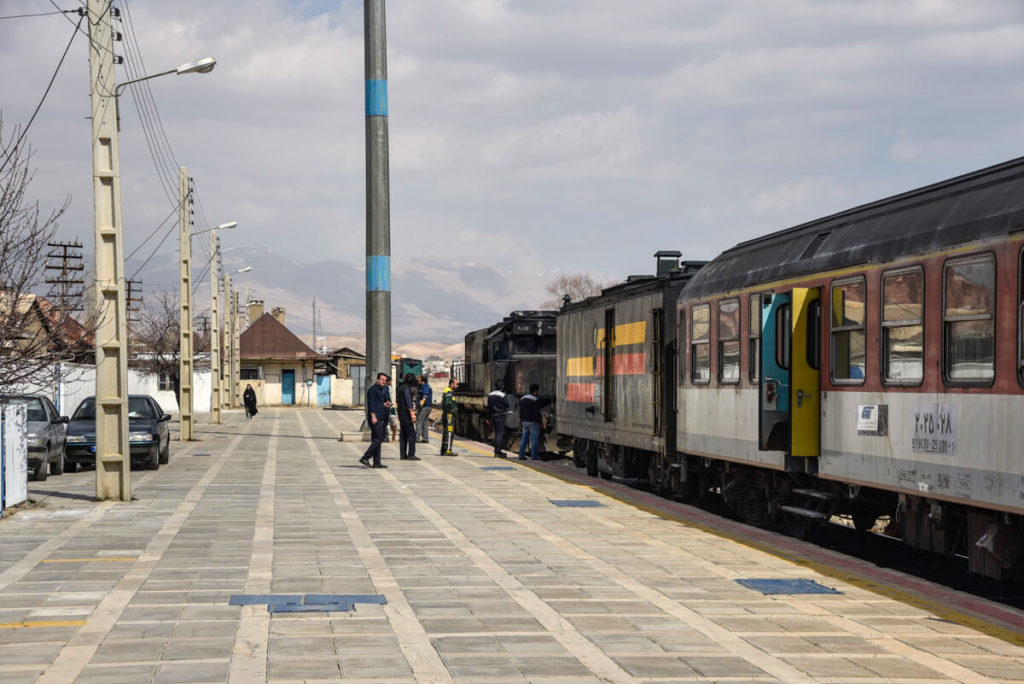
💻 Internet & SIM Card
Wi-fi sucks.
A lot, practically everywhere.
But internet data is good
Wi-Fi sucked so much that, sometimes, I was using my 3G to watch movies.
Get an IranCell SIM Card
In my experience, the staff of IranCell shops speak good English. For just a couple of USD, you will get plenty of GB and calls. I suggest you check their website for the latest plans.
In Tehran, there is an IranCell shop inside Imam Khomeni metro station.
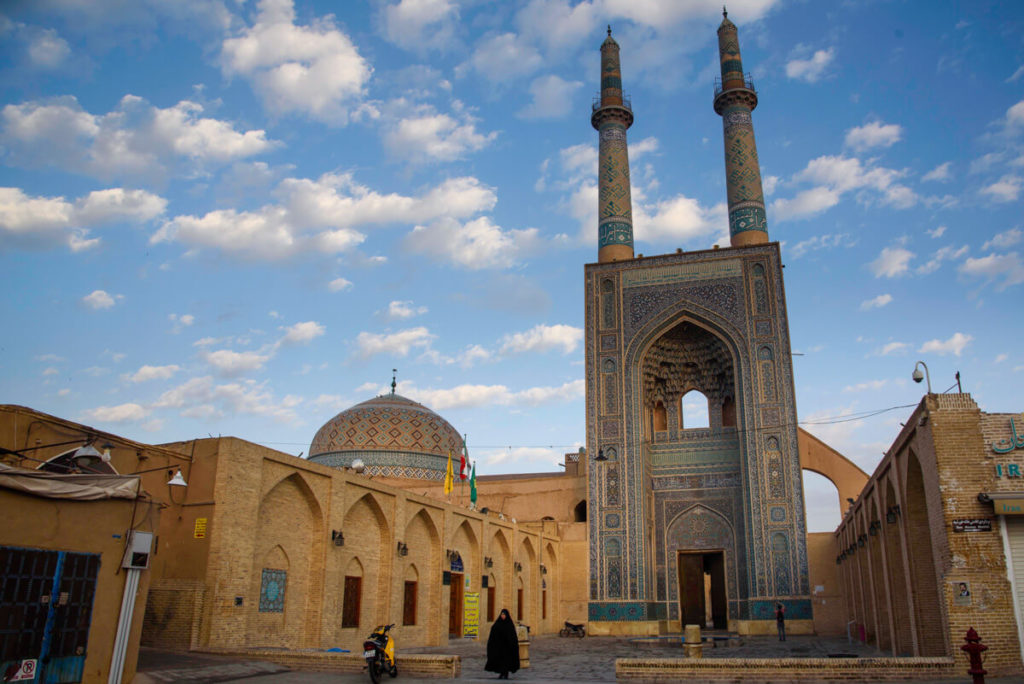
🍲 Food and alcohol in Iran
What is persian cuisine like.
Seriously, I could write an entire post about food in Iran. It is quite varied and many provinces have their own local specialties. Usually, most meals will be accompanied by tonnes of rice and bread.
The most popular appetizers have an eggplant base and main courses tend to be meat with gravy. Kebab is a fancy meal they eat outside.
So far, my favorite dishes are bademjan , an eggplant and tomato stew; ghormeh sabzi , a meat stew with plenty of spices and herbs; ash , a breakfast consisting of a vegetable soup with chickpeas, noodles and caramelized onions; and dizi , lamb (or chicken) smashed with tomatoes, potatoes and chickpeas in a clay pot.
Vegetarians will be OK
For breakfast, they will serve you either ash (the vegetable soup) or an omelet with tomato sauce, as well as cheese, watermelon, and nuts.
For lunch and dinner, there are many eggplant-based vegetarian options, lentils, and rice.
The tea culture is really strong and a sign of hospitality.
The coffee culture is growing!
One of the differences I noticed on my second trip to Iran is that there were coffee places, serving authentic coffee absolutely everywhere.
It was, of course, pricey compared to any other drink but having breakfast over a good cup of coffee is a real must for me.
Alcohol is only available on the black market
It usually comes smuggled from Armenia or Iraqi Kurdistan .
But you are likely to drink
Once, I was hitchhiking in Golestan when a young couple from Tehran picked me up and offered me vodka shots. Another day, the owner of a café served me a real rum mojito.
I also drank home-made liquor at someone’s house in Shiraz and was offered a beer in Qeshm Island.
As I said, many Iranians are not very religious and, if you hang out with local people, eventually, you will be able to have some drinks.
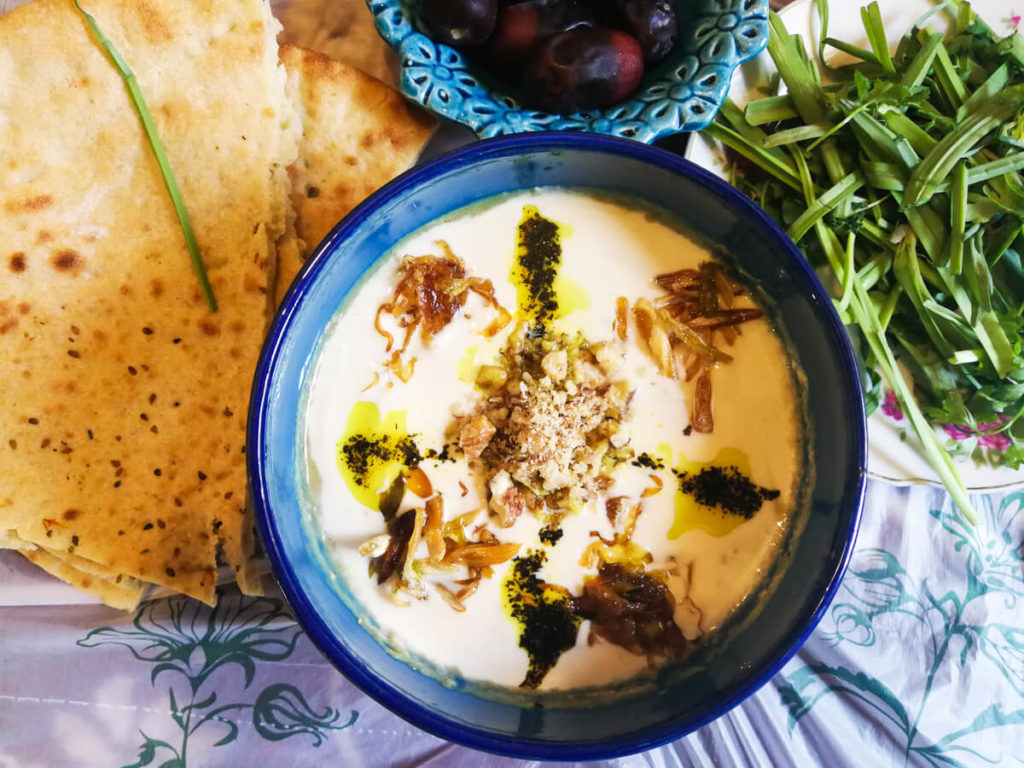
Some curiosities you will see when traveling in Iran
You will see that in most major cities, especially in Tehran and Esfahan, a lot of women wear a bandage on their nose. That is because they just came from surgery. Many Persian women have an arched nose and some of them have a bit of complex about it.
The clerics
Those Muslim priests that you see all over Iran are Shia clergy. Most of them wear a white hat, which means that they are normal people.
However, those wearing a black one are, somehow, related to the prophet Mohammed. Within a period of 2 months, I spotted two of them.
Creepy mannequins
In all bazaars all across the country, clothing shops have extremely creepy mannequins. They tend to be dirty, miss one eye or they have no jaw. I don’t know if the shopkeepers realize how weird this is.
Drought in Iran
In Iran, lack of rain is a real problem and, across the country, many lakes and rivers, including the river that goes through Esfahan, are completely dry. This is one of the biggest concerns for most Iranians.
Read more interesting facts about Iran

❗ More information for your trip to Iran
📢 In my Travel Resources Page you can find the list of all the sites and services I use to book hotels, tours, travel insurance and more.
Remember to always use my code – From booking a hotel to visa services, hotels, flights, travel insurance and tours, if it is via 1stQuest , remember that you can use my 5% discount code, as many as you want, whenever you want: ATC-QST
All guides and articles for traveling in Iran destination
- Iran itinerary
- Best Books about Iran
- Travel insurance for Iran
- VPN for Iran
- Solo Female Travel Guide to Iran
- Tehran Travel Guide
- Qeshm Island Travel Guide
- Travel Guide to Shiraz
- A trip to the desert of the Kaluts
- Trekking Guide to Zagros Mountains
- Meeting the Qashqai People
- Fars Province Travel Guide
- Visa Guide for Iran
- Masouleh Travel Guide
- Travel Guide to Golestan Province
- Iran-Iraq border crossing
- Is Iran Safe?
- Darband Travel Guide
- Best Hotels in Tehran
Travel guides to other countries in the Middle East
- Travel Guide to Oman
- Palestine Travel Guide
- Syria Travel Guide
- Travel Guide to Lebanon
- Iraq Travel Guide
- Travel Guide to Saudi Arabia
- Yemen Travel Guide
You might also like our Pakistan Travel Guide or Azerbaijan Travel Guide .
You will also be interested in: Where in the Middle East is safe? and The most beautiful places in the Middle East .

99 comments
Hey Buddy, you wrote a great helpful article! almost covered all the tips. Btw , I would like to introduce our hostel in tehran to readers of your blog if its possible, HI Tehran Hostel offers excellent value budget accommodation in a convenient location of Tehran, stay with us and see what a difference a stay makes..
Im so happy to see that you wrote a excellent article about my country and specially my city and its beautiful valley(alamut). i would be more than happy to help any travelers in this adventure AS WE ALWAYS SAY (Taste Iran with locals)
Most welcome! Will come back there in September :p
I have just spent a goo hour reading your articles, they are very well and intelligently written! And also more informative than other sites. I am planning a trip to Iran in September too! Safe travels and keep writing awesome articles!
Thanks and hope you will enjoy it! I am traveling back to Iran in October 🙂
Informative excellent article. Though there was small mistake in foods names.
I get what you mean about the heat and humidity in the southern provinces Joan. We house sat during the cool, rainier season in Doha, Qatar last year, across the Persian Gulf from Iran. The homeowners noted temps to 50 C PLUS humidity. Meaning sometimes it feels like 140 F LOL! Insane. Rocking post bro.
In summer, the weather Gulf Area is really bad! I lived there for a few years and couldn’t handle it 😀
Did anyone invite you? Get lost to where you came from.
Thank you for all this interesting information, accurate and recent on top of it! On that subject, something that could also help although quite new it is the mobile app Fairswap. It allows to exchange cash currency in real-time by meeting with each other at a pre-agreed location. Widely, people post their need in foreign currency and if there is someone nearby facing the reverse need, then they can get in touch each other and if both agree, they will meet and make the swap.
By chance, this could be a pleasant way to facilitate connections with locals and get unexpected additional tips.
Thank you Joan for this beautiful blog you have. very accurate and informative, hope you enjoy Iran even more next time. Cheers
Always a pleasure to go back and enjoy Iran 🙂
I’ve also been in Iran recently the people were very hospitable. It’s good to know that there’s a better way instead of carrying cash which caused lots of stress, Daricpay is a credit card for tourists that is acceptable all around the country.
HI, i’m going to Iran in mid April. I have small DJI drone, but i’m not sure if i should take it. I saw you had drone in Iran. How is the law about drones there?
It is risky. If you get caught they will definitely confiscate it, so be careful. When I travel, I check in the main body and then I put the battery in my hand luggage. This way, they never find it.
Hello from Poland, I am planning to visit Iran this summer (unfortunatelly I only have the summers off so I am bracing for the heat). My question is about the windmills of Nashtifan. I haven’t found any info on them here on the blog. (If there is though, please direct me to it). Have you been there? Do you know what’s the best way to get there? Is that area safe since it’s so close the the Afgan border? I would appreciate any info on the matter. Thanks Igor
Hey Igor, haven’t been there, unfortunately, but maybe you should first go to Mashhad? If so, stay at Vali’s and I am sure he will know all the details about getting there
Thnks a lot Joan!
Hey Igor, I’m sarah from Iran,Nashtifan is a city in the Central District, Khaf County,Razavi Khorasan Province,in my country and it’s very beautiful and totally safe and it’s famous because the ancient windmills.
Hello. dear friend,wind mills of nashtifan is in khorasan razavi province. If you want to go there, you have to go to mashhad and then get a bus to khaf. There are taxis that take you to nashtifan. But nashtifan is hot in the summer, the degree is about 50selcius. So I recommend you to go there in spring or atumn.
Also you can arrive ther from islam qaleh- dogharoon border crossing and then get a taxi to nashtifan.
Hi There, how about traveling to Iran while pandemic?is it easy or any term and condition to apply?
Thank you Joan for information and especially the beautiful pictures
Hi You are very welcome to Iran in advance I am SHADI a licensed tourist guide in Iran. I can speak English and Turkish fluently and live in Kashan. I can show you my city, Kashan and its around and many hidden spots in this area and even all around Iran. I can arrange your whole trip in Iran like accommodations, driver guide / tourist guide to make your trip more enjoyable here in Iran. If you like to know better about me and need more information, please feel free to contact me. It will be my pleasure to meet you in Kashan or even all around Iran and be part of your enjoyable trip in Iran. Best regards Shadi
I came across your blog since we are both members of the “Nomadic Matt’s Superstarblogging Blogging Business Course.
I loved reading your blog posts about Iran and found them very helpful. I will be heading to Iran on September 4 and I cannot wait to see Isfahan, Shiraz, Yazd, Persepolis, Kashan, Tehran and a few other places. Before leaving on this trip, I would like to publish a collaboration post “Travel bloggers tips for Iran” and I would be very happy if you contribute and write 150 to 200 words plus send me one photo (preferably in landscape format). I would love to get your impression and what you liked most. Since I am blogging bilingually in English and in German and have so far published every blog post in both languages I would love to translate the post also into German (by myself not automatically by Google Translate).
I have published similar posts before my trips to Uzbekistan, Bhutan, Kazakhstan, Kyrgyzstan and Tajikistan, and before my trip to the Maldives. If you are interested I could send you the links to those posts.
My email address is [email protected] .
I would like to publish the blog post before I leave for Iran on September 4, therefore, I would be happy if you could send me your piece till August 30.
I would be happy if you contribute. Thank you so much in advance.
Cheers Vanessa
Hey joan , I’m sarah from Iran ,i would like to say thank you for your beautiful blog, you have almost mentioned everything,next time when you went to Iran go to Guilan province,Rasht city it’s my hometown I’m sure you will love it♥️♥️
Thank you for your kind message 🙂 I’d really like to go there and explore the mountains of that area
I suggest you to visit Damavand mountain which is highest volcano in Asia. And if you heard about Iranian legends and Myths you would realize that Zahak who is Villain is perisond in Damavand.
thanks so much for your tips, and I want to add that Iran has some of the best dishes in the world. The Persian cuisine consists of a delicious array of stews and different rice among many other dishes. And of course Persian bread.
Your website is not blocked in Iran. I’m using it in iran without vpn
that’s really good news to hear 🙂
Would love to visit but I just can’t bring myself to go to a country where gay men (like myself) have the death penalty.
As an Iranian and also someone who is pro-equality for the members of LGBTQ I wish the situation was different, and that you didn’t have to worry about things such as sexual orientation. It’s true that Iranian government doesn’t have a shining reputation in their treatment of members of LGBTQ community, some of what’s being reported is often exaggeration. It’s not easy to condemn anyone of “sodomy” without compelling evidence, like actual witnesses! (Not that this should be an issue to begin with) What I’m trying to get at is that officials often look the other way, unless there is a case of rape, which was reported by the western media a few months ago, but it was really misrepresented, in that case someone who happened to be gay had raped a boy, that case is not representative of members of LGBTQ community, but a criminal that was proven to be guilty of rape. In either case, I’m not defending the current Iranian government treatment of LGBTQ, and I’m entirely in favor of equal rights for them.
Finally, regarding your point about your sexual orientation, no one will know your sexual orientation unless you bring it up yourself, I for example as a heterosexual male will not demonstrate anything outside of social norms just because I’m heterosexual, for example if I’m in a county whose general female population happen to be my type, I’m not going to approach them in every single instance or be aggressive, you have to gauge the person’s interest before taking a step towards the next step in your relationship. All I’m trying to get at is that there are many, many gays in Iran whether the Iranian government likes it or not, and you may come across them.
Sorry for the long post.
Can I get some information about Tehran university through what’s app number?
It seams that entrance fees to many tourist places are highly increased from October 23. Can you tell me more? Thanks Norberto
Hi Norberto, I don’t know yet but as soon as I get the updated info, I will update the post accordingly
Hi, I live in Tehran and the increasing is not highly. for example the most expensive ticket is less than 2 dollars, visiting Azadi tower.
Hi yes the entrance Fee is increased but it is not to that value that become impossible for tourists to pay that. It is currently about less than 2.5 EUR at an average.
Hello, how are you? First I want to congratulate you on the excellent blog. My wife and I are going to Iran in March 2020. I’m sure your blog will greatly help us.
thanks Carlos, enjoy Iran!
Hello, Transasia Express has started it’s operations once again between Ankara – Tehran. 60 hours long train journey is a beautiful alternative to flights.
Hi Joan Hope You are fine. I want to introduce some more topics about Iran gradually that may be interesting for you and other followers of your fantastic blog! Now I want to talk about the nature of Fars Province and its touristic potential. In Fars Province there exists different mountain peaks that are fantastic for mountaineering. Dena is the highest one and also more, like Ghashmastaan, Delo, Ronj, Bel ans more. It is really worth having experience about that. If these exist interest, I can give more detailed information about them. 🙂
Hi I’m Aria ,as an iranian, your blog was so interesting for me but I noticed the wrong information in this topic :Iran is an Islamic Republic. You have written about shah and you said he was puppet and leading country to poverty! Sorry but you are totally wrong , everything , really everything that you see even our culture is because of shah . I wonder to know who gave you this misleading information about shah.
Lmao Joan i love that part you explain tarof Dude you know iran really well, even better than meee Come here more! -Yasi
I’ve got a big question You said almost everywhere accepts local credit card like you were really interesed… You mean thats… surprisng or something?
Yes, it was definitely surprising. Paying by credit card for a bunch of oranges from a street food stall is something I have never seen before, especially in a developing country, and when I say food stall I mean a local man sitting on the floor with a box
Thanks, Joan! This a great guide for Iran. How easy it is to get accommodation for a solo female traveler? Are there any restrictions?
Hi Joan! Amazing blog full of very useful information! Just reading about it is giving me the itch to pack my back and hop on the first plane to Tehran! 🙂 I was just wondering, how is it with wild camping around Iran? Is it legal? Is it safe? Would it be a good idea to do it in May-June-July? Also by any chance, would you know what is the covid situation at the moment? Thanks so much!! And keep safe 🙂 Aneta
Hi Aneta! About COVID, all I can tell you is that Iran is not issuing tourist visas at the moment, unfortunately. About camping, is definitely safe, not sure if it 100% legal but many travelers have done that. May to June is great time weather-wise, all across the country, The souther shores might be a bit hot though.
Thank you Joan! 🙂
Hello Joan thanks so much for this post! I wanted to ask if you’ve taken Iran Air airlines from or to Azerbaijan? I will be flying to Tehran from Baku and all I can find on Western websites are very long non-direct flights… However, if I visit websites selling Iranian airlines they have direct flights but the calendar is different and I do not understand anything. Any tips on this, please? Also, I saw your last post from January saying Iran does not issue tourist visas. Does that mean I cannot get one in the airport upon arrival? kind regards, Dre
Hi Dre, probably there aren’t any flights because the country is not open for tourism yet. No, as of today, you can’t get in Iran as a tourist. Only business and medical visas.
Hello. I’m an Iranian person. l went to Balochistan province in the southeast of iran in 2019. l didn’t have any safety problem. It’s an amazing province. In north and center of province, there are mountains and desserts, but in the south, tropical fruits are grown. The best season for north and center is spring, and for south is September or july. If you go there, visit maki mosque in zahedan, taftan volcano in khash, remin and beris and gowatr fishing ports in chabahar, kahir and tang gelfeshan in konarak(gelfeshan is a big hill that throws out muds) and tropical gardens in sarbaz and zarabad. If you be smart, you won’t have any safety problem there. Thanks.
Hello, I lived in Iran in the 70s, in Esfahan. I made several Iranian friends. If I get a visa, and a tour guide, may I see these friends when I get there? I have their address, I haven’t heard from them in almost 40+++ years. I haven’t seen them either. Will I he able to visit them? Please let me know.
Hi Katie, the question would be, why wouldn’t you? 🙂
Well I’ve heard I must have a tour guide and that I’ll be watched. I mean can I go to their house without the guide? Do I have to go on a tour. I’ve already seen everything. Thank you for responding.
Hi Katie, some nationalities like Canadians, USA or UK do need to hire a guide but this isn’t like North Korea, and the guide doesn’t need to be with you at all times.
Hello, which Iranian provinces have you traveled to, have you gone to Lorestan ??? Lorestan is one of the most famous and beautiful provinces of Iran, which is one of the best provinces of Iran for tourism. It has very tasty kebabs and food, and kind and hospitable people, I suggest you come.
I took out €400 for my Iran trip. This will create a lot of rials. Will this last enough for my time in Iran, which is 10 days?
Hi Ron, it’s impossible for me to say, since each individual has completely different needs. For me, I target at least 50-60€ a day
Hi! I bought tickets to IRAN (before checking if I can get TOURIST VISA). The flight is tomorrow :((. Do you know if country is open for tourism yet and if I can get a tourist visa at the arrival?
Thank you in advance.
Hi Denis, the country is currently closed for tourism. No visas are issued.
Hello Joan I’m tourist guide and thank u so much for your useful information, beside, I would like to note that WhatsApp is not blocked in Iran but Telegram, Facebook and YouTube are blocked that can be unblocked easily by VPN. best regards Hengameh from Iran
Thanks for this article– very helpful. I will be in Kurdistan Iraq and will have a couple of days to cross over to Iran, do you recommend what places to see that are relatively close to the border as I don’t have much time? Also, I’ll arrange for my visa at the embassy in Iraq since I’m crossing the border by land, but can I hire a driver from Iraq for my entire trip or will I have to change at the border? Thank you!
Mariwan and Sanandaj are nice places, both within Iranian Kurdistan Iraqis need a visa to enter Iran. It’s easy for them, but they need to apply, so I think it could be hard to find a driver who takes you across the border
Thank you for replying and good to know. Will I need a visa into Iran if I am only visiting the Kurd religion of Iran as a USA passport holder? I will only have the visa from the Kurd region of Iraq.
Hey, so Iran Kurdistan is just part of Iran and don’t have special visa requirements. For going there, you just need an Iranian visa. Unfortunately, USA passport holders can only get it through a travel agency.
Hello Joan, Short question. I am planning to travel to Iran in 2022. Does it still hold that ”Iran doesn’t stamp passports anymore”? I am planning also to travel to the USA this year as well through an ESTA visa application (they are not enthusiastic about Iran, as you know). Thank you! JC
Hello, as far as I know, they still don’t stamp passports
Hello Joan: This is an amazing post. My wife and I are planning our trip to Iran. We are really keen on visiting Tabriz, Shiraz, and Tehran. If we were to buy carpets in Iran and try to bring them back to the US – I mean are tourists harassed at the Tehran Airport? In our past trips we had them delivered home but not sure how it will work in Iran. Any guidance is appreciated. Thank you.
Hi there, I really can’t advise you on this… but in my experience, travelers ar never harassed in the airport
Hello people I’m ali and I’m from Iran Iran is safe in 2022, but if you’re a woman, you have to be careful about your hijab, because it is important in Iran. If you are a man, never take your wife or girlfriend in street. Because police will come and… So, WhatsApp is not blocked in Iran, But YouTube, Facebook, Telegram, BBC, twitter and porn sites are blocked. And when you want to use of them you have to connect to VPN I myself use of windscribe Oh I forgot…! PubG is blocked too And about internet… It is too expensive and it is never free
But with all this, Iran is a very beautiful country. You can see different cultures in this country. In different parts of Iran, you will see very good and beautiful cultures. You can also find historical monuments from thousands of years ago In Iran, you can have a lot of entertainment, such as a zoo, a game city, etc., and most importantly, its wonderful restaurants. You can eat local Iranian food that is amazing.You will be amazed at any city or province you visit. The climate in Iran is wonderful. It is humid and rainy in the north and hot in the south. Never miss agriculture in the south of the country.I want to introduce several cities that if you come to Iran, be sure to visit them Tehran Gildan Mazandran Golestan Tabriz Qazvin Zanjan Mash’had Esteban Shiraz Ahvaz Bandar abad Booshehr Yazd
تهران گیلان مازندران گلستان تبریز قزوین زنجان مشهد اصفهان شیراز بندرعباس بوشهر یزد اهواز
Thanks for your interesting post about Iran. have you any Instagram page? and have you had any post on Instagram about Iran?
Hi, yes I do: https://www.instagram.com/againstthecompass/
absolutely no problem 🙂 All touristic hotels welcome anyone
Hola Joan, In a couple of weeks we will be traveling to Iran. We have heard that it is difficult to get diesel/petrol as a foreigner in a petrol station and that a local fuel-card is required when refuelling. Do you have any information about the situation right now?
Mil gracias por el blog! es magnífico 👏 Saludos, Irati
Hello Irati, unfortunately, I am not aware of any of this you mention. Perhaps you should ask in a FB group called Overlanding Middle East
Iranian citizens’ fuel card is used for paying for “subsidized price”. But anyone who doesn’t have fuel card, still can pay for unsubsidized price. However, you need an Iranian Bank card (something like credit card) to pay the price in gas station. In fact, you need such a card to pay everywhere. I don’t know how foreigners solve this problem. Maybe other travelers’ can help you.
Hi Joan, I just love your blog! You have so many interesting and useful information. I have wanted to go to Iran since a long time but I will probably have vacation in December. Will it make sense to go during this month or the weather will be a problem? Many thanks
Hello Valentina, thanks for your message. December is great for going to Iran. While the north of the country will be cold, the south will be great. Personally, I’d prefer to travel to Iran in December than anytime between June and early september-.
Hi Joan, so sorry for my late answer and thank you so much!
Hi Joan, Two weeks ago I checked the search engine for flights and buses form 1stquest and it was pretty useful, but now the links are not working and the website seems to have changed. They don’t offer this service anymore?
Hi Riccardo, you are right, they removed those 2 services because they need to fix a few things on their end but they are currently working on it, even though they didn’t say a specific date
Thank you for your amazing and helpful blog! We would like to come to Iraq Kurdistan and Iran in October this year. Do you know if land boarders from Kurdistan to Iran are open for tourists at the moment? Thank you!! Daniela
It’s usually open but they recently closed due to the clashes in the Green Zone of Baghdad, not sure if they opened in back already but it should
Hi Riccardo, Thanks for this wonderful article! In the section : How to get in Iran – by land, you don’t mention Turkey. Is it on purpose? Be safe, H
we forgot it, thanks for pointing this out!
Hotels and hostels in Iran advice against getting your visa at the airport, because of high rejecting rates. There is an pre-authorisation code that one apply for through an official goverment website. The form is easy and clear. But apparently it can take up to a few weeks to be approved. So apply early! The information on the 1stQuest website is useful, BUT I CANNOT recommend their pre-authorisation application. The form on their website is truely the worst website I have seen in years. It is not even possible to fill in one’s home address or email normally. And it can take hours, even days, for anyone from 1stQuest to reply to questions about the form – and then some of the answers I received were wrong!
Hello and thanks for the great article. What about currently going to Iran? When were you last there? Have you heard from any travellers? My concern is the random arrests that the foreign offices of several EU countries are warning about. What’s your take on it?
Travelers are still going there all the time, everything is great and smooth
Fantastic article. This is one of the best travel blogs I have come across.
I have a specific question and I wonder if you would be able to provide any information by any chance. So, I hold an Indian passport and plan to go to Iran next (I am into travel vlogging), now while trying to get some pre-trip information, I came across some sources suggesting that if I visit Iran, it would be impossible for me to travel to the us in the future.
I did some more research and there is conflicting information with come people having a hard time getting visas to the us (post Iran trip) and some people are like they faced no issues at all. I am also aware that Iran does not stamp passports anymore and also, I will probably club my Iran trip with another border country so I can cross a land border and skip being on flight records to Iran too …, however. … Indian passport is a nightmare to have as it is due to obvious reasons but people like me suffer greatly… now I don’t want any risks because a US visa will open access for me in future to a lot of countries, especially south America…. What do you suggest?
Much appreciated.
I am not sure what is the policy for Indian citizens for Europeans, if you want to travel to the USA, you have to fill out a form and get a simple pre-authorization where they ask questions like: have you ever committed a felony, and stuff like that.
One of the questions is: Have you ever been in any of the following countries since 2011? and Iran is on that list. If you say yes, your entry will be denied, and you’ll have to get the visa via the embassy, but everyone gets it anyways, it’s just a slower process.
As an Indian citizen, you have to go to the embassy anyways, so I can’t tell whether they will be any additional requirements.
Hi Joan, thanks for the excellent, in-depth information in this article. Do you think wi-fi is completely unreliable throughout Iran, including hotels in bigger cities (e.g. Tabriz, Tehran)? I work remotely and don’t need much data for work. Am I just better off buying a SIM card and working with hotspot?
Mobile data is surprisingly fast, much better than WiFi!
Hi Joan, Thankyou for the fantastic article. I am looking at travelling from Pakistan via the land border crossing into Iran and eventually through to Turkey. As this route passes through Balochistan and near to Afghanistan, are you aware if it will be safe to undertake in 2023? Cheers,
Hi Sam, as far as I know, if using that border, you’ll be escorted right from the border to the city of Quetta (for free). Independent travel not allowed there due to security concerns but since you’ll be escorted there’s nothing to worry about
You note that the Visa On Arrival program does not work for US citiizens (like me) and others of problematic passport. Do you have special instructions for us? I understand we can only get a visa by booking a tour through a licensed operator. Last I checked, there were none organized and I cannot afford one on my own.
If an formal tour is still necessary, I’d like to join up with an already-organized one, especially with like-minded travelers (i.e., curious, frugal, ‘backpacker’ types, more interested in culture/life experience than product/service consumption, etc.)–but I’m willing to be flexible.
Know of any?
Leave a Comment Cancel reply
Your email address will not be published. Required fields are marked *
Notify me when new comments are added.
Join our Expeditions
From Syria to Iraq in Pakistan, Against the Compass is finally running expeditions to the most epic and off-the-beaten-track countries.
We have scheduled expeditions for every month of the year.
Latest posts
- How to Travel to Libya in 2024
- Backpacking Venezuela Travel Guide (2024)
- How to travel to Afghanistan during Taliban rule (2024)
- How to visit Los Llanos in Venezuela
- How to visit Angel Falls and Canaima National Park
Iran Travel: The Complete Guide You’ve Been Waiting For!
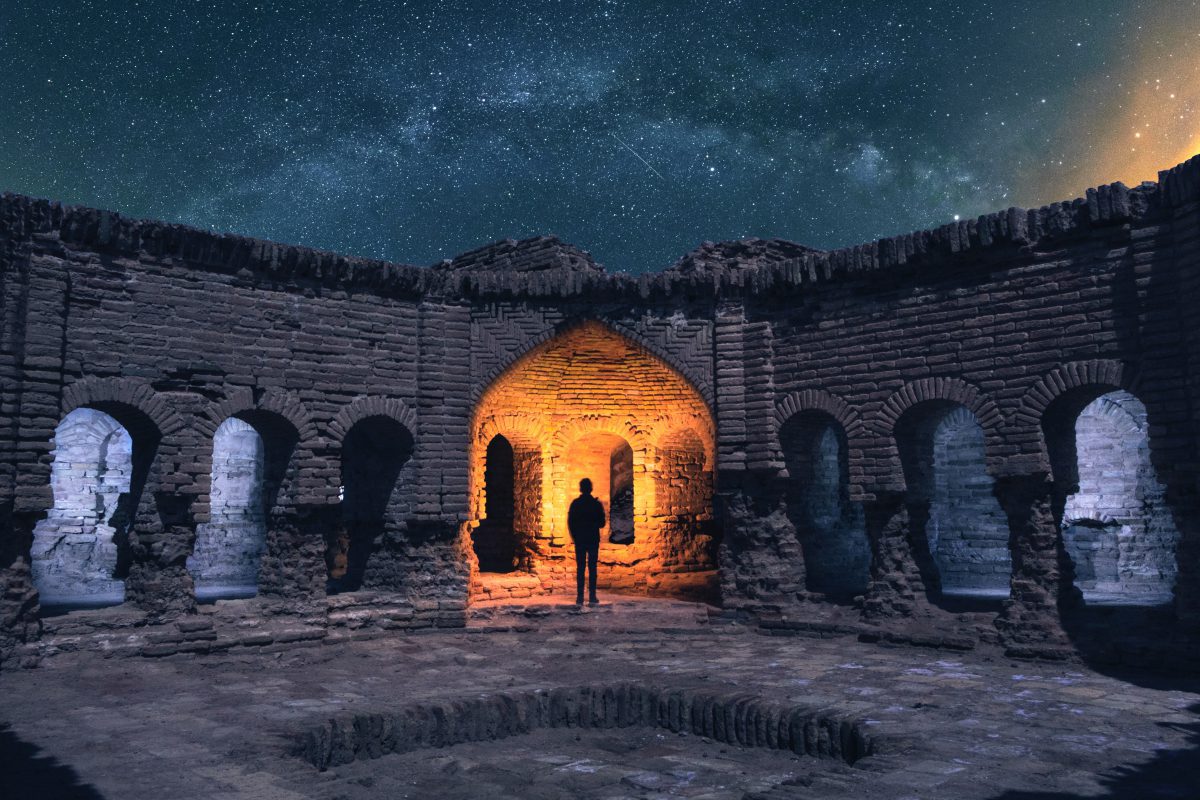
Table of Contents
Welcome, fellow explorers and adventure seekers! If you’ve ever dreamt of embarking on a journey to a land where ancient history, stunning landscapes, and warm hospitality converge, you’re in for a treat. In this Iran Travel Guide, we’re about to unravel the secrets of Iran, a country that has captivated the hearts of travelers for centuries.
Whether you’re considering Iran Travel as your next trip or you’ve already booked your ticket, our aim is to equip you with the knowledge you need to make your trip an unforgettable experience, from understanding the intricacies of obtaining an Iran visa to managing your finances while in the country, we’ve got you covered. We’ll also delve into the nuances of Iranian etiquette and dressing codes, ensuring that you navigate this beautiful nation with grace and respect.
So, get ready to embark on an enriching journey through the enchanting realms of Iran. Pack your curiosity, an open heart, and a sense of adventure because Iran is waiting to reveal its treasures to you. Let’s begin this odyssey together!
Iran Travel Guide: Why Visiting Iran?
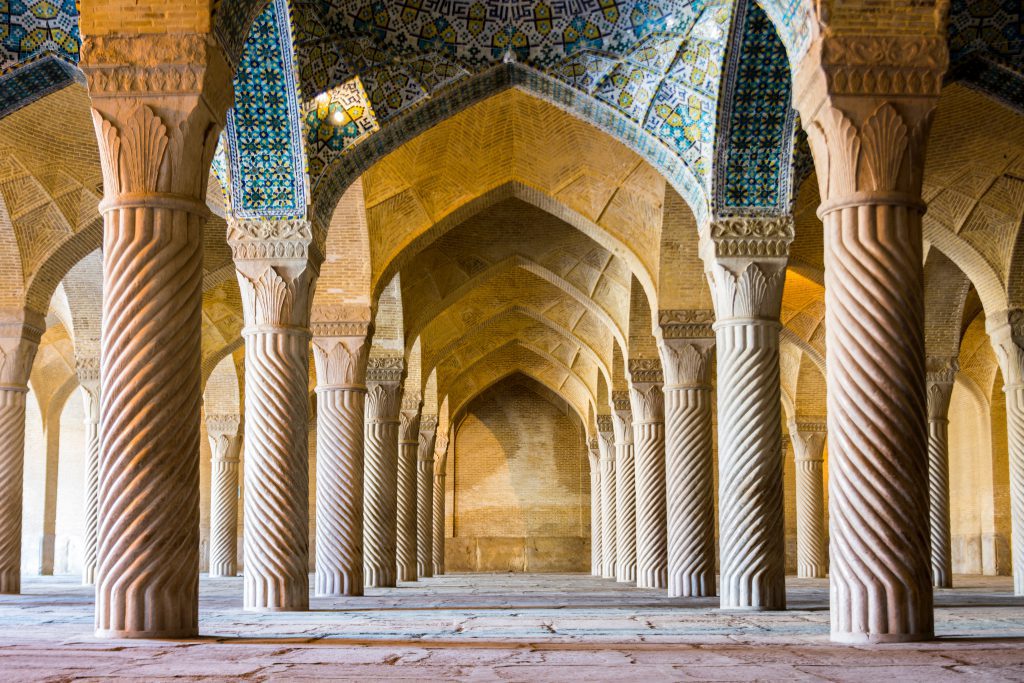
Visiting Iran is an absolute must for any adventurous traveler! With its rich history, breathtaking landscapes, and warm-hearted locals, Iran offers a truly unique and unforgettable experience. Imagine wandering through ancient cities like Isfahan, where stunning mosques and palaces adorned with intricate tile work transport you to a bygone era.
Don’t miss the mesmerizing beauty of the deserts, where the sand dunes seem to stretch on forever under a sky painted with stars. And, of course, the delicious cuisine will tantalize your taste buds with aromatic kebabs, fragrant saffron rice, and sweet baklava. But what truly makes Iran special is the warmth and hospitality of its people, who are eager to share their culture and stories with visitors. Here we listed a few reasons why to visit Iran:
1. Embrace the Timeless History
Iran boasts an ancient civilization that dates back thousands of years, and its historical significance is awe-inspiring. From the magnificent ruins of Persepolis , a UNESCO World Heritage site, to the grand Golestan Palace in Tehran , each structure is a testament to the country’s glorious past. Wander through winding alleys of historic cities like Isfahan and Yazd, where intricate architecture and the echoes of the past transport you to a bygone era.
2. Immerse in Vibrant Culture
Iran’s culture is a tapestry of diverse influences, from Persian, Arab, and Turkish to Central Asian and European. Experience the warmth of its people as they welcome you with open arms and indulge you with their hospitality. Marvel at the vivid colors of traditional clothing and savor the flavors of Iranian cuisine , renowned for its aromatic spices and delicately prepared dishes.
3. Mesmerizing Landscapes
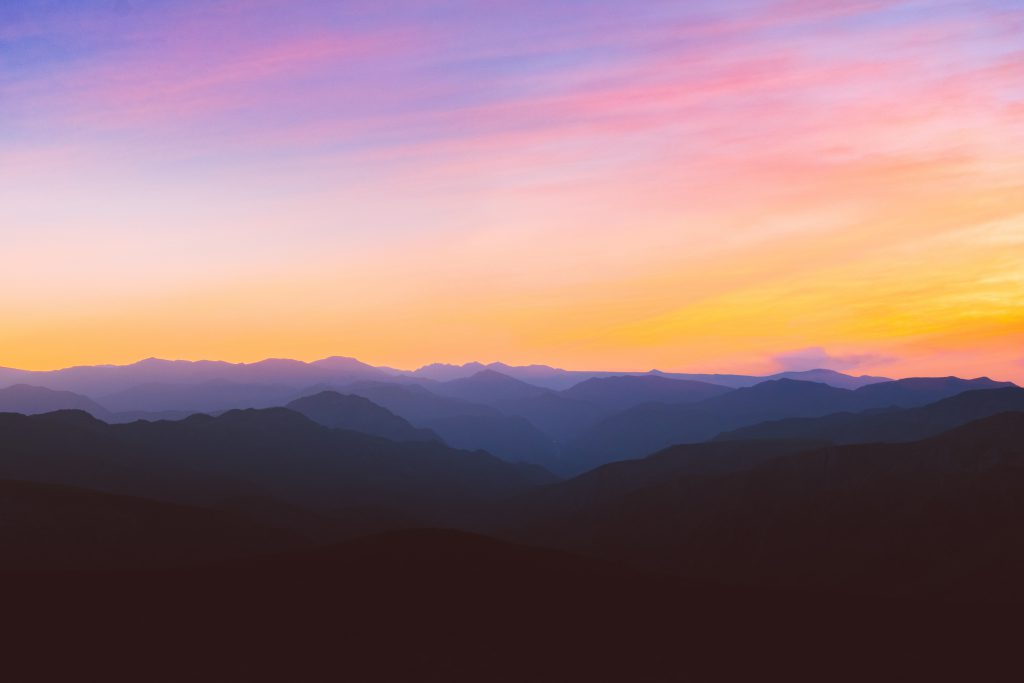
Venture beyond the cities, and Iran unfolds its breathtaking natural beauty. From the lush greenery of the northern forests (Hyrcanian Forests) to the stunning deserts of Dasht-e Kavir and Dasht-e Lut , each landscape is a masterpiece of nature’s artistry. Don’t miss the serene beauty of Mount Damavand or the otherworldly Kaluts, where wind-sculpted sand dunes create a surreal landscape.
4. UNESCO World Heritage Sites
Iran is home to an impressive array of UNESCO World Heritage Sites , and exploring them is like traveling back in time. Discover the ancient city of Bam and its adobe citadel, the awe-inspiring ancient aqueducts of Shushtar , and the magnificent Armenian Monastic Ensembles of Iran. Each site offers a unique glimpse into the country’s diverse heritage and architectural brilliance.
5. Dazzling Art and Architecture
Iran is an art lover’s paradise. Delve into the mesmerizing world of Persian carpets , renowned for their intricate designs and craftsmanship. Admire the mesmerizing beauty of Islamic architecture in mosques like Nasir al-Mulk in Shiraz , where colorful stained glass windows cast a rainbow of hues on the floors.
6. Experience Festivals and Traditions
Plan your visit to coincide with one of Iran’s vibrant festivals, and you’ll be treated to an immersive cultural experience. Witness the exuberant celebrations of Nowruz , the Persian New Year, or be part of the spiritual fervor during Ashura . These festivals offer a window into the soul of Iran’s traditions and values.
7. Warmth and Hospitality of Locals
Iranians are known for their exceptional warmth and hospitality towards visitors. Prepare to be embraced with open hearts and enjoy a genuine connection with the locals. The enriching interactions you’ll have will undoubtedly leave a lasting impression on your travel memories.
8. Safe and Welcoming Environment
Contrary to misconceptions, Iran is a safe country to visit. The people are warm and friendly, always ready to assist travelers. While you should exercise usual caution as with any foreign destination, Iran’s reputation for safety is well-deserved.
9. Off-the-Beaten-Path Adventures
If you yearn for unique experiences, Iran has plenty to offer. Explore the enigmatic village of Masuleh, nestled in the Alborz Mountains, where houses are built into the mountainside. Trek through the lush valleys of Golestan National Park, spotting rare wildlife along the way. These off-the-beaten-path adventures will leave you with unforgettable memories.
10. Photography Paradise
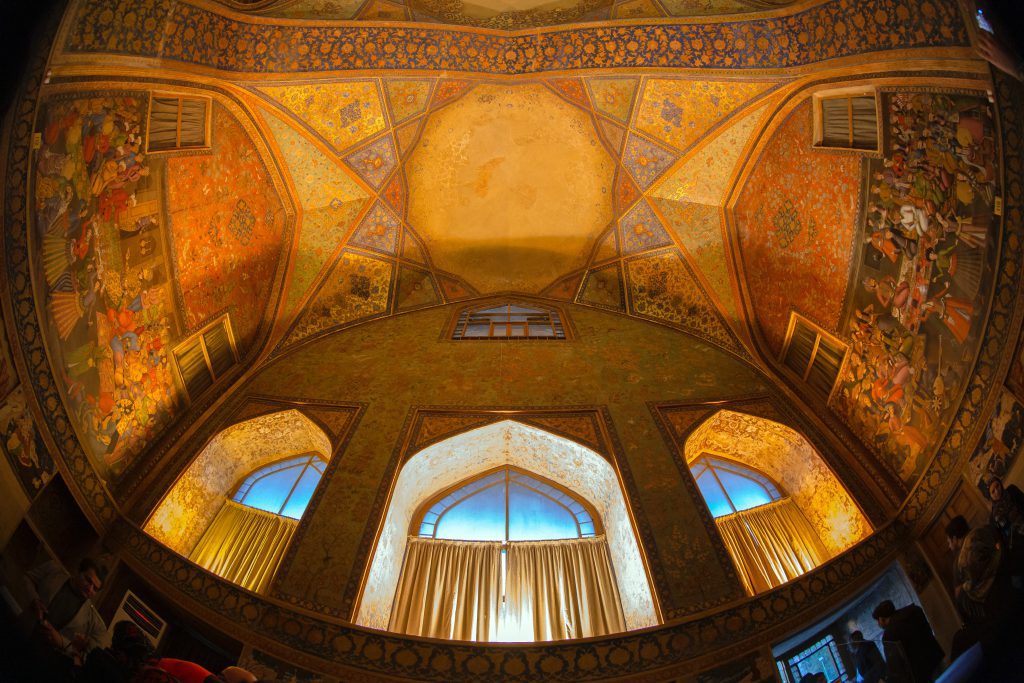
Photographers will find Iran to be a haven of visually stunning landscapes and architectural marvels. From the colorful bazaars to the ancient ruins, every corner of Iran is a potential masterpiece waiting to be captured through your lens.
Persia or Iran: Are They the Same?
Have you ever wondered if Persia and Iran are the same thing? They’re often used interchangeably, but there’s an incredible history to each.
Persia refers to the ancient Persian Empire , which existed around 550 BC to 330 BC. Persia was famous for its amazing art, culture, and architecture back then. It left a big mark on the Middle East and beyond. Today, we use “Persia” to talk about this old kingdom and its impact.
In 1935, the country officially switched its name from Persia to Iran , which means “land of the Aryans.” This change was meant to highlight Iran’s deep ties to the Aryan people who came to the region thousands of years ago. Nowadays, we use “Iran” to talk about the modern-day Islamic Republic of Iran in the Middle East.
Even though people often use Persia and Iran interchangeably, it’s cool to know the history behind each name. By learning about the fascinating history of Persia, you can better appreciate the rich culture and heritage of this beautiful country.
When we dive into Persia’s awesome history and how it influenced the world, we can start to really admire Iran’s amazing culture and heritage. So, let’s explore and learn!
Can Everyone Travel to Iran?
Iran has become a popular travel destination that attracts wanderers from all over the world thanks to its rich history, captivating culture, and breathtaking landscapes. However, some prospective travelers may have lingering questions about whether everyone can travel to Iran. Let’s answer that question!
The answer to whether everyone can travel to Iran is a resounding yes ! Iran, in recent years, has taken significant steps to facilitate travel for visitors from diverse backgrounds and nationalities. The Iranian government, recognizing the potential of tourism and the desire of travelers to explore its wonders, has streamlined visa procedures, making it easier for tourists to obtain necessary travel permits.
While some nationalities can enjoy visa-free entry for short stays, most visitors can apply for a visa through a simple process. The option of a visa on arrival at major airports has also been extended to many nationalities, further enhancing accessibility. These measures reflect Iran’s commitment to being a welcoming and inclusive travel destination. We will talk about getting Iran visa in detail later in this article.
Safety and security are crucial considerations for travelers, and Iran stands as a country with a relatively low crime rate. Misconceptions surrounding its geopolitical situation often overshadow the reality on the ground. The Iranian people are known for their warm hospitality and friendliness towards visitors, making travelers feel welcomed and safe throughout their journey.
Cultural sensitivity plays a significant role in ensuring a smooth travel experience in Iran. The country has a rich cultural heritage, and respecting local customs is essential. While the dress code is more conservative compared to Western norms, adhering to it when visiting public places and religious sites is not only a sign of respect but also fosters positive interactions with the locals. If you’re interested in reading about someone’s experience traveling to Iran with To Iran Tour, we have a fantastic travelogue from one of our guests below. It’s definitely worth checking out!
Iran Travel Story: A Memorable 15-year-old’s Wanderlust Through Iran
Iran is making strides in improving accessibility for people with disabilities. Although there may still be challenges to overcome, many public places, hotels, and tourist attractions have taken steps to accommodate travelers with mobility challenges. Efforts are continuously being made to make Iran a more inclusive destination for travelers of all abilities.
When traveling to Iran, some people may worry about language barriers since English may not be commonly spoken. However, this should not discourage anyone from discovering this fascinating country. The Iranian locals are renowned for their kind-heartedness and eagerness to help tourists communicate, often using hand gestures and basic English phrases. Additionally, many young Iranians speak English as a second language, and it is taught in high schools.
Financial transactions and currency exchange are essential aspects of travel planning. Iran’s official currency is the Iranian Rial (IRR) . While international credit cards may not be widely accepted, travelers can use US dollars or euros and exchange them at official exchange offices or banks. Carrying sufficient cash is advisable, especially when visiting more remote areas where ATMs may not be readily available.
Iran has its unique cultural norms, particularly regarding gender segregation and LGBTQ+ rights. Travelers need to approach these considerations with cultural sensitivity and respect. Understanding and adhering to local customs can create a harmonious travel experience and foster positive interactions with the local community.
Healthcare is a crucial aspect of any travel experience. Iran boasts a well-developed healthcare system with competent medical professionals. While the likelihood of medical emergencies is low, having comprehensive travel insurance is recommended to ensure peace of mind throughout the journey.
To sum up, Iran has made significant strides in improving its travel accessibility in recent years, making it a warm and inclusive destination for visitors from all over the globe. With simplified visa processes, increased safety measures, and a commitment to meeting diverse needs, Iran warmly welcomes travelers. Adapting to local customs, respecting cultural sensitivities, and being open to new experiences will undoubtedly enhance the travel experience in this captivating country where history, culture, and natural beauty unite seamlessly.
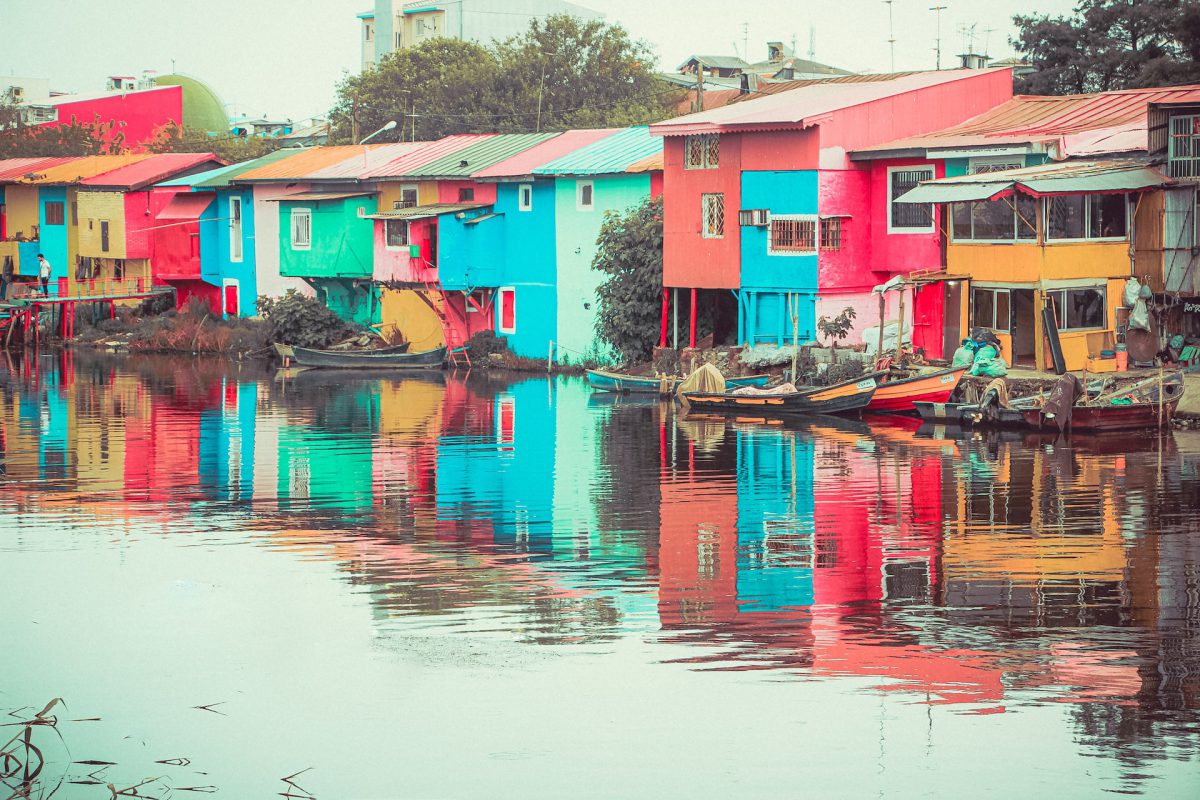
Thank you for joining me on this journey through the historical tapestry of Persia and Iran. Now, we want to extend a personal invitation to each one of you. If you’ve been captivated by the allure of Iran and are considering a visit, or even if you’re just curious to learn more, I invite you to explore our Iran travel guide. It’s a labor of love, crafted to share the magic of Iran with fellow travelers. From general steps to plan your travel to Iran to everything you need to know about Iran visa that might confuse you, our guide promises to be your trusted companion on your Iranian adventure.
How to Plan Visting Iran? (12 Steps)
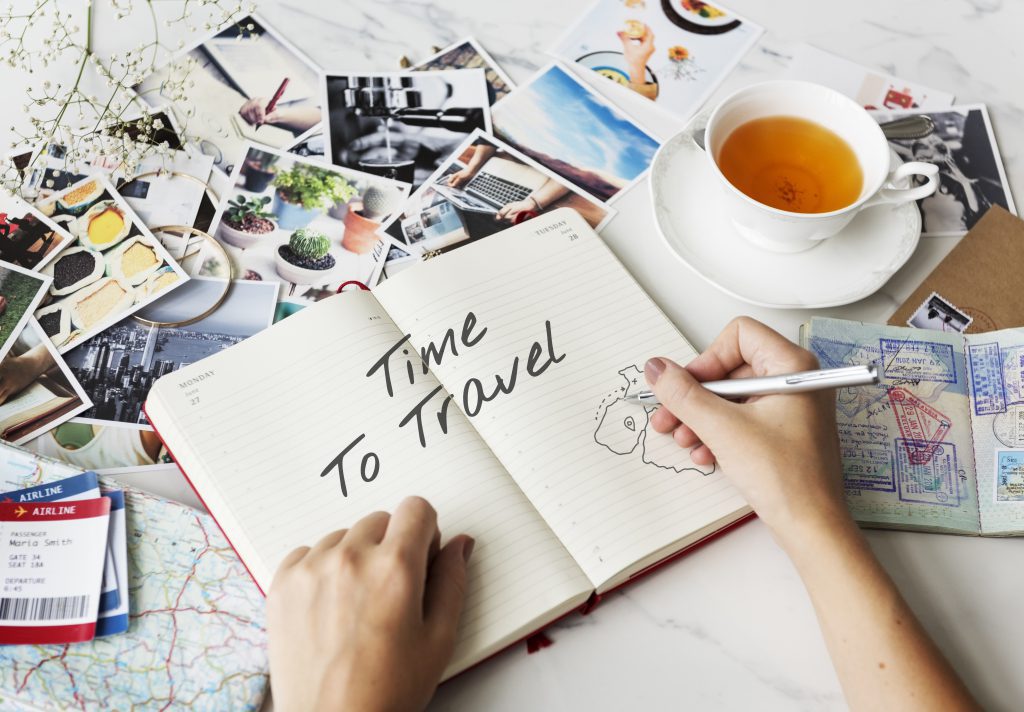
Traveling to Iran, with its rich cultural heritage and stunning landscapes, requires meticulous planning to ensure a smooth and fulfilling journey. Follow this step-by-step guide to efficiently plan your trip to this captivating destination.
Step 1: Research and Itinerary
Start by researching Iran’s diverse attractions and destinations . Identify the places you wish to visit and create a detailed itinerary. Consider the duration of your trip, the activities you want to engage in, and the must-see landmarks you don’t want to miss. You can check ToIranTour packages and customize your desired tour itinerary.
Step 2: Visa and Travel Documentation
Check the visa requirements for your nationality. Most visitors can obtain a tourist visa for Iran through the Iranian embassy or consulate in their home country. Alternatively, you can opt for a visa on arrival at major airports or use of visa services of an authorized tour operator/travel agency. Ensure your passport is valid for at least six months beyond your planned departure date. There is more information about getting Iran visa in the rest of the article and also on our blog .
Step 3: Best Time to Visit
Consider the best time to visit Iran based on your preferences. Spring (March to May) and autumn (September to November) offer mild temperatures and pleasant weather, ideal for exploring the country. Also, the best time to visit depends on the tour and activities. However, each season has its unique charm, so choose according to your interests.
Step 4: Cultural Awareness
Familiarize yourself with Iranian customs and etiquette to show respect for local traditions. Note that women should wear modest clothing that covers the arms, legs, and hair when in public places. Understanding and embracing the culture will enhance your travel experience.
Step 5: Language and Communication
While English is not widely spoken, the Iranian people are known for their warm hospitality. Learn a few basic Persian phrases to facilitate communication and connect with the locals. This will enrich your interactions during your journey.
Step 6: Accommodation and Transportation
Book your accommodation in advance to secure the best options that suit your budget and preferences. Iran offers a range of accommodations, from luxurious hotels to budget-friendly guesthouses. Plan your transportation within the country, whether by domestic flights, trains, or buses, to efficiently navigate between destinations. You can check the accommodation and transportation with a local tour operator.
Step 7: Health and Travel Insurance
Prioritize your health and well-being by consulting a healthcare professional for any required vaccinations or health precautions before traveling to Iran. Additionally, consider purchasing comprehensive travel insurance to provide coverage in case of unexpected medical emergencies or trip disruptions.
Step 8: Currency and Money Matters
Familiarize yourself with Iran’s currency, the Iranian Rial (IRR), and its exchange rates. While credit cards are not widely accepted, carrying sufficient cash is advisable, especially when traveling to remote areas where ATMs may not be readily available. Also, read about travel costs in Iran to plan accordingly.
Step 9: Safety and Security
Iran is considered a safe destination for travelers, with a low crime rate and a welcoming local population. However, exercise standard safety precautions and stay informed about local conditions to ensure a worry-free journey.
Step 10: Respect for Religious Sites in Iran
Iran is home to numerous significant religious sites. Show respect when visiting mosques, shrines, and other places of worship by adhering to dress codes and rules for visitors.
Step 11: Iran Local Customs and Traditions
Respect local customs and traditions to foster positive interactions with the Iranian people. Greetings, gestures, and dining etiquette -which we are going to talk about later in this article – may differ from your home country, so be open-minded and willing to embrace cultural differences.
Step 12: Packing Essentials
Pack appropriate clothing for varying weather conditions and cultural considerations. Don’t forget essentials like sunscreen, comfortable walking shoes, and a reusable water bottle for staying hydrated.
DIY or Tour for Traveling to Iran? Our Iran Travel Guide Perspective
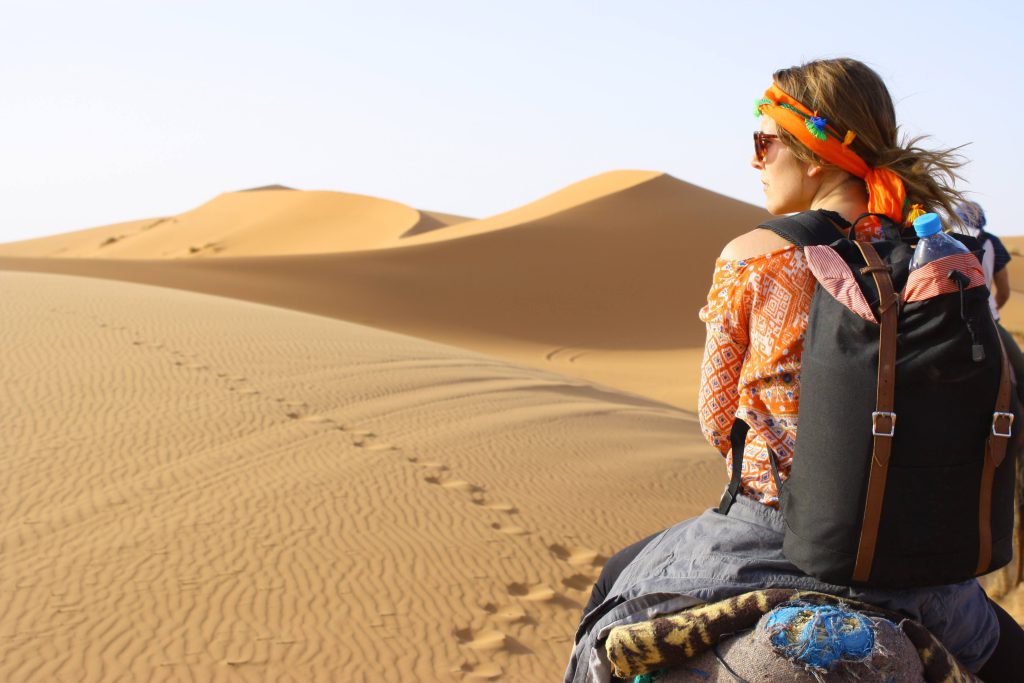
When you’re thinking about having an awesome trip to Iran, you’ve got to decide if you want to plan everything yourself or join a guided tour . Each option has its own good and not-so-good points, so it’s important to pick what suits you and your travel goals best. In this comparison, we’ll look at the perks of DIY travel to Iran or going on a tour for visiting Iran. We’ll highlight why it’s a great idea and show you why tour services are valuable.
DIY (Do-It-Yourself) Travel to Iran
- Freedom and Flexibility: DIY travel offers the freedom to create a personalized itinerary, exploring off-the-beaten-path destinations at your own pace. It caters to adventurous spirits who relish the thrill of independent exploration.
- Cost Control: Traveling independently allows budget-conscious travelers to choose accommodations, transportation, and dining options that align with their financial preferences.
- Authenticity in Interactions: With DIY travel, you have the opportunity to interact with locals on a more personal level, leading to genuine cultural experiences and connections.
Weaknesses:
- Logistical Challenges: Planning transportation, accommodations, and activities can be time-consuming and potentially overwhelming, especially in Iran with language barriers and unfamiliar customs.
- Navigating Language Barriers: English is not widely spoken in Iran and this will lead to communication challenges in certain situations.
- Cultural Awareness: Researching and adhering to local customs and etiquette may require extra effort to ensure respectful interactions.
Travel to Iran by Tour
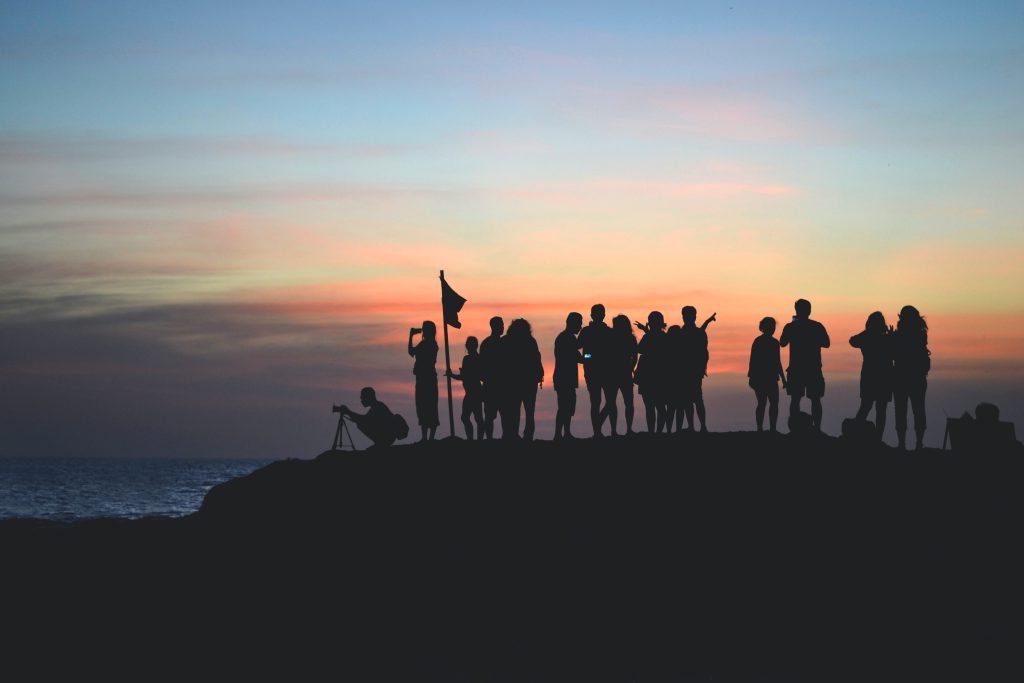
- Reasonable Pricing: Contrary to common misconceptions, tours to Iran often offer excellent value for money, including a comprehensive package of services and experiences at a reasonable cost.
- Local Knowledge: Tour guides possess extensive knowledge of Iran’s history, culture, and landmarks, providing enriching insights and context to enhance your understanding of the destination.
- Close Connections with Locals: Tour operators often have well-established relationships with local communities, facilitating authentic encounters with Iranians and unlocking hidden gems inaccessible to DIY travelers.
- Awareness of Subtleties: Experienced tour guides are attuned to cultural nuances, ensuring that travelers navigate social interactions with grace and sensitivity.
- Authentic Experiences: Tours curate experiences that offer a balance between must-see landmarks and off-the-beaten-path wonders, providing a more authentic and immersive travel experience. Since Iran is a less-known destination, this issue becomes more important.
- Fixed Itineraries: Tours operate on pre-planned itineraries, which may not cater to individual preferences for spontaneity and exploration. To solve this problem, you can use individual and customized tours. ToIranTour can help you in this matter.
- Group Dynamic: Traveling with a group may limit personal freedom and require compromise on specific preferences. However, using the services of tour operators who are committed to organizing tours with small groups can solve this problem to a large extent.
While both DIY travel and guided tours have their perks, let’s talk about why you might want to consider taking an Iran tour. Tours in Iran are like having a friendly local show you all the best stuff. They know the coolest places, the tastiest food, and the most interesting stories.
When you join a tour, you don’t need to worry about all the nitty-gritty details of planning. The tour guides take care of everything, so you can relax and enjoy your trip. Plus, they know all the ins and outs of Iran’s beautiful landscapes, so you won’t miss a thing.
But the best part? You get to connect with the local folks, discover hidden gems, and dive deep into Iran’s rich history and culture. It’s an adventure you won’t forget! So, if you’re looking for a stress-free and amazing way to explore Iran, consider joining a tour .
How Can I Buy Iran Tours?
To make sure your trip is fantastic and easy, you need to think about a few important things when choosing your tour. We’re here to help you with that. Check out these key factors to find the perfect tour for your travel to Iran:
1. Attractiveness of the Itinerary
Examine the tour itinerary closely to determine its appeal and alignment with your interests. A well-crafted itinerary should encompass a balance of must-see attractions and off-the-beaten-path gems, offering a comprehensive exploration of Iran’s diverse landscape. Look for unique experiences, cultural encounters, and opportunities for authentic interactions with local communities.
2. Licensed Tour Operator
Verify whether the tour operator is licensed and accredited by relevant authorities. A licensed operator adheres to specific standards, ensuring compliance with safety regulations, customer protection, and quality of services. This validation offers peace of mind and enhances the reliability of the tour.
3. Right Price vs. Misleading Pricing
Price is a crucial consideration, but it should not be the sole determining factor. Be cautious of tours that offer significantly lower prices than competitors, as they may compromise on the quality of services and experiences. Compare the inclusions of each tour to assess its true value and avoid being misled by seemingly inexpensive options.
4. Customer Support
Good customer support is integral to a satisfying travel experience. Look for a tour operator who is responsive to inquiries, provides detailed information, and is attentive to your needs and preferences. A reliable tour operator should be readily available to address any concerns before, during, and after your journey.
5. Communication with the Tour Operator
Efficient and clear communication with the tour operator is vital for a seamless travel experience. Ensure your Iranian tour operator is accessible through various communication channels, such as email, phone, or chat. Prompt responses and transparent communication demonstrate the operator’s commitment to customer satisfaction.
6. Group Size and Dynamics
Consider the group size of the tour and how it aligns with your preferences. Smaller groups offer a more intimate experience, while larger groups may foster camaraderie with fellow travelers. Choose a group size that complements your travel style.
By picking a tour that matches your interests , you can have an incredible adventure exploring Iran’s history, culture, and beautiful natural sights. So, get ready to discover the magic of Iran and enjoy every moment of your unforgettable journey!
Local Tour Operator or International Tour Operator?
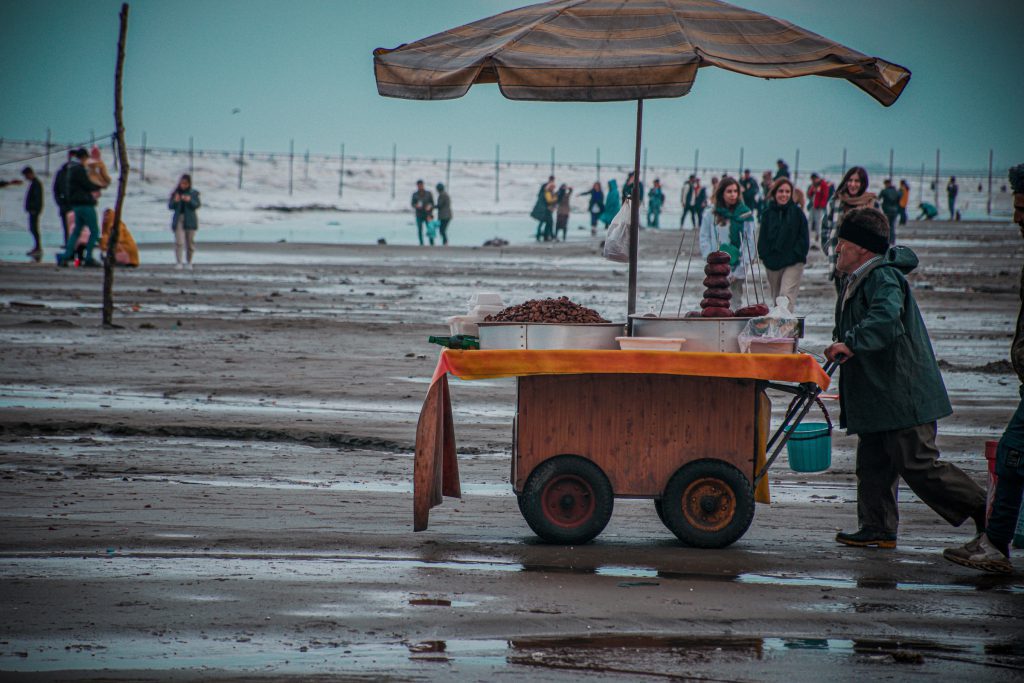
When you’re planning your trip to discover the amazing attractions of Iran, you have two choices: you can either go with a local tour company or an international one. Each of these options has its own good sides and not-so-good sides, and they’re better suited for different kinds of travelers. In this comparison, we’ll focus on why using a local tour company can be a great idea. We’ll talk about what they’re really good at and how they can make your travel experience even more special.
Local Tour Operator
- Reasonable Pricing: Local tour operators usually have great prices because they really know the local scene. They can talk with suppliers and get good deals, often saving you a lot of money – up to 80-100% less than international tour operators. One reason is that local operators have lower taxes. On the flip side, many international tour companies team up with locals to run their tours. When they add an extra layer like an intermediary, costs go up, and so does the price for you.
- Local Knowledge: Utilizing the expertise of a local tour operator grants travelers access to a wealth of insider knowledge. Local operators possess an in-depth understanding of Iran’s history, culture, and attractions, allowing for enriching insights and personalized recommendations.
- Close Connections with Locals: Local tour operators have well-established relationships with local communities, leading to meaningful cultural interactions and authentic experiences that might not be possible with international operators. Local tour operators are attuned to cultural nuances and customs, ensuring that travelers navigate social interactions with respect and grace, leading to more immersive and respectful experiences.
- Flexible Itineraries: Local operators can offer more flexibility in tailoring itineraries to individual preferences, allowing travelers to focus on specific interests and personalize their journey.
- Unknown brand and trust: Naturally, international tour operators have a more well-known brand, and it is easier to trust them. Of course, you can trust local tour operators who have an official license and also have good performance in their previous services. On the other hand, you can book your tour with just a small deposit.
International Tour Operator
- Global Expertise: International tour operators often have a wider network of destinations and resources, offering comprehensive tour packages that cover multiple countries or regions.
- Ease of Booking: International operators usually have user-friendly websites and customer service in various languages, making booking and communication more accessible for a diverse clientele.
- Higher Costs: International tour operators may have higher overheads and administrative expenses, which can be reflected in the pricing of their tours, making them comparatively more expensive.
- Limited Local Insights: While international operators offer broad coverage, their understanding of the local culture and customs in specific destinations may not be as deep as that of local operators.
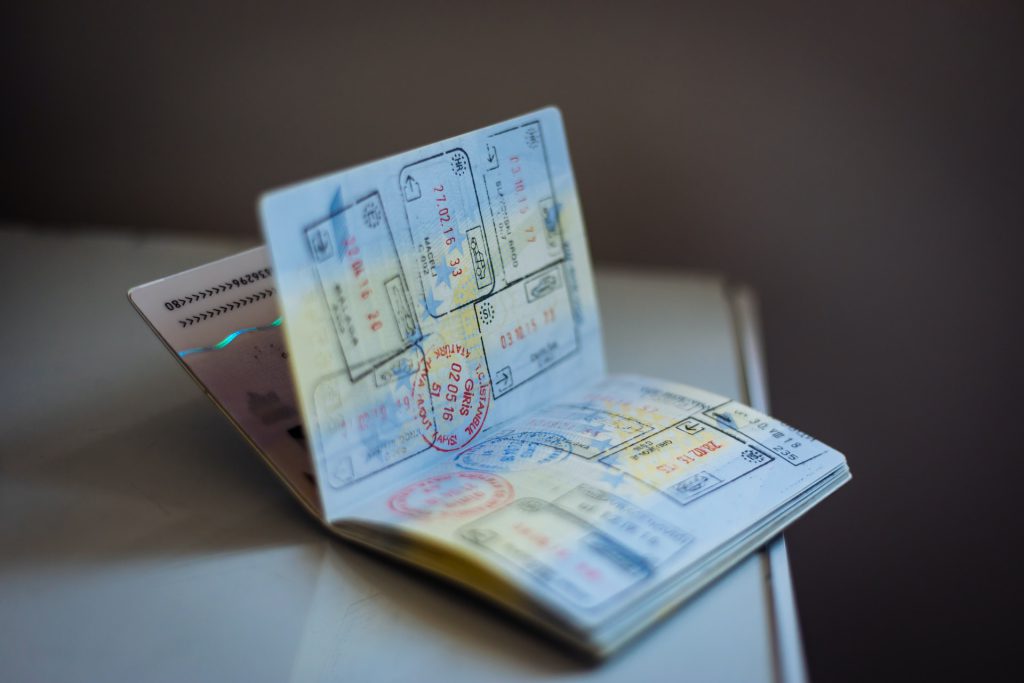
Are you having trouble with the Iran visa application process? You’re not alone. Getting a visa for Iran can be tricky for many travelers. It’s important to determine if you’re eligible and what rules you need to follow.
Generally, visiting Iran needs a visa, except for a few countries that can travel to Iran visa-free. There are some countries that can get their visa on arrival, but some countries are not eligible for Iran visa on arrival, and they must get their visa before their trip (which normally takes about 3 to 7 days to get your visa). There are some countries that don’t need any visa for visiting Iran. Keep reading to find out which group you belong to.
To get your visa, you can go to Iran’s embassy in your country, or apply for your Iran visa online , or even easier, use an authorized tour operator to do the process for you.
For some countries like the US, the UK, and Canada , things might be more complicated. Their governments don’t have good relationships with Iran’s government, which can make getting a visa even harder. Right now, there’s no Iranian embassy in the US.
Don’t let this process stop you from exploring the great things Iran has to offer. With some planning and looking into things, you can make the visa application go smoothly. Make sure you know what your nationality needs and give yourself enough time.
Even though getting a visa can be tough, Iran is an amazing place to visit. There are ancient cities with beautiful buildings, delicious food, and friendly people who will make you feel welcome. So, don’t let the visa process hold you back. Start planning your trip to Iran today, and To Iran Tour can help you make getting your visa easier .

How to Get an Iran Visa on Arrival?
Feeling a bit stressed about getting your visa to Iran? Well, here’s some good news! If you’re from one of 180 countries, you might not need to stress too much.
Starting from February 14, 2016, Iran’s Ministry announced something cool. They said that at their airports, they can give 30-day visas to people from those 180 countries. This makes things super simple if you want to visit Iran and see all its amazing stuff.
But hold on a second! Not everyone from those 180 countries can just show up and get a visa. It might depend on where you’re from, and there could be some rules you need to follow. Before you pack your bags for Iran, make sure to check what you need to do based on where you’re from.
If you’re allowed to get an Iran visa on arrival, you can do it at different airports, like Tehran Imam Khomeini Airport (IKA), Mashad Airport, Shiraz Airport, and more. Here’s what you’ll need to do:
- Answer some questions about your Iran trip,
- Show them where you’re staying (like a hotel reservation),
- Share a copy of your travel insurance,
- Prove you have a return flight ticket
By keeping yourself informed and being careful, you can have a great and safe trip to Iran!
Iran Visa Requirements: Best Guide 2023
Travel to Iran Without a Visa
There are 14 countries in 2023 that can visit Iran without any visa at all. These countries include Turkey, Azerbaijan, Georgia, Malaysia, Oman, Venezuela, China (for 21 days), Hong Kong, Macau, Egypt, Armenia, Lebanon, Bolivia, and Syria. To read more about Iran travel without a visa, read the article below:
Travel to Iran Without a Visa in 2024: Your Ultimate Guide
Non-eligible Nationalities for Iran Visa on Arrival
It’s important to know who can get a visa when they arrive in Iran. If you’re from countries like Afghanistan, Bangladesh, Colombia, India, Iraq, Jordan, Pakistan, Somalia, the United States, Canada, and the United Kingdom, you can’t get a visa on arrival.
If that’s the case for you, don’t worry! You can still get a visa in a few different ways. You can go to the Iranian embassy in your home country, apply online, or ask an authorized tour operator to help you out , which is the easiest option.
How to Get an Iran Visa; A Complete Guide
What is the Iran Visa Authorization Code
This code is necessary for everyone who wants to apply for an Iran visa and serves as a determining factor for your visa application’s approval.
For those who plan to travel in a group, the tour operator will generally process the visa process and get the authorization code.
For solo travelers or those who don’t have a tour agent, ToIranTour can be a reliable option that offers essential travel services for visiting Iran. Alternatively, you can source an Iranian travel agency or seek direction from the embassy where you plan to obtain your visa.
When applying for the Authorisation Code, you’ll need to specify the embassy or airport where you’ll be processing your visa (unless you’re American, Canadian, or British because Iran doesn’t have embassies there). This can be a bit challenging for those traveling without solid plans or those who plan to visit multiple cities in Iran. It’s wise to choose an embassy in a city you’re likely to fly into Iran from, taking into account the processing time required for your visa application.
Remember, the Authorization Code isn’t your visa . It doesn’t guarantee you’ll get one. Once you have the code, you have to collect your visa label at the embassy/Iranian airport within three months . It’s a good idea to apply well ahead of your trip to handle any delays or issues. So, by getting the Authorization Code and applying for your visa early, you can have a smooth and fun trip to Iran.
Iran Tourist Visa Cost
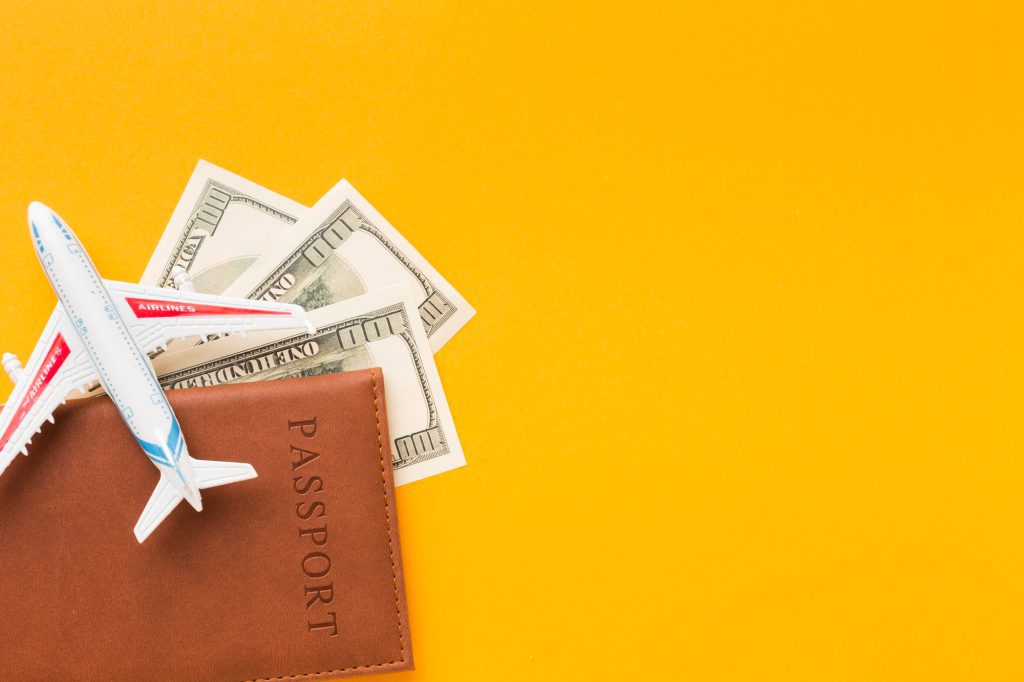
When planning to obtain an Iran tourist visa, it’s important to budget for the costs of the visa. The cost of the visa service varies depending on the agency, usually with an administration fee of 30 to 50 euros, unless booked along with a tour package.
To Iran Tour offers the most affordable service for this situation, and they even have promotions where it can be free. Plus, if you book a tour with To Iran Tour , you won’t have to pay for the visa service.
However, the price of an Iran tourist visa depends on your nationality and the embassy where you apply for it. There isn’t a fixed fee for the visa, so it’s essential to inquire about the current fees at the embassy where you intend to obtain it. Consequently, the visa cost can vary depending on the location where you submit your application. For instance, one traveler paid €180 for their visa in Tbilisi, Georgia, while another paid a slightly higher amount to process their visa in Paris.
An IMPORTANT note is that to pay the cost of a visa at the airport, have enough cash in your pocket as in Iran, international payment cards are not valid. We have travelers who put their cash money in bags and do not have access to their money when check-in and have administrative problems, So keep enough cash in EUR/USD by yourself while getting your stomp visa at the airport.
It’s recommended to budget for the highest possible cost when planning your trip, as visa fees can change without notice. By budgeting accordingly and planning in advance, you can ensure a smooth and hassle-free visa application process and enjoy your trip to Iran with ease.
Iran Visa Timings
Obtaining an Iranian tourist visa is not a time-consuming process, but travelers should plan accordingly to avoid any last-minute stress. It’s important to be aware that the Authorisation Code, necessary for obtaining a visa label, could take 3 – 7 working days to process except for US, Canada, and Britain passport holders, which take more time (around 30-45 working days). Even if you fast-track the process, it’s likely that the code will arrive with only a few days to spare before your planned arrival in Iran or tour start date.
This means that before any trip to Iran, especially when traveling on a tour, you’ll need to plan in advance and be prepared to rush to the embassy to process your authorization code. You may have to pay extra for fast-tracking and organizing your flight ticket to Iran at the last minute, which doesn’t always guarantee the best price. So, it’s a good idea not to book your flights to Iran or any travel arrangements until you know your Iran visa will be processed.
By planning ahead and being aware of the potential delays and challenges in obtaining an Iran tourist visa, travelers can have a stress-free and enjoyable trip to this beautiful country.
How Can US citizens Travel to Iran?
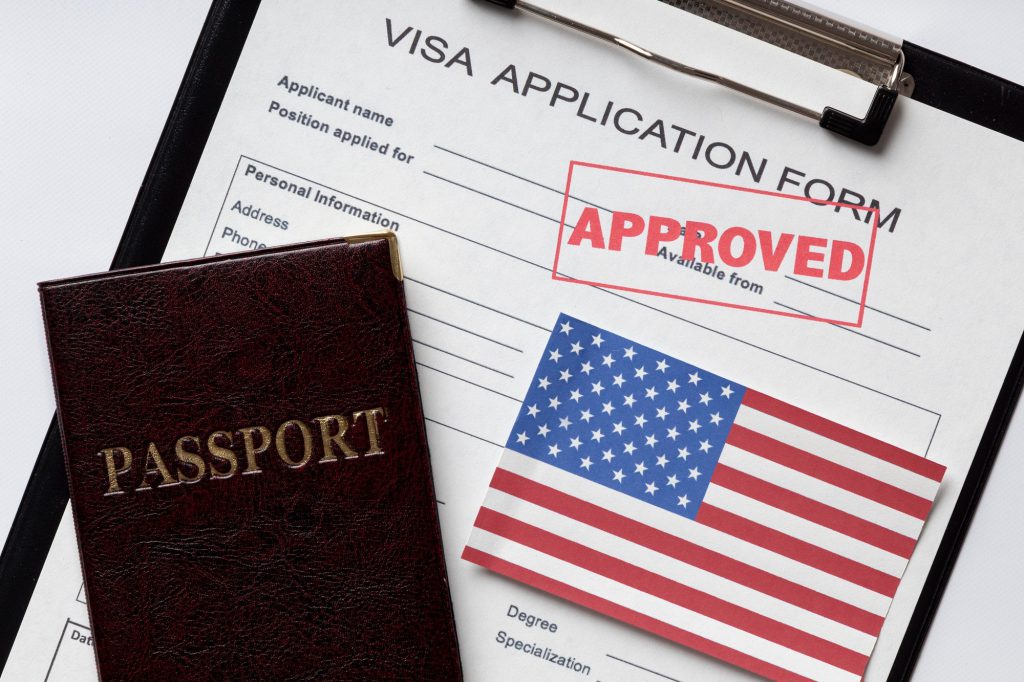
For American citizens, exploring the wonders of Iran can be an enticing prospect, but it comes with a unique set of considerations due to the complex relationship between Iran and the United States of America.
When it comes to visas, Iran has stricter conditions for American citizens, and the United States has similar policies for Iranian nationals. While the process of obtaining a visa for American citizens traveling to Iran may require more time and effort, it is entirely possible with the right approach . Here’s a brief explanation of the process.
1. Visa Application Process:
If you plan to travel to Iran, it’s best to start the visa application process well before your intended departure date. It’s recommended to begin the process at least two months in advance to ensure there is enough time for processing.
2. Contacting the Iranian Interests Section or Embassy
American citizens seeking to obtain an Iran visa must contact the Iranian Interests Section located at the Embassy of Pakistan in Washington, D.C. This is due to the absence of any direct embassy or consulate representation of Iran in the United States. Alternatively, they may choose to contact an Iranian consulate in a third country.
3. Application Documentation
Applicants will need to submit specific documentation to support their visa application, including a completed visa application form, a valid passport with at least six months’ validity beyond the planned departure date, passport-sized photographs, a detailed travel itinerary, and their resume which you can download its sample resume here .
4. Letter of Introduction
If you’re an American citizen planning to visit Iran, you’ll need something important: a special letter. This letter can be easily obtained through a trusted travel agency in Iran. They’ll help you get this letter from the Iranian Ministry of Foreign Affairs.
This letter is like your travel pass. It should explain why you want to visit Iran, your travel plans, and if someone in Iran is helping you, they should be mentioned too.
5. Group Tour vs. Independent Travel
American citizens can choose between traveling as part of an organized group tour or in a private tour.
IMPORTANT note: Both should be escorted by an authorized tour guide. Joining an organized group tour can simplify the visa process, as the tour operator may assist with obtaining the letter of introduction and navigating the application procedure.
6. Additional Screening and Processing Time
Due to the sensitive nature of the bilateral relationship, visa applications from American citizens undergo additional screening, which may contribute to longer processing times compared to citizens of other countries. However, it is crucial to remain patient and diligent throughout the process.
7. Visa Validity and Duration
After approval, the visa will specify its validity period and the permitted duration of stay in Iran. It is crucial to strictly adhere to these limitations to prevent any complications while traveling.
Therefore traveling to Iran as a US citizen may require navigating a more intricate visa application process due to the existing differences between Iran and the United States. However, with careful preparation, proper documentation, and patience, obtaining an Iranian visa is entirely possible. By adhering to the specified requirements and following the recommended steps, American travelers can embark on an unforgettable journey to discover the rich history, culture, and beauty of Iran, making memories to cherish for a lifetime.
Iran Visa for US UK and Canada Citizens: A Comprehensive Guide
How Can British and Canadian Citizens Travel to Iran?

British and Canadian citizens can travel to Iran following a similar process as American citizens . They must apply at the Iranian embassy in England or Canada, considering the required documentation and a letter of introduction from an authorized travel agency in Iran. Notably, these nationalities cannot obtain airport visas and must only use escorted tour services through a tour operator.
If the office of the custodian of Iran’s interests in Washington or other embassies located in Canada and England is far from your place of residence, or if you cannot visit them for any reason, you can receive your visa through the postal service. You should send the necessary documents, including your passport and your photo, along with a special form filled out by mail to the office of Iran’s Interests Protector or the embassy of your choice. After completing the administrative formalities, they will send the passport along with the visa to you.
Visa Refusal Possibilities
Travelers need to be aware that there is a risk of visa refusal for Iran if there is proof that they have traveled to Israel. This is due to the political tensions between the two countries and the Iranian government’s strict stance on the matter.
Additionally, visitors who work in certain industries, such as journalism or media, may also face scrutiny from Iranian authorities. This is because the Iranian government is sensitive to the portrayal of the country in the media and may view journalists and media workers as a potential threat to their national security.
If you have traveled to Israel in the past, it’s important to be transparent about this when applying for an Iran tourist visa. While this may increase the likelihood of visa refusal, it’s important to be honest to avoid any potential legal issues or complications during your visit.
It’s also recommended to avoid discussing any sensitive topics related to politics or religion during your stay in Iran, as these may be viewed as provocative and lead to unwanted attention from authorities.
Nationality Restrictions- Israelis Travel to Iran
It’s really important to know that if you’re from Israel, you can’t go to Iran. The two countries don’t get along right now, so this rule probably won’t change for a while.
We understand that it might be disappointing if you’re from Israel and you want to visit Iran to learn about its amazing culture and history. But it’s super important to follow the rules and not try to sneak into Iran. If you do, you could get into big trouble with the law, and your safety could be in danger.
Even if you have another passport from a different country, don’t try to go to Iran if you’re also an Israeli citizen. It’s just not safe.
Travel Insurance for Visiting Iran: Insights from Our Iran Travel Guide
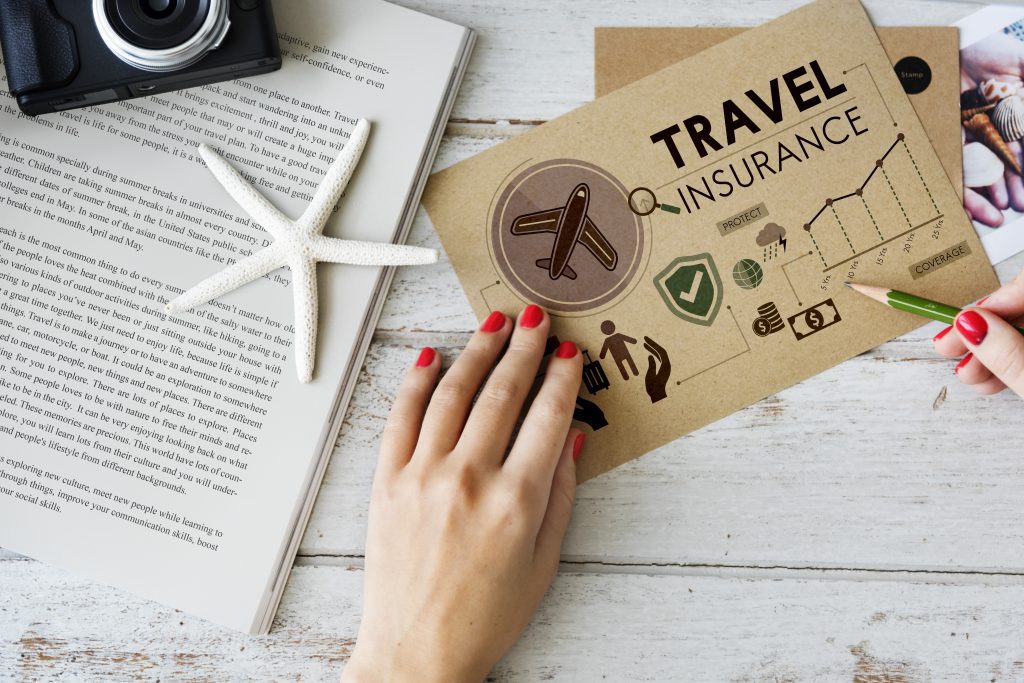
When you’re getting ready for a trip to Iran, remember this: You need travel insurance to get your visa. It’s like a permission slip for your trip.
But not just any insurance will do. Make sure your insurance covers all of Iran and all the stuff you want to do there. Some insurance might say no to certain places or activities, so read the fine print!
You can also ask your tour guide to set you up with health insurance from a company like Saman Insurance. This insurance will help if you get sick or have an accident, and it can cover up to 50,000 Euros in medical bills.
So, if you want to stay safe and have a blast in Iran, get good travel insurance and be careful. Happy travels!
Booking the Best Tour
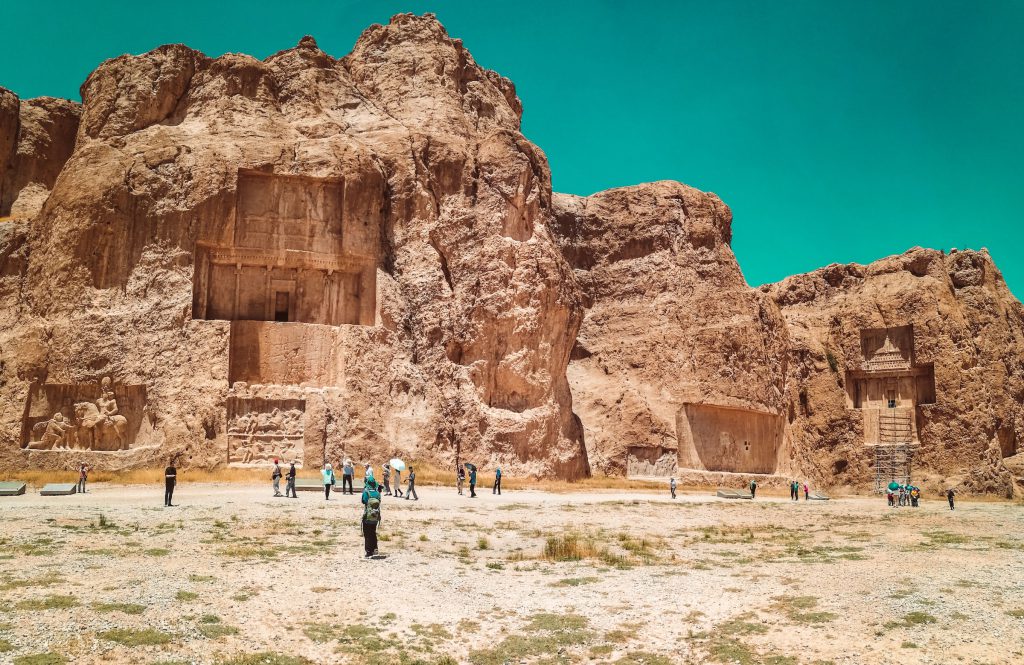
Booking an Iran tour package is a fantastic way to dive into the country’s incredible culture and history. It’s especially great if you want a smooth and stress-free trip. This might be your only option if you’re from the UK, the US, or Canada. You see, these countries have special rules that say you must join an official Iran tour operator or hire a private Iran guide.
Now, there are so many Iran tour packages out there that it can feel a bit overwhelming. But don’t worry! If you pick a trusted tour company like To Iran Tour , you’re in for a memorable adventure. We’ll take you to amazing places in Iran, ones that you might not easily reach on your own or using public transport. Plus, your local guide will be a treasure trove of info about Iran’s ancient history – perfect if you’re a history and culture fan.
You might think being in a tour group means you’re stuck all the time, but that’s not the case. You’ll still have plenty of free time to explore each place at your own pace. Even in a small group, we had loads of opportunities to discover Iran’s hidden gems on our terms.
Now, one thing to remember is that Iran tour packages can be quite packed. There’s not much downtime or rest days on the schedule, which might feel a bit rushed if you prefer a slower travel pace. But in just 12-14 days, you’ll see and experience so much that you’ll never forget.
All in all, booking an Iran tour package is an awesome way to soak up this incredible country and its rich culture and history. With a bit of planning and research, you’ll find the perfect tour that matches your interests and travel style. You’ll make memories that will stick with you forever.
Private Guided Tours of Iran
For those who prefer a more personalized travel experience, hiring a private tour guide in Iran is a great option. While it typically requires a minimum of two people, it offers the flexibility to customize your itinerary and travel at your own pace.
Private guided tours of Iran are particularly appealing to those who may have visa restrictions or prefer to avoid traveling in larger groups. With a private guide, you’ll have the benefit of local knowledge and expertise, and you can tailor your itinerary to suit your interests and preferences.
One of the advantages of a private guided tour is that you can have an intimate and authentic experience of Iran’s culture and history. Your guide can take you to off-the-beaten-path destinations and provide insights into local customs and traditions, giving you a deeper understanding and appreciation of the country.
Additionally, a private guided tour allows you to avoid the hassle and stress of planning logistics and transportation on your own. Your guide can handle all the details, from arranging accommodations and transportation to helping you navigate local customs and etiquette.
Iran Independent Travel
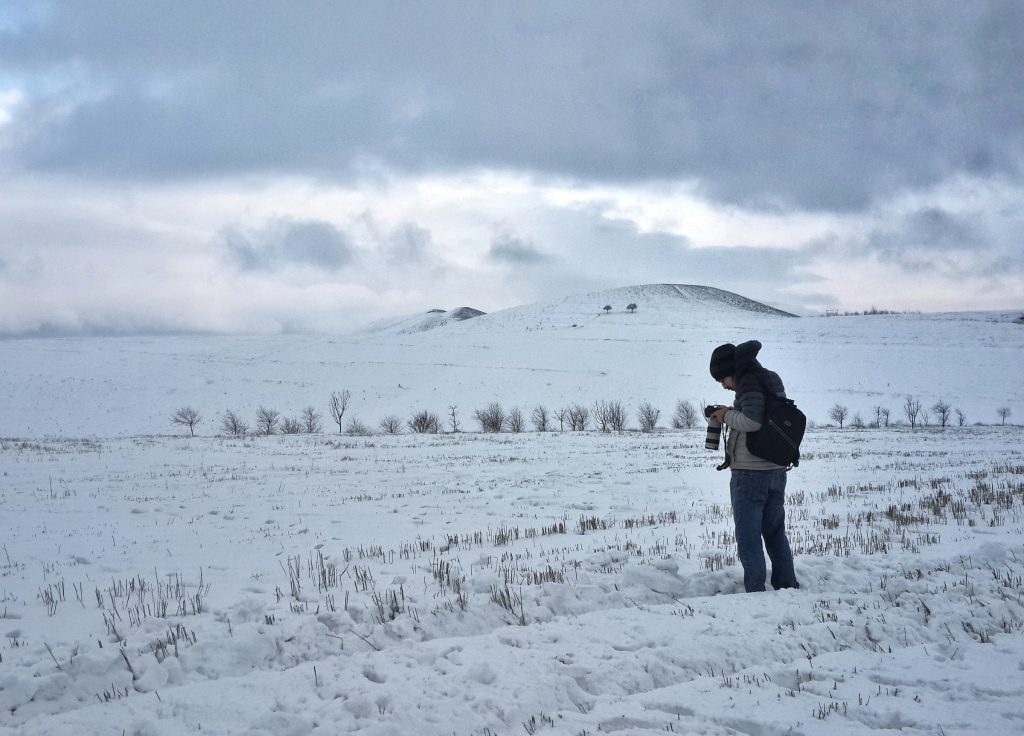
While solo and independent travel to Iran can be moderately easy for those with a free nationality, it’s important to note that the country is not yet well-trodden on the independent travel path. Hostels and guesthouses are scarce, and big, expensive hotels dominate the landscape, especially in Tehran. It’s also rare to come across a group of solo travelers to join.
However, that doesn’t mean that solo travel in Iran is impossible or unsafe. On the contrary, it’s a rewarding and exhilarating experience that offers a unique glimpse into the country’s rich culture and history. While it may require a bit more planning and effort, traveling independently in Iran allows you to create your own itinerary and explore at your own pace.
One of the advantages of independent travel is the flexibility to stay in smaller, locally-run accommodations and eat at local restaurants, giving you a more authentic and immersive experience. It also allows you to connect with locals and learn about their way of life, which can be a highlight of any trip.
Of course, traveling independently in Iran also requires some caution and common sense, such as being aware of local customs and dress codes and taking necessary precautions for safety. It’s also important to do your research and plan ahead to ensure a smooth and enjoyable trip.
Couchsurfing in Iran
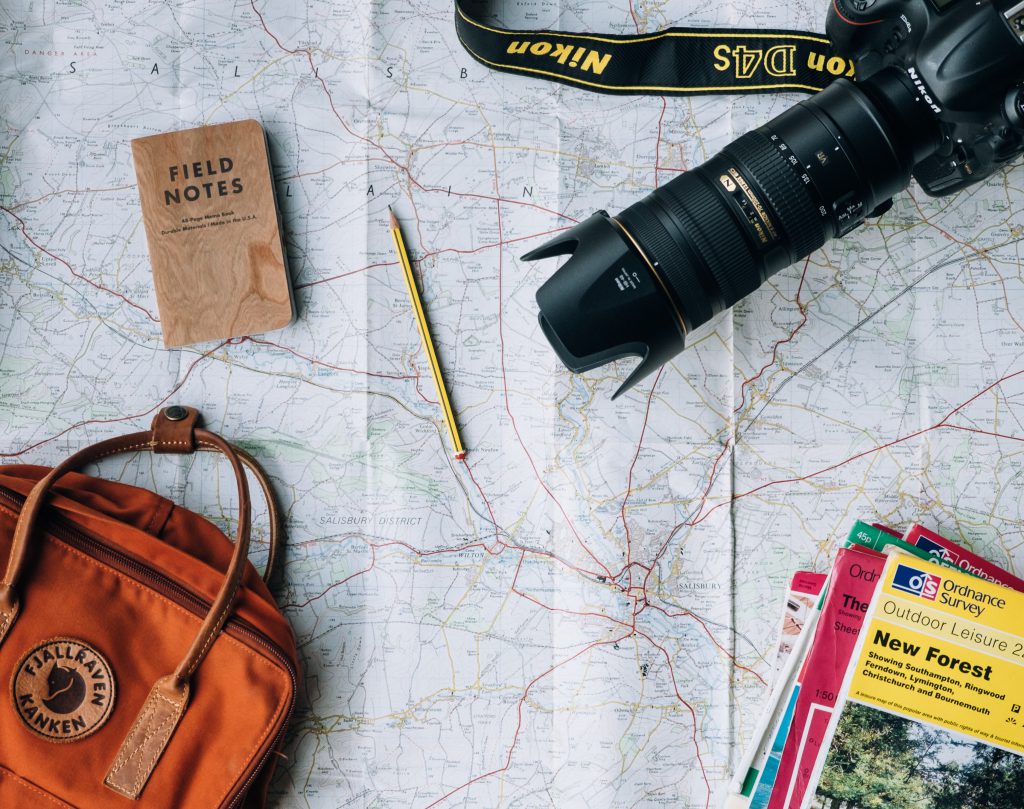
Couchsurfing can be a popular option for budget-conscious travelers looking to connect with locals and experience the culture firsthand. However, it’s important to note that Couchsurfing in Iran is officially illegal. While many independent travelers have reported using the resource and finding local hosts to be excellent guides, there are some risks involved.
One of the main concerns with Couchsurfing in Iran is the lack of official filters in place for hosts listed online. This means that travelers must exercise caution and take responsibility for their own safety. In the event that anything goes wrong, Couchsurfing hosts cannot be held responsible.
Despite these risks, Couchsurfing in Iran can be a rewarding experience for those who are willing to take the necessary precautions. It provides an opportunity to connect with locals and gain a deeper understanding of the country’s rich culture and history.
It’s important to note that while Couchsurfing may be illegal in Iran, it does happen anyway. However, travelers should be aware of the potential risks involved and take necessary precautions to ensure a safe and enjoyable experience. This may include carefully vetting potential hosts, staying in public areas, and communicating clearly with your host about your expectations and boundaries.
Solo Female Travel to Iran
Traveling alone as a woman in Iran can be a bit tough sometimes, but it can also be incredibly rewarding if you’re open to experiencing the unique culture and people here. While women might have some more rules to follow compared to men, many solo female travelers have found Iranians to be really friendly and kind.
Here are some things to keep in mind to make your trip smoother:
- Respect Local Customs: Especially in smaller and more traditional places like Yazd, Kashan, and Qom, it’s essential to dress modestly. That means avoiding clothes that are too revealing, as it might come across as disrespectful.
- No PDA: Public displays of affection, like hugging or kissing in public, aren’t allowed in Iran. However, friends of the same sex usually hug or kiss each other on the cheek and it’s considered normal.
Despite these things to watch out for, Iran is actually considered one of the safest countries for tourists . You can confidently explore its beautiful landscapes and rich culture, knowing that most locals will be warm and welcoming.
Just remember to be cautious like you would anywhere else. Stay away from poorly lit areas at night and keep an eye on your surroundings in crowded places. With some careful planning and an open attitude, traveling solo as a woman in Iran can be a really enriching experience that might change your life.
In the end, while it might require a bit more effort and attention to local customs, it’s a unique and rewarding way to discover this amazing country and make unforgettable memories.
Best Time to Travel to Iran
Iran is a year-round destination with diverse climates and landscapes, making it an ideal destination for travelers seeking a variety of experiences. However, the best time to visit Iran depends on the region you plan to visit and your personal preferences.
For the classic route , which includes popular destinations like Tehran , Kashan, Isfahan, Yazd , and Shiraz, the best time to visit is during the two high seasons. The first high season runs from early March to late May , while the second high season runs from early September to late November . During these periods, the weather is generally mild, and the landscapes are lush and green, making it ideal for sightseeing and outdoor activities.
If you’re planning to explore the Northwest and West route along the Zagros mountains , which includes destinations like Ardabil, Tabriz, Zanjan, Hamedan, Kermanshah, and Sanandaj, the best time to visit is during the high season from mid-April until mid-November . During this period, the weather is generally pleasant, and the landscapes are at their most picturesque.
If you’re thinking about visiting ski resorts in the northern part of Tehran like Dizin, Shemshak, and Tuchal, or if you’re headed to places in Southern Iran such as Ahwaz, Bushehr, Bandar Abbas, and the Persian Gulf Islands , the perfect time to go is from late November to late March . This is when the weather is cooler, and the ski resorts are at their busiest and most fun!
Keep in mind that July to September in Iran can get really hot, which might make the usual travel route not so comfy. But don’t worry! If you plan well and keep an eye on the weather, you can still have a great time visiting Iran during this time.
So, the ideal time to go to Iran depends on what you like and where you want to go. Iran has all sorts of landscapes and weather, so no matter when you decide to visit, you’ll always find something cool to do in this awesome country. For more detailed information about the best time to visit Iran based on your destination and weather, check out this article below:
Best Time To Travel To Iran: Your Ultimate Guide 2023
Iran UNESCO World Heritage Sites
Iran is a treasure trove of UNESCO World Heritage Sites that will leave you awestruck. With 26 sites recognized by UNESCO, including 24 cultural and two natural wonders , Iran boasts an ancient lineage that Iranians take pride in.
Each of these sites is the result of years of research and presentation of evidence to prove their significance to the world. From ancient palaces to stunning natural landscapes, these sites offer a glimpse into Iran’s rich cultural and historical heritage.
Visiting all of these sites would require multiple trips to Iran, but the effort is well worth it. Some of the most popular UNESCO World Heritage Sites in Iran include the ancient ruins of Persepolis , the stunning Sheikh Safi al-din Khanegah and Shrine Ensemble in Ardabil, and the beautiful Masjed-e Jāmé in Isfahan .
Other notable sites include the historic city of Yazd , the ancient hydraulic system of Shushtar , and the Tabriz Historic Bazaar Complex, which is one of the largest covered bazaars in the world.
If you’re into history, nature, and culture or want a fantastic travel adventure, Iran’s UNESCO World Heritage Sites have something for you. So, get your bags packed, plan your trip, and let’s explore the awesome things this amazing country has to offer. You can even join the UNESCO tour with To Iran Tour to see it all!
Dress Code in Iran
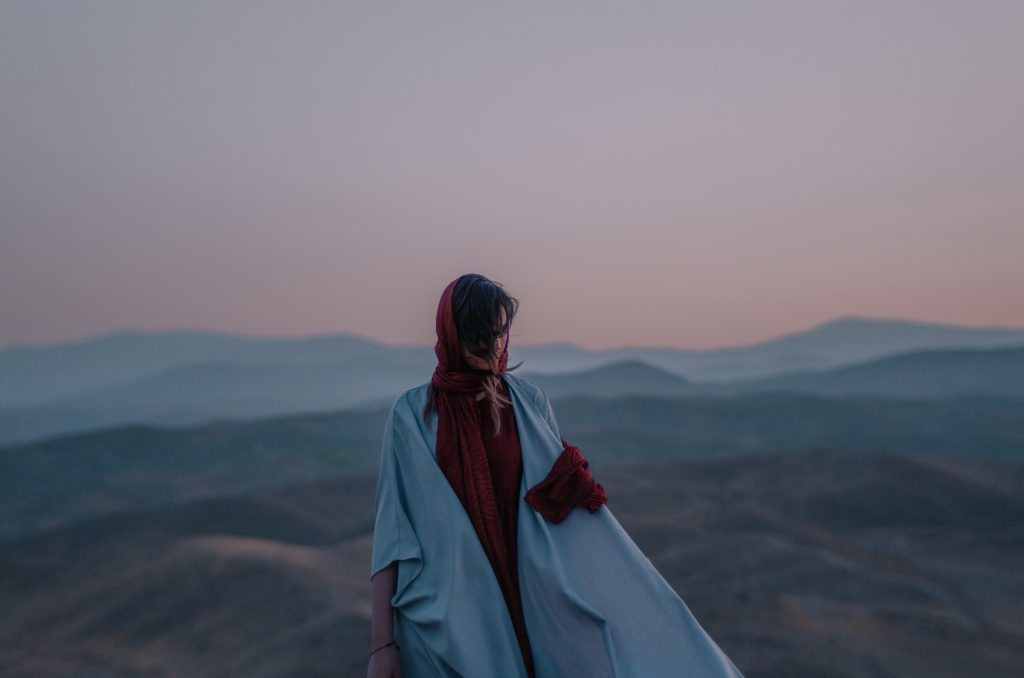
If you’re planning to visit Iran, it’s good to know that they have a dress code that you need to follow. As a woman, you should wear loose clothing that covers your body and a headscarf. But don’t worry, you don’t need to wear a burka or anything too concealing. You can still show off your personal style and wear clothes that make you feel confident and comfortable. Just keep in mind the local customs and you’ll be all set!
Even though there is a strict dress code in Iran, you’ll quickly see that it’s not as stereotypical as you might think. Iranian women are very fashionable and take pride in their appearance. Fashion is a way for them to express themselves and make a statement, and you’ll notice them wearing beautifully designed headscarves and stylish clothing that still comply with the Iranian dress code .
It’s also worth noting that the dress code applies to both men and women. Men are required to wear long-sleeved shirts and pants that cover their legs.
While it’s true that there is a “morality police” in Iran, whose job is to enforce the dress code and other moral codes of conduct in public, it’s important to note that they are not actively targeting foreign visitors. So, as a traveler to Iran, you don’t need to worry too much about being chased down by the morality police.
In general, if you show respect for local customs and adhere to the dress code regulations, you can have a secure and enjoyable travel experience in Iran. Therefore, don’t allow concerns about the morality police or any misunderstandings preventing you from exploring all the amazing things that this country has to offer.
Packing Tip for Travel to Iran
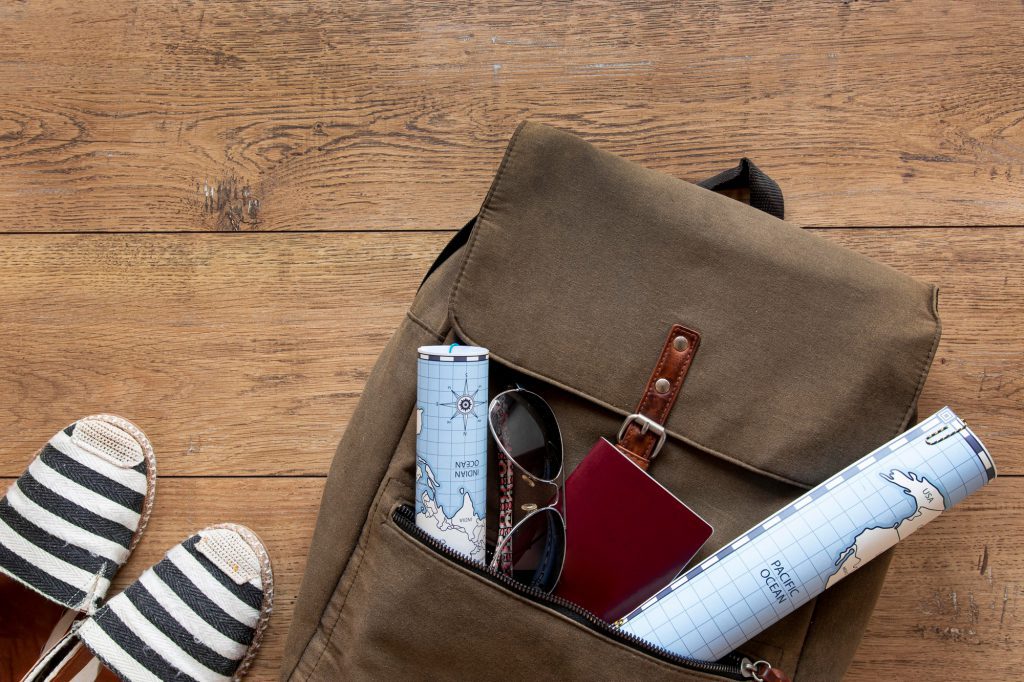
Packing for a trip to Iran can be a bit daunting, especially with the strict dress code regulations. However, with a little bit of preparation and the right mindset, you can embrace the local customs and still express your personal style.
The most immediate essential item to pack for Iran is a headscarf, also known as a ‘Roosari’ in Farsi. But don’t worry if it falls off – just put it back on again. While wearing a headscarf is mandatory, it’s common for Iranian women to wear it a little loose and halfway back on their head, with a high bun or ponytail to keep it in place. And if you’re worried about showing a little bit of hair, don’t be – it’s granted.
When it comes to tops, loose-fitting ones with three-quarter-length sleeves are ideal, especially in the heat. The general rule of thumb is that your body should be covered, and your arms should not be bare. As for trousers, they should be baggy, but tight, brightly colored leggings worn with a long, loose-fitting top are also acceptable, as long as your legs are covered down to the ankles.
The myth that you need to dress in dark colors or black tunics is just that – a myth. Embrace fashion the way the locals do, and bring some color into your Iran packing list! Open-toed sandals are OK, especially on hot days, and sports shoes are fashionable in Iran, especially in bright colors, so pack some for longer day trips.
If you’re worried about not having enough appropriate attire, fear not. As soon as you arrive in Tehran or Shiraz, hit the bazaars and local markets for plenty of options. And if you’re traveling with children, it’s worth noting that young boys can wear shorts and t-shirts, and girls under ten are not required to wear a headscarf.
For men, dressing in Iran is more straightforward, much like in Western countries, except for no short shorts, super short sleeves, or extremely tight-fitting clothing.
Overall, remember to approach the dress code with an open mind and respect for local customs. And don’t be afraid to express your personal style while still adhering to the guidelines. With the right attitude and a well-stocked suitcase, you can have a comfortable and enjoyable trip to Iran.
Is Iran Safe to Travel?
Even though some Western media might paint a different picture, Iran is a safe and friendly place for travelers. You might worry about safety because of politics and cultural differences, but the truth is that Iran is a great place to visit.
The people in Iran are super welcoming. You’ll meet lots of friendly locals who are excited to have you in their country. Whether you’re exploring busy markets or historical sites, Iran offers a one-of-a-kind travel experience.
Like anywhere else, it’s essential to be cautious and aware of your surroundings when you travel. But honestly, the chances of running into safety problems in Iran are pretty low. Many travelers say they feel safer here than in other popular tourist spots.
So, if you’re thinking about visiting Iran, don’t let safety worries stop you. With the right mindset and some preparation, you can have a safe and unforgettable trip to this fascinating country.
Iranians are known for their hospitality. They often go out of their way to help visitors, whether it’s giving directions, suggesting a great local restaurant, or offering you a ride. They might even share their contact info, just in case you need assistance. This shows how much they want you to feel welcome and at ease during your stay.
It’s also worth mentioning that Iranians want to break away from the negative image sometimes shown in the media. They’re proud of their culture and want you to see the beauty of their country and the warmth of their people.
As a visitor to Iran, you have a special chance to bridge cultural gaps and show Iranians that the world outside isn’t as unfriendly as they might think. By approaching your trip with an open mind and a desire to learn, you can make meaningful connections and get a deeper understanding of Iranian culture.
In the end, the hospitality and friendliness of the Iranian people are some of the best parts of traveling to this amazing country. So, don’t hesitate to engage with the locals and fully enjoy the rich cultural traditions that make Iran such a unique and captivating destination.
Is Iran Safe to Travel RIGHT NOW?
When thinking about visiting Iran, like any other place you might want to go, it’s a good idea to keep an eye on the news about politics and how your own country is getting along with Iran. But don’t worry too much because Iran is actually one of the safest countries in the Middle East for travelers.
Now and then, people in Iran might have protests about politics or money issues, but these usually stay in one place and don’t put tourists in danger. Just be smart and avoid those protest areas, like you would anywhere else.
Remember, Iran follows Islamic rules pretty strictly. So, things like drinking alcohol, doing drugs, or having romantic relationships with locals can get you in big trouble – like being kicked out of the country, getting arrested, or worse. But if you respect their way of doing things and follow the rules, you’ll have a great and safe time in Iran.
Overall, as long as you keep an eye on what’s happening and are careful, there’s no need to be super worried about going to Iran. If you go with the right attitude and prepare well, you’ll have a fantastic trip to this remarkable country.
Is Iran Safe to Visit 2024? A Comprehensive Overview
Essential Things to Remember When Visiting Iran
When you plan to visit Iran, it’s really important to be respectful and well-informed. Iran is a Muslim country where they take their rules seriously, especially Islamic law. So, it’s not a good idea to act like a clueless tourist and think you won’t get in trouble.
You see, what might be okay back home could get you into real trouble here. Iran has strict laws and customs, and it’s super important to follow them.
But here’s the good news. If you respect the local ways and follow the rules, you can have a safe and enjoyable trip to Iran. So, don’t let the strict rules scare you away. Come with an open mind and a desire to learn about the unique and fascinating culture of Iran. You’ll have a great time!
Is Iran an Arab Country?
There is a common misconception that Iran is an Arab country, fueled by its location in the Middle East, Muslim religion, and some similarities in culture and language. However, it’s important to note that Iran is not an Arab country, and Iranians are not Arabs.
Iranians speak Persian, also known as Farsi, which is not the same as Arabic. While there are many languages spoken within Iran, including Kurdish, Turkish, and Khuzi Arabic, the primary language is Persian. This is due to the many different ethnic groups that exist within the country, each with its own unique language and cultural traditions.
It’s crucial to acknowledge that misinterpreting Iranians as Arabs can lead to misunderstandings and hurt feelings. Although Iran has certain similarities with Middle Eastern Arab nations, it possesses a unique culture and history that distinguishes it.
In essence, when traveling to Iran, it’s vital to maintain an open-minded attitude and a genuine desire to explore the country’s distinctive cultural traditions and history. By recognizing the differences between Iran and its neighboring Arab nations, you can develop a greater appreciation for the richness and diversity of the entire region.
The Iranian currency system can be a bit confusing for those unfamiliar with it. Iran uses two units of currency, the Rial (IRR) and the Toman.
The Rial is the official currency of Iran. It has been the official currency since 1932, and the symbol for the Rial is “﷼”.
The Toman is not an official currency but is widely used in everyday transactions in Iran. The Toman is equal to 10 Rials. This practice of using the Toman as a unit of currency dates back to the early 20th century when the value of the Rial significantly decreased due to inflation.
To convert Rials to Tomans, you remove one zero from the Rial amount. For example, 1,000 Rials is equivalent to 100 Tomans. In practice, prices are often quoted in Tomans rather than Rials. For instance, if an item costs 10,000 Rials, it would be referred to as 1,000 Tomans. This pricing convention is used in everyday life, in markets, shops, and sometimes even on price tags.
The official currency notes in Iran are denominated in Rials, not Tomans. When you’re working with important papers, like contracts or international deals, you’ll often use the Rial as the currency.
The currency notes come in various denominations, including 1,000,000 Rials, 500,000 Rials, 100,000 Rials, 50,000 Rials , and so on.
Although the official currency is the Rial, the Toman is more commonly used and understood by Iranians in their daily lives. For example, if someone says a product costs 500,000, they most likely mean 500,000 Tomans, which is equal to 5,000,000 Rials.
Iran Travel Costs 2024: The Best Detailed Guide for Tourists
Currency Exchange in Iran
To get the best exchange rates , it’s recommended to take US Dollars or Euros with you and exchange them at reputable exchange offices. Let’s figure out more about exchanging money in Iran:
There are a few ways to exchange your money into Rials, and some are safer than others:
- One option is to go to the currency exchange at the airport. It’s a secure choice, but the exchange rate there might not be as good as what you’d find in the market.
- Another way is to exchange your money at the hotel or exchange offices in some hotels. Their rates are similar to what you’d get at the airport.
- If you’re in Tehran, you can also sell your foreign currency on Ferdowsi Street or at exchange offices in the city. These places have a wider range of rates, and they’re usually better than the airport rates.
The only catch is that you might not be headed to Ferdowsi Street on your trip. If you plan to visit the Tehran market, you can ask your guide (if you have one) to take you to Ferdowsi Street for currency exchange.
Just remember, it’s not a good idea to deal with people on the street who are buying and selling currency. Stick to the official exchange places for your safety.
Credit and Debit Cards during Iran Travel

If you’re planning a trip to Iran, it’s essential to understand the financial landscape and the options available for making transactions. Unfortunately, using credit or debit cards from outside of Iran is not possible due to the lack of an international card network.
This means that the best option is to bring enough cash with you to convert to an Iranian Rial. However, there is now a new option available for tourists and temporary visitors like the Mah Card and Irani Card .
The Mah Card is a prepaid debit card that can be used in Iran. Like most travel cards, you can instantly add funds to your card in your preferred or home currency, and it will be converted to Iranian Rial. The advantage of using the Mah Card is that it’s more convenient than carrying cash, protects you from unauthorized purchases, and is accepted country-wide.
So, if you’re looking for a safe and easy way to make transactions during your trip to Iran, consider getting a Mah Card. With this handy tool in your pocket, you can enjoy your travels without worrying about carrying large amounts of cash or the inconvenience of finding exchange offices.
Of course, there are other solutions, such as gift cards that are issued through banks, and to use this unofficial solution, you should ask your tour operator for help.
Public Transport in Iran
Exploring Iran’s cities is an adventure in itself, and luckily, there are plenty of public transport options available to help you get around!
Best Inner-City Transport Options
Metro (subway).
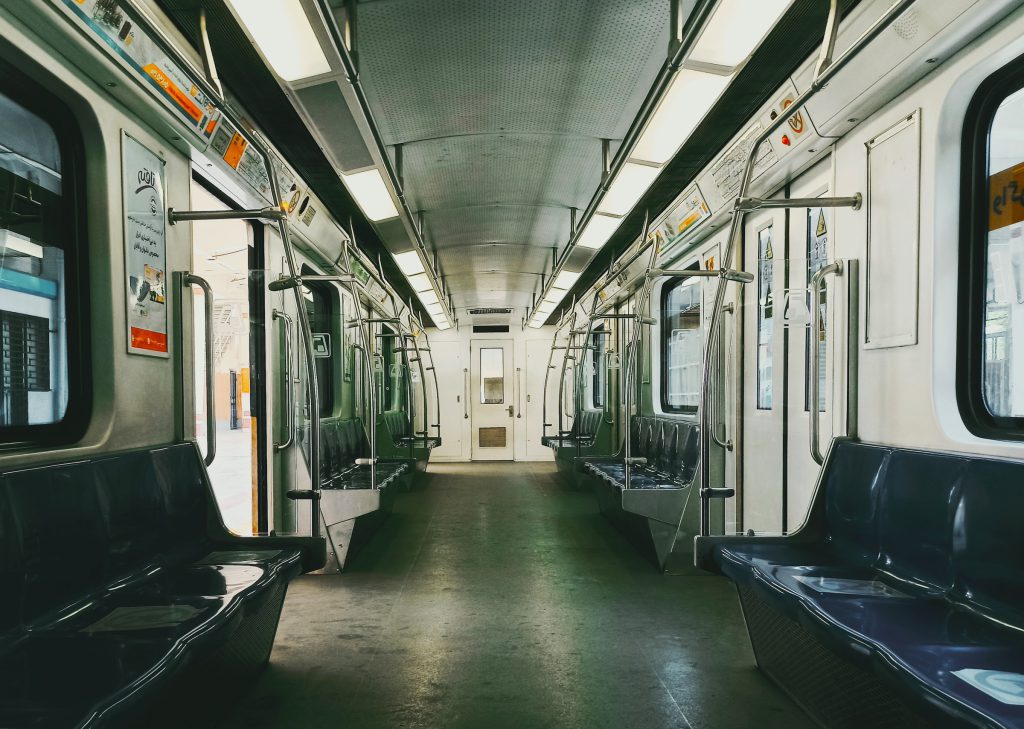
The Iranian Metro is a modern and efficient way to explore the city, especially in Tehran, Shiraz, Tabriz, Mashhad, and Isfahan. It’s the ideal option to get around Tehran, and the stations are easily accessible by taxi or bus.
The ticket price for one trip is about 3000 Tomans, which is equal to approximately 0.1$ in 2023, I know, it’s so cheap. Additionally, you can purchase a card to pay for the metro trips and even the buses in Tehran. Rush hours are typically from 7-9 a.m. and 5-7 p.m.
The metro guidance can be easily found in each station, but if you want to be prepared for your metro journey, check out the Tehran Metro website or other cities’ maps.
Buses are another popular option for inner-city transport in Iran. They are widely available and offer an affordable way to get around the city. Bus fares vary depending on the distance you are traveling, but they are generally inexpensive.
There are two main types of buses in big cities: Regular and BRT. You can pay for the buses using your Metro card, and fares typically range from 3000 to 10,000 Tomans (10 to 25 cents) per trip. You can easily locate all the bus and BRT stations on Google Maps.
In comparison to subways, buses are somehow time-consuming because of traffic jams. So, if your destination is near a subway station, our suggestion is to take the subway instead of the bus.
Another way to get around in the city is by taxi. There are different types of taxis available, including shuttle/shared taxis (Khatti in Farsi), private taxis (Darbast in Farsi), and non-registered taxis (Shakhsi in Farsi). Shuttle/shared taxis are a cheaper option, but they are for fixed destinations, and you may have to wait for the taxi to fill up. Private taxis are readily available, but you should negotiate the fare before getting in. Non-registered taxis are driven by people who are not licensed taxi drivers, and you need to negotiate the price with them too. It is advisable to get a shared Taxi or Private Taxi and not a non-registered one for your safety.
Of course, platforms such as Snapp and Tapsi have been launched, which have a function similar to Uber. You can download their applications from Google Play or directly from their websites and register with your Iranian SIM card.
Finally, if you need a taxi in a hurry, you can call the numbers 133, 1828, and 1833 in major cities in Iran to request a taxi wherever you are. This service is called “Bisim Taxi” and is available 24/7.
10 Essential Apps for Traveling to Iran: Empowering Your Exploration!
Intra-City Transport Options
Buses are a common and affordable way to travel between cities in Iran. There are two types of buses available: regular and VIP buses. VIP buses offer more legroom and comfortable seating, with space to almost lie down.
You can purchase bus tickets from the hotel front desk, local travel agencies, platforms such as SnappTrip, or directly from the bus terminal. Prices vary depending on the type of bus and the distance you are traveling. For instance, a VIP ticket from Tehran to Shiraz costs around 200,000 Tomans ($15).
There are three bus terminals in Tehran: Jonoub Terminal (South), Sharq Terminal (East), and Qarb or Bayhaghi Terminal (West). From these terminals, you can easily buy and board a bus and start your trip to other cities in Iran.
The train network in Iran is relatively extensive and offers a comfortable and scenic way to travel between cities. The trains are well-maintained and offer a range of seating options, from economy to first-class; But their speed and being on time cannot be compared with the European rail transport system.
Trains are the best and safest option for intercity travel in Iran. There are different types of trains available, including 4-bed, 6-bed, and bus trains. You can also choose between express and regular trains.
Book train tickets through online apps, local travel agencies, hotels, or directly at the train station. Prices vary depending on the distance and the type of train. For example, a ticket from Tehran to Yazd costs between 150,000 and 300,000 Tomans ($5 to $10).
Private Car
If you prefer a more flexible and personalized way to travel, you can also consider renting a private car with a driver. This option is more expensive than buses or trains, but it offers the freedom to explore at your own pace.
The Maxim platform has also provided the possibility of renting a car with a driver at a very reasonable price all over Iran. You can download its application from Google Play and register with your Iranian SIM card.
Domestic Flight
Finally, if you’re short on time or traveling long distances, you can opt for a domestic flight. The major cities in Iran are well-connected by domestic airlines, making it easy to get around the country quickly and efficiently.
Online platforms for selling Air tickets, such as Alibaba, provide the online purchase of domestic and international flight tickets.
By understanding the different transport options available in Iran, you can choose the one that suits your needs and budget and explore the country with ease.
Separated Men’s and Women’s Carriages in Iran’s Public Transport
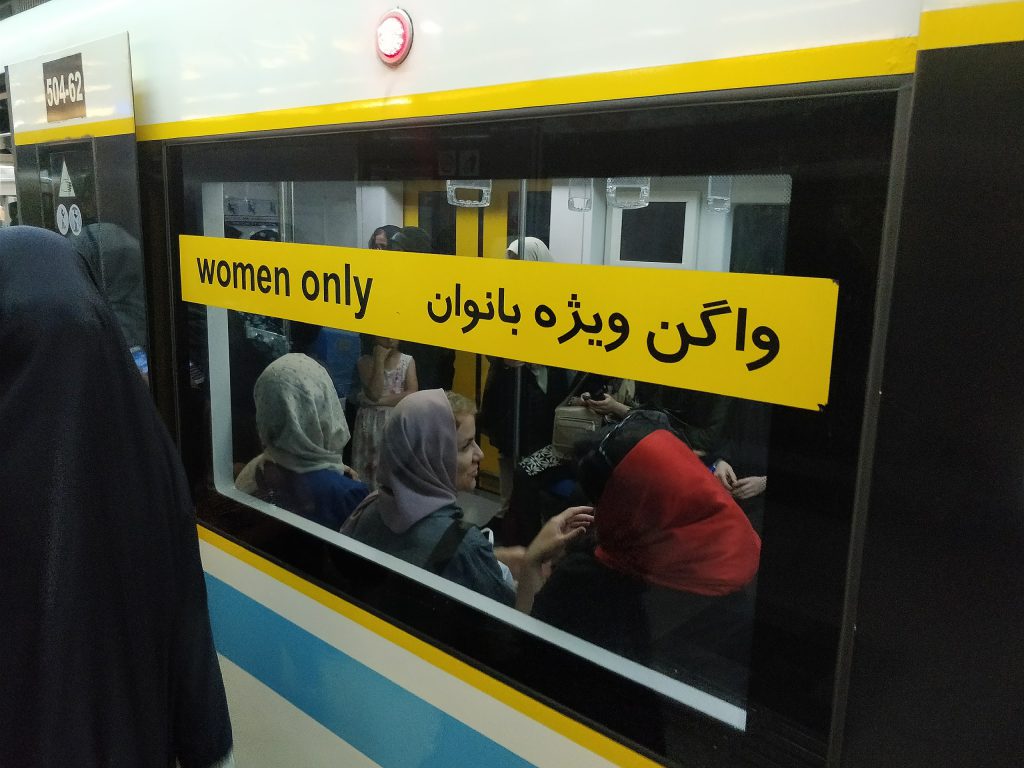
It’s important to note that there are some separate men’s and women’s carriages on public transport in Iran, both on the metro and buses for those women who prefer to use them. While subway cars are generally mixed-gender, women who want more privacy can choose to ride in the first and last wagon on both sides. On buses, there may be designated seating areas for men and women, with women sitting in the back and men in the front, or vice versa. However, couples can sit together in the men’s section but not in the women’s section. Respecting these gender-segregated arrangements while using public transport in Iran is essential.
Pre-register with the Foreign Office of Your Country
Before embarking on your journey to Iran, it’s important to research the specific travel regulations, rules, and warnings for your home country. Each country has its own guidelines, and it’s critical to be aware of them before setting off on your adventure.
To ensure your safety and peace of mind, it’s also a good idea to pre-register or alert your foreign office about your travel plans. This step is particularly important for British citizens , as there is no embassy representation in Iran. By registering with your foreign office, you can stay informed about any updates or changes in travel regulations or warnings.
It is important to note that certain travel insurance providers may ask you to inform the appropriate authorities about your travel plans before you can obtain coverage. To ensure that you are fully protected, it is essential to identify which authorities you need to inform before you leave.
By taking these steps before your trip, you can travel to Iran with confidence, knowing that you have done your due diligence to ensure your safety and security.
Internet Access during Iran Travel
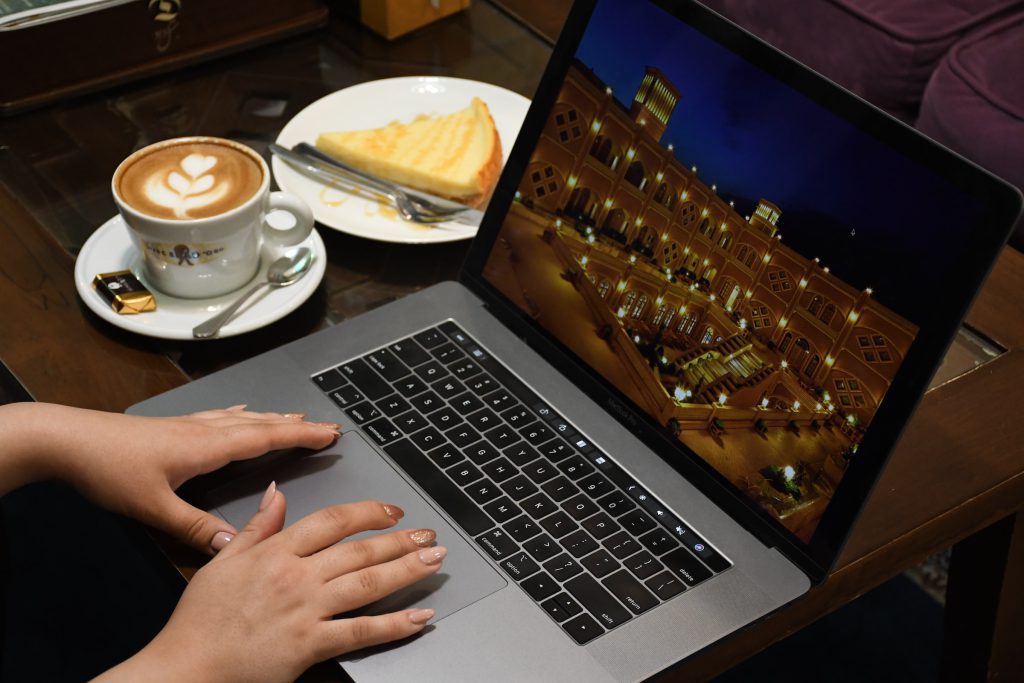
When traveling to Iran, it’s important to anticipate limited internet access and mandatory “digital filtering.” The Internet connection in Iran is known for being frustratingly slow, and many popular social media platforms such as Instagram, YouTube, and WhatsApp are blocked. Additionally, you need to pay fees for a good connection.
Make sure that you inform your family members or friends that you may be out of touch and to prepare for unreliable internet.
Recommended SIM Cards to Use in Iran
When it comes to buying a SIM card in Iran, Irancell is the top phone operator and offers temporary SIM cards specifically designed for tourists. These SIM cards come pre-loaded with a credit balance and 4G internet access, allowing you to stay connected with ease. They are sold at Tehran Imam Khomeini International Airport and are valid for 30 days.
Irancell’s temporary tourist SIM cards provide affordable and convenient connectivity throughout Iran.
You can buy regular Irancell SIM cards from their service centers located in almost every city. However, it’s important to note that you need to purchase charge and internet packages before using them. To do so, you can get assistance from Irancell staff at the centers, use the MTN Irancell application, or dial USSD codes.
Which VPN to use in Iran?
Staying connected while traveling in Iran can present unique challenges, particularly when it comes to accessing the internet and using your preferred VPN. To ensure that you can stay connected and protect your online privacy, it’s essential to find the right VPN for your needs.
There are several VPN options available for both Android and IOS users. For Android users, Hi VPN, Psiphon, v2ray, and Hotspot Shield are recommended, each offering reliable and secure connections. For IOS users, popular VPN options include Psiphon, Free VPN, and VPNProxyMaster, all of which are well-suited to use in Iran.
To have a suitable and safe VPN, you can ask your tour operator or tour guide for help. If you have any questions or help do not hesitate to ask To Iran Tour support team.
Persian Food
Iran is well-known for its varied and flavorful cuisine. If you’re a foodie who loves trying new things, you should definitely give Persian cuisine a try! Some must-try dishes include stews, Dizi (a lamb-based dish with broth and solids separated), Ash, and Haleem. To ensure you have the best experience, it’s important to do some research and find the top restaurants that serve these dishes so you can truly savor the flavors of Iran.
Persian Breakfast Guide: Irresistible Traditions!
Iranian food for vegetarians
In Iranian cuisine, meat is a staple ingredient, but there are also numerous vegetarian dishes that are just as delectable. Mirza-Ghasemi or Kashk-e Badenjan, both made with eggplant, are excellent choices. If you’re on a tight budget, go for Falafel, which is both inexpensive and delicious. However, it’s crucial to convey your dietary requirements to the restaurant staff and be ready to request that meat be omitted from your meal if needed.
By being open to trying new dishes, you can experience the rich and diverse cuisine of Iran with a little extra effort and creativity.
Drinking in Iran
When it comes to drinking in Iran, it’s important to note that alcohol is strictly prohibited, and there are no bars or clubs serving alcoholic beverages. Instead, you’ll find a variety of non-alcoholic beer options available, typically in fruity flavors such as peach, lemon, strawberry, etc.
Alcohol in Iran: A Complete Guide for Tourists
It’s important to understand that there are no exceptions when it comes to alcohol consumption in Iran, whether you’re a local or a traveler. While it’s tempting to take up offers from locals to find the “real deal” at underground gatherings, it’s not worth the risk. The punishment for alcohol possession or consumption can be severe, and there are no allowances made for tourists or visitors.
Did you know that Buttermilk, or “Doogh” as it’s called in Iran, is a delicious fermented dairy drink? It has a slightly sour taste and is often paired with dried herbs like mint for a refreshing flavor. It is very common to enjoy Doogh besides any kind of kebab.
Iranian Etiquette
When visiting Iran, it’s important to be aware of and respectful of the cultural and religious customs that may differ from your own. By following these customs, you can demonstrate your appreciation for Iranian culture and enjoy your trip to the fullest. Here are some etiquette guidelines and fascinating insights into Iranian culture to keep in mind:
- One of the primary forms of social etiquette is “ Taarof” , where Iranians may insist on offering things to people, even if they don’t mean it. As a visitor, it is important to be aware of local customs and not immediately accept an offer.
- During the Muharram month , which is the mourning month of Imam Hossein, to show respect for religious beliefs, it’s best to avoid wearing bright colors, especially red.
- During Ramadan, eating or drinking in public is disrespectful while most people are fasting during the day.
- Shaking hands between men and women can be a delicate matter, and it is generally unacceptable for unrelated men and women to engage in this gesture. As a female tourist, it is advisable to wait and observe if men initiate the handshake first, instead of initiating it yourself.
- The thumbs-up hand signal is OKAY in Iran, but it is better not to use it in the presence of older people. However, younger people understand its meaning.
- In Iran, there are certain limitations when it comes to public displays of affection. While affectionate gestures like touching, kissing and handshakes between family members are acceptable, French kissing is considered inappropriate. Holding hands is generally tolerated, but hugging might be regarded as crossing the line. It’s important to note that inside holy places and religious cities, any public display of affection may not be tolerated at all.
For a truly enriching travel experience, it’s important to embrace and appreciate the customs and culture of Iran. By respecting their traditions, you’ll gain a deeper understanding and connection to the country and its people.
Time in Iran and the Solar Calendar
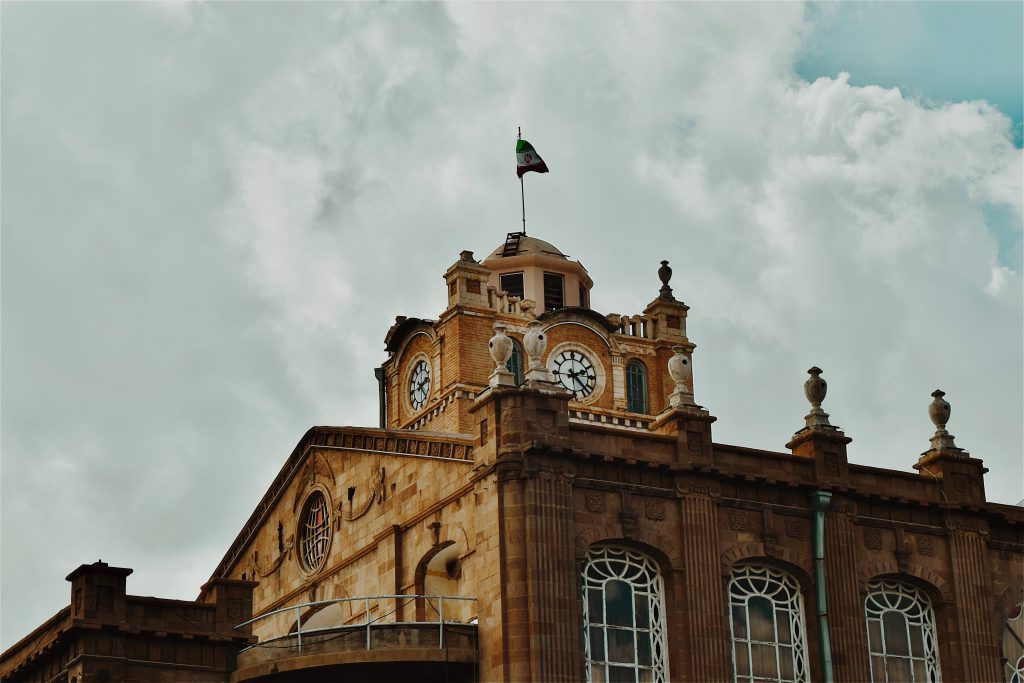
The country operates on Iran Standard Time (IRST), which is UTC+3:30.
The Solar Hijri Calendar
The solar calendar used in Iran is known as the Iranian calendar or the Persian calendar . It is a type of solar calendar that is based on the astronomical observations of the Sun’s movement. The calendar has its roots in ancient Persia and has undergone several modifications throughout history to align it with various astronomical and cultural considerations.
Here are some key differences between the Iranian calendar and the commonly used Gregorian calendar:
- Starting point: The Iranian calendar starts from the year of the Prophet Muhammad’s migration from Mecca to Medina, known as the Hijra. This event occurred in 622 CE in the Gregorian calendar. Therefore, the Iranian year is approximately 621 years behind the Gregorian year.
- Length of the year: The Iranian calendar is a solar calendar that consists of 12 months, each with varying lengths. The total length of a year in the Iranian calendar is approximately 365 or 366 days, depending on whether it is a leap year or not. Leap years occur every four years and consist of an additional day, just like in the Gregorian calendar.
- Naming of the months: The Iranian calendar has its own set of month names, which are deeply rooted in Persian culture and history. The names of the months are as follows: Farvardin, Ordibehesht, Khordad, Tir, Mordad, Shahrivar, Mehr, Aban, Azar, Dey, Bahman, and Esfand.
- Different New Year: The Iranian New Year , known as Nowruz, is celebrated on the vernal equinox, which usually falls on March 20th or 21st in the Gregorian calendar. Nowruz marks the beginning of spring and is one of the most significant holidays in Iran and several other countries in the region.
- Different era: The Iranian calendar uses the Islamic lunar Hijri era, which began with the Hijra mentioned earlier. In contrast, the Gregorian calendar uses the widely accepted Common Era (CE) system.
Time is a curious thing. It flows differently for each culture and place, shaped by history, geography, and tradition.
While visiting Iran, it’s best to keep an open mind when it comes to timeframes. It’s a good idea to bring along some extra patience and be ready to go with the flow. This is especially true when it comes to food, service, and payment. By embracing the relaxed pace of life in Iran, you can fully immerse yourself in the local culture and enjoy a more laid-back travel experience.
Read more on Iran’s History and Iran Travel
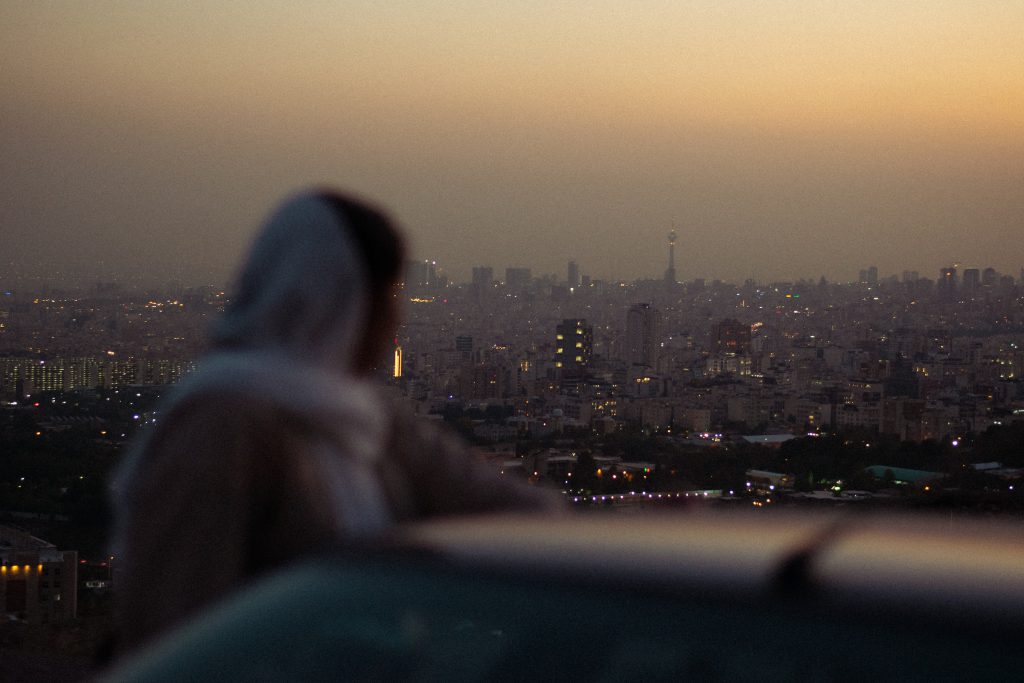
Iran boasts a complex and fascinating history, which can be difficult to comprehend without prior knowledge. Even though tour guides can be informative, it’s recommended to do some research on the history of Persia and the events leading up to the Iranian Revolution in 1979 before embarking on a trip to Iran. This will enable you to gain a better understanding of the country’s composition and value its abundant cultural heritage.
Book Recommendation
Here are some excellent books to read before your trip:
- “Revolutionary Iran: A History of the Islamic Republic” by Michael Axworthy provides a comprehensive overview of recent Iranian history.
- “Iran: What Everyone Needs to Know” is also by Axworthy and delves into Iran’s economy, politics, culture, and people.
- “Daughter of Persia: A Woman’s Journey from Her Father’s Harem Through the Islamic Revolution” is a fascinating book. The story follows a woman born in Iran who went to study in the United States and later returned to the country amidst significant changes.
If you’re traveling in Iran, the Lonely Planet guidebook can be a valuable resource for exploring historical landmarks. While it’s not the only source of information, it’s a helpful tool to have with you since internet access in Iran may be limited.
To make the most of your trip to Iran, it’s a great idea to get to know its history and culture beforehand. Trust me, it will definitely enhance your travel experience!
FAQs about Visiting Iran
Q1: do i need a visa to visit iran.
A1: Yes, most travelers require a visa to enter Iran. You can obtain one through an Iranian embassy or consulate in your home country. There are some countries that can travel to Iran without a visa, and there are also some countries that can get their visa on arrival.
Q2: What is the best time to visit Iran?
A2: Spring (March to May) and autumn (September to November) are ideal times to visit, as the weather is mild, and many attractions are at their best. But Iran has varied weather across different regions. For instance, the ideal season to tour Iranian deserts is winter.
Q3: Is it safe to travel to Iran?
A3: Iran is generally safe for tourists, with low crime rates. However, it’s essential to stay informed about the current political situation and follow local guidelines.
Q4: What is the official currency in Iran?
A4: The official currency is the Iranian Rial (IRR), but you’ll commonly see prices quoted in Toman, which is equivalent to 10 Rials.
Q5: Can I use my credit card in Iran?
A5: No, international credit and debit cards are not widely accepted in Iran. Bring cash in US dollars or Euros and exchange it locally.
Q6: Is it safe for solo female travelers in Iran?
A6: Yes, Iran is considered safe for solo female travelers, but it’s important to dress modestly and be aware of local customs and norms.
Q7: Can I drink alcohol in Iran?
No, alcohol is strictly prohibited in Iran due to Islamic law. You won’t find it in public places.
Q8: What languages are spoken in Iran?
Persian (Farsi) is the official language, but many Iranians also speak English, especially in tourist areas.
Q9: Can I use social media in Iran?
Most social media platforms like Facebook and Twitter are blocked in Iran. However, you can access them using a VPN.
Q10: What is Iran famous for?
Iran is famous for its rich cultural heritage, historical sites, and stunning architecture. It’s renowned for attractions like the ancient city of Persepolis, the vibrant bazaars of Isfahan and Tabriz, and the beautiful mosques, such as the Pink Mosque in Shiraz. Iran is also known for its contributions to literature, poetry, and art, with famous poets like Rumi and Hafez hailing from this region. Additionally, Iran is celebrated for its world-class Persian rugs, saffron production, and traditional handicrafts.
Discover the Beauty of Iran with ToIranTour Services
Leave a reply cancel reply.
Your email address will not be published. Required fields are marked *
Save my name, email, and website in this browser for the next time I comment.
Free Iran Travel Consultation
Let us know whatever you need for your trip, and we assist in arranging everything needed
Recent Posts
- Iran Villages: Top 10 Places to Experience
- Places to Go in Iran: Top 10 Archeological Sites
- St Thaddeus: A Beacon of Hope in the Apostolic Era
- Iran Archaeology: Exploring Ancient Marvel
- Iran Railway: An Architectural Triumph
Discover the most outstanding articles on all topics of life. Write your stories and share them
- Iran Visa Policy
- Apply for Iran visa
- Active Style
- Inside Style
- Discovery Style
- In-Depth Style
- Knowledge Based Style
- Daily Tours
- Why “To Iran Tour”?
- Partnership with To Iran Tour
Find Your Account
Cookies on GOV.UK
We use some essential cookies to make this website work.
We’d like to set additional cookies to understand how you use GOV.UK, remember your settings and improve government services.
We also use cookies set by other sites to help us deliver content from their services.
You have accepted additional cookies. You can change your cookie settings at any time.
You have rejected additional cookies. You can change your cookie settings at any time.
- Passports, travel and living abroad
- Travel abroad
- Foreign travel advice
Warnings and insurance
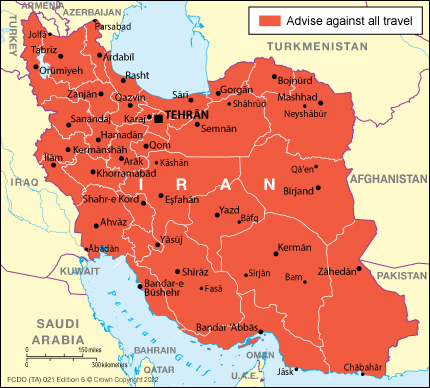
The Foreign, Commonwealth & Development Office ( FCDO ) provides advice about risks of travel to help British nationals make informed decisions. Find out more about FCDO travel advice .
FCDO advises against all travel to Iran
Your travel insurance could be invalidated if you travel against FCDO advice. Consular support is also severely limited where FCDO advises against travel.
If you’re a British national already in Iran, either resident or visitor, carefully consider your presence there and the risks you take by staying.
FCDO advises against all travel to Iran. British and British-Iranian dual nationals are at significant risk of arbitrary arrest, questioning or detention in Iran. Holding a British passport can be reason enough for the Iranian authorities to question you. If you are detained in Iran, you could face months or years in prison.
Find out more about why FCDO advises against travel .
Risks to British nationals in Iran
Consular support is extremely limited in Iran. If you need consular assistance you should contact the British Embassy in Tehran .
FCDO advises against all travel to Iran. British and British-Iranian dual nationals are at significant risk of arbitrary arrest, questioning or detention in Iran. Holding a British passport can be reason enough for the Iranian authorities to question you. If you are detained in Iran, you could face months or years in prison.
Find out more about why FCDO advises against travel
Dual nationals
The Iranian authorities do not recognise dual nationality. If you are a British-Iranian dual national and you are detained in Iran, the authorities will not tell FCDO or grant FCDO access to see you. If you are detained, your case will be in the hands of the Iranian authorities, who have shown a pattern of hostility towards the UK and British citizens.
Before you travel
FCDO advises against all travel to Iran.
No travel can be guaranteed safe. Read all the advice in this guide as well as support for British nationals abroad which includes:
- advice on preparing for travel abroad and reducing risks
- information for women, LGBT+ and disabled travellers
Follow and contact FCDO travel on Twitter , Facebook and Instagram . You can also sign up to get email notifications when this advice is updated.
Travel insurance
If you choose to travel, research your destinations and get appropriate travel insurance . Insurance should cover your itinerary, planned activities and expenses in an emergency.
Related content
Is this page useful.
- Yes this page is useful
- No this page is not useful
Help us improve GOV.UK
Don’t include personal or financial information like your National Insurance number or credit card details.
To help us improve GOV.UK, we’d like to know more about your visit today. Please fill in this survey (opens in a new tab) .
- Skip to main content
- Skip to "About this site"
Language selection
Search travel.gc.ca.
Help us to improve our website. Take our survey !
COVID-19: travel health notice for all travellers
Iran travel advice
Latest updates: The Health section was updated - travel health information (Public Health Agency of Canada)
Last updated: May 6, 2024 10:24 ET
On this page
Safety and security, entry and exit requirements, laws and culture, natural disasters and climate, iran - avoid all travel.
You should consider leaving by commercial means if you can do so safely. Our ability to provide consular services in Iran is severely limited.
Back to top
There is no resident Canadian government office in the country. The ability of Canadian officials to provide consular assistance is extremely limited.
Canadians in Iran may be closely watched by Iranian authorities. Seemingly innocuous behaviours, such as the use of cameras in public places, travel beyond well-established tourist attractions or casual interactions with Iranian friends, may be misinterpreted and may lead to investigation.
Demonstrations
Political demonstrations and gatherings may occur.
Large-scale and violent protests took place across Iran in the Fall of 2022 following the strict enforcement of the hijab law by the Iranian authorities. Security forces strongly repressed demonstrators resulting in numerous arrests, injuries and casualties. In some cases, arrested individuals were sentenced to death for charges arising from their participation in the demonstrations.
The situation remains highly volatile and could escalate without notice. Even peaceful demonstrations can turn violent at any time. Security forces could use excessive and lethal force to disperse crowds. They can also lead to disruptions to traffic and public transportation. Disruptions to telecommunications services, including mobile internet access, may occur during large-scale demonstrations.
- Avoid areas where demonstrations and large gatherings are taking place
- Monitor local and international media for information on ongoing demonstrations
Mass gatherings (large-scale events)
Border areas
Pakistan and afghanistan.
Bandits in border areas with Afghanistan and Pakistan are usually involved in drug trafficking and use kidnapping to secure the release of group members from prison.
Sistan-Baluchistan, which borders Pakistan, is regularly affected by ethnic conflicts and is also a known route for smugglers. Foreign nationals have been the target of kidnappings.
Terrorist attacks may also occur in this province.
If you decide to travel overland to Pakistan and Afghanistan despite this warning:
- travel only on main roads
- travel in organized groups
- avoid travel after dark
The province of Khuzestan borders Iraq. It is regularly affected by ethnic conflicts. Foreign nationals have been the target of kidnappings.
Border with Iraq is usually closed. It can be opened on a case-by-case basis to allow the passage of certain foreigners or to give refugees access to containment camps located on the Iranian side of the border.
Azerbaijan and Turkmenistan
The borders with Azerbaijan and Turkmenistan are open only to citizens of those countries.
Foreigners travelling in the vicinity of these sensitive borders often attract the attention of local security forces, which can result in short periods of detention.
There is an increased threat of attacks against Western interests and of terrorist attacks in general. The security situation could worsen rapidly and with little warning.
Attacks have targeted:
- foreign interests
- Iranian military and government establishments
- tourist attractions and popular public places
- nightclubs and entertainment venues
- public transportation
Further attacks may occur, and terrorists may also target:
- crowded places
- places with high pedestrian traffic where foreigners may gather
- commercial establishments
- local government offices
- public transit stations
- busy streets
- places of worship
Exercise a high degree of caution at all times.
Kidnapping for ransom can occur, especially in Baluchistan and in the border areas with Afghanistan and Pakistan. Foreign nationals have also been the target of kidnapping.
Use varied and unpredictable routes and schedules when moving from one place to another.
Petty crime
Petty crime, such as pickpocketing and purse snatching, occurs. Violent crime affects both Iranians and foreigners.
Thieves often target four-wheel-drive vehicles.
Plainclothes individuals may pose as police officers and ask to see foreign currency and passports. If you are approached, you should politely decline to cooperate but offer to go to the nearest police station.
- Avoid showing signs of affluence, such as flashy jewellery
- Ensure personal belongings, including your passports and other travel documents, are secure at all times
- Carry a photocopy of your passport’s identification page at all times and leave a photocopy with a relative
- Don’t surrender any documents or cash
- Stay in touch with family and friends, especially if you’re travelling alone
- Avoid walking after dark
Women's safety
Women may be subject to some forms of harassment and verbal abuse. Gender-based violence is common in Iran.
Some Canadian and Canadian-Iranian women have been stranded in Iran or mistreated by an Iranian husband or a male relative. Local authorities consider domestic violence to be a private matter and rarely discuss it in public.
Women and children require the permission of the husband, or an Iranian male head of household, to obtain a passport or travel document. They also require permission to leave the country.
The dress code is strictly enforced in Iran. Women must wear a headscarf and a long jacket that covers the arms and upper legs while in public.
Advice for women travellers
Road safety
Road conditions and road safety can vary greatly throughout the country, and city streets are poorly lit. The highway system is relatively well developed.
Trucks run mostly at night, often without headlights. Motorists are reckless and don’t respect traffic laws. They almost never give way to pedestrians at designated crossing points. Parked cars may obstruct sidewalks on main roads in urban areas. Sidewalks are rare in residential areas.
Expect roadblocks and checkpoints.
- Avoid travelling at night
- Consider hiring a personal driver who’s familiar with local conditions
- If you are involved in an accident, remain at the scene until authorities arrive
Public transportation
Most taxis don’t have meters. Drivers often overcharge foreigners.
- Only hire official taxis from agencies or hotel-based companies
- Take pre-booked official taxis, which are safer than those hailed from the street
- Negotiate fares in advance, or insist that the driver use the meter
- Never enter a cab if it already has one or more passengers
- Note the licence plate number and name of the driver when you travel
- Immediately communicate this information to family or friends
Railway transport
Trains are comfortable and punctual, but service is limited and slow.
Iran and the United Arab Emirates both claim sovereignty over the islands in the Gulf and the military patrols the waters. Foreigners navigating Iranian waters have been arrested and detained. In September 2019, Iranian authorities specifically called for the seizure of Canadian assets and vessels.
Exercise caution if travelling by sea, including for recreational purposes, particularly around the disputed islands of Abu Musa and Tunb.
We do not make assessments on the compliance of foreign domestic airlines with international safety standards.
Information about foreign domestic airlines
Every country or territory decides who can enter or exit through its borders. The Government of Canada cannot intervene on your behalf if you do not meet your destination’s entry or exit requirements.
We have obtained the information on this page from the Iranian authorities. It can, however, change at any time.
Verify this information with the Foreign Representatives in Canada .
Canadians can verify this information with the Interests Section of the Islamic Republic of Iran of the Embassy of Pakistan in Washington, D.C.
- Interests Section of the Islamic Republic of Iran – Embassy of Pakistan in Washington, D.C.
Entry requirements vary depending on the type of passport you use for travel.
Before you travel, check with your transportation company about passport requirements. Its rules on passport validity may be more stringent than the country’s entry rules.
Regular Canadian passport
Your passport must be valid for at least 6 months beyond the date you expect to leave Iran.
Passport for official travel
Different entry rules may apply.
Official travel
Passport with “X” gender identifier
While the Government of Canada issues passports with an “X” gender identifier, it cannot guarantee your entry or transit through other countries. You might face entry restrictions in countries that do not recognize the “X” gender identifier. Before you leave, check with the closest foreign representative for your destination.
Other travel documents
Different entry rules may apply when travelling with a temporary passport or an emergency travel document. Before you leave, check with the closest foreign representative for your destination.
Useful links
- Foreign Representatives in Canada
- Canadian passports
Tourist visa: required Business visa: required Student visa: required Pilgrimage visa: required Press visa: required Transit visa: required
Overstaying your visa period may lead to detention, imprisonment and fines. You will be required to remain in Iran until the situation has been resolved.
- E-Visa Portal – Ministry of Foreign Affairs of the Government of Iran
Transit pass
If you enter Iran with a transit pass issued by an Iranian embassy or consulate abroad, you may have to obtain an Iranian passport to exit the country.
Regional travel
Canadians have been denied entry into Iran because their passports bore an Israeli visa, an Israeli border stamp or an Egyptian or Jordanian border stamp issued by an office bordering Israel. Such a stamp would indicate the traveller entered from Israel.
Children and travel
Learn more about travelling with children .
Yellow fever
Learn about potential entry requirements related to yellow fever (vaccines section).
Relevant Travel Health Notices
- Global Measles Notice - 13 March, 2024
- COVID-19 and International Travel - 13 March, 2024
This section contains information on possible health risks and restrictions regularly found or ongoing in the destination. Follow this advice to lower your risk of becoming ill while travelling. Not all risks are listed below.
Consult a health care professional or visit a travel health clinic preferably 6 weeks before you travel to get personalized health advice and recommendations.
Routine vaccines
Be sure that your routine vaccinations , as per your province or territory , are up-to-date before travelling, regardless of your destination.
Some of these vaccinations include measles-mumps-rubella (MMR), diphtheria, tetanus, pertussis, polio, varicella (chickenpox), influenza and others.
Pre-travel vaccines and medications
You may be at risk for preventable diseases while travelling in this destination. Talk to a travel health professional about which medications or vaccines may be right for you, based on your destination and itinerary.
Yellow fever is a disease caused by a flavivirus from the bite of an infected mosquito.
Travellers get vaccinated either because it is required to enter a country or because it is recommended for their protection.
- There is no risk of yellow fever in this country.
Country Entry Requirement*
- Proof of vaccination is required if you are coming from or have transited through an airport of a country where yellow fever occurs.
Recommendation
- Vaccination is not recommended.
- Discuss travel plans, activities, and destinations with a health care professional.
- Contact a designated Yellow Fever Vaccination Centre well in advance of your trip to arrange for vaccination.
About Yellow Fever
Yellow Fever Vaccination Centres in Canada * It is important to note that country entry requirements may not reflect your risk of yellow fever at your destination. It is recommended that you contact the nearest diplomatic or consular office of the destination(s) you will be visiting to verify any additional entry requirements.
There is a risk of hepatitis A in this destination. It is a disease of the liver. People can get hepatitis A if they ingest contaminated food or water, eat foods prepared by an infectious person, or if they have close physical contact (such as oral-anal sex) with an infectious person, although casual contact among people does not spread the virus.
Practise safe food and water precautions and wash your hands often. Vaccination is recommended for all travellers to areas where hepatitis A is present.
Measles is a highly contagious viral disease. It can spread quickly from person to person by direct contact and through droplets in the air.
Anyone who is not protected against measles is at risk of being infected with it when travelling internationally.
Regardless of where you are going, talk to a health care professional before travelling to make sure you are fully protected against measles.
Hepatitis B is a risk in every destination. It is a viral liver disease that is easily transmitted from one person to another through exposure to blood and body fluids containing the hepatitis B virus. Travellers who may be exposed to blood or other bodily fluids (e.g., through sexual contact, medical treatment, sharing needles, tattooing, acupuncture or occupational exposure) are at higher risk of getting hepatitis B.
Hepatitis B vaccination is recommended for all travellers. Prevent hepatitis B infection by practicing safe sex, only using new and sterile drug equipment, and only getting tattoos and piercings in settings that follow public health regulations and standards.
Coronavirus disease (COVID-19) is an infectious viral disease. It can spread from person to person by direct contact and through droplets in the air.
It is recommended that all eligible travellers complete a COVID-19 vaccine series along with any additional recommended doses in Canada before travelling. Evidence shows that vaccines are very effective at preventing severe illness, hospitalization and death from COVID-19. While vaccination provides better protection against serious illness, you may still be at risk of infection from the virus that causes COVID-19. Anyone who has not completed a vaccine series is at increased risk of being infected with the virus that causes COVID-19 and is at greater risk for severe disease when travelling internationally.
Before travelling, verify your destination’s COVID-19 vaccination entry/exit requirements. Regardless of where you are going, talk to a health care professional before travelling to make sure you are adequately protected against COVID-19.
The best way to protect yourself from seasonal influenza (flu) is to get vaccinated every year. Get the flu shot at least 2 weeks before travelling.
The flu occurs worldwide.
- In the Northern Hemisphere, the flu season usually runs from November to April.
- In the Southern Hemisphere, the flu season usually runs between April and October.
- In the tropics, there is flu activity year round.
The flu vaccine available in one hemisphere may only offer partial protection against the flu in the other hemisphere.
The flu virus spreads from person to person when they cough or sneeze or by touching objects and surfaces that have been contaminated with the virus. Clean your hands often and wear a mask if you have a fever or respiratory symptoms.
Malaria is a serious and sometimes fatal disease that is caused by parasites spread through the bites of mosquitoes. Limited malaria transmission may occur in this destination, but risk to travellers is very low. Antimalarial medication is not recommended for most travellers. Consult a health care professional or visit a travel health clinic before travelling to discuss your options. It is recommended to do this 6 weeks before travel, however, it is still a good idea any time before leaving. Protect yourself from mosquito bites at all times:
- Cover your skin and use an approved insect repellent on uncovered skin.
- Exclude mosquitoes from your living area with screening and/or closed, well-sealed doors and windows.
- Use insecticide-treated bed nets if mosquitoes cannot be excluded from your living area.
- Wear permethrin-treated clothing.
If you develop symptoms similar to malaria when you are travelling or up to a year after you return home, see a health care professional immediately. Tell them where you have been travelling or living.
In this destination, rabies is commonly carried by dogs and some wildlife, including bats. Rabies is a deadly disease that spreads to humans primarily through bites or scratches from an infected animal. While travelling, take precautions , including keeping your distance from animals (including free-roaming dogs), and closely supervising children.
If you are bitten or scratched by a dog or other animal while travelling, immediately wash the wound with soap and clean water and see a health care professional. In this destination, rabies treatment may be limited or may not be available, therefore you may need to return to Canada for treatment.
Before travel, discuss rabies vaccination with a health care professional. It may be recommended for travellers who are at high risk of exposure (e.g., occupational risk such as veterinarians and wildlife workers, children, adventure travellers and spelunkers, and others in close contact with animals).
Safe food and water precautions
Many illnesses can be caused by eating food or drinking beverages contaminated by bacteria, parasites, toxins, or viruses, or by swimming or bathing in contaminated water.
- Learn more about food and water precautions to take to avoid getting sick by visiting our eat and drink safely abroad page. Remember: Boil it, cook it, peel it, or leave it!
- Avoid getting water into your eyes, mouth or nose when swimming or participating in activities in freshwater (streams, canals, lakes), particularly after flooding or heavy rain. Water may look clean but could still be polluted or contaminated.
- Avoid inhaling or swallowing water while bathing, showering, or swimming in pools or hot tubs.
Cholera is a risk in parts of this country. Most travellers are at very low risk.
To protect against cholera, all travellers should practise safe food and water precautions .
Travellers at higher risk of getting cholera include those:
- visiting, working or living in areas with limited access to safe food, water and proper sanitation
- visiting areas where outbreaks are occurring
Vaccination may be recommended for high-risk travellers, and should be discussed with a health care professional.
Travellers' diarrhea is the most common illness affecting travellers. It is spread from eating or drinking contaminated food or water.
Risk of developing travellers' diarrhea increases when travelling in regions with poor standards of hygiene and sanitation. Practise safe food and water precautions.
The most important treatment for travellers' diarrhea is rehydration (drinking lots of fluids). Carry oral rehydration salts when travelling.
Typhoid is a bacterial infection spread by contaminated food or water. Risk is higher among children, travellers going to rural areas, travellers visiting friends and relatives or those travelling for a long period of time.
Travellers visiting regions with a risk of typhoid, especially those exposed to places with poor sanitation, should speak to a health care professional about vaccination.
Insect bite prevention
Many diseases are spread by the bites of infected insects such as mosquitoes, ticks, fleas or flies. When travelling to areas where infected insects may be present:
- Use insect repellent (bug spray) on exposed skin
- Cover up with light-coloured, loose clothes made of tightly woven materials such as nylon or polyester
- Minimize exposure to insects
- Use mosquito netting when sleeping outdoors or in buildings that are not fully enclosed
To learn more about how you can reduce your risk of infection and disease caused by bites, both at home and abroad, visit our insect bite prevention page.
Find out what types of insects are present where you’re travelling, when they’re most active, and the symptoms of the diseases they spread.
There is a risk of chikungunya in this country. The risk may vary between regions of a country. Chikungunya is a virus spread through the bite of an infected mosquito. Chikungunya can cause a viral disease that typically causes fever and pain in the joints. In some cases, the joint pain can be severe and last for months or years.
Protect yourself from mosquito bites at all times. There is no vaccine available for chikungunya.
Crimean-Congo haemorrhagic fever is a viral disease that can cause fever, pain and bleeding under the skin. In some cases, it can be fatal. It spreads to humans through contact with infected animal blood or tissues, or from the bite of an infected tick. Risk is generally low for most travellers. Protect yourself from tick bites and avoid animals, particularly livestock. There is no vaccine available for Crimean-Congo haemorrhagic fever.
- In this country, risk of dengue is sporadic. It is a viral disease spread to humans by mosquito bites.
- Dengue can cause flu-like symptoms. In some cases, it can lead to severe dengue, which can be fatal.
- The level of risk of dengue changes seasonally, and varies from year to year. The level of risk also varies between regions in a country and can depend on the elevation in the region.
- Mosquitoes carrying dengue typically bite during the daytime, particularly around sunrise and sunset.
- Protect yourself from mosquito bites . There is no vaccine or medication that protects against dengue fever.
Cutaneous and mucosal leishmaniasis causes skin sores and ulcers. It is caused by a parasite spread through the bite of a female sandfly.
Risk is generally low for most travellers. Protect yourself from sandfly bites, which typically occur after sunset in rural and forested areas and in some urban centres. There is no vaccine or medication to protect against leishmaniasis.
Animal precautions
Some infections, such as rabies and influenza, can be shared between humans and animals. Certain types of activities may increase your chance of contact with animals, such as travelling in rural or forested areas, camping, hiking, and visiting wet markets (places where live animals are slaughtered and sold) or caves.
Travellers are cautioned to avoid contact with animals, including dogs, livestock (pigs, cows), monkeys, snakes, rodents, birds, and bats, and to avoid eating undercooked wild game.
Closely supervise children, as they are more likely to come in contact with animals.
Cases of locally-acquired Middle East respiratory syndrome (MERS) have been reported in this country.
MERS is a viral respiratory disease caused by the Middle East respiratory syndrome coronavirus (MERS-CoV).
Some people infected with MERS-CoV experience no symptoms, while others may experience mild flu-like or more severe pneumonia-like symptoms. About one-third of reported cases have result ed in death.
Eat and drink safely , and avoid close contact with animals, especially camels. If you must visit a farm or market, make sure you practise good hygiene and wash your hands before and after contact with animals.
There is currently no licensed vaccine to protect against MERS.
Person-to-person infections
Stay home if you’re sick and practise proper cough and sneeze etiquette , which includes coughing or sneezing into a tissue or the bend of your arm, not your hand. Reduce your risk of colds, the flu and other illnesses by:
- washing your hands often
- avoiding or limiting the amount of time spent in closed spaces, crowded places, or at large-scale events (concerts, sporting events, rallies)
- avoiding close physical contact with people who may be showing symptoms of illness
Sexually transmitted infections (STIs) , HIV , and mpox are spread through blood and bodily fluids; use condoms, practise safe sex, and limit your number of sexual partners. Check with your local public health authority pre-travel to determine your eligibility for mpox vaccine.
Medical services and facilities
Good health care is limited in availability. Quality of care varies greatly throughout the country.
Make sure you get travel insurance that includes coverage for medical evacuation and hospital stays.
Travel health and safety
Air quality
Air pollution can be severe in major cities. It may affect people suffering from respiratory ailments.
During periods of high pollution:
- consult your doctor before traveling to see if the situation could affect you
- limit your activities outdoors
- monitor local media
- follow the instructions of local authorities
Keep in Mind...
The decision to travel is the sole responsibility of the traveller. The traveller is also responsible for his or her own personal safety.
Be prepared. Do not expect medical services to be the same as in Canada. Pack a travel health kit , especially if you will be travelling away from major city centres.
You must abide by local laws.
Learn about what you should do and how we can help if you are arrested or detained abroad .
Iran is under international and Canadian sanctions . While these sanctions don’t prohibit travel to Iran, they could be relevant to your travel.
Legal system
The Iranian legal system differs from the one in Canada.
You may be held for lengthy periods without access to legal counsel or consular officials if you are suspected of or witness to offences.
Penalties for possession, use or trafficking of illegal drugs and alcohol are severe. Convicted offenders can expect severe penalties, including the death penalty.
Drugs, alcohol and travel
Iran is an Islamic theocratic republic. A conservative interpretation of Islamic practices and beliefs is closely adhered to in the country’s customs, laws, and regulations.
Islamic law is strictly enforced. Breach of public morality, non-compliance with dress-code and making disparaging remarks about Islam, the clergy and religious symbols, including on social networks, are considered serious offences. They are punished severely.
Former Muslims who have converted to other religions have been subject to arrest and prosecution.
- Respect local traditions, customs, laws and religion at all times
- Be aware of your actions and behaviour
In 2024, the lunar month of Ramadan is expected to begin on or around March 10.
In public, between sunrise and sunset, refrain from:
Dress and behaviour
Iranian customs, laws and regulations reflect the conservative interpretation of traditional and Islamic practices and beliefs adhered to by the Iranian authorities.
To avoid offending local sensitivities:
- dress conservatively
- behave discreetly
- respect religious and social traditions
Shorts are considered inappropriate attire for both men and women.
Women should carry a headscarf to cover their head at all times while travelling in Iran.
There are reports indicating that the police are using surveillance cameras to identify and monitor women who don’t wear the hijab in public places, as required by Iranian law. Employers and owners of businesses such as stores, restaurants, cafés and shopping malls face closure and prosecution if they don’t enforce the hijab law.
If you promote unveiling while you are in Iran, you could face criminal charges.
Women who fail to comply with the law may face:
- arrest and detention
- jail sentences
- restricted access to public institutions such as hospitals, schools, airports and other social services .
- restricted access to mobile phones and Internet
Intimate and extramarital relations
Public displays of affection between two people of the opposite sex, especially between a non-Muslim man and a Muslim woman, is not well socially accepted.
If you engage in extramarital relationships, you may be subject to severe penalties, including the death penalty.
Canadian women who register their marriage with the Iranian authorities automatically become Iranian citizens. They are treated as such by Iranian law.
Marriage between an Iranian and a foreigner is subject to the rules of conduct and Islamic laws. As such, an Iranian husband may prevent his wife and children from leaving Iran, even if they are of foreign nationality.
Marriage Overseas
Iranian and Canadian family law systems are significantly different.
Iran doesn’t automatically recognize the orders of Canadian courts in matters of family law.
A Canadian divorce certificate is not automatically recognized in Iran.
You must get the Canadian divorce certificate authenticated by a Canadian Embassy prior to have it sanctioned by an Iranian Court for it to be recognized under Iranian law.
If an Iranian court doesn’t sanction your divorce, and you return to Iran as a woman, your ex-husband may request the Iranian authorities to confiscate your passport. As a husband, authorities may not allow you to leave Iran if you have not paid the dowry to your wife after divorce.
Children custody
Iran isn’t a signatory to The Hague Convention on the Civil Aspects of International Child Abduction.
Children of a male Iranian national, including Canadian-Iranian citizens, are in the sole custody of their father. They require their father’s permission to leave Iran.
To avoid any difficulties in Iran, consult a Canadian and an Iranian lawyer before travelling. If you're involved in local legal proceedings such as divorce or custody, seek legal advice regarding your rights and responsibilities.
International Child Abduction
The Hague Convention on the Civil Aspects of International Child Abduction is an international treaty. It can help parents with the return of children who have been removed to or retained in certain countries in violation of custody rights. It does not apply between Canada and Iran.
If your child was wrongfully taken to, or is being held in Iran by an abducting parent:
- act as quickly as you can
- consult a lawyer in Canada and in Iran to explore all the legal options for the return of your child
- report the situation to the nearest Canadian government office abroad or to the Vulnerable Children’s Consular Unit at Global Affairs Canada by calling the Emergency Watch and Response Centre.
If your child was removed from a country other than Canada, consult a lawyer to determine if The Hague Convention applies.
Be aware that Canadian consular officials cannot interfere in private legal matters or in another country’s judicial affairs.
- International Child Abduction: A Guidebook for Left-Behind Parents
- Travelling with children
- Canadian embassies and consulates by destination
- Emergency Watch and Response Centre
2SLGBTQI+ travellers
Iranian law criminalizes sexual acts and relationships between persons of the same sex.
2SLGBTQI+ travellers could also be discriminated against or detained based on their sexual orientation, gender identity, gender expression, or sex characteristics.
If you are convicted, you could face corporal punishment, imprisonment or the death penalty.
2SLGBTQI+ travellers should carefully consider the risks of travelling to Iran.
Travel and your sexual orientation, gender identity, gender expression and sex characteristics
Dual citizenship
Iran doesn’t legally recognize dual citizenship.
If local authorities consider you a citizen of Iran, they may refuse to grant you access to Canadian consular services. This will prevent us from providing you with those services.
If you're a Canadian-Iranian citizen, you must enter and exit Iran using your Iranian passport. You may also not be able to leave Iran unless you meet certain conditions.
Canadians, particularly dual Canadian-Iranian citizens, are at risk of:
- being arbitrarily questioned, arrested or detained
- having their passport confiscated
Canadian-Iranian dual citizens should carefully consider the risks of travelling to Iran.
General information for travellers with dual citizenship
Mandatory military service
Military service is mandatory for male Iranian citizens aged 18 to 34, unless exempt. This also applies to dual Canadian-Iranian citizens, even those born in Canada.
If you are a Canadian-Iranian citizen older than 17 years, and planning to visit Iran, check your military service obligation prior to your travel. You may not be allowed to leave Iran without first having completed your military service.
Communications and political activities
Communications are closely scrutinized by local authorities. You may face severe consequences if you discuss, share or publish information on the political situation or criticize the regime in place, including on social media.
Photography
It is prohibited to photograph (including with drones);
- government buildings
- security forces, military and police installations and vehicles
- public buildings, including airports, ports, bridges, embassies and power plants
Such sites are not always well identified. In doubt, seek permission, or refrain from taking the photo.
Always ask permission before taking photographs of local residents.
All luggage may be subject to search upon arrival and departure.
Customs officials may screen your electronic device.
Prohibited items
Possession of prohibited items is forbidden and may result in detention and or imprisonment. Such items include:
- Magazines and DVDs with sexual or explicit content
- Satellite dishes
- Western CDs and film
Pork Products
It’s prohibited to import and consume pork-based products.
The workweek runs from Sunday to Thursday.
You must carry an international driving permit.
International Driving Permit
The currency in Iran is the Iranian rial (IRR).
The economy is exclusively cash-based. Credit cards aren’t accepted in Iran. ATMs exist only for local banking, for the use of Iranians. Due to international sanctions, it’s not possible to transfer funds to Iran using commercial banking system or money transfer company.
- Bring sufficient cash, preferably in U.S. dollars or euros
- Note that U.S. banknotes used must be in crisp condition
Seismic activity
Iran is located in an active seismic zone. Earthquakes occur.
Severe weather
Dust storms.
The weather is very dry and hot from May to October. Dust storms and sand storms may occur during the summer months.
Sand-laden winds can blow at high speeds for days, creating difficult driving conditions. Poor visibility can also affect flights. These storms can also cause respiratory problems, which can be fatal in some individuals.
If a dust storm is occurring:
- stay indoors
- keep windows closed
- be prepared to change your travel plans on short notice, including cutting short or cancelling your trip
- monitor local media for up-to-date information on the situation
Rainy season
The rainy season extends from November to March. During the rainy season, flooding, including flash flooding, can occur.
Seasonal flooding can hamper overland travel and reduce the provision of essential services. Roads may become impassable, due to mudslides and landslides. Bridges, buildings and infrastructure may be damaged.
- Monitor local media for the latest updates, including those on road conditions
- Stay away from flooded areas
- Monitor local news and weather reports
- Follow the instructions of local authorities
Tornadoes, cyclones, hurricanes, typhoons and monsoons
Local services
In case of emergency, dial:
- police: 110
- medical assistance: 115
- firefighters: 125 / 123
Consular assistance
There is no resident Canadian government office in Iran. The Embassy of Canada to Türkiye in Ankara has consular responsibility for Iran.
Azerbaijan, Georgia. Offering consular services to Canadians in Iran.
For emergency consular assistance, call the Embassy of Canada to Türkiye in Ankara and follow the instructions. At any time, you may also contact the Emergency Watch and Response Centre in Ottawa.
The decision to travel is your choice and you are responsible for your personal safety abroad. We take the safety and security of Canadians abroad very seriously and provide credible and timely information in our Travel Advice to enable you to make well-informed decisions regarding your travel abroad.
The content on this page is provided for information only. While we make every effort to give you correct information, it is provided on an "as is" basis without warranty of any kind, expressed or implied. The Government of Canada does not assume responsibility and will not be liable for any damages in connection to the information provided.
If you need consular assistance while abroad, we will make every effort to help you. However, there may be constraints that will limit the ability of the Government of Canada to provide services.
Learn more about consular services .
Risk Levels
take normal security precautions.
Take similar precautions to those you would take in Canada.
Exercise a high degree of caution
There are certain safety and security concerns or the situation could change quickly. Be very cautious at all times, monitor local media and follow the instructions of local authorities.
IMPORTANT: The two levels below are official Government of Canada Travel Advisories and are issued when the safety and security of Canadians travelling or living in the country or region may be at risk.
Avoid non-essential travel
Your safety and security could be at risk. You should think about your need to travel to this country, territory or region based on family or business requirements, knowledge of or familiarity with the region, and other factors. If you are already there, think about whether you really need to be there. If you do not need to be there, you should think about leaving.
Avoid all travel
You should not travel to this country, territory or region. Your personal safety and security are at great risk. If you are already there, you should think about leaving if it is safe to do so.
NEWS... BUT NOT AS YOU KNOW IT
The accidental adventurer who hiked Iran in a vintage Burberry mac

Share this with

Adventurer Elise Wortley has hiked in the Himalayas wearing a yak coat, trekked through Iran in a 1930s Burberry mac (and a mule at her side), and braved the Scottish Highlands in a 1940s cotton skirt and hobnail boots.
This is because she’s on a mission to recover the lost stories of history’s female explorers . So much so, she makes her travels all the more authentic by using identical clothing and equipment – including a wooden backpack and a battered linen tent.
‘I always say I’m a bit of an accidental adventurer,’ Elise , 34, tells Metro.
‘When I was 16, I read a book called My Journey to Lhasa by Alexandra David-Néel. She was an incredible female explorer in the early 1900s, and the first Western woman to meet the Dalai Lama. She learned Tibetan, and travelled for 14 years through Asia, all at a time when women traditionally stayed at home.
‘Even as a teenager I thought, “why have I never heard of her?”’
From Christopher Columbus and his four voyages across the Atlantic Ocean to Bear Grylls drinking pee to survive on a deserted island, there’s little doubt, experts say, that the adventure industry is something of a celebrated men’s club.
To view this video please enable JavaScript, and consider upgrading to a web browser that supports HTML5 video
However at Moosey Gallery, tucked away on an Islington side street in London, an inspiring group of female adventurers, including Elise, are trying to change that.
Together they recently met to share their experiences about how travel has shaped their lives.
Elise says that she suffered such severe anxiety in her twenties that getting on a bus or leaving the house could be an adventure in itself. But in her darkest of days, the journeys of Alexandra David-Néel’s were a beacon of light.
‘I thought, “when I’m better, I’m going to be like her”,’ recalls Elise, fromEssex. ‘When I was 27, I re-read the book and just thought “I’m going to do this.”
And she did, travelling the globe in her unique style. Today, Elise admits she is now ‘addicted’ to the great outdoors and the peace it brings , and has even taken part in Channel 4 show ‘Alone’, where she survived for weeks in the Canadian wilderness.

With a growing list of female adventures of old, she is determined to bring their stories to life through her travels.
‘Everyone knows Shackleton and Mallory, but we rarely hear about the women who did just as amazing journeys as the men did,’ explains Elise. ‘A lot of them died in the shadows.’
Dr Adele Doran, an academic at Sheffield Hallam University , knows the situation too well. Her research has centred around the barriers facing women seeking adventure in the past, and the opportunities left to be explored in the future.
‘From my own research, and anecdotally, men are still the gatekeepers,’ Adele tells Metro.
‘There’s this idea that in order for adventure to sell, we’ve got to put this white, able-bodied hetereosexual man at the centre of it.

‘There is work being done to change this, but there’s certainly more to do, as the demand is there.’
Research from travel operator Intrepid Travel, reveals that more than two thirds of women would describe themselves as adventurous. In fact, they have been inundated by women seeking out female guides to take them off the beaten track in countries across the globe.
However, for as many who are keen for adventure, almost the same amount admit to being routinely put off, citing safety, family commitments and cost, as hurdles.
56-year-old Hafida Hdoubane is another adventurer keen to break stereotypes. She became Morocco’s first female mountain guide three decades ago and has since slept under the stars more times than she can count.
Her adventures include climbing Toubkal , the highest peak in North Africa, hundreds of times and exploring remote corners of Morocco to connect with forgotten communities.
Yet despite her credentials, Hafida tells Metro that she still faces backlash.

‘I surprise some people. There is a tradition that some women should be at home with the babies,’ she explains.
‘So when men see what I am doing, they are shocked or jealous. They think “she does not look strong”, “she does not look muscular”, “why does she do this work?” But those attitudes don’t make me weak. They make me stronger.’
Hafida grew up in a working class family in Morocco and is the oldest of six sisters; her dad having been disappointed not to have sons. She studied tourism at Morocco’s University of New England and, when she finished at 7pm each day, she would head to work as a housekeeper to make money.
During her time at university, Hafida travelled to Barcelona with friends and then hiked through the Montserrat and Pyrenees mountain ranges.
‘I did training from the beginning to learn about my mountains. I would ride mules, cook for people who visited the area, learn about mountain biking…’ she explains. ‘After one year of training, I went to do an exam at the M’Goun valley in Morocco. There were maybe 400 men, and only four women.’
An intensive three day-test followed, where wannabee guides had to show they could survive and improvise in the rugged Moroccan mountains . Hafida was the only woman to pass.
Today, the single mum spends most of her time outside of Marrakech leading all-women tours for Intrepid.
‘You don’t have to be a gnarly man with a beard to climb the highest mountains’

Television presenter Louse Minchin has taken on a triathlon in Chile, braved a freezing swim to Alcatraz and ventured into the I’m A Celebrity Jungle – to name just a few of her adventurers.
‘You don’t need to be a gnarly man with a beard to climb the highest mountains’, Louise told Metro at an Intrepid Travel exhibition at Moosey Gallery, where she spoke with other female adventurers.
‘We don’t need our heroes to all look the same. We need them to be different sexes, from different backgrounds, have different work, all so people can see themselves and go “I want to do that, I can be like that.” You ask any woman here what adventure means to them and you see their face change. A smile spreads over their face.’
In a bid to amplify ‘hidden’ female voices, Louise wrote Fearless Adventures with Extraordinary Women , a book which features 18 uplifting stories. The initial inspiration came from the BBC Breakfast studio where, with ‘a bowl of porridge in one hand and scripts in the other’ she realised how often she’d interviewed male adventurers and how little she knew about their female counterparts.
‘I still don’t think we’re celebrating the female stories of courage and bravery in the same way we do men,’ Louise, 55, continues.
‘I can’t answer the question why, all I can do is go out there and shout about these women as much as I can.’
So, there are clearly countless women taking on incredible feats. Why are their stories not reaching the general public? Part of the reason is visibility.
Research from Intrepid Travel found that only 26 of 101 travel shows available to stream on the two leading TV channels including a female presenter. This lack of representation is also part of the problem, explains Adele.
‘A lot of women don’t see themselves as adventurers, but it doesn’t have to mean summiting a mountain in treacherous conditions, going to dangerous places or feeling scared. Adventure is in the eye of the beholder,’ she says.
‘It can be about reconnecting with nature, visiting a new destination, or trying a new activity, all of which can enhance your physical health and mental wellbeing. Adventure could be going to the local park with your dog , exploring the Peak District, or going paddleboard with a mate.
‘Hearing so many different stories from women who have defied the odds and carved their own way in adventure settings across the globe is really inspiring – they are pioneers.’
Do you have a story you’d like to share? Get in touch by emailing [email protected]
Share your views in the comments below.
MORE : The £14,200,000 space-age tower left to rot next to UK motorway
MORE : SHEIN announced as 2024 Women’s Football Awards headline partner
MORE : Keir Starmer says he wants to help women. I can’t believe him anymore
Sign up to our guide to what’s on in London, trusted reviews, brilliant offers and competitions. London’s best bits in your inbox
By ticking this box, you confirm you are over the age of 18*. Privacy Policy »

You were sitting down, wearing a blue top and with sunglasses on top of…
To Issy/Izzy, the kind, intelligent and chatty girl, originally from…

Enter your birthday for your free daily horoscope sent straight to your inbox!
Get us in your feed

10 Hardest Countries For Americans To Visit
- There are many countries Americans can't visit easily; for example, Bhutan's high-value, low-impact tourism policy restricts access due to strict visa policies and costly tourist tax.
- Turkmenistan's difficult visa requirements and limited tourist infrastructure make it a hassle for American travelers.
- Libya is off-limits due to ongoing conflict, diplomatic tensions, and minimal visa issuance, hindering American visits.
Unlocking the world's mysteries often leads adventurous souls to remote corners and unfamiliar cultures. Yet, within the allure of exploration, there are a number of countries Americans can't travel to easily for various reasons (they're not necessarily places Americans aren't allowed to visit, but are typically very difficult to do so, or, in some cases, advised against).
Delving into the intricacies of bureaucracy, diplomatic relations, and safety concerns, these countries that are hard for Americans to travel to are formidable challenges for the USA's globe-trotters. Each presents its own unique set of difficulties, from enigmatic regimes and strained diplomatic tensions to war-torn landscapes and hard-to-obtain visas. Curious to learn what these countries are and why they are difficult for Americans to visit? Prepare for a journey through the complexities of international travel as they are unveiled.
The countries that are hard for Americans to visit in this list were compiled by looking at the relations they have with the United States. They are arranged in order of population, with the least populated country first on the list. Each of these are countries difficult to travel to for Americans because of their bilateral relations with the US, or because there is extreme difficulty in meeting visa requirements as a US citizen.
Many of these countries that are hard to travel to as a US citizen are considered unsafe, especially for Americans. As such, visiting those that are deemed unsafe is not advised. Always check and adhere to US Travel Advisories and stay up to date on US Travel Alerts .
10 Friendliest Countries In The World, According To Statistics
There are usually no direct flights to bhutan, and its strict visa and costly tourist tax are challenging.
Traveling to breathtaking Bhutan, the last Shangri-La , proves to be a formidable and costly task. This is due to the nation's commitment to sustainable tourism and cultural preservation. Bhutan strictly regulates tourism through a "high-value, low-impact" policy, requiring visitors to book their trip through authorized tour operators and pay a daily tariff.
Moreover, limited international flights and the exclusive Paro Airport further complicate access to the country. Securing a visa necessitates a pre-arranged itinerary and the accompaniment of a licensed guide, adding layers of bureaucracy and cost. These stringent measures, coupled with Bhutan's remote location in the Himalayas, pose significant hurdles for American travelers wishing to explore this unique destination.
- Continent: Asia
- Population: 790,616
- Relations with the US: Warm, Informal Relations , despite there not being an official relationship established by treaty or agreement.
A scarcely visited communist stronghold in Africa, with cumbersome visa processes
Dubbed the North Korea of Africa for its conservative policies and autocratic governance, Eritrea is almost impregnable to everyone, not just Americans. The U.S. Department of State cautions travelers to Eritrea , citing risks associated with civil unrest, crime, and potential arbitrary detention, dissuading American travelers.
Moreover, obtaining a visa for Eritrea proves to be a cumbersome process, characterized by stringent requirements and lengthy procedures. Additionally, Eritrea's limited transportation infrastructure and remote geographical location further hinder accessibility for American tourists. These collective barriers make venturing to Eritrea a challenging undertaking for Americans, impeding their exploration of this East African country.
- Continent: Africa
- Population: 3.79 Million
- Relations with the US: Challenging . The country has a spotty record for human rights.
Turkmenistan
A former soviet socialist republic with difficult-to-obtain tourist visas.
Embarking on a journey to see Turkmenistan's many wonders presents obstacles for Americans (and people of other nations, too). Stemming from the country's strict visa requirements and limited tourist infrastructure. Turkmenistan maintains a tightly controlled visa regime , requiring travelers to obtain visas in advance through a Turkmen embassy or consulate, a process that's usually time-consuming.
Furthermore, securing a tourist visa often entails obtaining a letter of invitation from a local sponsor. Additionally, independent travel is almost nonexistent, with tourists usually needing to book guided tours for the duration of their stay. That's not to say there aren't amazing things to do and see in Turkmenistan , but getting there is a hassle. These factors combine to create significant barriers for anyone, including Americans aspiring to explore Turkmenistan's rich history and cultural treasures.
- Continent : Asia
- Population: 6.57 Million
- Relations with the US: Established , but the local regime remains questionable.
Turkmenistan is run by an authoritarian government. While there are friendly relations with the US and there is an embassy established, the powers of the embassy are heavily controlled.
A country in the East that's long been in conflict with the US
For Americans, visiting Libya remains an unattainable dream due to many factors. Foremost among these obstacles are severe security risks stemming from ongoing conflict and political instability sparked by the 2011 Libyan Civil War . The U.S. Department of State maintains a Level 4 travel advisory , strongly cautioning against all travel to Libya due to these dangers.
Moreover, diplomatic relations between the United States and Libya are strained, further complicating matters for American travelers. Visa issuance to Americans is virtually non-existent, as the Libyan government imposes strict restrictions and requires rare, difficult-to-obtain approvals. With these formidable barriers in place, Americans face significant challenges attempting to visit Libya, which is a shame because the country is home to some truly impressive ancient ruins.
- Population: 6.94 Million
- Relations with the US: Strained . Embassies are established, but the country's history as a supporter of terrorism casts a long shadow over bilateral relations.
A communist stronghold in the Caribbean with diplomatic tensions and trade embargoes with the US
Traveling to Cuba to see its hidden treasures presents a unique set of challenges for Americans, largely due to decades-long diplomatic tensions and trade embargoes between the two countries . While travel to Cuba has become more accessible in recent years, Americans are still subject to specific restrictions. Most notably, travel to Cuba for tourism purposes remains prohibited under U.S. law, necessitating compliance with one of twelve approved categories, such as educational or cultural exchanges.
Additionally, Americans must navigate the complex process of obtaining a visa or travel authorization, often involving paperwork and additional fees. Despite the allure of Cuba's vibrant culture and historical sites, these regulatory barriers continue to hinder seamless travel for Americans.
- Continent: North America/Caribbean
- Population: 11.18 Million
- Relations With the US: Limited engagement . Economic sanctions remain in place, straining regular relations.
10 Unfriendliest Cities In The World That People Love To Visit
North korea, one of the last communist countries in the world with ongoing political tensions with the us.
North Korea stands as a fortress of secrecy, closed off to much of the world, including American travelers. Travel to North Korea is tightly controlled by the government, with visitors subjected to strict supervision and limited access to the outside world. North Korea's DMZ is one of the most heavily fortified borders in the world , yet some people do visit, despite the associated risks.
Ongoing political tensions between North Korea and the United States further exacerbate the difficulty. Americans who travel to North Korea without acquiring passports validated by the Department of State run the risk of arrest and long-term detention. As such, the elusive allure of North Korea remains largely inaccessible to American tourists.
- Population: 26.2 Million
- Relations with the US: Hostile
Once a stable country, it's now difficult to obtain entry permits and there are dangers from the Syrian Civil War
Syria is another one of the unsafe countries for Americans to visit. It presents numerous obstacles for Americans, primarily due to the security risks, and diplomatic tensions. The U.S. Department of State has issued a Level 4 travel advisory , urging Americans to avoid all travel to Syria due to the ongoing Syrian Civil War, which includes a high threat of terrorism, civil unrest, and armed conflict.
Additionally, the Syrian government imposes strict visa regulations , making it exceedingly difficult for Americans to obtain entry permits. With the absence of consular services and the volatile security situation, visiting Syria remains hazardous and virtually inaccessible for American travelers. Still, despite the unrest in Syria, the country has some truly beautiful places and fascinating old ruins.
- Population: 23.9 Million
- Relations with the US: Strained due to sanctions and certain actions by the Syrian state.
Once the richest country in South America, crime, civil unrest, and strained diplomatic relationships with the US make visiting harder
Visiting Venezuela as an American poses significant hurdles due to multiple factors. Firstly, the U.S. Department of State has issued a Level 4 travel advisory , strongly discouraging travel due to safety concerns like crime and civil unrest. Additionally, diplomatic tensions between the United States and Venezuela further complicate matters , leading to almost no consular assistance and a lack of diplomatic representation for American travelers.
Moreover, obtaining a visa to enter Venezuela is notoriously difficult for Americans, with stringent requirements and bureaucratic procedures enforced by Venezuelan authorities. These combined factors currently make visiting Venezuela a daunting prospect for American tourists.
- Continent: South America
- Population: 29.20 Million
- Relations with the US: Strained . The US maintains that the sitting Venezuelan government was not elected democratically and recognizes the previously elected assembly from 2015 as the legitimate governmental body.
This Country Was Just Ranked The Friendliest In The World
Hard-to-get-visas, political tensions, and banned independent travel for american tourists make visiting a challenge.
Iran presents a tapestry of culture, history, and politics, some of which render it a challenging destination for American tourists. Iran and America have had strained diplomatic relations for decades due to the 1979 Iranian Revolution and sanctions that followed. Diplomatic relations further weakened during Donald Trump's presidency .
Obtaining a visa to enter Iran is a lengthy and unpredictable process. After all of that? US citizens are banned from independent traveling in Iran. All travel must be part of an organized tour led by a government-approved guide. The US Department of State still warns that US citizens should not travel to Iran for any reason , stating that many US citizens have been wrongfully detained. These factors, combined with the intricacies of navigating the Iranian bureaucracy, create significant obstacles for Americans seeking to explore the nation. Both Canada and the US have advised against visiting Iran .
- Population : 89.6 Million
- Relations With The US: Relationship severed in 1979 and not yet reestablished .
The situation with Iran continues to worsen over time, and there's no certainty that American tourists to this area will be safe if they decide to visit. Visiting is not advised.
Saudi Arabia
An ally of the us in the middle east, but cultural clashes and hard-to-obtain visas pose a challenge.
Journeying to Saudi Arabia poses significant difficulties for many, not just Americans, primarily due to the country's stringent visa policies and cultural disparities. Obtaining a visa for leisure travel is usually a complex process , typically requiring sponsorship from a local entity and often limited in availability for non-essential purposes.
Moreover, Saudi Arabia's adherence to conservative Islamic principles dictates strict codes of conduct and dress, which may clash with Western norms and practices. These cultural differences, coupled with the challenges of navigating a foreign bureaucracy, make visiting Saudi Arabia a tricky prospect. However, those restrictions may not last forever, as Saudi Arabia has previously become more open to international tourism .
- Population: 37.29 Million
- Relations with the US: Full Diplomatic Relations . Embassies are established in both countries.
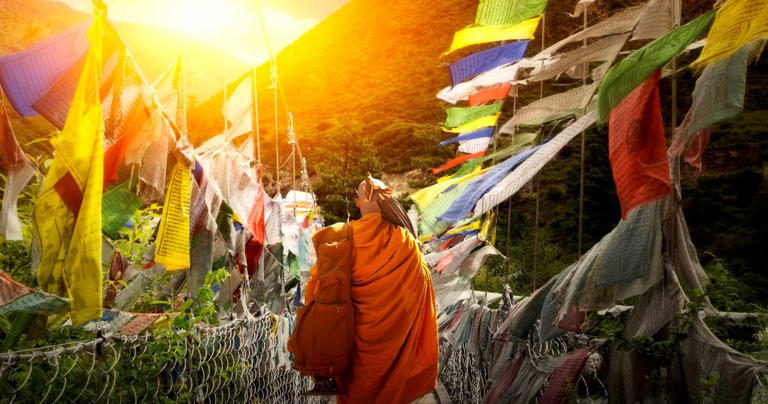
- Logout Login
- Adventure Holidays
- Weekend Getaways
- Driving Holidays
- Travel News
Top Searches
World Peaceful Countries
Char Dham Temple
India Valleys
India Stargazing Places
World Slow Countries
India Cambodia Flight
Visa-free travel agreement between India, Russia likely by end of 2024
Times of India TIMESOFINDIA.COM / TRAVEL NEWS , RUSSIA / Created : May 18, 2024, 12:31 IST
You're Reading
Kondratyev stressed that the intent of this initiative is to replicate the success of visa-free tourist exchanges which are already operational with China and Iran. Notably, Russia and China initiated their visa-free group tourist … Read more
Kondratyev stressed that the intent of this initiative is to replicate the success of visa-free tourist exchanges which are already operational with China and Iran. Notably, Russia and China initiated their visa-free group tourist exchange on August 1 of the preceding year, followed by a similar initiative with Iran on the same date. Read less
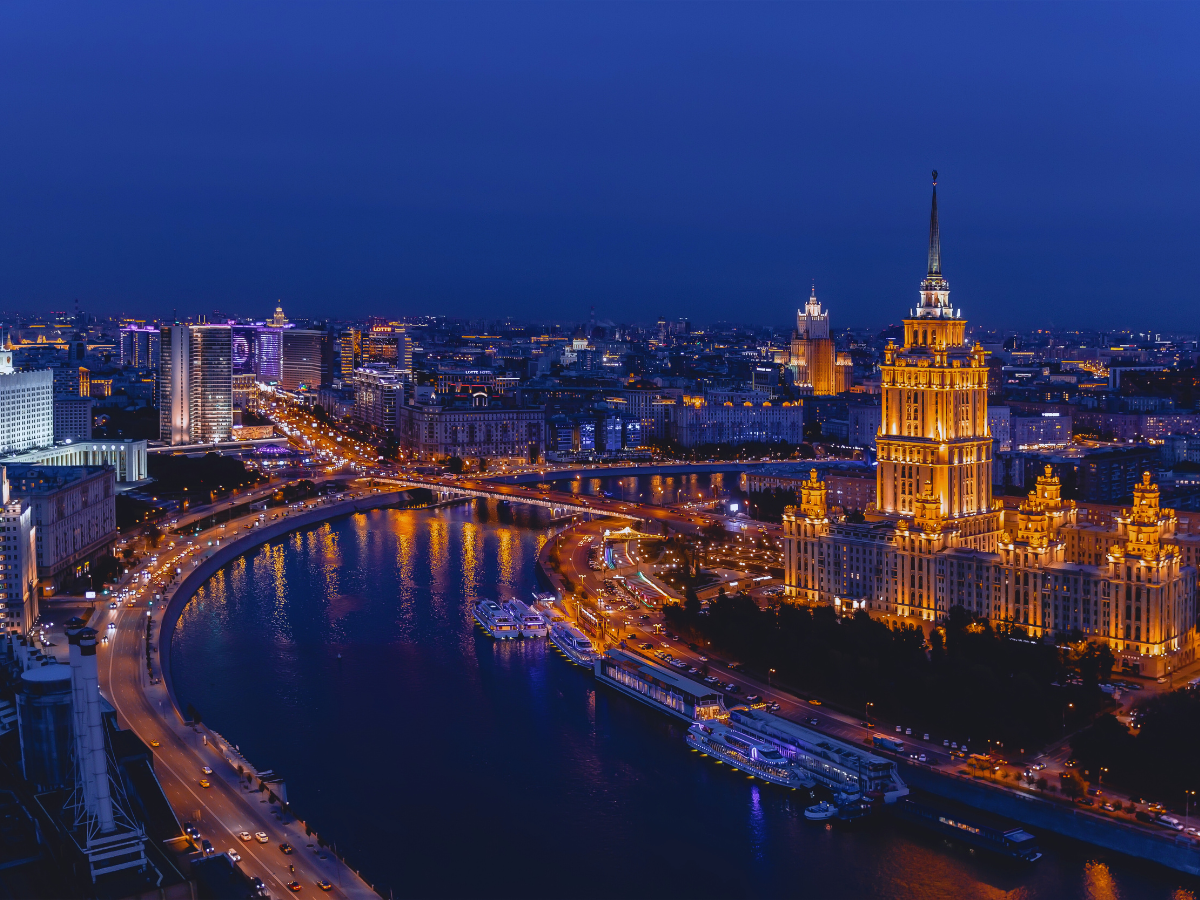
More from Travel News

Google’s top 10 summer-perfect destinations for 2024

Red Square, Moscow
The hermitage museum, st. petersburg, lake baikal, the peterhof palace, st. petersburg, comments (0).

Refrain from posting comments that are obscene, defamatory or inflammatory, and do not indulge in personal attacks, name calling or inciting hatred against any community. Help us delete comments that do not follow these guidelines by marking them offensive . Let's work together to keep the conversation civil.
Comments ( ) Sort: Newest UpVoted Oldest Discussed Down Voted closecomments

SIGN IN WITH
Or post without registration.

Visual Stories
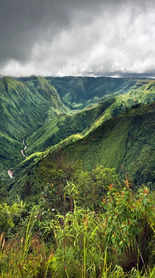
Popular Galleries

Stunning locations that evoke memories of Dil To Pagal Hai TRAVEL TRENDS , WORLD

Top stargazing destinations in India TRAVEL TRENDS , INDIA

Checkout these beautiful photos of offbeat Maharashtra in monsoon TRAVEL TRENDS , MAHARASHTRA
Trending stories.
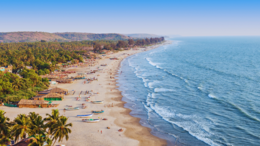
Must-visit beaches in South Goa for all the beach lovers

Stunning locations that evoke memories of Dil To Pagal Hai

- Coming soon! India’s biggest mall at Delhi airport’s Aerocity

14 most travelled countries and their single most unique attractions

8 cheapest places to visit in India for summer vacations
- 1 Visa-free travel agreement between India, Russia likely by end of 2024
- 2 UAE launches 10-year Blue Residence Visa; all you need to know
- 3 Agra gets new white marvel, posing competition to Taj Mahal
- 4 5 trending holiday destinations where Indians are travelling this summer
- 5 Uttarakhand government imposes ban on mobile phones near Char Dham Temples

THE DEFINITIVE GUIDE TO DESTINATIONS, ITINERARIES, THINGS TO DO, RESTAURANTS, NIGHTLIFE and LOTS MORE!
FOLLOW US ON
Places to visit.
- Places to visit in Bangalore
- Places to visit in Mumbai
- Places to visit in Delhi
- Places to visit in Goa
- Hotels in Goa
- Hotels in Jaipur
- Hotels in Shimla
- Hotels in Mumbai
Things To do
- Things to do in Goa
- Things to do in Mumbai
- Things to do in Bangalore
- Things to do in Delhi
Travel Inspiration
- Visa on arrival for Indians
- Honeymoon Places in india
- Hill Stations in India
- Weekend getaways in Mumbai
- Weather in Delhi
- Weather in Chennai
- Weather in Bangalore
- Weather in Mumbai
Best Beaches
- Goa Beaches
- Mumbai Beaches
- Pondicherry Beaches
- Kerala Beaches
- Restaurants in Bangalore
- Restaurants in Chennai
- Restaurants in Pune
- Restaurants in Jaipur
- Hill Station near Delhi
- Winter trip to Ladakh
- Places to visit in Kerala
- Winter Honeymoon Destinations
- UK visa guide for Indians
- Winter Trip to Manali
- Vaishno Devi Yatra
- Special Train Ticket Booking
- HP inter-state Bus
- Honeymoon Destinations India
Latest News
Congratulations.
You have been successfully added to the mailing list of Times of India Travel. To complete the subscription process, kindly open your inbox and click on the confirmation link which has been emailed to you.
Share with friends
Thank You for sharing! Your friend will receive the article link on email mentioned.
- (For more than one recipient, type addresses separated by commas)
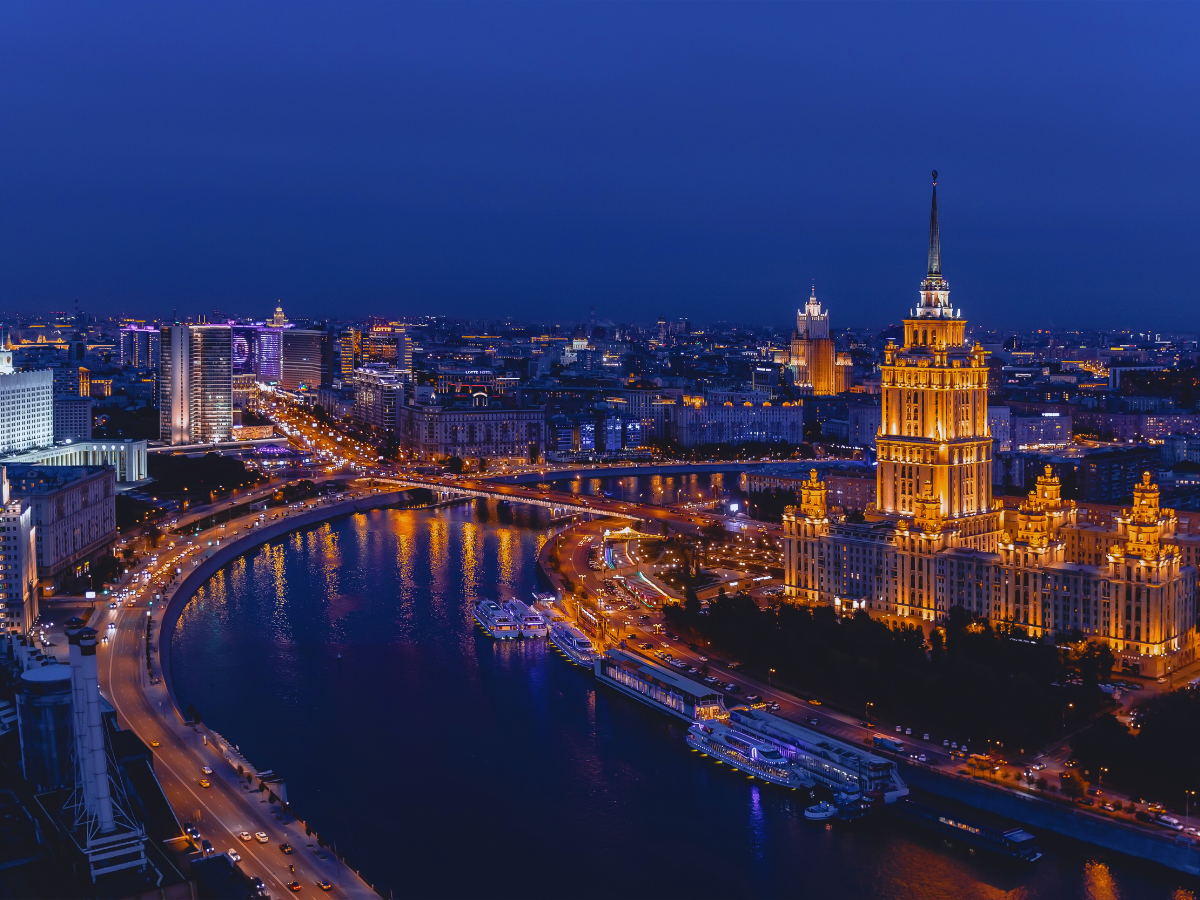
Kondratyev stressed that the intent of this initiative is to replicate the success of visa-free tourist exchanges which are already operational with China and Iran. Notably, Russia and China initiated...
Back to the future? Airline sector poised for change post-COVID-19
It’s difficult to overstate just how much the COVID-19 pandemic has devastated airlines. In 2020, industry revenues totaled $328 billion, around 40 percent of the previous year’s. In nominal terms, that’s the same as in 2000. The sector is expected to be smaller for years to come; we project traffic won’t return to 2019 levels before 2024.
Financial woes aside, the pandemic’s longer-term effects on aviation are emerging. Some of these are obvious: hygiene and safety standards will be more stringent, and digitalization will continue to transform the travel experience. Mobile apps will be used to store travelers’ vaccine certificates and COVID-19 test results.
Other effects, though, are more profound. Unlike the 2008 global financial crisis, which was purely economic and weakened spending power, COVID-19 has changed consumer behavior—and the airline sector—irrevocably.
This article will explore five fundamental shifts in the aviation industry that have arisen from the pandemic. For each of these shifts, we also issue a call to action. By responding to these shifts decisively now, carriers should be able to look beyond the pandemic and adapt to the long-term realities of COVID-19.
1. Leisure trips will fuel the recovery
Business travel will take longer to recover, and even then, we estimate it will only likely recover to around 80 percent of prepandemic levels by 2024. Remote work and other flexible working arrangements are likely to remain in some form postpandemic and people will take fewer corporate trips.
In previous crises, leisure trips or visits to friends and relatives tended to rebound first, as was the case in the United Kingdom following 9/11 and the global financial crisis (Exhibit 1). Not only did business trips take four years to return to precrisis levels after the attacks on the World Trade Center but they also had not yet recovered to pre-financial-crisis levels when COVID-19 broke out in 2020. Therefore, we expect that as the pandemic subsides, the rise in leisure trips will outpace the recovery of business travel.
Some carriers are highly dependent on business travelers—both those traveling in business class and those who book economy-class seats right before they need to travel. While leisure passengers fill up most of the seats on flights and help cover a portion of fixed costs, their overall financial contributions in net marginal terms are negligible, if not negative. Most of the profits earned on a long-haul flight are generated by a small group of high-yielding passengers, often traveling for business. But this pool of profit-generating passengers has shrunk because of the pandemic.

A McKinsey Live event on 'Returning to corporate travel: How do we get it right?'
The call: Revisit flight economics
Airlines should reevaluate the economics of their operations, especially long-haul flights. First, a smaller contribution from business traffic could necessitate a different pricing logic. For example, today most carriers price point-to-point nonstop flights at a premium. Travelers who value time over price—mostly business travelers—book these nonstop flights. Leisure travelers, even those traveling in premium classes, are more price sensitive and may choose an indirect routing. This large gap between nonstop pricing and connect pricing may need to narrow.
Second, lower business traffic may require network changes. Airlines added many flights over the past few years between hubs and smaller cities, using small-size widebodies such as the Boeing 787. These flights work because of the high-yielding business demand. With business demand subdued, economics favor larger aircraft flying less frequently. Airlines may find that larger aircraft such as Airbus A350s or Boeing 777s—which have lower unit costs—become the base of the long-haul network.
Third, airlines may also look at reconfiguring the layout of their cabins to address the increased share of leisure traffic. At the simplest level, lower business-class demand may warrant smaller business-class cabins. Taking this further, products may shift to better cater to premium-leisure passengers, such as growth of premium-economy cabins or development of business-class seats more suitable for traveling as couples or groups.
2. Staggering debt levels will lead to ticket price increases and a larger role for government in the sector
Many airlines have had to borrow huge sums of money to stay afloat and cope with high daily cash burn rates. Tapping into state-provided aid, credit lines, and bond issuances, the industry collectively amassed more than $180 billion worth of debt in 2020, 1 “COVID-19 lowers airline credit ratings and raises the cost of debt,” International Air Transport Association, August 21, 2020, iata.org. a figure equivalent to more than half of total annual revenues that year. And debt levels are still rising (Exhibit 2). Repaying these loans is made even harder by worsening credit ratings and higher financing costs.
These costs will need to be recouped. Therefore, we’ll likely see ticket prices rise. By our estimates, this could amount to a rise in ticket prices of about 3 percent, assuming a ten-year repayment window for only the additional debt taken on.
Furthermore, when demand for air travel returns, it will likely outpace supply initially. We see a glut of latent demand of people eager to travel. It will take time for airlines to restore capacity, and bottlenecks such as delays in bringing aircraft back to service and crew retraining could lead to a supply–demand gap, resulting in higher short-term prices.
In many cases, airline rescue efforts come in the form of government bailouts—with strings attached. We’re seeing a reemergence of, or increase in, the level of state ownership and influence. In Europe alone, TAP Air Portugal, Lufthansa Group, and Air Baltic all received state aid combined with an increase or reintroduction of government shareholdings.
The call: Be a constructive collaborator
As the state becomes a more active player—whether as a creditor, a direct shareholder, or as part of the board—airlines will find themselves having to deal more closely with the authorities. Instead of seeing this as a necessary restriction to access much-needed funds, airlines can treat it as an opportunity to shape how the sector evolves with a key stakeholder.
Airlines can work with regulators to set standards across a gamut of issues. These could include committing to reductions in greenhouse-gas emissions in return for more labor flexibility; increasing the cash-on-hand requirements to make airlines more resilient against future shocks; more balanced value sharing between airlines and other sectors such as airports; or changes in the ownership caps to allow greater inflows of foreign capital, reducing the reliance on state capital further down the road.
3. We will see a greater disparity of performance among airlines in the future
Some airlines have responded to the pandemic by restructuring for greater efficiency; others are merely muddling through. Occasionally, this is linked to state-aid programs, which may reduce the incentive for much-needed measures such as cost, organizational, and operational restructuring. Airlines that are not proactively transforming risk failing to set the business up for longer-term structural value creation.
As such, we’re seeing some airlines pull ahead. Before COVID-19, an airline boasted an ROIC well ahead of the overall industry’s rate of 5.8 percent. Not only did its stronger position pre-COVID-19 enable it to navigate the crisis thus far without taking on government loans of the scale relative to other airlines, it also made it possible for it to restructure to emerge with an even more competitive cost base.
Another group of carriers that have an opportunity to transform their business are airlines that have access to a restructuring process, such as Chapter 11 in the United States. These carriers can renegotiate midlife leases, shed excess debt, and emerge leaner. They will be fierce competitors going forward.
The call: Aim higher when it comes to IT and digital investment
Becoming better can necessitate investment. Even though many airlines find themselves in financial straits, we recommend investing more in IT and digitalization, not less. Before the pandemic, airlines spent roughly 5 percent of their revenue on IT. This is relatively low compared with other sectors. By means of comparison, the retail industry spends around 6 percent on average, and financial services 10 percent.
Airlines could consider stepping up IT and automation investment now. For example, airlines can respond to the quicker recovery of domestic and short-haul flights by investing in direct sales and owning the customer relationship. Relationships with IT and distribution providers could be reexplored. Carriers can also invest in the customer experience—such as making check-in and boarding processes more seamless—and support services—from revenue accounting to invoicing—to drive the next level of efficiency. Beyond this, the next horizon is analytics, which involves, among other efforts, using data in smarter ways to enhance decision making, requiring some investment but yielding significant payoffs .
4. Aircraft markets may be oversupplied for some time to come
In the years before COVID-19, aircraft OEMs ramped up production in the anticipation of continued growth. This has led to a glut in aircraft availability. Furthermore, some carriers have returned relatively new aircraft to lessors, such as Norwegian Air Shuttle when it exited the long-haul market. Prices for used-aircraft leases have plummeted and are likely to remain lower. For instance, the monthly lease rate of a 2016 vintage Boeing 777-300ER aircraft was around $1.2 million in 2019. In 2020, the rate fell to less than $800,000. New aircraft are rumored to be available at even deeper discounts.
The call: Act countercyclically now, if you can
If finances permit, carriers can consider acting countercyclically: locking in orders for new aircraft or confirming operating leases now when demand is low. Aircraft are a significant expense for an airline, making up 10 to 15 percent of a carrier’s cost base. As lease rates and OEM pricing fluctuate with supply and demand levels, inking deals during a crisis could allow carriers to enjoy a cost advantage for years to come.
5. Air freight will see undersupply for some time
Over the past ten years, low cargo rates and the unprofitability of the cargo business have led many airlines to relinquish or scale back their dedicated cargo freighter fleets. However, cargo has been a lifeline for the aviation industry during COVID-19. Before the pandemic, cargo typically made up around 12 percent of the sector’s total revenue; that percentage tripled last year. Based on data from the Airline Analyst, only 21 (down from 77 in 2019) of the airlines around the world that disclosed their operating performance achieved positive operating profits for the third quarter of 2020, traditionally the industry’s most profitable quarter. Among these 21 airlines, cargo revenue accounted for 49 percent of total revenues on average.
During the pandemic, e-commerce sales soared while many passenger flights—which are responsible for delivering around half of total air cargo—were grounded. As a result, cargo yields increased by about 30 percent last year. As commercial flights gradually return, belly supply will increase, although not to pre-COVID-19 levels for at least a few years, as the industry is expected stay smaller than before the pandemic for several years.
The call: Bring back freighters, carefully
In response to the high demand and low supply of air freight right now, carriers could investigate short- to medium-term opportunities to boost their cargo services. Airlines can enhance their flexibility through measures such as increasing the deployment of so-called preighters, or passenger airplanes that are used to transport cargo. Airlines may look at freighter conversions, especially as their passenger fleets reduce in number.
Airlines need to be agile. Rushing headlong into developing and maintaining a large freighter fleet again comes with risk. Airlines need to grow cargo in an agile way that allows for quick adjustments; pursuing such a play should be seen as part of a wider theme of establishing a more flexible production setup. High fixed costs combined with unpredictable demand levels outside an airline’s control increase the need for airlines to be able to scale down supply nimbly.
The impact of the COVID-19 pandemic is far from over. There is some relief to be found in various parts of the world now that vaccinations have begun, but the road to recovery for air traffic will take several years. The shape of the post-COVID-19 airline sector is becoming clearer and holds lessons for airlines today. Multiple longer-running trends have been accelerated, such as digitization and the phasing out of less efficient aircraft. Burdened by debt, many carriers have depleted their cash reserves. But the forecast is not without bright spots. Travel will become greener and more efficient, and people are itching to travel again for holidays. Taking steps now will help airlines thrive in this transformed sector.
Jaap Bouwer is a senior expert in McKinsey’s Amsterdam office, Steve Saxon is a partner in the Shenzhen office, and Nina Wittkamp is a partner in the Munich office.
The authors wish to thank Alex Dichter and Vik Krishnan for their contributions to this article.
This article was edited by Jason Li, a senior editor in the Shanghai office.
Explore a career with us
Related articles.

Airline data: What next beyond crisis response?
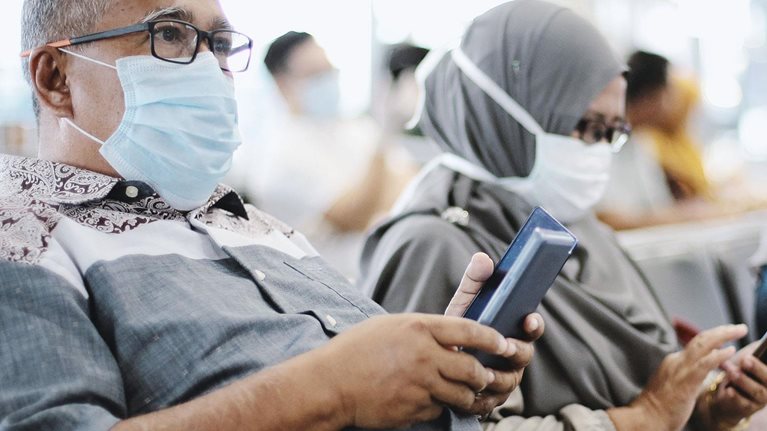
Will airline hubs recover from COVID-19?

‘Prepare for the marathon and be ready for the course to change’: An interview with the Boston Logan Airport CEO
trending now in World News

IDF recovers fourth hostage body in overnight operation in Gaza

Iran prepares to execute Jewish man in case that sends dread...

McDonald's customer says he was hit with $400 traffic ticket for...

1,600-year-old mystery discovered in ancient ruins

Wild caught-on-camera machete fight ends with man calmly picking...

Physically healthy woman, 29, granted euthanasia approval over...

Shani Louk's parents describe seeing daughter's body 7 months...

Shani Louk, symbol of Oct. 7 Hamas savagery, found dead in Rafah...
Breaking news, climate activists breach german airport, glue themselves to runway during busy travel weekend.
Thanks for contacting us. We've received your submission.
German police arrested eight climate activists who breached the grounds of Munich airport on Saturday, briefly causing the airport to close and leading to around 60 flight cancelations during a busy holiday weekend.
Six of the activists glued themselves to a runway, a police spokesperson said, adding the situation was now under control, with both of the airport’s runways open for arrivals and takeoffs.
Climate group Last Generation, which has carried out similar protests in the past, said it was responsible for the action in a series of posts on X showing members on what appeared to be a runway or tarmac with protest signs.

The group later said six individuals had seated themselves on airport asphalt at 4:45 a.m. local time to block planes, and it criticized Berlin for subsidizing airlines at the expense of rail.
“Problem is the government, not our holiday,” one of the signs read.
Germany’s interior minister, Nancy Faeser, said security measures at the airport would be reviewed.
“Such criminal actions endanger air traffic and harm climate protection because they only cause contempt and anger,” she wrote on X.
“The perpetrators must be vigorously pursued,” she said.

Germany’s transport minister, Volker Wissing, said new laws were needed to punish such actions as criminal, with up to two years in prison. Current laws classify them as minor offenses.
An airport spokesperson said the airport had been fully closed to takeoffs and landings for nearly two hours.

Some 11 flights had been diverted, around 60 had been canceled, and delays were still possible, the person said.
The disruption occurred during one of the busiest travel periods for the airport in southern Germany, second only to the Easter holidays, according to the airport.
Share this article:

Advertisement
Ukraine war latest: Russian forces take control of village in Kharkiv region - defence ministry
Russian troops are continuing to advance in the Kharkiv region - with the defence ministry claiming it had taken control of 12 settlements in a week.
Sunday 19 May 2024 00:10, UK
Please use Chrome browser for a more accessible video player
- Russia takes control of village in Kharkiv - defence ministry
- Ukraine's divisive draft law comes into force | At least 30 Ukrainians have died crossing river to avoid
- Putin concludes trip to China with veiled reference to West
- Two civilians killed while evacuating city
- Analysis: Great power politics on display in China visit
- Live reporting by Jess Sharp and (earlier) Josephine Franks
We're pausing our coverage of the Ukraine war for the moment.
Scroll through the blog below to catch up on today's developments.
A decorated Ukrainian pilot has been killed in action, the country's 831st tactical aviation brigade has announced.
In a post on Facebook, the brigade said First Deputy Commander of the Aviation Squadron Lieutenant Colonel Denis Vasilyuk, was killed during a combat mission.
"We lost not just a pilot, but a reliable combat brother, a friend and just a wonderful and bright man," it added.
He flew dozens of missions since the beginning of the war has has been awarded the Order For Courage medal.
The medal is handed to members of the military for individual courage and heroism while rescuing people or valued materials while endangering their own life.
A Ukrainian missile has been destroyed over Belgorod, the Russian defence ministry has said.
It said the Tochka-U tactical missile was launched at around 9.15pm local time (7.15pm UK time).
"Duty air defence systems destroyed one tactical missile over the territory of the Belgorod region," it added.
Belgorod has been targeted several times, with attacks increasing in recent weeks.
Volodymyr Zelenskyy has praised his forces' successes during his nightly address.
The Ukrainian president said his troops had grown in confidence, particularly in the Kharkiv region.
However, his message comes after Russia's defence ministry said its forces captured the village of Starytsia in the Kharkiv region earlier today - just eight days after a new Russian push in the area began.
"The occupier is losing its infantry and equipment, a tangible loss, even though, just as in 2022, it was counting on a quick advance on our land," Mr Zelenskyy said, referring to Russia's initial invasion of Ukraine in February of that year.
In the eastern Donetsk region around Chasiv Yar, a city seen as a key target in Russia's campaign, Mr Zelenskyy said Ukrainian forces had repelled a Russian assault.
"Our soldiers destroyed more than 20 units of the occupier's armoured vehicles," he added.
Russia has claimed to have captured a "very valuable" British-made vehicle from the battlefield.
In a post on Telegram, the defence ministry said the FV104 Samaritan evacuation vehicle has been taken but needs to be repaired.
It claimed it was big enough to evacuate four people and carry a crew of two.
It said it was "very valuable" and could be used as a "rare collection exhibit".
It shared a video of the vehicle but Sky News has not been able to verify if it is a FV104 Samaritan.
Five people have been injured in a Russian shelling attack in Kharkiv, the Ukrainian national police has said.
A 13-year-old girl and 16-year-old boy are among those hurt, it said.
The Russian military attacked the city at around 30pm, it added, with several hits recorded on residential buildings.
"As a result of shelling, five civilians were injured, and civilian infrastructure was also damaged," police official Oleksandr Kobylev said.
"Currently, two minor children are known to have suffered minor injuries. Necessary medical assistance is provided to all victims."
A Russian attack plane has been shot down, a Ukrainian army brigade has reported.
The 110th separate brigade said the Su-25 had been destroyed in Donetsk.
It said it was the fourth Su-25 to have been shot down, adding it will keep issuing "flaming fines" to Russia for crossing into Ukraine.
"Our sky will become hell for the occupant pilots. Our squad number will be a nightmare for them," it added.
A Ukrainian sergeant has been stabbed in the hand by a civilian, the country's ground forces has said.
In a statement posted on Facebook, the army said the attacker was detained and has been charged with attempted murder and obstructing the armed forces.
The attack took place in the city of Sinelnikove, in the central Dnipro region, earlier today.
"A civilian committed an armed assault with cold weapons (knife) on the sergeant of the Armed Forces of Ukraine," the statement said.
The sergeant, who worked for the territorial recruitment and social support centre, has been provided with "all the necessary medical care", it added.
In Ukraine's second largest city, airstrikes have become a daily occurrence as intense battles continue.
Russian troops have been pushing ahead with a ground offensive that opened a new front in northeastern Kharkiv region in recent days, putting further pressure on Kyiv's overstretched military.
After weeks of probing, Moscow launched the new push knowing that Ukraine suffered personnel shortages, and that its forces have been spread thin in the northeast.
Two people were killed after Russian airstrikes hit Kharkiv on Friday as Ukrainian troops fought to halt Russian advances in the region.
The airstrikes targeted Ukraine's second-largest city during the daytime, injuring 25 people and killing two, according to Kharkiv's mayor Ihor Terkhov.
On Thursday, the air alarm sounded for more than 16 hours, a record since the beginning of the military campaign by Russia.
Here are some of the latest pictures from the city:
Ukrainian drone attacks on Russian power facilities in early 2024 disrupted 14% of Russia's oil refining capacity, according to the US Department of Defence.
The strikes pushed up domestic oil prices by 20-30% and forced Russia to halt exports to focus on meeting domestic demand, a report from the Pentagon’s intelligence agency said.
But it caused only a "negligible disruption" to the electricity supply for Russian civilians and the military, because of Russia's "robust generation capacity" and the level of power in the grid.
Be the first to get Breaking News
Install the Sky News app for free


IMAGES
VIDEO
COMMENTS
Artistic productions including handmade crafts are very potent cultural representatives, particularly for countries with ancient civilizations. Iran owns an enormous wealth of traditional masterpieces remained from old, middle, and modern arenas. The geographical location of Iran, bridging west to the east, along with the country's long ...
In order to visit Iran, you're going to need to get a tourist visa. This used to be a very difficult process, but luckily things have gotten easier with the introduction of visa on arrivals in 2016 On the 14th February 2016, the Ministry of Iran announced that citizens of 180 countries can now apply for VOA of 30-days at most international ...
Travel to Iran: a 2019 visa update for US, UK and Canadian citizens; Everything you need to know before visiting Iran; Why you should visit Iran now, more than ever; 5 unique experiences you shouldn't miss in Iran; What to wear in Iran: a packing guide — (All images courtesy of the writer, Norbert, and taken on Intrepid Travel's Iran ...
You can book trains through the hotels, local agencies or go directly to the train station. The price for a ticket from Tehran to Yazd, for example, is between 30,000 to 70,000 Tomans ($8 to $15). Private car. You have two options to travel in Iran by a private car.
Iran. Middle East. Welcome to what could be the friendliest country on earth. Iran is the jewel in Islam's crown, combining glorious architecture with a warm-hearted welcome. 01 / Attractions.
This place is absolutely a masterpiece A must to visit if you are in Isfahan. 8. Tehran Grand Bazaar. 1,315. Points of Interest & Landmarks. By ardeshirb2014. One of the oldest part of the city, it represent the history of the city. 9. Isfahan Music Museum.
Iran travel information, Iran tours, travel tips, hotels, travel agencies, tour guides, maps, tourist attractions, sights and itinerary ideas. Official website of iran tourism and touring. Iran as old as history, the most ancient civilizations.
Enroll in the Smart Traveler Enrollment Program (STEP) to receive security messages and make it easier to locate you in an emergency. Call us in Washington, D.C. at 1-888-407-4747 (toll-free in the United States and Canada) or 1-202-501-4444 (from all other countries) from 8:00 a.m. to 8:00 p.m., Eastern Standard Time, Monday through Friday ...
General information. Iran (officially the Islamic Republic of Iran) is a large country located in the Middle East. It is bordered to the north by the Caspian Sea and the south by the Persian Gulf. With an area of 1,648,195 square kilometers, Iran is the 17th largest country in the world. It is a proof you have to spend more than a couple of ...
All costs of PCR COVID testing and quarantine measures in Iran are borne by the tourist, through insurance coverage. If foreign people who enter across land borders are symptomatic, despite presenting a vaccine card and a negative PCR test. Failure to provide a self-declaration form by the tourist. Failure to provide valid international travel ...
This place is absolutely a masterpiece A must to visit if you are in Isfahan. 9. Eram Garden (Bāq e Eram) 763. Historic Sites. By WeakKneeTraveler. The garden is big with lots of trees and plants. 10. Towers of silence.
Background. Tourism declined dramatically during the Iran-Iraq War in the 1980s.. Around 12 million tourists visit Kish Island annually. There are many Shi'ite shrines in Iran, the two main ones being Imam Reza Shrine in Mashhad and Fatimah al-Ma'sūmah Shrine in Qom.Each year millions of pilgrims from Iran and other countries visit these holy places.
Lets explore the best places to visit in Iran: 1. Esfahan. Gilded with the riches of more kings and sultans and Muslim caliphs than you can shake a cobalt-blue ceramic pot from a Zagros Mountain village at, the glorious city of Esfahan is unquestionably one of the most beautiful in all of Iran.
Day 1 - Tehran (Azadi and Milad Towers, Golestan Palace, Grand Bazaar) skyline of tehran. Tehran, the sprawling capital of Iran, is the largest city in Western Asia. For most travelers, the introduction to Iran, is one of congested roads and air pollution. If you happen to visit during a public holiday, it's a totally different story and ...
Travel Advisory. January 11, 2024. Iran - Level 4: Do Not Travel. O D K U T. Updated to add the Terrorism Risk Indicator and risk of surrogacy tourism. Do not travel to Iran due to the risk of terrorism, civil unrest, kidnapping and the arbitrary arrest of U.S. citizens. Exercise increased caution due to wrongful detentions.
Iran Tourism: Tripadvisor has 170,253 reviews of Iran Hotels, Attractions, and Restaurants making it your best Iran resource. Skip to main content ... Explore each step of his travel guide among deserts' hidden gems. Follow along on his epic journey. Stream now. Trending in the forums. See all. Payment and hotel booking in Iran. By Ea8122 13 ...
Iran is an incredibly underrated country with an immense history, the friendliest people, and the most breathtaking architecture. Having spent 2 weeks there, I truly believe it should be on every traveler's bucket list.However, the beauty of this country is rarely shown in the media; it's sadly always buried underneath scary footages that only reflect the world of politics.
The official YouTube Tourism Channel of Iran, @visitpersia, aims to provide easy access to travel information for international tourists, helping them plan their trips to Iran. The channel offers ...
How to book hotels, flights and tours in Iran. Because of the sanctions, foreign cards or popular sites such as booking.com can't be used in Iran, but now you can thanks to 1stQuest.. 1stQuest is a local company that offers services such as visa LOI, hotel booking, tours, domestic flights, and travel insurance for Iran.
Step 3: Best Time to Visit. Consider the best time to visit Iran based on your preferences. Spring (March to May) and autumn (September to November) offer mild temperatures and pleasant weather, ideal for exploring the country. Also, the best time to visit depends on the tour and activities.
If you need consular assistance you should contact the British Embassy in Tehran . FCDO advises against all travel to Iran. British and British-Iranian dual nationals are at significant risk of ...
Tops should cover the elbows, and tight pants such as leggings and jeans should be paired with a long shirt or cardigan that covers your butt at a minimum. Open-toed sandals are fine. When visiting mosques, women are typically required to wear a chador (cloak). Don't worry if you don't have one as chadors can usually be borrowed at the entrance.
Iran - AVOID ALL TRAVEL. Avoid all travel to Iran due to the volatile security situation, the regional threat of terrorism and the possibility of arbitrary detention. You should consider leaving by commercial means if you can do so safely. Our ability to provide consular services in Iran is severely limited.
Research from Intrepid Travel found that only 26 of 101 travel shows available to stream on the two leading TV channels including a female presenter. This lack of representation is also part of ...
Turkmenistan's difficult visa requirements and limited tourist infrastructure make it a hassle for American travelers. Libya is off-limits due to ongoing conflict, diplomatic tensions, and minimal ...
Notably, Russia and China initiated their visa-free group tourist exchange on August 1 of the preceding year, followed by a similar initiative with Iran on the same date.
It's difficult to overstate just how much the COVID-19 pandemic has devastated airlines. In 2020, industry revenues totaled $328 billion, around 40 percent of the previous year's. In nominal terms, that's the same as in 2000. The sector is expected to be smaller for years to come; we project traffic won't return to 2019 levels before 2024.
00:00. 00:55. German police arrested eight climate activists who breached the grounds of Munich airport on Saturday, briefly causing the airport to close and leading to around 60 flight ...
A Ukrainian missile has been destroyed over Belgorod, the Russian defence ministry has said. It said the Tochka-U tactical missile was launched at around 9.15pm local time (7.15pm UK time).